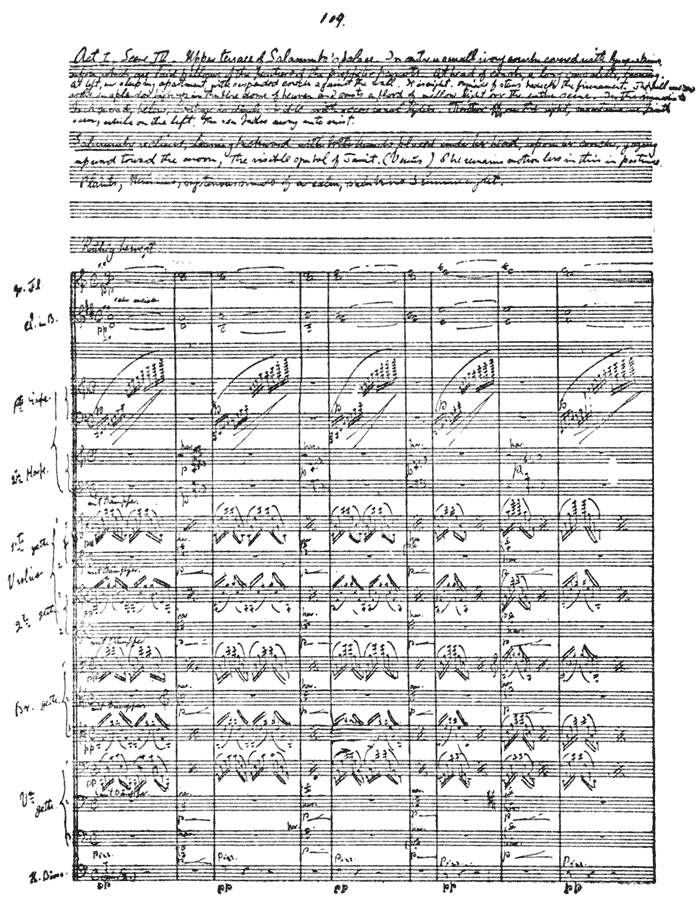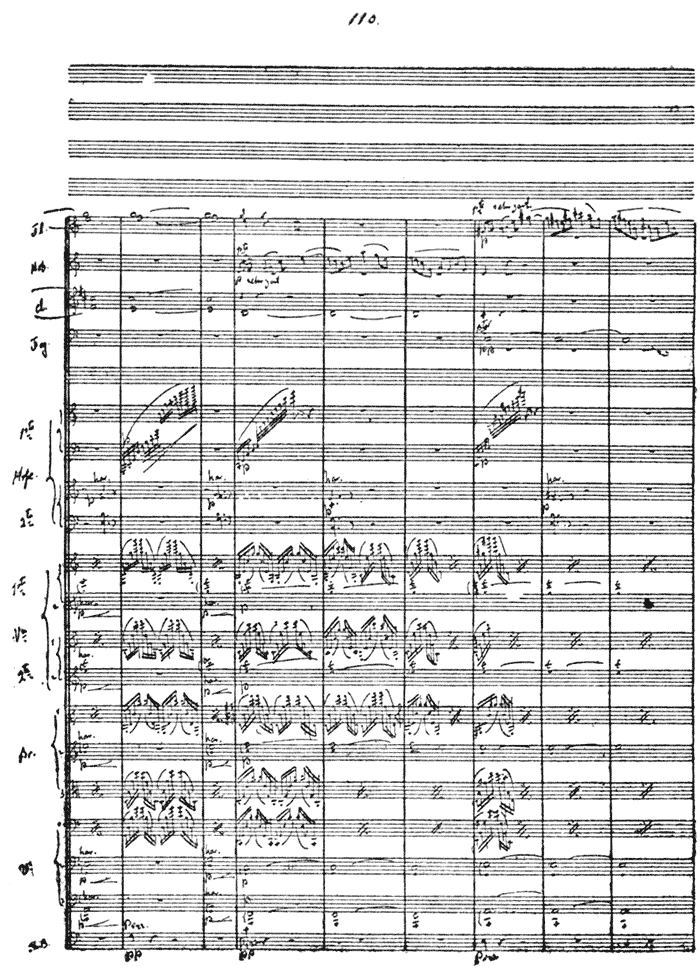Project Gutenberg's Contemporary American Composers, by Rupert Hughes
This eBook is for the use of anyone anywhere at no cost and with
almost no restrictions whatsoever. You may copy it, give it away or
re-use it under the terms of the Project Gutenberg License included
with this eBook or online at www.gutenberg.org
Title: Contemporary American Composers
Being a Study of the Music of This Country, Its Present
Conditions and Its Future, with Critical Estimates and
Biographies of the Principal Living Composers; and an
Abundance of Portraits, Fac-simile Musical Autographs, and
Compositions
Author: Rupert Hughes
Release Date: December 10, 2007 [EBook #23800]
Language: English
Character set encoding: ISO-8859-1
*** START OF THIS PROJECT GUTENBERG EBOOK CONTEMPORARY AMERICAN COMPOSERS ***
Produced by David Newman, Jeffrey Johnson, Suzanne Lybarger,
Linda Cantoni, and the Online Distributed Proofreading
Team at http://www.pgdp.net
Transcriber's Notes
Printer errors have been corrected.
Full-page illustrations have been moved so as not to interrupt the
flow of the text; some page numbers are skipped as a result.
Midi files have been provided for all music illustrations except
autographs and the handwritten manuscript score of Salammbô. Click on the [Listen] link to hear the music. Lyrics within
the music illustrations have been transcribed and placed below the
notation image.
Contemporary
American Composers
BEING A STUDY OF THE MUSIC OF THIS
COUNTRY, ITS PRESENT CONDITIONS AND ITS
FUTURE, WITH CRITICAL ESTIMATES AND
BIOGRAPHIES OF THE PRINCIPAL LIVING
COMPOSERS; AND AN ABUNDANCE OF PORTRAITS,
FAC-SIMILE MUSICAL AUTOGRAPHS,
AND COMPOSITIONS
By
Rupert Hughes, M.A.
Contents
List of Music
List of Illustrations
ILLUSTRATED

Boston
L.C. Page and Company
(Incorporated)
1900
Copyright, 1900
By L.C. Page & Company
(INCORPORATED)
All rights reserved
Colonial Press
Electrotyped and Printed by C.H. Simonds & Co.
Boston, U.S.A.
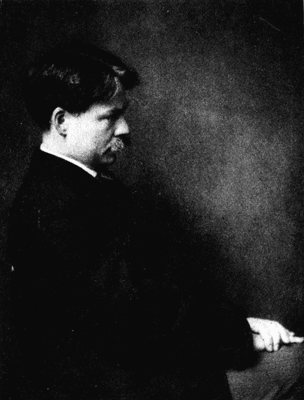
Edward MacDowell.
TO
James Huneker
MUSICIAN TO THE TIP OF HIS PEN
vii
FOREWORD.
One day there came into Robert Schumann's ken the work of a young fellow
named Brahms, and the master cried aloud in the wilderness, "Behold, the
new Messiah of music!" Many have refused to accept Brahms at this
rating, and I confess to being one of the unregenerate, but the spirit
that kept Schumann's heart open to the appeal of any stranger, that led
him into instant enthusiasms of which he was neither afraid nor ashamed,
enthusiasms in which the whole world has generally followed his
leading—that spirit it is that proves his true musicianship, and makes
him a place forever among the great critics of music,—a small, small
crowd they are, too.
It is inevitable that a pioneer like Schuviiimann should make many
mistakes, but he escaped the one great fatal mistake of those who are
not open to conviction, nor alert for new beauty and fresh truth, who
are willing to take art to their affections or respect only when it has
lost its bloom and has been duly appraised and ticketed by other
generations or foreign scholars. And yet, even worse than this
languorous inanition is the active policy of those who despise
everything contemporary or native, and substitute sciolism for
catholicity, contempt for analysis.
While the greater part of the world has stayed aloof, the problem of a
national American music has been solving itself. Aside from occasional
attentions evoked by chance performances, it may be said in general that
the growth of our music has been unloved and unheeded by anybody except
a few plodding composers, their wives, and a retainer or two. The only
thing that inclines me to invade the privacy of the American comixposer
and publish his secrets, is my hearty belief, lo, these many years! that
some of the best music in the world is being written here at home, and
that it only needs the light to win its meed of praise.
Owing to the scarcity of printed matter relating to native composers,
and the utter incompleteness and bias of what exists, I have based this
book almost altogether on my own research. I studied the catalogues of
all the respectable music publishers, and selected such composers as
seemed to have any serious intentions. When I heard of a composer whose
work, though earnest, had not been able to find a publisher, I sought
him out and read his manuscripts (a hideous task which might be
substituted for the comparative pastime of breaking rocks, as punishment
for misdemeanors). In every case I secured as many of each composer's
works as could be had in print or in manuscript, and endeavored to
digest them. Thousands of xpieces of music, from short songs to operatic
and orchestral scores, I studied with all available conscience. The fact
that after going through at least a ton of American compositions, I am
still an enthusiast, is surely a proof of some virtue in native music.
A portion of the result of this study was published au courant in a
magazine, awakening so much attention that I have at length decided to
yield to constant requests and publish the articles in more accessible
form. The necessity for revising many of the opinions formed hastily and
published immediately, the possibility now of taking the work of our
musicians in some perspective, and the opportunity of bringing my
information up to date, have meant so much revision, excision, and
addition, that this book is really a new work.
The biographical data have been furnished in practically every case by
the composers themselves, and are, therefore, reliable inxi everything
except possibly the date of birth. The critical opinions gain their
possibly dogmatic tone rather from a desire for brevity than from any
hope—or wish—that they should be swallowed whole. No attempt to set up
a standard of comparative merit or precedence has been made, though it
is inevitable that certain music-makers should interest one more than
certain others even more worthy in the eyes of eminent judges.
It may be that some inspectors of this book will complain of the
omission of names they had expected to find here. Others will feel a
sense of disproportion. To them there is no reply but a pathetic
allusion to the inevitable incompleteness and asymmetry of all things
human.
Many will look with skepticism at the large number of composers I have
thought worthy of inclusion. I can only say that the fact that an artist
has created one work of high merit makes him a good composer in my
opinion, xiiwhether or no he has ever written another, and whether or no
he has afterward fallen into the sere and yellow school of trash. So
Gray's fame is perennial,—one poem among many banalities.
Besides, I do not concur in that most commonplace fallacy of criticism,
the belief that not more than one genius is vouchsafed to any one period
of an art, though this opinion can be justified, of course, by a very
exclusive definition of the word genius. To the average mind, for
instance, the whole literary achievement of the Elizabethan era is
condensed into the name of Shakespeare. Contemporary with him, however,
there were, of course, thirty or forty writers whose best works the
scholar would be most unwilling to let die. There were, for instance, a
dozen playwrights, like Jonson, Fletcher, Ford, Marlowe, and Greene, in
whose works can be found literary and dramatic touches of the very
highest order. There were poets less prolific than xiiiSpenser, and yet to
be credited with a few works of the utmost beauty, minor geniuses like
Ralegh, Sidney, Lodge, Shirley, Lyly, Wotton, Wither, John Donne, Bishop
Hall, Drayton, Drummond, Herbert, Carew, Herrick, Breton, Allison, Byrd,
Dowland, Campion—so one might run on without naming one man who had not
written something the world was better for.
All periods of great art activity are similarly marked by a large number
of geniuses whose ability is not disproved, because overshadowed by the
presence of some titanic contemporary. It would be a mere impertinence
to state such an axiom of art as this, were it not the plain truth that
almost all criticism of contemporaries is based upon an arrant neglect
of it; and if it were not for the fact that I am about to string out a
long, long list of American music-makers whose ability I think
noteworthy,—a list whose length may lead many a wiseacre to pull a
longer face.
xivParts of this book have been reprinted from Godey's Magazine, the
Century Magazine, and the Criterion, to whose publishers I am
indebted for permission. For the music reproduced here I have to thank
the publishers whose copyrights were loaned for the occasion.
If the book shall only succeed in arousing in some minds an interest or
a curiosity that shall set them to the study of American music (as I
have studied it, with infinite pleasure), then this fine white paper and
this beautiful black ink will not have been wasted.
CONTENTS.
5
LIST OF MUSIC.
| PAGE |
| Autograph of Edward MacDowell | 34 |
| "Clair de Lune," by Edward MacDowell | 46 |
| Autograph of Edgar Stillman Kelley | 58 |
| "Israfel" (fragment), by Edgar Stillman Kelley | 74 |
| Autograph of Harvey Worthington Loomis | 77 |
| "Sandalphon" (fragment), by H.W. Loomis | 82 |
| Autograph of Ethelbert Nevin | 93 |
| "Herbstgefühl" (fragment), by Ethelbert Nevin | 102 |
| Autograph of John Philip Sousa | 112 |
| A Page from "El Capitan," by John Philip Sousa | 127 |
| Autograph of John K. Paine | 145 |
| Postlude to "Œdipus Tyrannus," by John K. Paine | 158 |
| "Spring's Awakening" (fragment), by Dudley Buck | 1726 |
| Autograph of Horatio W. Parker | 174 |
| "Night-piece to Julia" (fragment), by Horatio W. Parker | 180 |
| "Die Stunde Sei Gesegnet" (fragment), by Frank van der Stucken | 194 |
| "A Love Song" (fragment), by W.W. Gilchrist | 205 |
| Autograph of G.W. Chadwick | 210 |
| "Folk Song" (No. 1), by G.W. Chadwick | 216 |
| Autograph of Arthur Foote | 221 |
| "It Was a Lover and His Lass," by Arthur Foote | 230 |
| "Idylle" (fragment), by Arthur Whiting | 287 |
| "Ballade" (fragment), by Howard Brockway | 303 |
| Autograph of Harry Rowe Shelley | 304 |
| "Spring" (fragment), by Gerrit Smith | 314 |
| "When Love Is Gone," by C.B. Hawley | 330 |
| "Song from Omar Khayyám," by Victor Harris | 339 |
| "Hymn of Pan" (fragment), Fred Field Bullard | 352 |
| "Peace," by Homer A. Norris | 362 |
| Autograph of G.W. Marston | 367 |
| Excerpt from an Orchestral Score, by F.G. Gleason | 378 |
| "Idylle" (fragment), by William H. Sherwood | 385 |
| Autograph of Wilson G. Smith | 3957 |
| "Arabesque," by Wilson G. Smith | 404 |
| Fragment of the Score of "Salammbô," by Johann H. Beck | 408 |
| Autograph of James H. Rogers | 412 |
| "Black Riders" (fragment), by William Schuyler | 416 |
| "Phantoms" (fragment), by Mrs. H.H.A. Beach | 429 |
| "Ghosts," by Margaret Ruthven Lang | 436 |
9
LIST OF ILLUSTRATIONS.
| | PAGE |
| Edward MacDowell | Frontispiece |
| Edgar Stillman Kelley | 57 |
| Harvey Worthington Loomis | 77 |
| Ethelbert Nevin | 92 |
| John Philip Sousa | 112 |
| Henry Schoenefeld | 128 |
| John Knowles Paine | 145 |
| Horatio W. Parker | 174 |
| Frank van der Stucken | 188 |
| George Whitefield Chadwick | 210 |
| Arthur Foote | 221 |
| Henry K. Hadley | 241 |
| Adolph M. Foerster | 248 |
| Charles Crozat Converse | 256 |
| Louis Adolphe Coerne | 262 |
| Henry Holden Huss | 291 |
| Harry Rowe Shelley | 304 |
| Frederick Field Bullard | 351 |
| Homer A. Norris | 357 |
| Frederic Grant Gleason | 367 |
| William H. Sherwood | 383 |
| A.J. Goodrich | 388 |
| Wilson G. Smith | 395 |
| Mrs. H.H.A. Beach | 426 |
| Margaret Ruthven Lang | 432 |
11
CONTEMPORARY AMERICAN
COMPOSERS.
CHAPTER I.
A GENERAL SURVEY.
Coddling is no longer the chief need of
the American composer. While he still
wants encouragement in his good tendencies,—much
more encouragement than he gets,
too,—he is now strong enough to profit by
the discouragement of his evil tendencies.
In other words, the American composer is ready for criticism.
The first and most vital flaw of which his work will be accused is the
lack of national12ism. This I should like to combat after the sophistic
fashion of Zeno,—showing, first, why we lack that desideratum, a
strictly national school; secondly, that a strictly national school is
not desirable; and thirdly, that we most assuredly have a national
school.
In building a national individuality, as in building a personal
individuality, there is always a period of discipleship under some older
power. When the rudiments and the essentials are once thoroughly
mastered, the shackles of discipleship are thrown off, and personal
expression in an original way begins. This is the story of every master
in every art: The younger Raphael was only Perugino junior. Beethoven's
first sonatas were more completely Haydn's than the word "gewidmet"
would declare. The youthful Canova was swept off his feet by the
unearthing of old Greek masterpieces. Stevenson confesses frankly his
early efforts to copy the mannerisms of Scott and others.
Na13tions are only clusters of individuals, and
subject to the same rules. Italy borrowed its beginnings from Byzantium;
Germany and France took theirs from Italy; we, ours, from them.
It was inconceivable that America should produce an autocthonous art.
The race is one great mixture of more or less digested foreign elements;
and it is not possible to draw a declaration of artistic, as of
political, independence, and thenceforward be truly free.
Centuries of differentiated environment (in all the senses of the word
environment) are needed to produce a new language or a new art; and it
was inevitable that American music should for long be only a more or
less successful employment of European methods. And there was little
possibility, according to all precedents in art history, that any
striking individuality should rise suddenly to found a school based upon
his own mannerism. 14
Especially was this improbable, since we are in a large sense of English
lineage. As the co-heirs, with those who remain in the British Isles, of
the magnificent prose and poetry of England, it was possible for us to
produce early in our own history a Hawthorne and a Poe and an Emerson
and a Whitman. But we have had more hindrance than help from our
heritage of English music, in which there has never been a master of the
first rank, Purcell and the rest being, after all, brilliants of the
lesser magnitude (with the permission of that electric Englishman, Mr.
John F. Runciman).
A further hindrance was the creed of the Puritan fathers of our
civilization; they had a granite heart, and a suspicious eye for music.
Here is a cheerful example of congregational lyricism, and a lofty
inspiration for musical treatment (the hymn refers to the fate of
unbaptized infants): 15
"A crime it is! Therefore in Bliss
You may not hope to dwell;
But unto you I shall allow
The easiest room in Hell."
It was only at the end of the seventeenth century that singing by note
began to supplant the "lining-out" barbarism, and to provoke such fierce
opposition as this:
"First, it is a new way—an unknown tongue;
2d, it is not so melodious as the old way; 3d, there
are so many tunes that nobody can learn them;
4th, the new way makes a disturbance in churches,
grieves good men, exasperates them, and causes them
to behave disorderly; 5th, it is popish; 6th, it will
introduce instruments; 7th, the names of the notes
are blasphemous; 8th, it is needless, the old way
being good enough; 9th, it requires too much time
to learn it; 10th, it makes the young disorderly."
At the time when such puerility was disturbing this cradle of freedom
and cacophony, Bach and Händel were at work in their contrapuntal
webs, the Scarlattis, Corelli and Tartini and Porpora were alive. Peri,
Josquin and Willaert and Lassus were dead, 16 and the church had had its
last mass from the most famous citizen of the town of Palestrina.
Monteverde was no longer inventing like an Edison; Lulli had gone to
France and died; and Rameau and Couperin were alive.
At this time in the world's art, the Americans were squabbling over the
blasphemy of instruments and of notation! This is not the place to treat
the history of our music. The curious can find enlightenment at such
sources as Mr. Louis C. Elson's "National Music of America." It must be
enough for me to say that the throttling hands of Puritanism are only
now fully loosened. Some of our living composers recall the parental
opposition that met their first inclinations to a musical career,
opposition based upon the disgracefulness, the heathenishness, of music
as a profession.
The youthfulness of our school of music can be emphasized further by a
simple state17ment that, with the exception of a few names like Lowell
Mason, Louis Moreau Gottschalk, Stephen A. Emery (a graceful writer as
well as a theorist), and George F. Bristow, practically every American
composer of even the faintest importance is now living.
The influences that finally made American music are chiefly German.
Almost all of our composers have studied in Germany, or from teachers
trained there; very few of them turning aside to Paris, and almost none
to Italy. The prominent teachers, too, that have come from abroad have
been trained in the German school, whatever their nationality. The
growth of a national school has been necessarily slow, therefore, for
its necessary and complete submission to German influences.
It has been further delayed by the meagre native encouragement to effort
of the better sort. The populace has been largely indifferent,—the
inertia of all large bodies would explain that. A national, a
constructive, and 18collaborative criticism has been conspicuously
absent.
The leaders of orchestras have also offered an almost insurmountable
obstacle to the production of any work from an American hand until very
recently. The Boston Symphony Orchestra has been a noble exception to
this rule, and has given about the only opening possible to the native
writer. The Chicago Orchestra, in eight seasons under Theodore Thomas,
devoted, out of a total of 925 numbers, only eighteen, or something less
than two per cent., to native music. Yet time shows a gradual
improvement, and in 1899, out of twenty-seven orchestral numbers
performed, three were by Americans, which makes a liberal tithe. The
Boston Symphony has played the compositions of John Knowles Paine alone
more than eighteen times, and those of George W. Chadwick the same
number, while E.A. MacDowell and Arthur Foote each appeared on the
programs four19teen times. The Kaltenborn Orchestra has made an active
effort at the promulgation of our music, and especial honor is due to
Frank Van der Stucken, himself a composer of marked abilities; he was
among the first to give orchestral production to American works, and he
was, perhaps, the very first to introduce American orchestral work
abroad. Like his offices, in spirit and effect, have been the invaluable
services of our most eminent pianist, Wm. H. Sherwood, who was for many
years the only prominent performer of American piano compositions.
Public singers also have been most unpatriotic in preferring endless
repetition of dry foreign arias to fresh compositions from home. The
little encore song, which generally appeared anonymously, was the
opening wedge for the American lyrist.
Upon the horizon of this gloom, however, there is a tremor of a dawning
interest in national music. Large vocal societies are 20giving an
increasing number of native part songs and cantatas; prizes are being
awarded in various places, and composers find some financial
encouragement for appearing in concerts of their own work. Manuscript
societies are organized in many of the larger cities, and these clubs
offer hearing to novelty. There have latterly appeared, from various
publishers, special catalogues vaunting the large number of American
composers represented on their lists.
Another, and a most important sign of the growing influence of music
upon American life, is seen in the place it is gaining in the college
curriculum; new chairs have been established, and prominent composers
called to fill them, or old professorships that held merely nominal
places in the catalogue have been enlarged in scope. In this way music
is reëstablishing itself in something like its ancient glory; for
the Greeks not only grouped all culture under the general term
21of "Music," but gave voice and instrument a
vital place in education. Three of our most prominent composers fill the
chairs at three of the most important universities. In all these cases,
however, music is an elective study, while the rudiments of the art
should, I am convinced, be a required study in every college curriculum,
and in the common schools as well.
Assuming then, for the nonce, the birth—we are too new a country
to speak of a Renascence—of a large interest in national music,
there is large disappointment in many quarters, because our American
music is not more American. I have argued above that a race transplanted
from other soils must still retain most of the old modes of expression,
or, varying them, change slowly. But many who excuse us for the present
lack of a natural nationalism, are so eager for such a differentiation
that they would have us borrow what we cannot breed. 22
The folk-music of the negro slaves is most frequently mentioned as the
right foundation for a strictly American school. A somewhat
misunderstood statement advanced by Dr. Antonin Dvôrák,
brought this idea into general prominence, though it had been discussed
by American composers, and made use of in compositions of all grades
long before he came here.
The vital objection, however, to the general adoption of negro music as
a base for an American school of composition is that it is in no sense a
national expression. It is not even a sectional expression, for the
white Southerners among whose slaves this music grew, as well as the
people of the North, have always looked upon negro music as an exotic
and curious thing. Familiar as it is to us, it is yet as foreign a music
as any Tyrolean jodel or Hungarian czardas.
The music of the American Indian, often strangely beautiful and
impressive, would be23 as reasonably chosen as that of these imported
Africs. E.A. MacDowell had, indeed, written a picturesque and
impressive Indian suite, some time before the Dvôrákian
invasion. He asserts that the Indian music is preferable to the
Ethiopian, because its sturdiness and force are more congenial with the
national mood.
But the true hope for a national spirit in American music surely lies,
not in the arbitrary seizure of some musical dialect, but in the
development of just such a quality as gives us an individuality among
the nations of the world in respect to our character as a people; and
that is a Cosmopolitanism made up of elements from all the world, and
yet, in its unified qualities, unlike any one element. Thus our music
should, and undoubtedly will, be the gathering into the spirit of the
voices of all the nations, and the use of all their expressions in an
assimilated, a personal, a spontaneous manner. This need not, by any
24means, be a dry, academic eclecticism. The
Yankee, a composite of all peoples, yet differs from them all, and owns
a sturdy individuality. His music must follow the same fate.
As our governmental theories are the outgrowth of the experiments and
experiences of all previous history, why should not our music, voicing
as it must the passions of a cosmopolitan people, use cosmopolitan
expressions? The main thing is the individuality of each artist. To be a
citizen of the world, provided one is yet spontaneous and sincere and
original, is the best thing. The whole is greater than any of its parts.
Along just these lines of individualized cosmopolitanism the American
school is working out its identity. Some of our composers have shown
themselves the heirs of European lore by work of true excellence in the
larger classic and romantic forms.
The complaint might be made, indeed, that the empty, incorrect period of
previous Ameri25can music has given place to too much correctness and too
close formation on the old models. This is undoubtedly the result of the
long and faithful discipleship under German methods, and need not be
made much of in view of the tendency among a few masters toward original
expression. For, after all, even in the heyday of the greatest art
periods, only a handful of artists have ever stood out as strongly
individual; the rest have done good work as faithful imitators and past
masters in technic. It is, then, fortunate that there is any tendency at
all among any of our composers to forsake academic content with
classical forms and text-book development of ideas.
Two things, however, are matters for very serious disappointment: the
surprising paucity of musical composition displaying the national sense
of humor, and the surprising abundance of purest namby-pamby. The
presence of the latter class might be ex26plained by the absence of the
former, for namby-pamby cannot exist along with a healthy sense of the
ludicrous. There has been a persistent craze among native song-writers
for little flower-dramas and bird-tragedies, which, aiming at
exquisiteness, fall far short of that dangerous goal and land in
flagrant silliness. This weakness, however, will surely disappear in
time, or at least diminish, until it holds no more prominent place than
it does in all the foreign schools, where it exists to a certain extent.
The scherzo, however, must grow in favor. It is impossible that the most
jocose of races, a nation that has given the world an original school of
humor, should not carry this spirit over into its music. And yet almost
none of the comparatively few scherzos that have been written here have
had any sense of the hilarious jollity that makes Beethoven's wit
side-shaking. They have been rather of the Chopinesque sort, mere
fantasy. To the27 composers deserving this generalization I recall only
two important exceptions, Edgar S. Kelley and Harvey Worthington Loomis.
The opportunities before the American composer are enormous, and only
half appreciated. Whereas, in other arts, the text-book claims only to be
a chronicle of what has been done before, in music the text-book is set
up as the very gospel and decalogue of the art. The theorists have so
thoroughly mapped out the legitimate resources of the composer, and have
so prescribed his course in nearly every possible position, that music
is made almost more of a mathematical problem than the free expression
of emotions and æsthetics. "Correct" music has now hardly more
liberty than Egyptian sculpture or Byzantine painting once had. Certain
dissonances are permitted, and certain others, no more dissonant,
forbidden, quite arbitrarily, or on hair-splitting theories. It is as if
one should write down in a book a number of28 charts, giving every scheme
of color and every juxtaposition of values permissible to a painter. The
music of certain Oriental nations, in which the religious orders are the
art censors, has stuck fast in its rut because of the observance of
rules purely arbitrary. Many of the conventions of modern European music
are no more scientific or original or consistent; most of them are based
upon the principle that the whim of a great dead composer is worthy to
be the law of any living composer. These Blue Laws of music are
constantly assailed surreptitiously and in detail; and yet they are too
little attacked as a whole. But music should be a democracy and not an
aristocracy, or, still less, a hierarchy.
There is a great opportunity for America to carry its political
principles into this youngest of the arts. It is a gratifying sign that
one of the most prominent theorists of the time, an American scholar, A.
J. Good29rich, is adopting some such attitude toward music. He carries
dogma to the minimum, and accepts success in the individual instance as
sufficient authority for overstepping any general principle. He refers
to a contemporary American composer for authority and example of some
successful unconventionality with the same respect with which he would
quote a European's disregard of convention. His pioneering is watched
with interest abroad as well as here.
Worthy of mention along with Mr. Goodrich' original work is the effort
of Homer A. Norris to instil French ideas of musical theory. As a
counterweight to the German monopoly of our attention, his influence is
to be cordially welcomed.
Now that Americanism is rife in the land, some of the glowing interest
in things national might well be turned toward an art that has been too
much and too long neglected among us.30
The time has come to take American music seriously. The day for boasting
is not yet here,—if indeed it ever comes; but the day of penitent
humility is surely past.
A student of the times, Mr. E.S. Martin, shortly before the Spanish
War, commented on the radical change that had come over the spirit of
American self-regard. We were notorious in the earlier half of the
century for boasting, not only of the virtues we indubitably had, but of
qualities that existed solely in our own imagination. We sounded our
barbaric yawp over the roofs of the world. A century of almost unanimous
European disapproval, particularly of our artistic estate, finally
converted us from this attitude to one of deprecation almost abject.
Having learned the habit of modesty, it has clung to us even now, when
some of the foremost artists in the world are Americans.
Modesty, is, of course, one of the most beautiful of the virtues, but
excess is possible31 and dangerous. As Shakespeare's Florio's Montaigne
has it: "We may so seize on vertue, that if we embrace it with an
over-greedy and violent desire, it may become vitious." In the case of
the American composer it is certainly true that we "excessively demeane
ourselves in a good action." If, then, the glory of our late successes
in the field of battle shall bring about a recrudescence of our old
vanity, it will at least have its compensations.
Meanwhile, the American artist, having long ago ceased to credit himself
with all the virtues, has been for years earnestly working out his own
salvation in that spirit of solemn determination which makes it
proverbial for the American to get anything he sets his heart on. He has
submitted himself to a devout study of the Old Masters and the New; he
has made pilgrimage after pilgrimage to the ancient temples of art, and
has brought home influences that cannot but work for good.
32 The American painter has won more European
acceptance than any of our other artists, though this is partly due to
his persistence in knocking at the doors of the Paris salons, and
gaining the universal prestige of admission there. There is,
unfortunately, no such place to focus the attention of the world on a
musician. Yet, through the success of American musical students among
their rivals abroad; through the concerts they are giving more and more
frequently in foreign countries; through the fact that a number of
European music houses are publishing increasing quantities of American
compositions, he is making his way to foreign esteem almost more rapidly
than at home.
A prominent German critic, indeed, has recently put himself on record as
accepting the founding of an American school of music as a fait
accompli. And no student of the times, who will take the trouble to
seek the sources of our art, and observe its actual33 vitality, need be
ashamed of looking at the present state of music in America with a
substantial pride and a greater hope for the future.
34
CHAPTER II.
THE INNOVATORS.
Edward Alexander MacDowell.
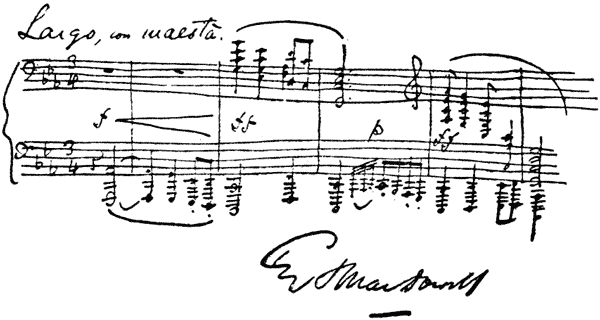
The matter of precedence in creative art is as hopeless of solution as
it is unimportant. And yet it seems appropriate to say, in writing of E.
A. MacDowell, that an almost unanimous vote would grant him rank as the
greatest of American composers, while not35 a few ballots would indicate
him as the best of living music writers.
But this, to repeat, is not vital, the main thing being that MacDowell
has a distinct and impressive individuality, and uses his profound
scholarship in the pursuit of novelty that is not cheaply sensational,
and is yet novelty. He has, for instance, theories as to the textures of
sounds, and his chord-formations and progressions are quite his own.
His compositions are superb processions, in which each participant is
got up with the utmost personal splendor. His generalship is great
enough to preserve the unity and the progress of the pageant. With him
no note in the melody is allowed to go neglected, ill-mounted on common
chords in the bass, or cheap-garbed in trite triads. Each tone is made
to suggest something of its multitudinous possibilities. Through any
geometrical point, an infinite number of lines can be drawn. This is
almost the case with any36 note of a melody. It is the recognition and
the practice of this truth that gives the latter-day schools of music
such a lusciousness and warmth of harmony. No one is a more earnest
student of these effects than MacDowell.
He believes that it is necessary, at this late day, if you would have a
chord "bite," to put a trace of acid in its sweetness. With this clue in
mind, his unusual procedures become more explicable without losing their
charm.
New York is rather the Mecca than the birthplace of artists, but it can
boast the nativity of MacDowell, who improvised his first songs here
December 18, 1861. He began the study of the piano at an early age. One
of his teachers was Mme. Teresa Carreño, to whom he has dedicated
his second concerto for the piano.
In 1876 he went to Paris and entered the Conservatoire, where he studied
theory under37 Savard, and the piano under Marmontel. He went to
Wiesbaden to study with Ehlert in 1879, and then to Frankfort, where
Carl Heyman taught him piano and Joachim Raff composition. The influence
of Raff is of the utmost importance in MacDowell's music, and I have
been told that the great romancist made a protégé of
him, and would lock him in a room for hours till he had worked out the
most appalling musical problems. Through Raff's influence he became
first piano teacher at the Darmstadt Conservatorium in 1881. The next
year Raff introduced him to Liszt, who became so enthusiastic over his
compositions that he got him the honor of playing his first piano suite
before the formidable Allgemeiner Deutscher Musik Verein, which
accorded him a warm reception. The following years were spent in
successful concert work, till 1884, when MacDowell settled down to
teaching and composing in Wiesbaden. Four years later he came to Boston,
38 writing, teaching, and giving occasional concerts. Thence he returned
to New York, where he was called to the professorship of music at
Columbia University. Princeton University has given him that unmusical
degree, Mus. Doc.
MacDowell has met little or none of that critical recalcitrance that
blocked the early success of so many masters. His works succeeded from
the first in winning serious favor; they have been much played in
Germany, in Vienna, St. Petersburg, Amsterdam, and Paris, one of them
having been performed three times in a single season at Breslau.
MacDowell's Scotch ancestry is always telling tales on him. The "Scotch
snap" is a constant rhythmic device, the old scale and the old Scottish
cadences seem to be native to his heart. Perhaps one might find some
kinship between MacDowell and the contemporary Glasgow school of
painters, that clique so isolated, so daring, and yet so ear39nest
and solid. Says James Huneker in a
monograph published some years ago: "His coloring reminds me at times of
Grieg, but when I tracked the resemblance to its lair, I found only
Scotch, as Grieg's grand-folk were Greggs, and from Scotland. It is all
Northern music with something elemental in it, and absolutely free from
the heavy, languorous odors of the South or the morbidezza of Poland."
Some of MacDowell's most direct writing has been in the setting of the
poems of Burns, such as "Deserted" ("Ye banks and braes o' bonnie Doon,"
op. 9), "Menie," and "My Jean" (op. 34). These are strongly marked by
that ineffably fine melodic flavor characteristic of Scottish music,
while in the accompaniments they admit a touch of the composer's own
individuality. In his accompaniments it is noteworthy that he is almost
never strictly contramelodic.
The songs of opera 11 and 12 have a40 decided Teutonism, but he has found
himself by opus 40, a volume of "Six Love Songs," containing half a
dozen flawless gems it is a pity the public should not know more widely.
A later book, "Eight Songs" (op. 47), is also a cluster of worthies. The
lilt and sympathy of "The Robin Sings in the Apple-tree," and its
unobtrusive new harmonies and novel effects, in strange accord with
truth of expression, mark all the other songs, particularly the
"Midsummer Lullaby," with its accompaniment as delicately tinted as
summer clouds. Especially noble is "The Sea," which has all the boom and
roll of the deep-brooding ocean.
His collections of flower-songs (op. 26) I confess not liking. Though
they are not without a certain exquisiteness, they seem overdainty and
wastefully frail, excepting, possibly, the "Clover" and the "Blue-bell."
It is not at all their brevity, but their triviality, that vexes an
admirer of the large ability41 that labored over them. They are dedicated
to Emilio Agramonte, one of MacDowell's first prophets, and one of the
earliest and most active agents for the recognition of the American
composer.
In the lyrics in opus 56 and opus 58 MacDowell has turned song to the
unusual purposes of a landscape impressionism of places and moods rather
than people.
For men's voices there are some deftly composed numbers curiously
devoted to lullaby subjects. The barcarolle for mixed chorus and
accompaniment on the piano for four hands obtains a wealth of color,
enhanced by the constant division of the voices.
Studying as he did with Raff, it is but natural that MacDowell should
have been influenced strongly toward the poetic and fantastic and
programmatic elements that mark the "Forest Symphony" and the "Lenore
Overture" of his master.
It is hard to say just how far this descrip42tive music can go. The
skill of each composer must dictate his own limits. As an example of
successful pieces of this kind, consider MacDowell's "The Eagle." It is
the musical realization of Tennyson's well-known poem:
"He clasps the crag with crooked hands;
Close to the sun in lonely lands,
Ring'd with the azure world, he stands.
The wrinkled sea beneath him crawls;
He watches from his mountain walls,
And like a thunderbolt he falls."
Of course the crag and the crooked hands and the azure world must be
granted the composer, but general exaltation and loneliness are
expressed in the severe melody of the opening. The wrinkling and
crawling of the sea far below are splendidly achieved in the soft,
shimmering liquidity of the music. Then there are two abrupt, but soft,
short chords that will represent, to the imaginative, the quick fixing
of the eagle's heart on some43 prey beneath; and there follows a sudden
precipitation down the keyboard, fortississimo, that represents the
thunderous swoop of the eagle with startling effect.
On the other hand, the "Moonshine" seems to be attempting too much.
"Winter" does better, for it has a freezing stream, a mill-wheel, and a
"widow bird." These "four little poems" of opus 32 had been preceded by
six fine "Idylls" based on lyrics of Goethe's. The first, a forest
scene, has a distinct flavor of the woods, the second is all laziness
and drowsiness, and the third is moonlight mystery. The fourth is as
intense in its suppressed spring ecstasy as the radiant poem itself
singing how
"Soft the ripples spill and hurry
To the opulent embankment."
The six short "Poems" (op. 31) based on poems of Heine's are
particularly successful, especially in the excellent opportunity of the44
lyric describing the wail of the Scottish woman who plays her harp on
the cliff, and sings above the raging of sea and wind. The third catches
most happily the whimsicality of the poet's reminiscences of childhood,
but hardly, I think, the contrasting depth and wildness of his complaint
that, along with childhood's games, have vanished Faith and Love and
Truth. In the last, however, the cheery majesty that realizes Heine's
likening of Death to a cool night after the sultry day of Life, is
superb.
Then there are some four-hand pieces, two collections, that leave no
excuse for clinging to the hackneyed classics or modern trash. They are
not at all difficult, and the second player has something to employ his
mind besides accompanying chords. They are meaty, and effective almost
to the point of catchiness. The "Tale of the Knights" is full of
chivalric fire and martial swing, while the "Ballad" is as exquisitely
dainty as a peach-45blossom. The "Hindoo Maiden" has a deal of the
thoroughly Oriental color and feeling that distinguish the three solos
of "Les Orientales," of which "Clair de Lune" is one of his most
original and graceful writings. The duet, "In Tyrol," has a wonderful
crystal carillon and a quaint shepherd piping a faint reminiscence of
the Wagnerian school of shepherds. This is one of a series of "Moon
Pictures" for four hands, based on Hans Christian Andersen's lore. Two
concertos for piano and orchestra are dazzling feats of virtuosity; one
of them is reviewed at length in A.J. Goodrich' book, "Musical
Analysis." He has written also a book of artistic moment called "Twelve
Virtuoso-Studies," and two books of actual gymnastics for piano
practice.
CLAIR DE LUNE.
La lune était sereine et jouait sur les flots.
La fenêtre enfin libre est ouverte à la brise;
La sultane regarde, et la mer qui se brise,
Là-bas, d'un flot d'argent brode les noir îlots.
(Victor Hugo, "Les Orientales.")
[Listen]
E.A. MACDOWELL, Op. 37, No. 1.
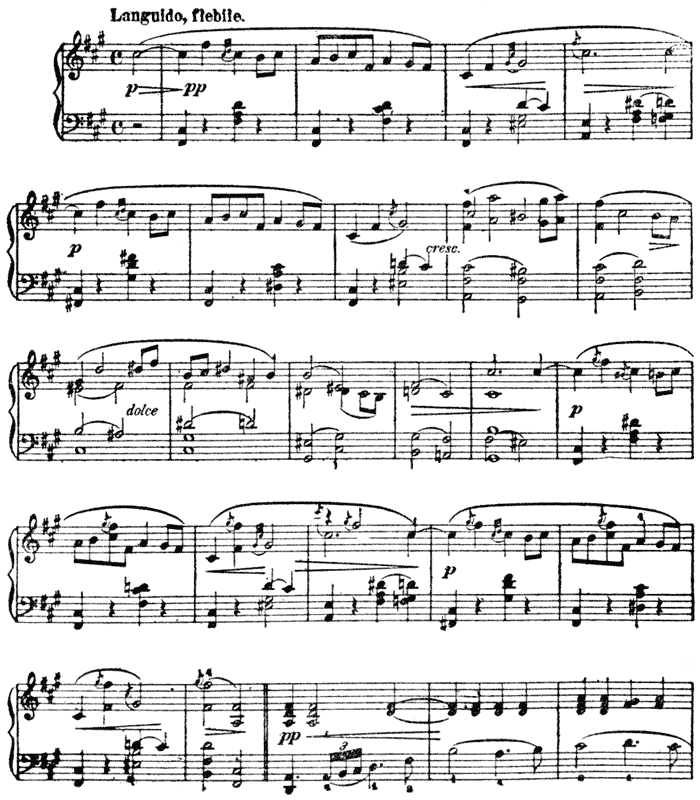
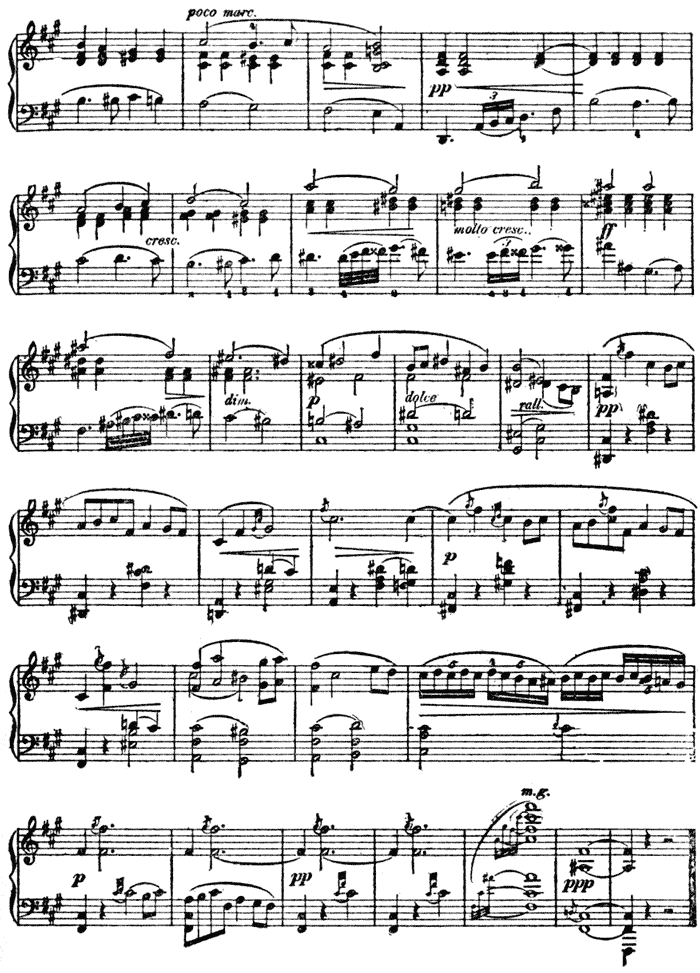
Copyright, 1889, Arthur P. Schmidt.
But MacDowell did not reach his freedom without a struggle against
academia. His opus 10 is a piano suite published at the age of
twenty-two, and opus 14 is another; both contain such obsolescences as a
presto, fugue,48 scherzino, and the like. But for all the classic garb,
the hands are the hands of Esau. In one of the pieces there is even a
motto tucked, "All hope leave ye behind who enter here!" Can he have
referred to the limbo of classicism?
It is a far cry from these to the liberality that inspired the new
impressionism of "Woodland Sketches" (op. 51) and "Sea Pieces" (op. 55),
in which he gives a legitimate musical presentation of a faintly
perfumed "Wild Rose" or "Water Lily," but goes farther, and paints, with
wonderful tone, the moods inspired by reverie upon the uncouth dignity
and stoic savagery of "An Indian Lodge," the lonely New England twilight
of "A Deserted Farm," and all the changing humors of the sea, majesty of
sunset or star-rise, and even the lucent emerald of an iceberg. His
"From Uncle Remus" is not so successful; indeed, MacDowell is not
sympathetic with negro music, and thinks49 that if we are to found a
national school on some local manner, we should find the Indian more
congenial than the lazy, sensual slave.
He has carried this belief into action, not only by his scientific
interest in the collection and compilation of the folk-music of our
prairies, but by his artistic use of actual Indian themes in one of his
most important works, his "Indian Suite" for full orchestra, a work that
has been often performed, and always with the effect of a new and
profound sensation, particularly in the case of the deeply impressive
dirge.
A proof of the success of MacDowell as a writer in the large forms is
the fact that practically all of his orchestral works are published in
Germany and here, not only in full score, but in arrangement for four
hands. They include "Hamlet;" "Ophelia" (op. 22); "Launcelot and Elaine"
(op. 26), with its strangely mellow and varied use of horns for
Launcelot, and the entrusting of the50 plaintive fate of "the lily maid
of Astolat" to the string and wood-wind choirs; "The Saracens" and "The
Lovely Alda" (op. 30), two fragments from the Song of Roland; and the
Suite (op. 42), which has been played at least eight times in Germany
and eleven times here.
The first movement of this last is called "In a Haunted Forest." You are
reminded of Siegfried by the very name of the thing, and the music
enforces the remembrance somewhat, though very slightly.
Everything reminds one of Wagner nowadays,—even his predecessors.
Rudyard Kipling has by his individuality so copyrighted one of the
oldest verse-forms, the ballad, that even "Chevy Chace" looks like an
advance plagiarism. So it is with Wagner. Almost all later music, and
much of the earlier, sounds Wagnerian. But MacDowell has been reminded
of Bayreuth very infrequently in this work. The opening move51ment
begins with a sotto voce syncopation
that is very presentative of the curious audible silence of a forest.
The wilder moments are superbly instrumented.
The second movement, "Summer Idyl," is delicious, particularly in the
chances it gives the flautist. There is a fragmentary cantilena which
would make the fortune of a comic opera. The third number, "In October,"
is particularly welcome in our music, which is strangely and sadly
lacking in humor. There is fascinating wit throughout this harvest
revel. "The Shepherdess' Song" is the fourth movement. It is not
précieuse, and it is not banal; but its simplicity of pathos is a
whit too simple. The final number, "Forest Spirits," is a brilliant
climax. The Suite as a whole is an important work. It has detail of the
most charming art. Best of all, it is staunchly individual. It is
MacDowellian.
While the modern piano sonata is to me52 anathema as a rule, there are
none of MacDowell's works that I like better than his writings in this
form. They are to me far the best since Beethoven, not excepting even
Chopin's (pace his greatest prophet, Huneker). They seem to me to be
of such stuff as Beethoven would have woven had he known in fact the
modern piano he saw in fancy.
The "Sonata Tragica" (op. 45) begins in G minor, with a bigly
passionate, slow introduction (metronomed in the composer's copy,
 -50).
The first subject is marked in the same copy, though
not in the printed book,
-50).
The first subject is marked in the same copy, though
not in the printed book,  -69,
and the appealingly pathetic
second subject is a little slower. The free fantasy is full of storm and
stress, with a fierce pedal-point on the trilled leading-tone. In the
reprise the second subject, which was at first in the dominant major, is
now in the tonic major, though the key of the sonata is G minor. The
allegro is metronomed
-69,
and the appealingly pathetic
second subject is a little slower. The free fantasy is full of storm and
stress, with a fierce pedal-point on the trilled leading-tone. In the
reprise the second subject, which was at first in the dominant major, is
now in the tonic major, though the key of the sonata is G minor. The
allegro is metronomed  -138,
and it is very short and very
wild. Through53out, the grief is the grief of a strong soul; it never
degenerates into whine. Its largo is like the tread of an
Æschylean choros, its allegro movements are wild with anguish,
and the occasional uplifting into the major only emphasizes the sombre
whole, like the little rifts of clearer harmony in Beethoven's "Funeral
March on the Death of a Hero."
-138,
and it is very short and very
wild. Through53out, the grief is the grief of a strong soul; it never
degenerates into whine. Its largo is like the tread of an
Æschylean choros, its allegro movements are wild with anguish,
and the occasional uplifting into the major only emphasizes the sombre
whole, like the little rifts of clearer harmony in Beethoven's "Funeral
March on the Death of a Hero."
The last movement begins with a ringing pomposo, and I cannot explain
its meaning better than by quoting Mrs. MacDowell's words: "Mr.
MacDowell's idea was, so to speak, as follows: He wished to heighten the
darkness of tragedy by making it follow closely on the heels of triumph.
Therefore, he attempted to make the last movement a steadily progressive
triumph, which, at its climax, is utterly broken and shattered. In doing
this he has tried to epitomize the whole work. While in the other
movements he aimed at expressing tragic details, in the last he has
tried to generalize; thinking that the54 most poignant tragedy is that of
catastrophe in the hour of triumph."
The third sonata (op. 57) is dedicated to Grieg and to the musical
exploitation of an old-time Skald reciting glorious battles, loves, and
deaths in an ancient castle. The atmosphere of mystery and barbaric
grandeur is obtained and sustained by means new to piano literature and
potent in color and vigor. The sonata formula is warped to the purpose
of the poet, but the themes have the classic ideal of kinship. The
battle-power of the work is tremendous. Huneker calls it "an epic of
rainbow and thunder," and Henry T. Finck, who has for many years devoted
a part of his large ardor to MacDowell's cause, says of the work: "It is
MacDowellish,—more MacDowellish than anything he has yet written.
It is the work of a musical thinker. There are harmonies as novel as
those we encounter in Schubert, Chopin, or Grieg, yet with a stamp of
their own."55
The "Sonata Eroica" (op. 50) bears the legend "Flos regum Arthurus." It
is also in G minor. The spirit of King Arthur dominates the work
ideally, and justifies not only the ferocious and warlike first subject
with its peculiar and influential rhythm, but the old-fashioned and
unadorned folk-tone of the second subject. In the working out there is
much bustle and much business of trumpets. In the reprise the folk-song
appears in the tonic minor, taken most unconventionally in the bass
under elaborate arpeggiations in the right hand. The coda, as in the
other sonata, is simply a strong passage of climax. Arthur's
supernatural nature doubtless suggested the second movement, with its
elfin airs, its flibbertigibbet virtuosity, and its magic of color. The
third movement might have been inspired by Tennyson's version of
Arthur's farewell to Guinevere, it is such a rich fabric of grief. The
finale seems to me to picture the Morte d'Arthur, beginning with the
fury of a56 storm along the coast, and the battle "on the waste sand by
the waste sea." Moments of fire are succeeded by exquisite deeps of
quietude, and the death and apotheosis of Arthur are hinted with daring
and complete equivalence of art with need.
Here is no longer the tinkle and swirl of the elf dances; here is no
more of the tireless search for novelty in movement and color. This is
"a flash of the soul that can." Here is Beethoven redivivus. For half
a century we have had so much pioneering and scientific exploration
after piano color and tenderness and fire, that men have neglected its
might and its tragic powers. Where is the piano-piece since Beethoven
that has the depth, the breadth, the height of this huge solemnity?
Chopin's sensuous wailing does not afford it. Schumann's complex
eccentricities have not given it out. Brahms is too passionless. Wagner
neglected the piano. It remained for a Yankee to find the austere57
peak again! and that, too, when the sonata
was supposed to be a form as exhausted as the epic poem. But all this is
the praise that one is laughed at for bestowing except on the graves of
genius.
The cautious Ben Jonson, when his erstwhile taproom roisterer, Will
Shakespeare, was dead, defied "insolent Greece or haughty Rome" to show
his superior. With such authority, I feel safe in at least defying the
contemporary schools of insolent Russia or haughty Germany to send forth
a better musicwright than our fellow townsman, Edward MacDowell.
Edgar Stillman Kelley.
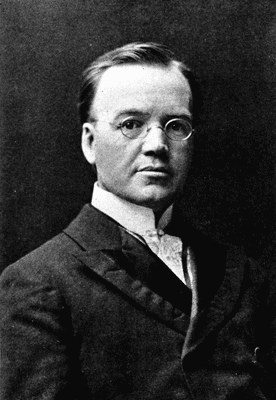
EDGAR STILLMAN KELLEY.
While his name is known wherever
American music is known in its better aspects,
yet, like many another American, his
real art can be discovered only from his
manuscripts. In these he shows a very58
munificence of enthusiasm, scholarship, invention,
humor, and originality.
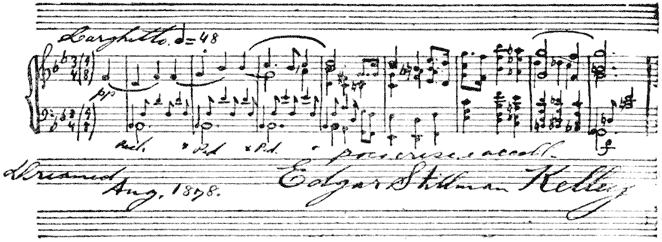
Kelley is as thorough an American by
descent as one could ask for, his maternal
ancestors having settled in this country in
1630, his paternal progenitors in 1640,
A.D. Indeed, one of the ancestors of his
father made the dies for the pine-tree shilling,
and a great-great-grandfather fought in
the Revolution.
Kelley began his terrestrial career April
14, 1857, in Wisconsin. His father was a
revenue officer; his mother a skilled musician,
who taught him the piano from his
eighth year to his seventeenth, when he went59
to Chicago and studied harmony and counterpoint
under Clarence Eddy, and the piano
under Ledochowski. It is interesting to note
that Kelley was diverted into music from
painting by hearing "Blind Tom" play Liszt's
transcription of Mendelssohn's "Midsummer
Night's Dream" music. I imagine that this
idiot-genius had very little other influence of
this sort in his picturesque career.
After two years in Chicago, Kelley went
to Germany, where, in Stuttgart, he studied
the piano with Kruger and Speidel, organ
with Finck, composition and orchestration
with Seiffritz. While in Germany, Kelley
wrote a brilliant and highly successful concert
polonaise for four hands, and a composition
for strings.
In 1880 he was back in America and
settled in San Francisco, with whose musical
life he was long and prominently identified
as a teacher and critic. Here he wrote his
first large work, the well-known melodramatic60
music to "Macbeth." A local benefactor,
John Parrot, paid the expenses of a public
performance, the great success of which
persuaded McKee Rankin, the actor, to
make an elaborate production of both play
and music. This ran for three weeks in San
Francisco to crowded houses, which is a remarkable
record for many reasons. A shabby
New York production at an ill-chosen theatre
failed to give the work an advantageous hearing;
but it has been played by orchestras
several times since, and William H. Sherwood
has made transcriptions of parts of it for
piano solo.
The "Macbeth" music is of such solid
value that it reaches the dignity of a flowing
commentary. Beyond and above this it is an
interpretation, making vivid and awesome the
deep import of the play, till even the least
imaginative auditor must feel its thrill.
Thus the gathering of the witches begins
with a slow horror, which is surely Shake61speare's
idea, and not the comic-opera can-can
it is frequently made. As various other
elfs and terrors appear, they are appropriately
characterized in the music, which also adds
mightily to the terror of the murder scene.
Throughout, the work is that of a thinker.
Like much of Kelley's other music, it is also
the work of a fearless and skilled programmatist,
especially in the battle-scenes, where
it suggests the crash of maces and swords,
and the blare of horns, the galloping of
horses, and the general din of huge battle.
Leading-motives are much used, too, with
good effect and most ingenious elaboration,
notably the Banquo motive. A certain
amount of Gaelic color also adds interest
to the work, particularly a stirring Gaelic
march. The orchestration shows both
scholarship and daring.
An interesting subject is suggested by
Kelley's experience in hunting out a good
motif for the galloping horses of "Macbeth." 62
He could find nothing suitably representative
of storm-hoofed chargers till his dreams came
to the rescue with a genuinely inspired theme.
Several other exquisite ideas have come to
him in his sleep in this way; one of them
is set down in the facsimile reproduced
herewith. On one occasion he even dreamed
an original German poem and a fitting musical
setting.
Dr. Wm. A. Hammond, in his book on
"Sleep and Its Derangements," is inclined
to scout the possibility of a really valuable
inspiration in sleep. He finds no satisfactory
explanation for Tartini's famous "Devil's
Sonata" or Coleridge' proverbial "Kubla
Khan." He takes refuge in saying that at
least the result could not be equal to the
dreamer's capabilities when awake; but
Kelley's "Macbeth" music was certainly
an improvement on what he could invent out
of the land of Nod.
After composing a comic opera, which63
was refused by the man for whom it was written
because it was too good, he drifted into
journalism, and wrote reviews and critiques
which show a very liberal mind capable
of appreciating things both modern and
classic.
Kelley was again persuaded to write a
comic opera to the artistic libretto, "Puritania,"
by C.M.S. McLellan, a brilliant
satirist, who has since won fortune by his
highly successful and frequently artistic burlesquery.
The work won excellent praise in
Boston, where it had one hundred performances.
The work musically was not only
conscientious, but really graceful and captivating.
It received the most glowing encomiums
from people of musical culture, and
largely enhanced Kelley's musical reputation
in its run of something over a year. On its
tour Kelley was also the musical conductor,
in which capacity he has frequently served
elsewhere.64
Kelley plainly deserves preëminence among
American composers for his devotion to, and
skill in, the finer sorts of humorous music.
No other American has written so artfully,
so happily, or so ambitiously in this field. A
humorous symphony and a Chinese suite
are his largest works on this order.
The symphony follows the life of "Gulliver
in Lilliput." In development and intertwining
of themes and in brilliance of orchestration,
it maintains symphonic dignity, while in
play of fancy, suggestive programmaticism,
and rollicking enthusiasm it is infectious
with wit. Gulliver himself is richly characterized
with a burly, blustering English
theme. The storm that throws him on the
shores of Lilliput is handled with complete
mastery, certain phrases picturing the toss of
the billows, another the great roll of the
boat, others the rattle of the rigging and the
panic of the crew; and all wrought up to a
demoniac climax at the wreck. As the 65
stranded Gulliver falls asleep, the music hints
his nodding off graphically. The entrance of
the Lilliputians is perhaps the happiest bit
of the whole delicious work. By adroit devices
in instrumentation, their tiny band
toots a minute national hymn of irresistible
drollery. The sound of their wee hammers
and the rest of the ludicrous adventures are
carried off in unfailing good humor. The
scene finally changes to the rescuing ship.
Here a most hilarious hornpipe is interrupted
by the distant call of Gulliver's aria, and the
rescue is consummated delightfully.
In nothing has Kelley showed such wanton
scholarship and such free-reined fancy as in
his Chinese suite for orchestra, "Aladdin." It
is certainly one of the most brilliant musical
feats of the generation, and rivals Richard
Strauss in orchestral virtuosity.
While in San Francisco, where, as every
one knows, there is a transplanted corner of
China, Kelley sat at the feet of certain Celes66tial
cacophonists, and made himself adept.
He fathomed the, to us, obscure laws of
their theory, and for this work made a careful
selection of Chinese musical ideas, and
used what little harmony they approve of
with most quaint and suggestive effect upon
a splendid background of his own. The result
has not been, as is usual in such alien
mimicries, a mere success of curiosity.
The work had its first accolade of genius
in the wild protests of the music copyists,
and in the downright mutiny of orchestral
performers.
On the first page of the score is this note:
"This should be played with a bow unscrewed,
so that the hairs hang loose—thus the bow
never leaves the string." This direction is
evidently meant to secure the effect of the
Chinese violin, in which the string passes
between the hair and the wood of the bow,
and is played upon the under side. But
what self-respecting violinist could endure 67
such profanation without striking a blow for
his fanes?
The first movement of the suite is made
up of themes actually learned from Chinese
musicians. It represents the "Wedding of
Aladdin and the Princess," a sort of sublimated
"shivaree" in which oboes quawk,
muted trumpets bray, pizzicato strings flutter,
and mandolins (loved of Berlioz) twitter
hilariously.
The second movement, "A Serenade in
the Royal Pear Garden," begins with a luxurious
tone-poem of moonlight and shadow,
out of which, after a preliminary tuning of
the Chinese lute (or sam-yin), wails a lyric
caterwaul (alternately in 2-4 and 3-4 tempo)
which the Chinese translate as a love-song.
Its amorous grotesque at length subsides into
the majestic night. A part of this altogether
fascinating movement came to Kelley in a
dream.
The third chapter is devoted to the "Flight 68
of the Genie with the Palace," and there is a
wonderfully vivid suggestion of his struggle
to wrest loose the foundations of the building.
At length he heaves it slowly in the air, and
wings majestically away with it.
It has always seemed to me that the purest
stroke of genius in instrumentation ever
evinced was Wagner's conceit of using tinkling
bells to suggest leaping flames. And
yet quite comparable with this seems Kelley's
device to indicate the oarage of the genie's
mighty wings as he disappears into the
sky: liquid glissandos on the upper harp-strings,
with chromatic runs upon the elaborately
divided violins, at length changed to
sustained and most ethereally fluty harmonics.
It is very ravishment.
The last movement, "The Return and
Feast of the Lanterns," is on the sonata
formula. After an introduction typifying the
opening of the temple gates (a gong giving
the music further locale), the first theme is 69
announced by harp and mandolin. It is an
ancient Chinese air for the yong-kim (a dulcimer-like
instrument). The second subject
is adapted from the serenade theme. With
these two smuggled themes everything contrapuntal
(a fugue included) and instrumental
is done that technical bravado could suggest
or true art license. The result is a carnival
of technic that compels the layman to wonder
and the scholar to homage.
A transcription for a piano duet has been
made of this last movement.
In Chinese-tone also is Kelley's most popular
song, "The Lady Picking Mulberries,"
which brought him not only the enthusiasm
of Americans but the high commendation of
the Chinese themselves. It is written in the
limited Chinese scale, with harmonies of our
school; and is a humoresque of such catchiness
that it has pervaded even London and
Paris.
This song is one of a series of six lyrics 70
called "The Phases of Love," with this motive
from the "Anatomy of Melancholy": "I am
resolved, therefore, in this tragi-comedy of
love, to act several parts, some satirically,
some comically, some in a mixed tone." The
poems are all by American poets, and the
group, opus 6, is an invaluable addition to our
musical literature. The first of the series,
"My Silent Song," is a radiantly beautiful
work, with a wondrous tender air to a rapturous
accompaniment. The second is a setting
of Edward Rowland Sill's perfect little poem,
"Love's Fillet." The song is as full of art
as it is of feeling and influence. "What the
Man in the Moon Saw" is an engaging satire,
"Love and Sleep" is sombre, and "In a
Garden" is pathetic.
Besides two small sketches, a waltz and a
gavotte, and his own arrangements, for two
and for four hands, of the Gaelic March in
"Macbeth," Kelley has published only three
piano pieces: opus 2, "The Flower Seekers," 71
superb with grace, warm harmony, and May
ecstasies; "Confluentia," whose threads of
liquidity are eruditely, yet romantically, intertangled
to represent the confluence of the
Rhine and the Moselle; and "The Headless
Horseman," a masterpiece of burlesque weirdness,
representing the wild pursuit of Ichabod
Crane and the final hurling of the awful
head,—a pumpkin, some say. It is relieved
by Ichabod's tender reminiscences of Katrina
Van Tassel at the spinning-wheel, and is
dedicated to Joseffy, the pianist, who lives in
the region about Sleepy Hollow.
To supplement his successful, humorously
melodramatic setting of "The Little Old
Woman who Went to the Market her Eggs
for to Sell," Kelley is preparing a series
of similar pieces called "Tales Retold for
Musical Children." It will include "Gulliver,"
"Aladdin," and "Beauty and the
Beast."
Kelley once wrote music for an adapt72ation
of "Prometheus Bound," made by the
late George Parsons Lathrop for that ill-starred
experiment, the Theatre of Arts and
Letters. The same thoroughness of research
that gave Kelley such a command of Chinese
theories equipped him in what knowledge we
have of Greek and the other ancient music.
He has delivered a course of lectures on
these subjects, and this learning was put to
good and public use in his share in the staging
of the novel "Ben Hur." His music
had a vital part in carrying the play over the
thin ice of sacrilege; it was so reverent and
so appealing that the scrubwomen in the
theatre were actually moved to tears during
its rehearsal, and it gave the scene of the
miraculous cure of the lepers a dignity that
saved it from either ridicule or reproach.
In the first act there is a suggestion of the
slow, soft march of a caravan across the sand,
the eleven-toned Greek and Egyptian scale
being used. In the tent of the Sheik, an old 73
Arabian scale is employed. In the elaborate
ballets and revels in the "Grove of Daphne"
the use of Greek scales, Greek progressions
(such as descending parallel fourths long forbidden
by the doctors of our era), a trimetrical
grouping of measures (instead of our
customary fourfold basis), and a suggestion
of Hellenic instruments,—all this lore has
not robbed the scene in any sense of an irresistible
brilliance and spontaneity. The weaving
of Arachne's web is pictured with especial
power. Greek traditions have, of course,
been used only for occasional impressionisms,
and not as manacles. Elaborately colored
modern instrumentation and all the established
devices from canon up are employed.
A piano transcription of part of the music is
promised. The "Song of Iras" has been
published. It is full of home-sickness, and
the accompaniment (not used in the production)
is a wonderwork of color.
[Listen]
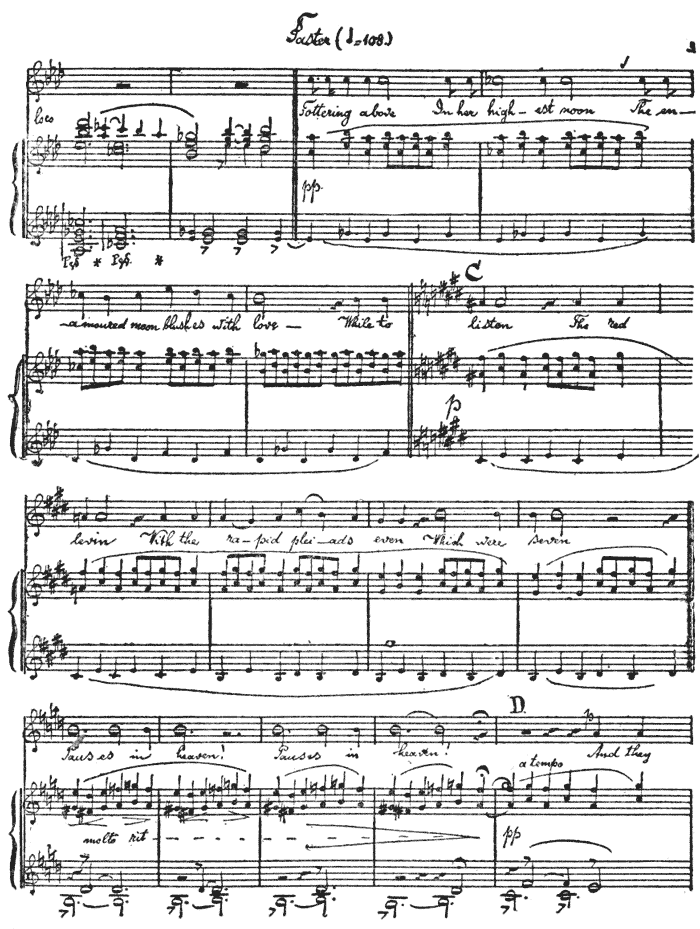
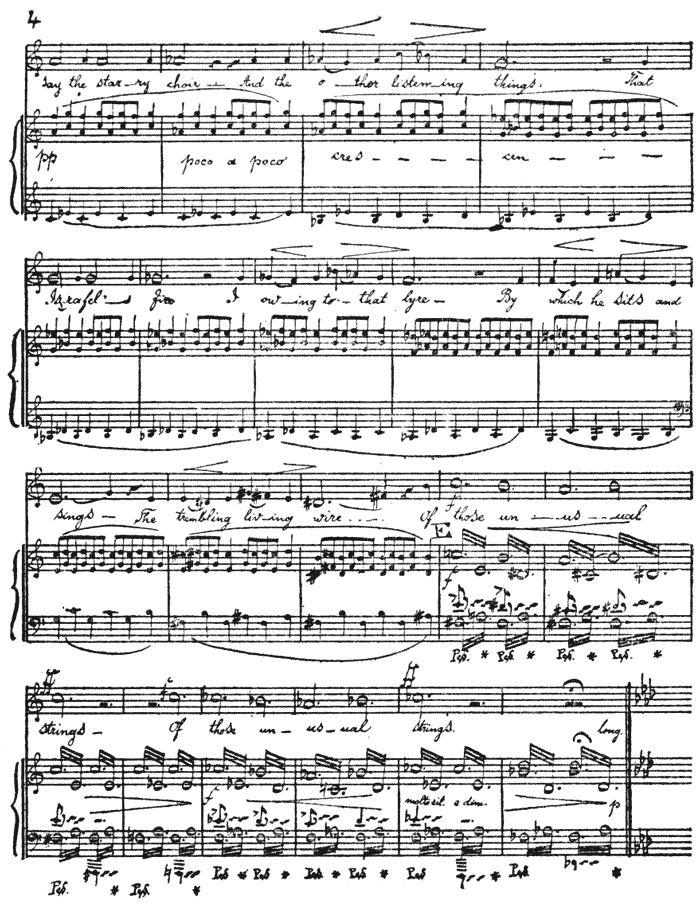
By permission.
Tottering above
In her highest noon
The enamoured moon blushes with love
While to listen
The red levin
With the rapid pleiads even
Which were seven
Pauses in heaven!
Pauses in heaven!
|
And they say the starry choir
And the other listening things,
That Israfel's fire is owing to that lyre
By which he sits and sings
The trembling living wire
Of those unusual strings
Of those unusual strings.
|
FRAGMENT OF "ISRAFEL," BY EDGAR S. KELLEY.
Kelley has two unpublished songs that
76show him at his best, both settings of verse
by Poe,—"Eldorado," which vividly develops
the persistence of the knight, and "Israfel."
This latter poem, as you know, concerns the
angel "whose heart-strings are a lute." After
a rhapsody upon the cosmic spell of the angel's
singing, Poe, with a brave defiance, flings an
implied challenge to him. The verse marks
one of the highest reaches of a genius honored
abroad as a world-great lyrist. It is,
perhaps, praise enough, then, to say that Kelley's
music flags in no wise behind the divine
progress of the words. The lute idea dictates
an arpeggiated accompaniment, whose harmonic
beauty and courage is beyond description
and beyond the grasp of the mind at the
first hearing. The bravery of the climax follows
the weird and opiate harmonies of the
middle part with tremendous effect. The
song is, in my fervent belief, a masterwork
of absolute genius, one of the very greatest
lyrics in the world's music.
77
Harvey Worthington Loomis.
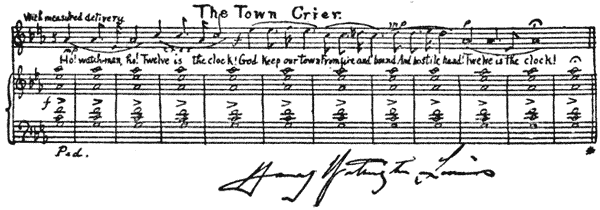
In the band of pupils that gathered to
the standard of the invader, Antonin Dvôrák,
when, in 1892, he came over here from Macedonia
to help us, some of the future's best
composers will probably be found.
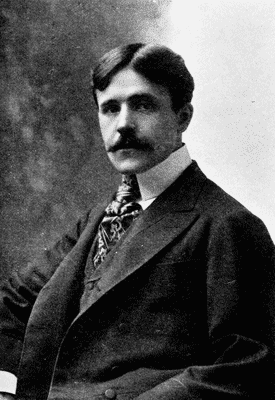
HARVEY WORTHINGTON LOOMIS.
Of this band was Harvey Worthington
Loomis, who won a three years' scholarship
in Doctor Dvôrák's composition class at the
National Conservatory, by submitting an excellent,
but rather uncharacteristic, setting of
Eichendorff's "Frühlingsnacht." Loomis evidently
won Doctor Dvôrák's confidence, for
among the tasks imposed on him was a piano
concerto to be built on the lines of so elaborate
a model as Rubinstein's in D minor. 78
When Loomis' first sketches showed an elaboration
even beyond the complex pattern,
Dvôrák still advised him to go on. To any
one that knows the ways of harmony teachers
this will mean much.
Loomis (who was born in Brooklyn, February
5, 1865, and is now a resident of New
York) pursued studies in harmony and piano
in a desultory way until he entered Doctor
Dvôrák's class. For his musical tastes he
was indebted to the artistic atmosphere of
his home.
Though Loomis has written something
over five hundred compositions, only a few
works have been published, the most important
of which are "Fairy Hill," a cantatilla
for children, published in 1896 (it was written
on a commission that fortunately allowed
him liberty for not a little elaboration and
individuality), "Sandalphon," and a few
songs and piano pieces.
A field of his art that has won his especial 79
interest is the use of music as an atmosphere
for dramatic expression. Of this sort are a
number of pantomimes, produced with much
applause in New York by the Academy of
Dramatic Arts; and several musical backgrounds.
The 27th of April, 1896, a concert
of his works was given by a number of
well-known artists.
These musical backgrounds are played in
accompaniment to dramatic recitations. Properly
managed, the effect is most impressive.
Féval's poem, "The Song of the Pear-tree,"
is a typically handled work. The poem tells
the story of a young French fellow, an orphan,
who goes to the wars as substitute for
his friend Jean. After rising from rank to
rank by bravery, he returns to his home just
as his sweetheart, Perrine, enters the church
to wed Jean. The girl had been his one
ambition, and now in his despair he reënlists
and begs to be placed in the thickest of danger.
When he falls, they find on his breast 80
a withered spray from the pear-tree under
which Perrine had first plighted troth. On
these simple lines the music builds up a
drama. From the opening shimmer and
rustle of the garden, through the Gregorian
chant that solemnizes the drawing of the
lots, and is interrupted by the youth's start
of joy at his own luck (an abrupt glissando);
through his sturdy resolve to go to war in
his friend's place, on through many battles
to his death, all is on a high plane that
commands sympathy for the emotion, and
enforces unbounded admiration for the art.
There is a brief hint of the Marseillaise
woven into the finely varied tapestry of martial
music, and when the lover comes trudging
home, his joy, his sudden knowledge of Perrine's
faithlessness, and his overwhelming
grief are all built over a long organ-point
of three clangorous bride-bells. The leit-motif
idea is used with suggestive clearness
throughout the work.81
The background to Longfellow's "Sandalphon"
is so fine an arras that it gives the
poet a splendor not usual to his bourgeois
lays. The music runs through so many
phases of emotion, and approves itself so
original and exaltedly vivid in each that I
put it well to the fore of American compositions.
Hardly less large is the—Loomis calls it
"Musical Symbolism," for Adelaide Ann
Proctor's "The Story of the Faithful Soul."
Of the greatest delicacy imaginable is the
music (for piano, violin, and voice) to William
Sharp's "Coming of the Prince." The
"Watteau Pictures" are poems of Verlaine's
variously treated: one as a head-piece to a
wayward piano caprice, one to be recited during
a picturesque waltz, the last a song with
mandolin effects in the accompaniment.
[Listen]
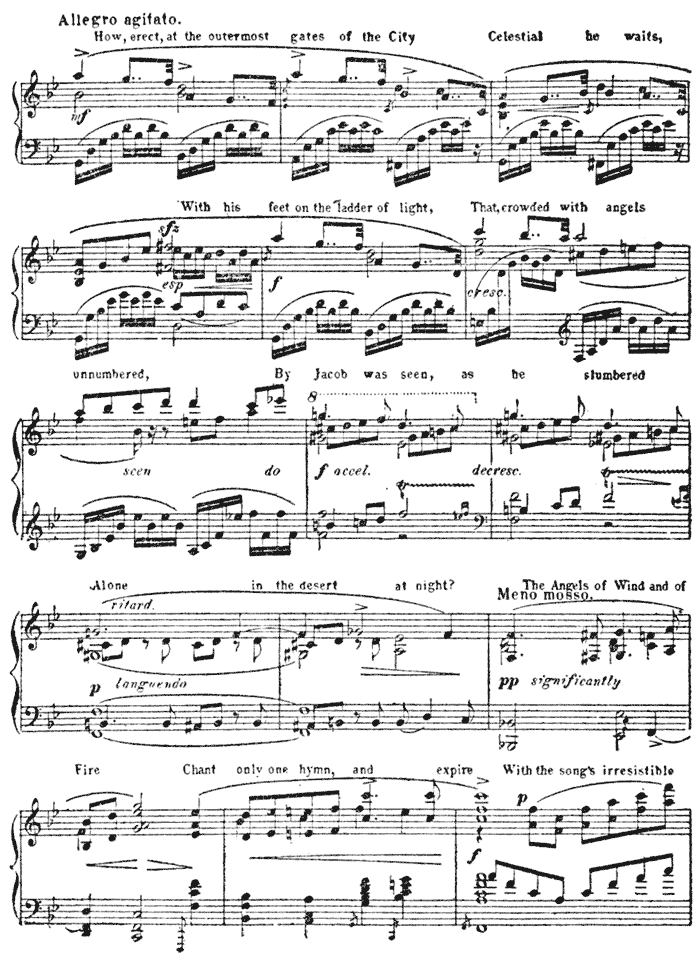
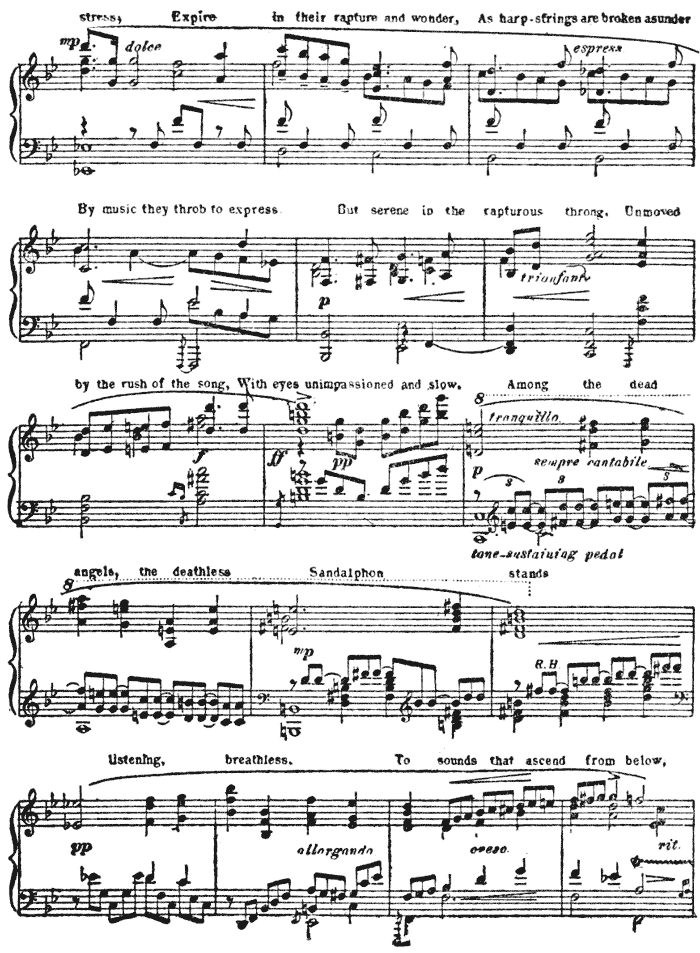
Copyright, 1896, by Edgar S. Werner.
How, erect, at the outermost gates of the City
Celestial he waits,
With his feet on the ladder of light,
That, crowded with angels unnumbered,
By Jacob was seen as he slumbered
Alone in the desert at night?
The Angels of Wind and of Fire
Chant only one hymn, and expire
With the song's irresistible stress,
Expire in their rapture and wonder,
As harp-strings are broken asunder
By music they throb to express.
But serene in the rapturous throng,
Unmoved by the rush of the song,
With eyes unimpassioned and slow,
Among the dead angels, the deathless
Sandalphon stands listening, breathless,
To sounds that ascend from below,...
A FRAGMENT OF "SANDALPHON," BY H.W. LOOMIS.
The pantomimes range from grave to gay,
most of the librettos in this difficult form
being from the clever hand of Edwin Starr
84
Belknap. "The Traitor Mandolin," "In Old
New Amsterdam," "Put to the Test,"
"Blanc et Noir," "The Enchanted Fountain,"
"Her Revenge," "Love and Witchcraft"
are their names. The music is full
of wit, a quality Loomis possesses in unusual
degree. The music mimics everything
from the busy feather-duster of the
maid to her eavesdropping. Pouring wine,
clinking glasses, moving a chair, tearing up
a letter, and a rollicking wine-song in pantomime
are all hinted with the drollest and
most graphic programmism imaginable.
Loomis has also written two burlesque
operas, "The Maid of Athens" and "The
Burglar's Bride," the libretto of the latter by
his brother, Charles Battell Loomis, the well-known
humorist. This latter contains some
skilful parody on old fogyism.
In the Violin Sonata the piano, while
granting precedence to the violin, approaches
almost to the dignity of a duet. The finale 85
is captivating and brilliant, and develops some
big climaxes. The work as a whole is really
superb, and ought to be much played. There
are, besides, a "Lyric Finale" to a sonata
not yet written, and several songs for violin,
voice, and piano.
A suite for four hands, "In Summer
Fields," contains some happy manifestations
of ability, such as "A June Roundelay,"
"The Dryad's Grove," and, especially, a humoresque
"Junketing," which is surely destined
to become a classic. From some of
his pantomimes Loomis has made excerpts,
and remade them with new elaboration for
two pianos, under the name of "Exotics."
These are full of variety and of actual novelty,
now of startling discord, now of revelatory
beauty. A so-called "Norland Epic,"
freely constructed on the sonata formula, is
one of Loomis' most brilliant and personal
achievements.
Loomis has an especial aptitude for writing 86
artistic ballet-music, and for composing in the
tone of different nationalities, particularly
the Spanish. His pantomimes contain many
irresistible dances, one of them including a
Chinese dance alternating 4-4 with 3-4 time.
His strikingly fleet "Harlequin" has been
published.
The gift of adding art to catchiness is a
great one. This Loomis seems to have to an
unusual degree, as is evidenced by the dances
in his pantomimes and his series of six pieces
"In Ballet Costume," all of them rich with
the finest art along with a Strauss-like spontaneity.
These include "L'Amazone," "Pirouette,"
"Un Pas Seul," "La Coryphée," "The
Odalisque," and "The Magyar." One of his
largest works is a concert waltz, "Mi-Carême,"
for two pianos, with elaborate and extended
introduction and coda.
A series of Genre Pictures contains such
lusciousness of felicity as "At an Italian
Festival," and there are a number of musical 87
moments of engaging charm, for instance,
"N'Importe Quoi," "From a Conservatory
Program," "A Tropical Night," a fascinating
"Valsette," a nameless valse, and
"Another Scandal," which will prove a gilt-edged
speculation for some tardy publisher.
It is brimming with the delicious horror
of excited gossipry. An example of how
thoroughly Loomis is invested with music—how
he thinks in it—is his audacious scherzo,
"The Town Crier," printed herewith.
In songs Loomis has been most prolific.
He has set twenty-two of Shakespeare's lyrics
to music of the old English school, such as
his uproarious "Let me the cannikin clink,"
and his dainty "Tell me where is fancy
bred."
"The Lark" is written in the pentatonic
scale, with accompaniment for two flutes and
a harp.
In the same vein are various songs of
Herrick, a lyrist whose verse is not usu88ally
congenial to the modern music-maker.
Loomis' "Epitaph on a Virgin" must be
classed as a success. Indeed, it reaches positive
grandeur at its climax, wherein is woven
the grim persistence of a tolling bell. In
the same style is a clever setting of Ben
Jonson's much music'd "To Celia."
In German-tone are his veritably magnificent
"Herbstnacht" and his "At Midnight,"
two studies after Franz. Heine's "Des
Waldes Kapellmeister" has been made into
a most hilarious humoresque.
"Bergerie" is a dozen of Norman Gale's
lyrics. "Andalusia" is a flamboyant duet.
In Scotch songs there is a positive embarrassment
of riches, Loomis' fancies finding
especial food and freedom in this school. I
find in these settings far more art and grace
than I see even in Schumann's many Scotch
songs, or those of any other of the Germans.
"Oh, for Ane and Twenty" has bagpipe
effects. Such flights of ecstasy as "My 89
Wife's a Winsome Wee Thing," and "Bonnie
Wee Thing," are simply tyrannical in their
appeal. Then there is an irresistible "Polly
Stewart;" and "My Peggy's Heart" is fairly
ambrosial. These and several others, like
"There Was a Bonnie Lass," could be made
into an album of songs that would delight a
whole suite of generations.
A number of his songs are published:
they include a "John Anderson, My Jo," that
has no particular right to live; a ballad,
"Molly," with a touch of art tucked into it;
the beautiful "Sylvan Slumbers," and the
quaint and fascinating "Dutch Garden."
Aside from an occasional song like "Thistledown,"
with its brilliantly fleecy accompaniment,
and the setting of Browning's
famous "The Year' at the Spring," for which
Loomis has struck out a superb frenzy, and
a group of songs by John Vance Cheney,
Loomis has found some of his most powerful
inspirations in the work of our lyrist, Aldrich,90—such
as the rich carillon of "Wedded,"
and his "Discipline," one of the best of
all humorous songs, a gruesome scherzo all
about dead monks, in which the music
furnishes out the grim irreverence of the
words with the utmost waggery.
Chief among the lyrics by Cheney are
three "Spring Songs," in which Loomis has
caught the zest of spring with such rapture
that, once they are heard, the world seems
poor without them in print. Loomis' literary
culture is shown in the sure taste of his
selection of lyrics for his music. He has
marked aptitudes, too, in creative literature,
and has an excellent idea of the arts kindred
to his own, particularly architecture.
Like Chopin, Loomis is largely occupied in
mixing rich new colors on the inexhaustible
palette of the piano. Like Chopin, he is not
especially called to the orchestra. What the
future may hold for him in this field (by no
means so indispensable to classic repute as 91
certain pedants assume) it is impossible to
say. In the meantime he is giving most of
his time to work in larger forms.
If in his restless hunt for novelty, always
novelty, he grows too original, too unconventional,
this sin is unusual enough to approach
the estate of a virtue. But his oddity is not
mere sensation-mongering. It is his individuality.
He could make the same reply
to such criticism that Schumann made; he
thinks in strange rhythms and hunts curious
effects, because his tastes are irrevocably so
ordained.
But we ought to show a new genius the
same generosity toward flaws that we extend
toward the masters whose fame is won beyond
the patronage of our petty forgiveness. And,
all in all, I am impelled to prophesy to Loomis
a place very high among the inspired makers
of new music. His harmonies, so indefatigably
searched out and polished to splendor,
so potent in enlarging the color-scale of the 92
piano; his patient building up, through long
neglect and through long silence, of a monumental
group of works and of a distinct
individuality, must prove at some late day
a source of lasting pride to his country,
neglectful now in spite of itself. But better
than his patience, than his courage, than his
sincerity, better than that insufficient definition
of genius,—the capacity for taking
infinite pains,—is his inspired felicity. His
genius is the very essence of felicity.
Ethelbert Nevin.
It is refreshing to be able to chronicle the
achievements of a composer who has become
financially successful without destroying his
claim on the respect of the learned and
severe, or sacrificing his own artistic conscience
and individuality. Such a composer
is Ethelbert Nevin.
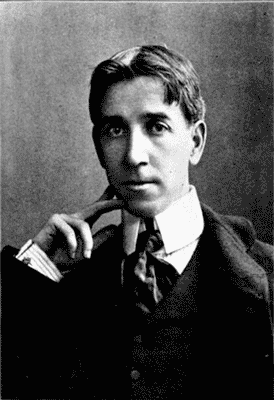
ETHELBERT NEVIN.
His published writings have been altogether 93
along the smaller lines of composition, and he
has won an enviable place as a fervent worker
in diamonds. None of his gems are paste,
and a few have a perfection, a solidity, and a
fire that fit them for a place in that coronet
one might fancy made up of the richest of
the jewels of the world's music-makers, and
fashioned for the very brows of the Muse
herself.
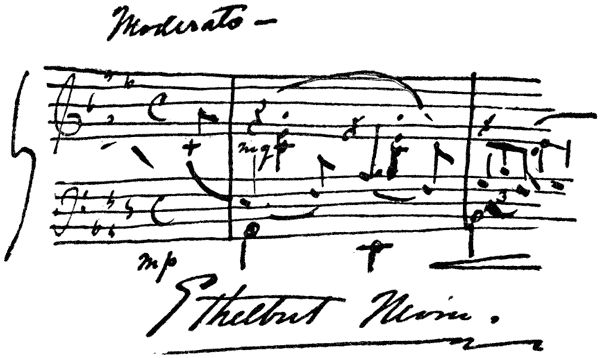
Nevin was born in 1862, at Vineacre, on
the banks of the Ohio, a few miles from Pittsburgh.
There he spent the first sixteen years
of his life, and received all his schooling, 94
most of it from his father, Robert P. Nevin,
editor and proprietor of a Pittsburgh newspaper,
and a contributor to many magazines.
It is interesting to note that he also composed
several campaign songs, among them
the popular "Our Nominee," used in the day
of James K. Polk's candidacy. The first
grand piano ever taken across the Allegheny
Mountains was carted over for Nevin's
mother.
From his earliest infancy Nevin was musically
inclined, and, at the age of four, was
often taken from his cradle to play for
admiring visitors. To make up for the deficiency
of his little legs, he used to pile
cushions on the pedals so that he might
manipulate them from afar.
Nevin's father provided for his son both
vocal and instrumental instruction, even taking
him abroad for two years of travel and
music study in Dresden under Von Böhme.
Later he studied the piano for two years at 95
Boston, under B.J. Lang, and composition
under Stephen A. Emery, whose little primer
on harmony has been to American music almost
what Webster's spelling-book was to our
letters.
At the end of two years he went to Pittsburgh,
where he gave lessons, and saved
money enough to take him to Berlin. There
he spent the years 1884, 1885, and 1886,
placing himself in the hands of Karl Klindworth.
Of him Nevin says: "To Herr
Klindworth I owe everything that has come
to me in my musical life. He was a devoted
teacher, and his patience was tireless. His
endeavor was not only to develop the student
from a musical standpoint, but to enlarge
his soul in every way. To do this, he
tried to teach one to appreciate and to feel
the influence of such great minds of literature
as Goethe, Schiller, and Shakespeare. He
used to insist that a man does not become a
musician by practising so many hours a day at 96
the piano, but by absorbing an influence from
all the arts and all the interests of life, from
architecture, painting, and even politics."
The effect of such broad training—enjoyed
rarely enough by music students—is
very evident in Nevin's compositions. They
are never narrow or provincial. They are
the outpourings of a soul that is not only
intense in its activities, but is refined and
cultivated in its expressions. This effect is
seen, too, in the poems Nevin chooses to set
to music,—they are almost without exception
verses of literary finish and value. His cosmopolitanism
is also remarkable, his songs in
French, German, and Italian having no trace
of Yankee accent and a great fidelity to their
several races.
In 1885, Hans von Bülow incorporated the
best four pupils of his friend, Klindworth,
into an artist class, which he drilled personally.
Nevin was one of the honored four,
and appeared at the unique public Zuhören of 97
that year, devoted exclusively to the works
of Brahms, Liszt, and Raff. Among the
forty or fifty studious listeners at these
recitals, Frau Cosima Wagner, the violinist
Joachim, and many other celebrities were
frequently present.
Nevin returned to America in 1887, and
took up his residence in Boston, where he
taught and played at occasional concerts.
Eighteen hundred and ninety-two found
him in Paris, where he taught, winning more
pupils than here. He was especially happy
in imparting to singers the proper Auffassung
(grasp, interpretation, finish) of songs, and
coached many American and French artists
for the operatic stage. In 1893 the restless
troubadour moved on to Berlin, where he
devoted himself so ardently to composition
that his health collapsed, and he was exiled
a year to Algiers. The early months of
1895 he spent in concert tours through this
country. As Klindworth said of him, "he 98
has a touch that brings tears," and it is in
interpretation rather than in bravura that he
excels. He plays with that unusual combination
of elegance and fervor that so individualizes
his composition.
Desirous of finding solitude and atmosphere
for composition, he took up his residence in
Florence, where he composed his suite, "May
in Tuscany" (op. 21). The "Arlecchino"
of this work has much sprightliness, and
shows the influence of Schumann, who made
the harlequin particularly his own; but there
is none of Chopin's nocturnity in the "Notturno,"
which presents the sussurus and the
moonlit, amorous company of "Boccaccio's
Villa." The suite includes a "Misericordia"
depicting a midnight cortège along the Arno,
and modelled on Chopin's funeral march in
structure with its hoarse dirge and its rich
cantilena. The best number of the suite is
surely the "Rusignuolo," an exceedingly
fluty bird-song.99
From Florence, Nevin went to Venice,
where he lived in an old casa on the Grand
Canal, opposite the Browning palazzo, and
near the house where Wagner wrote "Tristan
und Isolde." One day his man, Guido, took a
day off, and brought to Venice an Italian
sweetheart, who had lived a few miles from
the old dream-city and had never visited
it. The day these two spent gondoliering
through the waterways, where romance hides
in every nook, is imaginatively narrated in
tone in Nevin's suite, "Un Giorno in Venezia,"
a book more handsomely published even than
the others of his works, which have been
among the earliest to throw off the disgraceful
weeds of type and design formerly worn
by native compositions.
The Venetian suite gains a distinctly Italian
color from its ingenuously sweet harmonies
in thirds and sixths, and its frankly lyric
nature, and "The Day in Venice" begins
logically with the dawn, which is ushered 100
in with pink and stealthy harmonies, then
"The Gondoliers" have a morning mood of
gaiety that makes a charming composition.
There is a "Canzone Amorosa" of deep fervor,
with interjections of "Io t'amo!" and
"Amore" (which has the excellent authority
of Beethoven's Sonata, op. 81, with its "Lebe
wohl"). The suite ends deliciously with a
night scene in Venice, beginning with a choral
"Ave Maria," and ending with a campanella
of the utmost delicacy.
After a year in Venice Nevin made Paris
his home for a year, returning to America
then, where he has since remained.
Though he has dabbled somewhat in orchestration,
he has been wisely devoting his
genius, with an almost Chopin-like singleness
of mind, to songs and piano pieces. His
piano works are what would be called morceaux.
He has never written a sonata, or
anything approaching the classical forms,
nearer than a gavotte or two. He is very 101
modern in his harmonies, the favorite
colors on his palette being the warmer keys,
which are constantly blended enharmonically.
He "swims in a sea of tone," being particularly
fond of those suspensions and inversions
in which the intervals of the second clash
passionately, strongly compelling resolution.
For all his gracefulness and lyricism, he
makes a sturdy and constant use of dissonance;
in his song "Herbstgefühl" the
dissonance is fearlessly defiant of conventions.
[Listen]
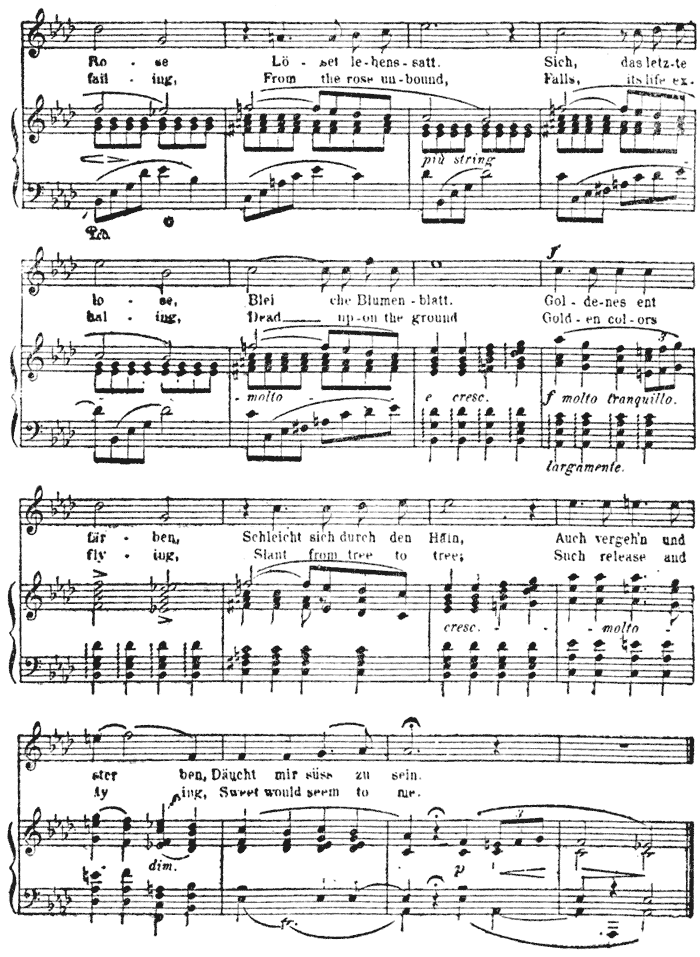
Copyright, 1889, by G. Schirmer, Jr.
... Rose
Löset lebenssatt.
Sich, das letzte lose,
Bleiche Blumenblatt.
Goldenes entfärben,
Schleicht sich durch den Hain,
Auch vergeh'n und sterben,
Däucht mir süss zu sein.
|
... failing,
From the rose unbound,
Falls, its life exhaling,
Dead upon the ground.
Golden colors flying,
Slant from tree to tree;
Such release and dying,
Sweet would seem to me.
|
A FRAGMENT FROM "HERBSTGEFÜHL."
Nevin's songs, whose only littleness is in
their length, though treated with notable
individuality, are founded in principle on the
Lieder of Schumann and Franz. That is to
say, they are written with a high poetical
feeling inspired by the verses they sing, and,
while melodious enough to justify them as
lyrics, yet are near enough to impassioned
recitative to do justice to the words on which
they are built. Nevin is also an enthusi103astic
devotee of the position these masters,
after Schubert, took on the question of the
accompaniment. This is no longer a slavish
thumping of a few chords, now and then, to
keep the voice on the key, with outbursts
of real expression only at the interludes; but
it is a free instrumental composition with a
meaning of its own and an integral value,
truly accompanying, not merely supporting
and serving, the voice. Indeed, one of
Nevin's best songs,—"Lehn deine Wang an
meine Wang,"—is actually little more than
a vocal accompaniment to a piano solo. His
accompaniments are always richly colored
and generally individualized with a strong
contramelody, a descending chromatic scale
in octaves making an especially frequent
appearance. Design, though not classical,
is always present and distinct.
Nevin's first published work was a modest
"Serenade," with a neat touch of syncopation,
which he wrote at the age of eighteen. 104
His "Sketch-Book," a collection of thirteen
songs and piano pieces found an immediate
and remarkable sale that has removed the
ban formerly existing over books of native
compositions.
The contents of the "Sketch-Book" display
unusual versatility. It opens with a
bright gavotte, in which adherence to the
classic spirit compels a certain reminiscence
of tone. The second piece, a song, "I' the
Wondrous Month o' May," has such a springtide
fire and frenzy in the turbulent accompaniment,
and such a fervent reiterance, that
it becomes, in my opinion, the best of all the
settings of this poem of Heine's, not excluding
even Schumann's or that of Franz. The
"Love Song," though a piano solo, is in
reality a duet between two lovers. It is to
me finer than Henselt's perfect "Liebeslied,"
possibly because the ravishing sweetness of
the woman's voice answering the sombre plea
of the man gives it a double claim on the 105
heart. The setting of "Du bist wie eine
Blume," however, hardly does justice either
to Heine's poem, or to Nevin's art. The
"Serenade" is an original bit of work, but
the song, "Oh, that We Two were Maying!"
with a voice in the accompaniment making it
the duet it should be,—that song can have
no higher praise than this, that it is the complete,
the final musical fulfilment of one of
the rarest lyrics in our language. A striking
contrast to the keen white regret of this
song is the setting of a group of "Children's
Songs," by Robert Louis Stevenson.
Nevin's child-songs have a peculiar and
charming place. He has not been stingy
of either his abundant art or his abundant
humanity in writing them. They include
four of Stevenson's, the best being the captivating
"In Winter I get up at Night," and a
setting of Eugene Field's "Little Boy Blue,"
in which a trumpet figure is used with delicate
pathos.106
Nevin's third opus included three exquisite
songs of a pastoral nature, Goethe's rollicking
"One Spring Morning" having an immense
sale. Opus 5 contained five songs, of which
the ecstatic "'Twas April" reached the
largest popularity. Possibly the smallest
sale was enjoyed by "Herbstgefühl." Many
years have not availed to shake my allegiance
to this song, as one of the noblest songs in the
world's music. It is to me, in all soberness, as
great as the greatest of the Lieder of Schubert,
Schumann or Franz. In "Herbstgefühl"
(or "Autumn-mood") Gerok's superb
poem bewails the death of the leaves and
the failing of the year, and cries out in
sympathy:
"Such release and dying
Sweet would seem to me!"
Deeper passion and wilder despair could
not be crowded into so short a song, and the
whole brief tragedy is wrought with a gran107deur
and climax positively epic. It is a flash
of sheer genius.
Three piano duets make up opus 6; and
other charming works, songs, piano pieces,
and violin solos, kept pouring from a pen
whose apparent ease concealed a vast deal of
studious labor, until the lucky 13, the opus-number
of a bundle of "Water Scenes,"
brought Nevin the greatest popularity of all,
thanks largely to "Narcissus," which has
been as much thrummed and whistled as any
topical song.
Of the other "Water Scenes," there is
a shimmering "Dragon Fly," a monody,
"Ophelia," with a pedal-point of two periods
on the tonic, and a fluent "Barcarolle" with
a deal of high-colored virtuosity.
His book "In Arcady" (1892) contains
pastoral scenes, notably an infectious romp
that deserves its legend, "They danced as
though they never would grow old." The
next year his opus 20, "A Book of Songs," 108
was published. It contains, among other
things of merit, a lullaby, called "Sleep, Little
Tulip," with a remarkably artistic and effective
pedal-point on two notes (the submediant
and the dominant) sustained through the
entire song with a fine fidelity to the words
and the lullaby spirit; a "Nocturne" in which
Nevin has revealed an unsuspected voluptuousness
in Mr. Aldrich' little lyric, and has
written a song of irresistible climaxes. The
two songs, "Dîtes-Moi" and "In der Nacht,"
each so completely true to the idiom of the
language of its poem, are typical of Nevin's
cosmopolitanism, referred to before. This
same unusual ability is seen in his piano
pieces as well as in his songs. He knows
the difference between a chanson and a Lied,
and in "Rechte Zeit" has written with truth
to German soldierliness as he has been sympathetic
with French nuance in "Le Vase
Brisé," the effective song "Mon Desire,"
which in profile suggests Saint-Saëns' familiar 109
Delilah-song, the striking "Chanson des
Lavandières" and "Rapelle-Toi," one of
Nevin's most elaborate works, in which Alfred
De Musset's verse is splendidly set with much
enharmonious color. Very Italian, too, is
the "Serenade" with accompaniment à la
mandolin, which is the most fetching number
in the suite "Captive Memories," published
in 1899.
Nevin has also put many an English song
to music, notably the deeply sincere "At
Twilight," the strenuous lilt "In a Bower,"
Bourdillon's beautiful lyric, "Before the Daybreak,"
the smooth and unhackneyed treatment
of the difficult stanza of "'Twas April,"
that popular song, "One Spring Morning,"
which has not yet had all the charm sung out
of it, and two songs with obbligati for violin
and 'cello, "Deep in the Rose's Glowing
Heart" and "Doris," a song with a finely
studied accompaniment and an aroma of
Theokritos.110
A suite for the piano is "En Passant,"
published in 1899; it ranges from a stately
old dance, "At Fontainebleau," to "Napoli,"
a furious tarantelle with effective glissandi;
"In Dreamland" is a most delicious revery
with an odd repetition that is not preludatory,
but thematic. The suite ends with the most
poetic scene of all, "At Home," which makes
a tone poem of Richard Hovey's word-picture
of a June night in Washington. The depicting
of the Southern moonlight-balm, with
its interlude of a distant and drowsy
negro quartette, reminds one pleasantly of
Chopin's Nocturne (op. 37, No. 1), with its
intermezzo of choric monks, though the
composition is Nevin's very own in spirit
and treatment.
In addition to the works catalogued, Nevin
has written a pantomime for piano and
orchestra to the libretto of that virtuoso
in English, Vance Thompson; it was called
"Lady Floriane's Dream," and was given in 111
New York in 1898. Nevin has also a cantata
in making.
It needs no very intimate acquaintance
with Nevin's music to see that it is not based
on an adoration for counterpoint as an end.
He believes that true music must come from
the emotions—the intelligent emotions—and
that when it cannot appeal to the emotions
it has lost its power. He says: "Above
everything we need melody—melody and
rhythm. Rhythm is the great thing. We
have it in Nature. The trees sway, and our
steps keep time, and our very souls respond."
In Wagner's "Meistersinger," which he calls
"a symphonic poem with action," Nevin finds
his musical creed and his model.
And now, if authority is needed for all this
frankly enthusiastic admiration, let it be found
in and echoed from Karl Klindworth, who
said of Nevin: "His talent is ungeheures [one
of the strongest adjectives in the German
language]. If he works hard and is conscien112tious,
he can say for the musical world something
that no one else can say."
John Philip Sousa.
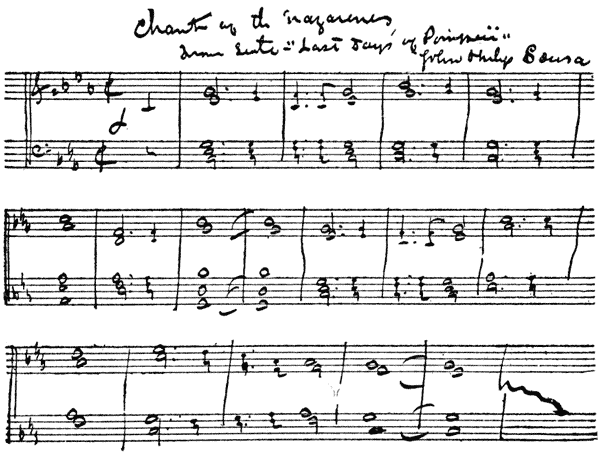
In common with most of those that pretend
to love serious music, a certain person was
for long guilty of the pitiful snobbery of
rating march-tunes as the lowest form of the
art. But one day he joined a National Guard
regiment, and his first long march was that 113
heart-breaking dress-parade of about fifteen
miles through the wind and dust of the day
Grant's monument was dedicated. Most of
the music played by the band was merely
rhythmical embroidery, chiefly in bugle figures,
as helpful as a Clementi sonatina; but
now and then there would break forth a
magic elixir of tune that fairly plucked his
feet up for him, put marrow in unwilling
bones, and replaced the dreary doggedness of
the heart with a great zest for progress, a
stout martial fire, and a fierce esprit de corps;
with patriotism indeed. In almost every
case, that march belonged to one John Philip
Sousa.
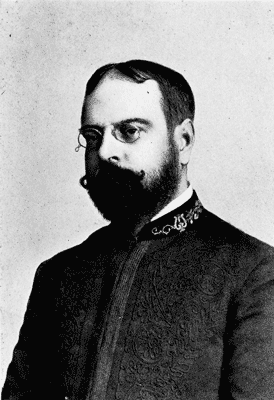
JOHN PHILIP SOUSA.
It came upon this wretch then, that, if it
is a worthy ambition in a composer to give
voice to passionate love-ditties, or vague contemplation,
or the deep despair of a funeral
cortège, it is also a very great thing to instil
courage, and furnish an inspiration that will
send men gladly, proudly, and gloriously 114
through hardships into battle and death.
This last has been the office of the march-tune,
and it is as susceptible of structural
logic or embellishments as the fugue, rondo,
or what not. These architectural qualities
Sousa's marches have in high degree, as any
one will find that examines their scores or
listens analytically. They have the further
merit of distinct individuality, and the supreme
merit of founding a school.
It is only the plain truth to say that
Sousa's marches have founded a school; that
he has indeed revolutionized march-music.
His career resembles that of Johann Strauss
in many ways. A certain body of old fogies
has always presumed to deride the rapturous
waltzes of Strauss, though they have won
enthusiastic praise from even the esoteric
Brahms, and gained from Wagner such words
as these: "One Strauss waltz overshadows,
in respect to animation, finesse, and real musical
worth, most of the mechanical, bor115rowed,
factory-made products of the present
time." The same words might be applied to
Sousa's marches with equal justice. They
have served also for dance music, and the
two-step, borne into vogue by Sousa's music,
has driven the waltz almost into desuetude.
There is probably no composer in the
world with a popularity equal to that of
Sousa. Though he sold his "Washington
Post" march outright for $35, his "Liberty
Bell" march is said to have brought him
$35,000. It is found that his music has
been sold to eighteen thousand bands in the
United States alone. The amazing thing is
to learn that there are so many bands in the
country. Sousa's marches have appeared on
programs in all parts of the civilized world.
At the Queen's Jubilee, when the Queen
stepped forward to begin the grand review
of the troops, the combined bands of the
household brigade struck up the "Washington
Post." On other important occasions it 116
appeared constantly as the chief march of
the week. General Miles heard the marches
played in Turkey by the military bands in
the reviews.
The reason for this overwhelming appeal
to the hearts of a planet is not far to seek.
The music is conceived in a spirit of high
martial zest. It is proud and gay and fierce,
thrilled and thrilling with triumph. Like all
great music it is made up of simple elements,
woven together by a strong personality. It
is not difficult now to write something that
sounds more or less like a Sousa march, any
more than it is difficult to write parodies,
serious or otherwise, on Beethoven, Mozart,
or Chopin. The glory of Sousa is that he
was the first to write in this style; that
he has made himself a style; that he has so
stirred the musical world that countless imitations
have sprung up after him.
The individuality of the Sousa march is
this, that, unlike most of the other influential 117
marches, it is not so much a musical exhortation
from without, as a distillation of the essences
of soldiering from within. Sousa's
marches are not based upon music-room
enthusiasms, but on his own wide experiences
of the feelings of men who march together in
the open field.
And so his band music expresses all the
nuances of the military psychology: the exhilaration
of the long unisonal stride, the
grip on the musket, the pride in the regimentals
and the regiment,—esprit de corps. He
expresses the inevitable foppery of the severest
soldier, the tease and the taunt of the
evolutions, the fierce wish that all this ploying
and deploying were in the face of an
actual enemy, the mania to reek upon a tangible
foe all the joyous energy, the blood-thirst
of the warrior.
These things Sousa embodies in his music
as no other music writer ever has. To approach
Sousa's work in the right mood, the 118
music critic must leave his stuffy concert hall
and his sober black; he must flee from the
press, don a uniform, and march. After his
legs and spirits have grown aweary under the
metronomic tunes of others, let him note the
surge of blood in his heart and the rejuvenation
of all his muscles when the brasses flare
into a barbaric Sousa march. No man that
marches can ever feel anything but gratitude
and homage for Sousa.
Of course he is a trickster at times; admitted
that he stoops to conquer at times,
yet in his field he is supreme. He is worthy
of serious consideration, because his thematic
material is almost always novel and forceful,
and his instrumentation full of contrast and
climax. He is not to be judged by the piano
versions of his works, because they are abominably
thin and inadequate, and they are not
klaviermässig. There should be a Liszt or
a Taussig to transcribe him.
When all's said and done, Sousa is the 119
pulse of the nation, and in war of more
inspiration and power to our armies than ten
colonels with ten braw regiments behind them.
Like Strauss', Mr. Sousa's father was a
musician who forbade his son to devote himself
to dance music. As Strauss' mother
enabled him secretly to work out his own
salvation, so did Sousa's mother help him.
Sousa's father was a political exile from
Spain, and earned a precarious livelihood
by playing a trombone in the very band
at Washington which later became his son's
stepping-stone to fame. Sousa was born at
Washington in 1859. His mother is German,
and Sousa's music shows the effect
of Spanish yeast in sturdy German rye bread.
Sousa's teachers were John Esputa and
George Felix Benkert. The latter Mr. Sousa
considers one of the most complete musicians
this country has ever known. He put him
through such a thorough theoretical training,
that at fifteen Sousa was teaching har120mony. At eight he had begun to earn his
own living as a violin player at a dancing-school,
and at ten he was a public soloist.
At sixteen he was the conductor of an orchestra
in a variety theatre. Two years later he
was musical director of a travelling company
in Mr. Milton Nobles' well-known play, "The
Phœnix," for which he composed the incidental
music. Among other incidents in a
career of growing importance was a position
in the orchestra with which Offenbach toured
this country. At the age of twenty-six, after
having played, with face blacked, as a negro
minstrel, after travelling with the late Matt
Morgan's Living Picture Company, and working
his way through and above other such
experiences in the struggle for life, Sousa
became the leader of the United States
Marine Band. In the twelve years of his
leadership he developed this unimportant
organization into one of the best military
bands in the world.121
In 1892 his leadership had given him such
fame that he withdrew from the government
service to take the leadership of the band
carrying his own name.
A work of enormous industry was his collection
and arrangement, by governmental
order, of the national and typical tunes of all
nations into one volume, an invaluable book
of reference.
Out of the more than two hundred published
compositions by Sousa, it is not possible
to mention many here. Though some of
the names are not happily chosen, they call
up many episodes of parade gaiety and jauntiness,
or warlike fire. The "Liberty Bell,"
"Directorate," "High School Cadets," "King
Cotton," "Manhattan Beach," "'Sound Off!'"
"Washington Post," "Picador," and others,
are all stirring works; his best, I think, is a
deeply patriotic march, "The Stars and Stripes
Forever." The second part of this has some
brass work of particular originality and vim.122
In manuscript are a few works of larger
form: a symphonic poem, "The Chariot
Race," an historical scene, "Sheridan's Ride,"
and two suites, "Three Quotations" and "The
Last Days of Pompeii."
The "Three Quotations" are:
(a) "The King of France, with twenty thousand men,
Marched up a hill and then marched down again,"
which is the motive for a delightful scherzo-march
of much humor in instrumentation;
(b) "And I, too, was born in Arcadia,"
which is a pastorale with delicious touches of
extreme delicacy;
which has a stunning beginning and is a stirring
grotesque in the negro manner Dvôrák
advised Americans to cultivate. All three
are well arranged for the piano.
The second suite is based on "The Last 123
Days of Pompeii." It opens with a drunken
revel, "In the House of Burbo and Stratonice;"
the bulky brutishness of the gladiators
clamoring for wine, a jolly drinking-song,
and a dance by a jingling clown make up a
superbly written number. The second movement
is named "Nydia," and represents the
pathetic reveries of the blind girl; it is tender
and quiet throughout.
The third movement is at once daring and
masterly. It boldly attacks "The Destruction,"
and attains real heights of graphic suggestion.
A long, almost inaudible roll on
the drums, with occasional thuds, heralds the
coming of the earthquake; subterranean
rumblings, sharp rushes of tremor, toppling
stones, and wild panic are insinuated vividly,
with no cheap attempts at actual imitation.
The roaring of the terrified lion is heard, and,
best touch of all, under the fury of the scene
persists the calm chant of the Nazarenes,
written in one of the ancient modes. The 124
rout gives way to the sea-voyage of Glaucus
and Ione, and Nydia's swan-song dies away
in the gentle splash of ripples. The work is
altogether one of superb imagination and
scholarly achievement.
Sousa, appealing as he does to an audience
chiefly of the popular sort, makes frequent
use of devices shocking to the conventional.
But even in this he is impelled by the enthusiasm
of an experimenter and a developer.
Almost every unconventional novelty is hooted
at in the arts. But the sensationalism of
to-day is the conservatism of to-morrow, and
the chief difference between a touch of high
art and a trick is that the former succeeds
and the latter does not. Both are likely to
have a common origin.
The good thing is that Sousa is actuated
by the spirit of progress and experiment, and
has carried on the development of the military
band begun by the late Patrick S. Gilmore.
Sousa's concert programs devote what 125
is in fact the greater part of their space to
music by the very best composers. These,
of course, lose something in being translated
over to the military band, but their effect in
raising the popular standard of musical culture
cannot but be immense. Through such instrumentality
much of Wagner is as truly
popular as any music played. The active
agents of such a result should receive the
heartiest support from every one sincerely
interested in turning the people toward the
best things in music. Incidentally, it is well
to admit that while a cheap march-tune is
almost as trashy as an uninspired symphony,
a good march-tune is one of the best things
in the best music.
Though chiefly known as a writer of
marches, in which he has won glory enough
for the average human ambition, Sousa has
also taken a large place in American comic
opera. His first piece, "The Smugglers,"
was produced in 1879, and scored the usual 126
failure of a first work. His "Katherine"
was never produced, his "Desirée" was
brought out in 1884 by the McCaull Opera
Company, and his "Queen of Hearts," a one-act
piece, was given two years later. He
forsook opera then for ten years; but in 1896
De Wolf Hopper produced his "El Capitan"
with great success.
The chief tune of the piece was a march
used with Meyerbeerian effectiveness to bring
down the curtain. The stout verve of this
"El Capitan" march gave it a large vogue
outside the opera. Hopper next produced
"The Charlatan," a work bordering upon
opéra comique in its first version. Both of
these works scored even larger success in
London than at home.
[Listen]
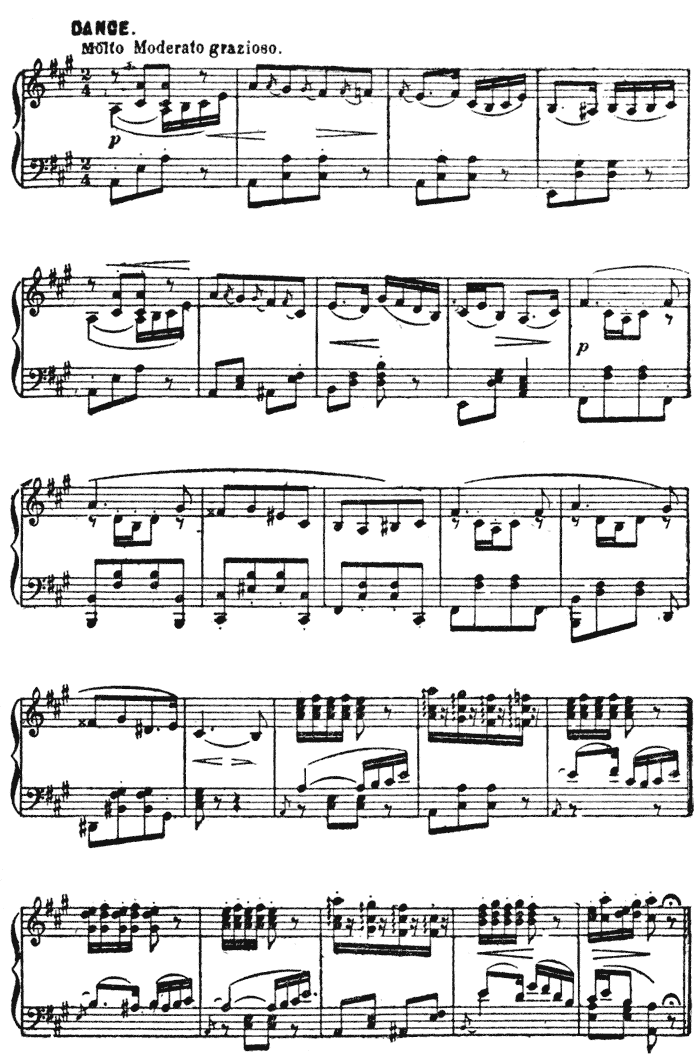
Used by permission of the John Church Company, owners of the
copyright.
A PAGE FROM "EL CAPITAN," BY JOHN PHILIP SOUSA.
In "The Bride Elect," Sousa wrote his
own libretto, and while there was the usual
stirring march as the pièce de resistance, the
work as a whole was less clangorous of the
cymbal than the operas of many a tamer com128poser.
In "Chris and the Wonderful Lamp,"
an extravaganza, the chief ensemble was
worked up from a previous march, "Hands
Across the Sea."
But Sousa can write other things than
marches, and his scoring is full of variety,
freedom, and contrapuntal brilliance.
Henry Schoenefeld.
Long before Dvôrák discovered America,
we aboriginals had been trying to invent a
national musical dialect which should identify
us as completely to the foreigner as our nasal
intonation and our fondness for the correct
and venerable use of the word "guess." But
Dvôrák is to credit for taking the problem
off the shelf, and persuading our composers
to think. I cannot coax myself into the
enthusiasm some have felt for Dvôrák's own
explorations in darkest Africa. His quartette
(op. 96) and his "New World" symphony are 129
about as full of accent and infidelity as Mlle.
Yvette Guilbert's picturesque efforts to sing
in English. But almost anything is better
than the phlegm that says, "The old ways are
good enough for all time;" and the Bohemian
missionary must always hold a place in the
chronicle of American music.
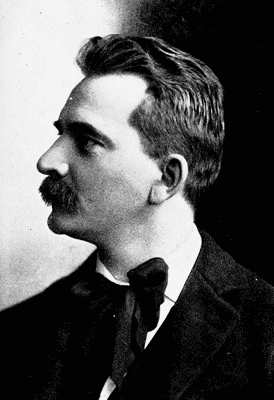
HENRY SCHOENEFELD.
A disciple of Dvôrák's, both in advance and
in retrospect, is Henry Schoenefeld, who
wrote a characteristic suite (op. 15) before the
Dvôrákian invasion, and an overture, "In the
Sunny South," afterward. The suite, which
has been played frequently abroad, winning
the praises of Hanslick, Nicodé, and Rubinstein,
is scored for string orchestra. It opens
with an overly reminiscent waltz-tune, and
ends conventionally, but it contains a movement
in negro-tone that gives it importance.
In this the strings are abetted by a tambourine,
a triangle, and a gong. It is in march-time,
and, after a staccato prelude, begins
with a catchy air taken by the second violins, 130
while the firsts, divided, fill up the chords.
A slower theme follows in the tonic major;
it is a jollificational air, dancing from the first
violins with a bright use of harmonics. Two
periods of loud chorale appear with the gong
clanging (to hint a church-bell, perhaps). The
first two themes return and end the picture.
The overture (op. 22) has won the high
esteem of A.J. Goodrich, and it seems to
me to be one of the most important of native
works, not because of its nigrescence, but
because of its spontaneity therein. It adds
to the usual instruments only the piccolo,
the English horn, the tambourine, and triangle
and cymbals. The slow introduction
gives forth an original theme in the most
approved and most fetching darky pattern.
The strings announce it, and the wood replies.
The flutes and clarinets toss it in a
blanket furnished by an interesting passage
in the 'cellos and contrabasses. There is a
choral moment from the English horn, the 131
bassoons, and a clarinet. This solemn thought
keeps recurring parenthetically through the
general gaiety. The first subject clatters in,
the second is even more jubilant. In the
development a dance misterioso is used with
faithful screaming repetitions, and the work
ends regularly and brilliantly. There is much
syncopation, though nothing that is strictly
in "rag-time;" banjo-figurations are freely
and ingeniously employed, and the whole is
a splendid fiction in local color. Schoenefeld's
negroes do not speak Bohemian.
His determined nationalism is responsible
for his festival overture, "The American
Flag," based on his own setting of Rodman
Drake's familiar poem. The work opens
with the hymn blaring loudly from the antiphonal
brass and wood. The subjects are
taken from it with much thematic skill, and
handled artfully, but the hymn, which appears
in full force for coda, is as trite as the
most of its kith.132
Schoenefeld was born in Milwaukee, in
1857. His father was a musician, and his
teacher for some years. At the age of seventeen
Schoenefeld went to Leipzig, where he
spent three years, studying under Reinecke,
Coccius, Papperitz, and Grill. A large choral
and orchestral work was awarded a prize over
many competitors, and performed at the
Gewandhaus concerts, the composer conducting.
Thereafter he went to Weimar, where
he studied under Edward Lassen.
In 1879 he came back to America, and
took up his residence in Chicago, where he
has since lived as a teacher, orchestra leader,
and composer. He has for many years
directed the Germania Männerchor.
Schoenefeld's "Rural Symphony" was
awarded the $500 prize offered by the
National Conservatory. Dvôrák was the
chairman of the Committee on Award, and
gave Schoenefeld hearty compliments. Later
works are: "Die drei Indianer," an ode for 133
male chorus, solo, and orchestra; a most
beautiful "Air" for orchestra (the air being
taken by most of the strings,—the first violins
haunting the G string,—while a harp
and three flutes carry the burden of the accompaniment
gracefully); a pleasant "Reverie"
for string orchestra, harp, and organ;
and two impromptus for string orchestra, a
"Meditation" representing Cordelia brooding
tenderly over the slumbering King Lear,—art
ministering very tenderly to the mood,—and
a cleverly woven "Valse Noble."
Only a few of Schoenefeld's works are published,
all of them piano pieces. It is no slur
upon his orchestral glory to say that these
are for the most part unimportant, except
the excellent "Impromptu" and "Prelude."
Of the eight numbers in "The Festival," for
children, only the "Mazurka" is likely to
make even the smallest child think. The
"Kleine Tanz Suite" is better. The six
children's pieces of opus 41, "Mysteries of 134
the Wood," make considerable appeal to the
fancy and imagination, and are highly interesting.
They show Grieg's influence very
plainly, and are quite worth recommending.
This cannot be said of his most inelegant
"Valse Élégante," or of his numerous dances,
except, perhaps, his "Valse Caprice."
He won in July, 1899, the prize offered to
American composers by Henri Marteau, for a
sonata for violin and piano. The jury was composed
of such men as Dubois, Pierné, Diemer,
and Pugno. The sonata is quasi fantasia, and
begins strongly with an evident intention to
make use of negro-tone. The first subject is
so vigorously declared that one is surprised
to find that it is elastic enough to express a
sweet pathos and a deep gloom. It is rather
fully developed before the second subject
enters; this, on the other hand, is hardly
insinuated in its relative major before the
rather inelaborate elaboration begins. In the
romanza, syncopation and imitation are much 135
relied on, though the general atmosphere
is that of a nocturne, a trio of dance-like
manner breaking in. The final rondo combines
a clog with a choral intermezzo. The
work is noteworthy for its deep sincerity and
great lyric beauty.
Maurice Arnold.
The plantation dances of Maurice Arnold
have an intrinsic interest quite aside from
their intrinsic value. Arnold, whose full
name is Maurice Arnold-Strothotte, was born
in St. Louis in 1865. His mother was a
prominent pianist and gave him his first lessons
in music. At the age of fifteen he
went to Cincinnati, studying at the College of
Music for three years. In 1883 he went to
Germany to study counterpoint and composition
with Vierling and Urban in Berlin. The
latter discouraged him when he attempted to
imbue a suite with a negro plantation spirit.136
Arnold now went upon a tramping tour in
Hungary, Bulgaria, and Turkey. Some of
his compositions show the influence of his
journey. He then entered the Cologne Conservatory,
studying under Wuellner, Neitzel,
and G. Jensen. His first piano sonata was
performed there at a public concert. He
next went to Breslau, where, under the instruction
of Max Bruch, he wrote his cantata,
"The Wild Chase," and gave public performance
to other orchestral work. Returning
now to St. Louis, he busied himself as solo
violinist and teacher, travelling also as a conductor
of opera companies. When Dvôrák
came here Arnold wrote his "Plantation
Dances," which were produced in a concert
under the auspices of the Bohemian composer.
Arnold was instructor of harmony at
the National Conservatory under Dvôrák.
The "Plantation Dances" are Arnold's
thirty-third opus, and they have been much
played by orchestras; they are also published 137
as a piano duet; the second dance also as a
solo. Arnold has not made direct use of
Ethiopian themes, but has sought the African
spirit. The first of the dances is very
nigresque; the second hardly at all, though
it is a delicious piece of music; the third
dance uses banjo figures and realizes darky
hilarity in fine style; the fourth is a cake
walk and hits off the droll humor of that
pompous ceremony fascinatingly.
Arnold's "Dramatic Overture" shows a fire
and rush very characteristic of him and
likely to be kept up without sufficient contrast.
So also does his cantata, "The Wild
Chase." Arnold has written two comic
operas. I have heard parts of the first and
noted moments of much beauty and humor.
The Aragonaise, which opens the third act,
is particularly delightful. The orchestration
throughout displays Arnold's characteristic
studiousness in picturesque effect.
For piano there is a czardas, and a "Valse 138
Élégante" for eight hands; it is more Viennese
than Chopinesque. It might indeed be
called a practicable waltz lavishly adorned.
The fruits of Arnold's Oriental journey are
seen in his impressionistic "Danse de la Midway
Plaisance;" a very clever reminiscence of
a Turkish minstrel; and a Turkish march,
which has been played by many German
orchestras. There is a "Caprice Espagnol,"
which is delightful, and a "Banjoënne," which
treats banjo music so captivatingly that
Arnold may be said to have invented a new
and fertile and musical form. Besides these
there are a fugue for eight hands, a "Minstrel
Serenade" for violin and piano, and six
duets for violin and viola.
There are also a few part songs and some
solos, among which mention should be made
of "Ein Märlein," in the old German style,
an exquisitely tender "Barcarolle," and a
setting of the poem, "I Think of Thee in
Silent Night," which makes use of a particu139larly
beautiful phrase for pre-, inter-, and
postlude. Arnold has also written some
ballet music, a tarantelle for string orchestra,
and is at work upon a symphony, and a
book, "Some Points in Modern Orchestration."
His violin sonata (now in MS.) shows
his original talent at its best. In the first
movement, the first subject is a snappy and
taking example of negro-tone, the second has
the perfume of moonlit magnolia in its lyricism.
(In the reprise this subject, which had
originally appeared in the dominant major,
recurs in the tonic major, the key of the sonata
being E minor.) The second movement
is also in the darky spirit, but full of melancholy.
For finale the composer has flown
to Ireland and written a bully jig full of dash
and spirit.
N. Clifford Page.
The influence of Japanese and Chinese art
upon our world of decoration has long been 140
realized. After considering the amount of
interest shown in the Celestial music by
American composers, one is tempted to
prophesy a decided influence in this line, and
a considerable spread of Japanese influence
in the world of music also. Japanese music
has a decorative effect that is sometimes
almost as captivating as in painting.
The city of San Francisco is the natural
gateway for any such impulse, and not a
little of it has already passed the custom
house. In this field Edgar S. Kelley's influence
is predominating, and it is not surprising
that he should pass the contagion on to
his pupil, Nathaniel Clifford Page, who was
born in San Francisco, October 26, 1866.
His ancestors were American for many years
prior to the Revolution. He composed operas
at the age of twelve, and has used many of
these immature ideas with advantage in the
later years. He began the serious study of
music at the age of sixteen, Kelley being his 141
principal teacher. His first opera, composed
and orchestrated before he became of age,
was entitled "The First Lieutenant." It
was produced in 1889 at the Tivoli Opera
House in San Francisco, where most of the
critics spoke highly of its instrumental and
Oriental color, some of the scenes being laid
in Morocco.
In instrumentation, which is considered
Page's forte, he has never had any instruction
further than his own reading and investigation.
He began to conduct in opera and
concert early in life, and has had much
experience. He has also been active as a
teacher in harmony and orchestration.
An important phase of Page's writing has
been incidental music for plays, his greatest
success having been achieved by the music
for the "Moonlight Blossom," a play based
upon Japanese life and produced in London
in 1898. The overture was written entirely
on actual Japanese themes, including the 142
national anthem of Japan. Page was three
weeks writing these twelve measures. He
had a Japanese fiddle arranged with a violin
finger-board, but thanks to the highly characteristic
stubbornness of orchestral players, he
was compelled to have this part played by a
mandolin. Two Japanese drums, a whistle
used by a Japanese shampooer, and a Japanese
guitar were somehow permitted to add their
accent. The national air is used in augmentation
later as the bass for a Japanese song
called "K Honen." The fidelity of the
music is proved by the fact that Sir Edwin
Arnold's Japanese wife recognized the various
airs and was carried away by the national
anthem.
Although the play was not a success, the
music was given a cordial reception, and
brought Page contracts for other work in
England, including a play of Indian life by
Mrs. Flora Annie Steel.
Previously to the writing of the "Moon143light
Blossom" music, Page had arranged the
incidental music for the same author's play,
"The Cat and the Cherub." Edgar S.
Kelley's "Aladdin" music was the source
from which most of the incidental music
was drawn; but Page added some things
of his own, among them being one of the
most effective and unexpected devices for
producing a sense of horror and dread I
have ever listened to: simply the sounding
at long intervals of two gruff single tones
in the extreme low register of the double
basses and bassoons. The grimness of this
effect is indescribable.
An unnamed Oriental opera, and an opera
called "Villiers," in which old English color
is employed (including a grotesque dance of
the clumsy Ironsides), show the cosmopolitan
restlessness of Page's muse. An appalling
scheme of self-amusement is seen in his
"Caprice," in which a theme of eight measures'
length is instrumented with almost every 144
contrapuntal device known, and with psychological
variety that runs through five movements,
scherzando, vigoroso, con sentimento,
religioso, and a marcia fantastico. The suite
called "Village Fête" is an experiment in
French local color. It contains five scenes:
The Peasants Going to Chapel; The Flower
Girls; The Vagabonds; The Tryst; The
Sabot Dance, and the Entrance of the
Mayor, which is a pompous march.
On the occasion of a performance of this,
Louis Arthur Russell wrote: "His orchestra
is surely French, and as modern as you
please. The idiom is Berlioz's rather than
Wagner's."
145
CHAPTER III.
THE ACADEMICS.
John Knowles Paine.
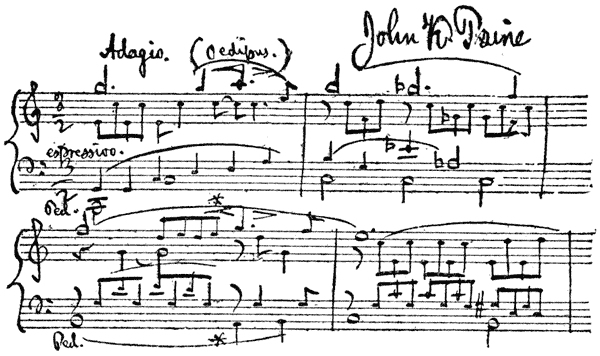
There is one thing better than modernity,—it
is immortality. So while I am a most
ardent devotee of modern movements, because
they are at worst experiments, and
motion is necessary to life, I fail to see why 146
it is necessary in picking up something new
always to drop something old, as if one were
an awkward, butter-fingered parcel-carrier.
If a composer writes empty stuff in the
latest styles, he is one degree better than
the purveyor of trite stuff in the old styles;
but he is nobody before the high thinker who
finds himself suited by the general methods
of the classic writers.
The most classic of our composers is their
venerable dean, John Knowles Paine. It is
an interesting proof of the youth of our native
school of music, that the principal symphony,
"Spring," of our first composer of importance,
was written only twenty-one years ago.
Before Mr. Paine there had never been an
American music writer worthy of serious
consideration in the larger forms.
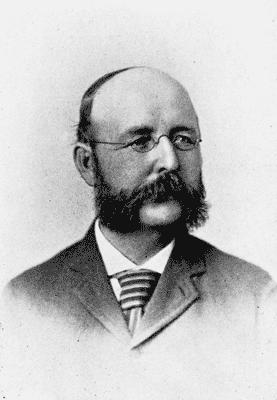
JOHN KNOWLES PAINE.
By a mere coincidence Joachim Raff had
written a symphony called "Spring" in
1878, just a year before Paine finished his
in America. The first movement in both is 147
called "Nature's Awakening;" such an idea
is inevitable in any spring composition, from
poetry up—or down. For a second movement
Raff has a wild "Walpurgis Night
Revel," while Paine has a scherzo called
"May Night Fantasy." Where Raff is
uncanny and fiendish, Paine is cheerful
and elfin. The third movement of Raff's
symphony is called "First Blossoms of
Spring," and the last is called "The Joys
of Wandering." The latter two movements
of Mr. Paine's symphony are "A Promise of
Spring" and "The Glory of Nature." The
beginning of both symphonies is, of course,
a slow introduction representing the torpid
gloom of winter, out of which spring aspires
and ascends.
Paine's symphony, though aiming to shape
the molten gold of April fervor in the rigid
mold of the symphonic form, has escaped
every appearance of mechanism and restraint.
It is program music of the most legiti148mate
sort, in full accord with Beethoven's
canon, "Mehr Ausdruck der Empfindung als
Malerei." It has no aim of imitating springtime
noises, but seeks to stimulate by suggestion
the hearer's creative imagination, and
provoke by a musical telepathy the emotions
that swayed the nympholept composer.
The first movement of the symphony has an introduction
containing two motives distinct from the two
subjects of the movement. These motives represent
Winter and the Awakening. The Winter motive
may be again divided into a chill and icy motif
and a rushing wind-motif. Through these the timid
Awakening spirit lifts its head like the first trillium
of the year. There is a silence and a stealthy flutter
of the violins as if a cloud of birds were playing
courier to the Spring.
Suddenly, after a little prelude, as if a bluebird
were tuning his throat, we are enveloped in the key
of the symphony (A major) and the Spring runs lilting
up the 'cellos to the violins (which are divided in
the naïf archaic interval of the tenth, too much ignored
in our over-colored harmonies). The second
subject is propounded by the oboes (in the rather
unusual related key of the submediant). This is a 149
lyrical and dancing idea, and it does battle with the
underground resistance of the Winter motives. There
is an elaborate conclusion of fiercest joy. Its ecstasy
droops, and after a little flutter as of little wings, the
elaboration opens with the Spring motive in the minor.
In this part, scholarship revels in its own luxury, the
birds quiver about our heads again, and the reprise
begins (in A major of course) with new exultance, the
dancing second subject appears (in the tonic), overwhelming
the failing strength of the Winter with a
cascade of delight. Then the conclusion rushes in;
this I consider one of the most joyous themes ever
inspired.
There is a coda of vanishing bird-wings and throats,
a pizzicato chord on the strings—and Spring has had
her coronation.
"The May Night Fantasy" is a moonlit revel of
elves caught by a musical reporter, a surreptitious
"chiel amang 'em takin' notes." A single hobgoblin
bassoon croaks ludicrously away, the pixies darkle
and flirt and dance their hearts out of them.
The Romance is in rondo form with love-lorn
iteration of themes and intermezzo, and deftest
broidery, the whole ending, after a graceful Recollection,
in a bliss of harmony.
The Finale is a halleluiah. It is on the sonata
formula, without introduction (the second subject
being not in the dominant of A major, but in C 150
major, that chaste, frank key which one of the popes
strangely dubbed "lascivious"). The elaboration is
frenetic with strife, but the reprise is a many-hued
rainbow after storm, and the coda in A major (ending
a symphony begun in A minor) is swift with delight.
This symphony has been played much, but
not half enough. It should resist the weariness
of time as immortally as Fletcher's play,
"The Two Noble Kinsmen" (in which Shakespeare's
hand is glorious), for it is, to quote
that drama, "fresher than May, sweeter
than her gold buttons on the bough, or all
th'enamell'd knacks o' the mead or garden."
John Knowles Paine is a name that has
been held in long and high honor among
American composers. He was about the
earliest of native writers to convince foreign
musicians that some good could come out of
Nazareth.
He was born in Portland, Me., January 9,
1839. He studied music first under a local
teacher, Kotzschmar, making his début as 151
organist at the age of eighteen. A year later
he was in Berlin, where for three years he
studied the organ, composition, instrumentation,
and singing under Haupt, Wieprecht, and
others. He gave several organ concerts in
Germany, and made a tour in 1865-1866.
In February, 1867, his "Mass" was given at
the Berlin Singakademie, Paine conducting.
Then he came back to the States, and in
1872 was appointed to an instructorship of
music at Harvard, whence he was promoted
in 1876 to a full professorship, a chair created
for him and occupied by him ever since with
distinguished success.
His first symphony was brought out by
Theodore Thomas in 1876. This and his
other orchestral works have been frequently
performed at various places in this country
and abroad.
His only oratorio, "St. Peter," was first
produced at Portland in 1873, and in Boston
a year later. It is a work of great power and 152
much dramatic strength. Upton, in his
valuable work, "Standard Oratorios," calls
it "from the highest standpoint the only
oratorio yet produced in this country."
This oratorio, while containing much of
the floridity and repetition of Händel at his
worst, is also marked with the erudition and
largeness of Händel at his best. The aria
for St. Peter, "O God, My God, Forsake Me
Not," is especially fine.
A much-played symphonic poem is Paine's
"The Tempest," which develops musically
the chief episodes of Shakespeare's play.
He has also written a valuable overture to
"As You Like It;" he has set Keats' "Realm
of Fancy" exquisitely, and Milton's "Nativity."
And he has written a grand opera
on a mediæval theme to his own libretto.
This is a three-act work called "Azara;"
the libretto has been published by the Riverside
Press, and is to be translated into German.
This has not yet been performed. Being, 153
unfortunately, an American grand opera, it
takes very little acuteness of foresight to
predict a long wait before it is ever heard.
In it Paine has shown himself more a romanticist
than a classicist, and the work is said
to be full of modernity.
Paine wrote the music for Whittier's
"Hymn," used to open the Centennial Exposition
at Philadelphia, and was fitly chosen
to write the Columbus March and Hymn for
the opening ceremonies of the World's Fair,
at Chicago, October 21, 1892. This was
given by several thousand performers under
the direction of Theodore Thomas.
A most original and interesting work is
the chorus, "Phœbus, Arise." It seems good
to hark back for words to old William Drummond
"of Hawthornden." The exquisite
flavor of long-since that marks the poetry is
conserved in the tune. While markedly
original, it smacks agreeably of the music of
Harry Lawes, that nightingale of the seven154teenth
century, whose fancies are too much
neglected nowadays.
Paine's strong point is his climaxes, which
are never timid, and are often positively
titanic, thrilling. The climax of this chorus
is notably superb, and the voices hold for two
measures after the orchestra finishes. The
power of this effect can be easily imagined.
This work is marked, to an unusual extent,
with a sensuousness of color.
The year eighteen hundred eighty-one saw
the first production of what is generally
considered Paine's most important composition,
and by some called the best
work by an American,—his setting of the
choruses of the "Œdipus Tyrannus" of
Sophokles. It was written for the presentation
by Harvard University, and has been
sung, in whole or in part, very frequently
since. This masterpiece of Grecian genius
is so mighty in conception and so mighty in
execution that it has not lost power at all in 155
the long centuries since it first thrilled the
Greeks. To realize its possibilities musically
is to give proof enough of the very highest
order of genius,—a genius akin to that of
Sophokles. It may be said that in general
Paine has completely fulfilled his opportunities.
Mendelssohn also set two Greek tragedies
to music, Sophokles' "Œdipus in Kolonos"
and his "Antigone." Mendelssohn is reported
to have made a first attempt at
writing Grecian music, or what we suppose
it to be, mainly a matter of unison and meagre
instrumentation. He was soon dissuaded
from such a step, however, and wisely. The
Greek tragedians, really writers of grand
opera, made undoubted use of the best
musical implements and knowledge they had.
Creative emotion has its prosperity in the
minds of its audience, not in the accuracy of
its mechanism. To secure the effect on us
that the Greek tragedians produced on con156temporary
audiences, it is necessary that our
music be a sublimation along the lines we are
accustomed to, as theirs was along lines
familiar to them and effective with them.
Otherwise, instead of being moved by the
miseries of Œdipus, we should be chiefly
occupied with amusement at the oddity of
the music, and soon bored unendurably by
its monotony and thinness.
Mendelssohn decided then to use unison
frequently for suggestion's sake, but not to
carry it to a fault. His experiments along
these lines have been of evident advantage to
Paine, who has, however, kept strictly to his
own individuality, and produced a work that,
at its highest, reaches a higher plane, in my
opinion, than anything in Mendelssohn's noble
tragedies,—and I am not, at that, one of
those that affect to look down upon the
achievements of the genius that built "Elijah."
Paine's prelude is an immense piece of 157
work, in every way larger and more elaborate
than that to Mendelssohn's "Antigone"
(the "Œdipus in Kolonos" begins strongly
with only one period of thirteen measures).
The opening chorus of Paine's "Œdipus" is
the weakest thing in the work. The second
strophe has a few good moments, but soon
falls back into what is impudent enough to
be actually catchy!—and that, too, of a
Lowell Mason, Moody and Sankey catchiness.
Curiously enough, Mendelssohn's
"Antigone" begins with a chorus more
like a drinking-song than anything else, and
the first solo is pure Volkslied; both of them
imbued with a Teutonic flavor that could be
cut with a knife. In Mendelssohn's "Œdipus
in Kolonos," however, the music expresses
emotion rather than German emotion, and
abounds in splendors of harmony that are
strikingly Wagnerian—in advance.
[Listen]
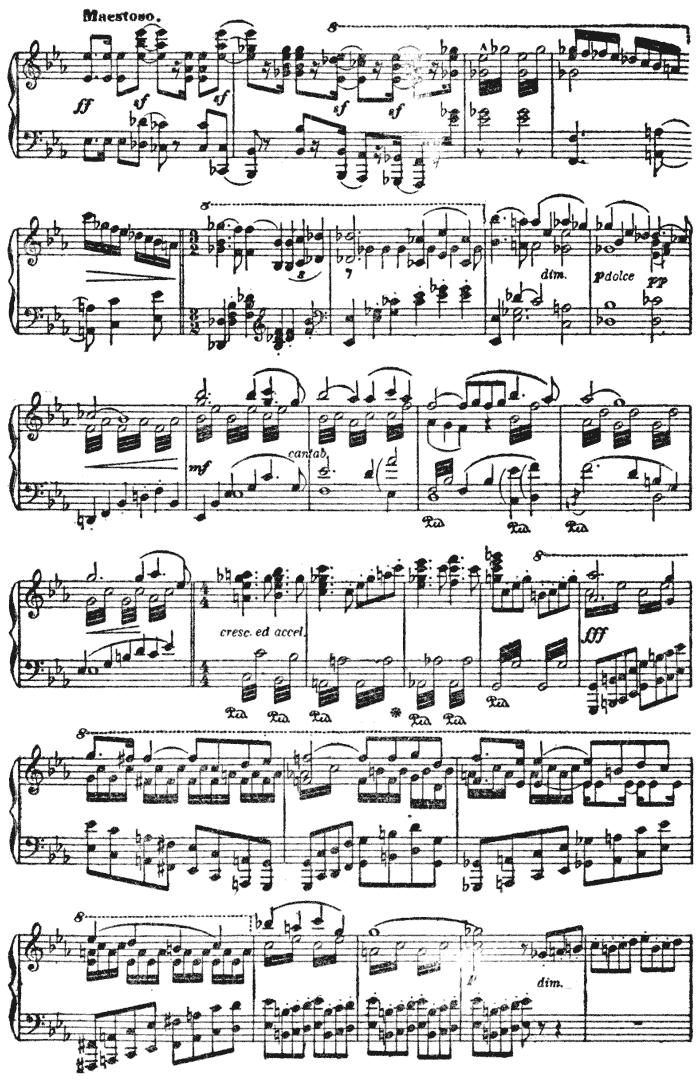
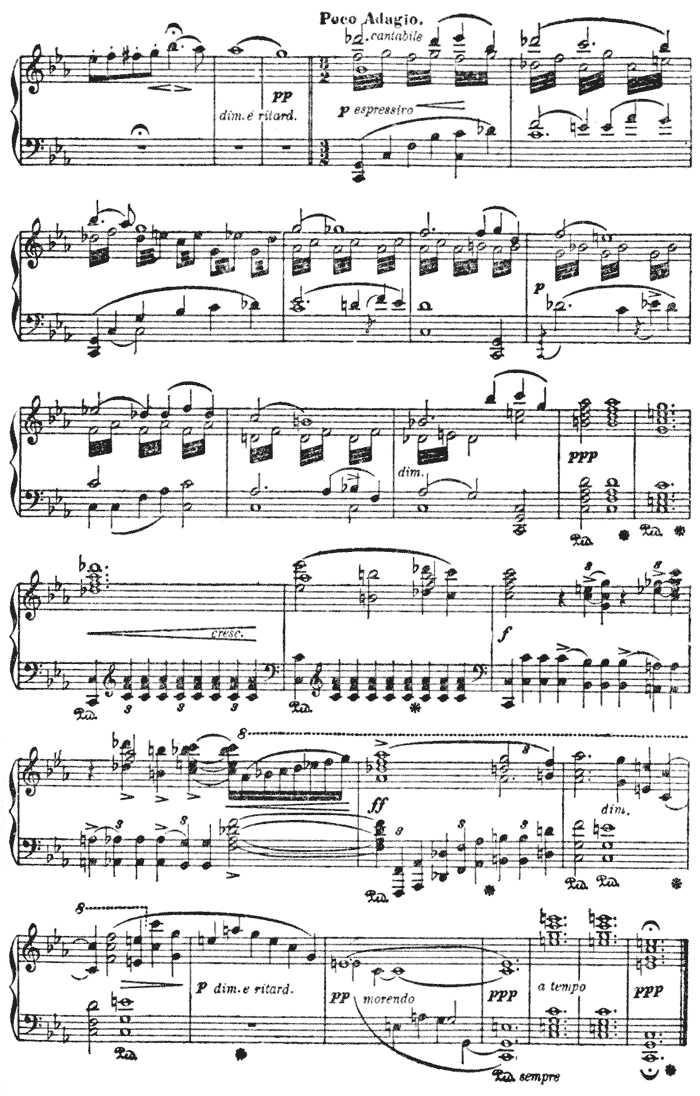
Copyright, 1895, by Arthur P. Schmidt.
POSTLUDE TO "ŒDIPUS TYRANNUS," BY J.K. PAINE.
Paine's second chorus describes the imaginary
pursuit by Fate of the murderer of160
King Laius. It is full of grim fire, and the
second strophe is at first simply terrible with
awe. Then it degenerates somewhat into an
arioso, almost Italian. The fourth chorus
defends the oracles from Jocasta's incredulity.
It is written almost in march measure, and is
full of robor.
At this point in the tragedy, where it begins
to transpire to Œdipus that he himself
was the unwitting murderer and the incestuous
wretch whose exile the oracle demands
before dispelling the plague,—here the divine
genius of Sophokles introduces a chorus of
general merriment, somewhat as Shakespeare
uses the maundering fool as a foil to heighten
King Lear's fate. No praise can be too high
for Paine's music here. Its choric structure
is masterly, its spirit is running fire. Note,
as an instance, the effect at the words "To
save our land thou didst rise as a tower!"
where the music itself is suddenly uplift with
most effective suggestion.161
The sixth chorus shows the effect of
Œdipus' divulged guilt and the misery of this
fool of Fate. The music is an outburst of
sheer genius. It is overpowering, frightening.
The postlude is orchestral, with the
chorus speaking above the music. Jocasta
has hanged herself, Œdipus has torn out his
own eyes with her brooch. The music is a
fitting reverie on the great play, and after a
wild tumult it subsides in a resigned quietude.
From Greek tragedy to Yankee patriotism
is a long cry, yet I think Paine has not wasted
his abilities on his "Song of Promise," written
for the Cincinnati May Festival of 1888.
Though the poem by Mr. George E. Woodberry
is the very apotheosis of American
brag, it has a redeeming technic. The music,
for soprano solo, mixed chorus, and orchestra,
reaches the very peaks of inspiration. I
doubt if any living composer or many dead
masters could grow so epic, as most of this.
In a way it is academic. It shows a little of 162
the influence of Wagner,—as any decent
music should nowadays. But it is not
Wagner's music, and it is not trite academia.
There is no finicky tinsel and no cheap
oddity.
Considering the heights at which both
words and music aimed, it is amazing that
they did not fall into utter wreck and nauseating
bathos. That they have proved so
effective shows the sure-footedness of genius.
It is all good, especially the soprano solo.
This music is exquisite, wondrously exquisite,
and it is followed by a maestoso e solenne
movement of unsurpassable majesty. I have
never read anything more purely what music
should be for grandeur. And it praises our
ain countree! It might well be taken up by
some of our countless vocal societies to give
a much needed respite to Händel's threadbare
"Messiah."
When one considers the largeness of the
works to which Paine has devoted himself 163
chiefly, he can be excused for the meagreness
and comparative unimportance of his smaller
works for piano and vocal solo. The only
song of his I care for particularly is "A Bird
upon a Rosy Bough" (op. 40), which is old-fashioned,
especially in accompaniment, yet
at times delicious. The song "Early Spring-time"
is most curiously original.
Of piano pieces there are a sprightly
"Birthday Impromptu" and a fuga giocosa,
which deals wittily with that theme known
generally by the words "Over the Fence Is
Out!" The "Nocturne" begins like Schumann,
falls into the style of his second Novellette,
thence to the largo of Beethoven's
Sonata (op. 10, No. 3), thence to Chopinism,
wherein it ends, an interesting assemblage
withal!
A long "Romance" for the piano is
marked by some excellent incidents and
much passion, but it lacks unity. It is the
last work in "An Album of Pianoforte 164
Pieces," which is otherwise full of rare delights.
It is made up of opera 25, 26, and 39.
Opus 25 contains four characteristic pieces,—a
"Dance" full of dance-rapture, a most
original "Impromptu," and a "Rondo Giocoso,"
which is just the kind of brilliantly
witty scherzo whose infrequency in American
music is so lamentable and so surprising.
Opus 26 includes ten sketches, all good, especially
"Woodnotes," a charming tone-poem,
the deliciously simple "Wayside Flowers,"
"Under the Lindens," which is a masterpiece
of beautiful syncopation, a refreshingly interesting
bit in the hackneyed "Millstream"
form, and a "Village Dance," which has
much of that quaint flavor that makes Heller's
études a perennial delight.
Besides these, there are a number of
motets, organ preludes, string quartettes, concert
pieces for violin, 'cello, piano, and the
like, all contributing to the furtherance of
an august fame.165
Dudley Buck.
Music follows the laws of supply and demand
just as the other necessities of life do.
But before a demand could exist for it in its
more austere and unadulterated forms, the
general taste for it must be improved. For
this purpose the offices of skilful compromisers
were required, composers who could at
the same time please the popular taste and
teach it discrimination. Among these invaluable
workers, a high place belongs, in point
both of priority and achievement, to Dudley
Buck. He has been a powerful agent, or
reagent, in converting the stagnant ferment
into a live and wholesome ebullition, or as
the old Greek evolutionists would say, starting
the first progress in the primeval ooze of
American Philistinism.
A more thoroughly New England ancestry
it would be hard to find. The founder of
the family came over from England soon 166
after the Mayflower landed. Buck was
named after Governor Dudley of the Plymouth
Colony. He was born at Hartford,
March 10, 1839. His father was a prosperous
shipping merchant, one of whose boats,
during the Civil War, towed the Monitor
from New York to Fortress Monroe on the
momentous voyage that destroyed the Merrimac's
usefulness.
Buck, though intended for commercial life,
borrowed a work on thorough-bass and a flute
and proceeded to try the wings of his muse.
A melodeon supplanted the flute, and when
he was sixteen he attained the glory of a
piano, a rare possession in those times.
(Would that it were rarer now!) He
took a few lessons and played a church-organ
for a salary,—a small thing, but his
own.
After reaching the junior year in Trinity
College, he prevailed upon his parents to surrender
him to music, an almost scandalous 167
career in the New England mind of that day,
still unbleached of its Blue Laws.
At the age of nineteen he went to Leipzig
and entered the Conservatory there, studying
composition under Hauptmann and E.F.
Richter, orchestration under Rietz, and the
piano under Moscheles and Plaidy. Later he
went to Dresden and studied the organ with
Schneider.
After three years in Germany, he studied
for a year in Paris, and came home, settling
down in Hartford as church-organist and
teacher. He began a series of organ-concert
tours lasting fifteen years. He played in
almost every important city and in many
small towns, popularizing the best music by
that happy fervor of interpretation which
alone is needed to bring classical compositions
home to the public heart. In 1869 he
was called to the "mother-church" of Chicago.
In the Chicago fire he lost many valuable
manuscripts, including a concert overture on 168
Drake's exquisite poem, "The Culprit Fay,"
which must be especially regretted. He
moved his family to Boston, assuming in ten
days the position of organist at St. Paul's;
and later he accepted charge of "the great
organ" at Music Hall,—that organ of which
Artemus Ward wrote so deliciously.
In 1875 Theodore Thomas, whose orchestra
had performed many of Buck's compositions,
invited him to become his assistant conductor
at the Cincinnati Music Festival and at the
last series of concerts at the Central Park
Garden in New York. Buck accepted and
made his home in Brooklyn, where he has
since remained as organist of the Holy Trinity
Church, and conductor of the Apollo Club,
which he founded and brought to a high state
of efficiency, writing for it many of his numerous
compositions for male voices.
Buck's close association with church work
has naturally led him chiefly into sacred
music, and in this class of composition he 169
is by many authorities accorded the very
highest place among American composers.
He has also written many organ solos, sonatas,
marches, a pastorale, a rondo caprice,
and many concert transcriptions, as well as a
group of études for pedal phrasing, and several
important treatises on various musical
topics. His two "Motett Collections" were
a refreshing relief and inspiration to church
choirs thirsty for religious Protestant music
of some depth and warmth.
In the cantata form Buck also holds a foremost
place. In 1876 he was honored with
a commission to set to music "The Centennial
Meditation of Columbia," a poem written
for the occasion by the Southern poet, Sidney
Lanier. This was performed at the opening
of the Philadelphia Exhibition by a chorus of
one thousand voices, an organ, and an orchestra
of two hundred pieces under the direction
of Theodore Thomas. In 1874 he made a
metrical version of "The Legend of Don 170
Munio" from Irving's "Alhambra," and set
it to music for a small orchestra and chorus.
Its adaptability to the resources of the vocal
societies of smaller cities has made it one of
his most popular works.
Another bit of Washington Irving is found
in Buck's cantata, "The Voyage of Columbus,"
the libretto for which he has taken
from Irving's "Life of Columbus." It consists
of six night-scenes,—"The Chapel of
St. George at Palos," "On the Deck of the
Santa Maria," "The Vesper Hymn," "Mutiny,"
"In Distant Andalusia," and "Land
and Thanksgiving." The opportunities here
for Buck's skilful handling of choruses and
his dramatic feeling in solos are obvious, and
the work has been frequently used both in
this country and in Germany with much success.
Buck, in fact, made the German libretto
as well as the English, and has written the
words for many of his compositions. His
largest work was "The Light of Asia," com171posed
in 1885 and based on Sir Edwin
Arnold's epic. It requires two and one-half
hours for performance and has met the usual
success of Buck's music; it was produced
in London with such soloists as Nordica,
Lloyd, and Santley. It has been occasionally
given here.
He has found the greater part of his texts
in American poetry, particularly in Lanier,
Stedman, and Longfellow, whose "King Olaf's
Christmas" and "Nun of Nidaros" he has
set to music, as well as his "Golden Legend,"
which won a prize of one thousand dollars at
the Cincinnati Festival in a large competition.
His work is analyzed very fully in A.J.
Goodrich' "Musical Analysis."
[Listen]
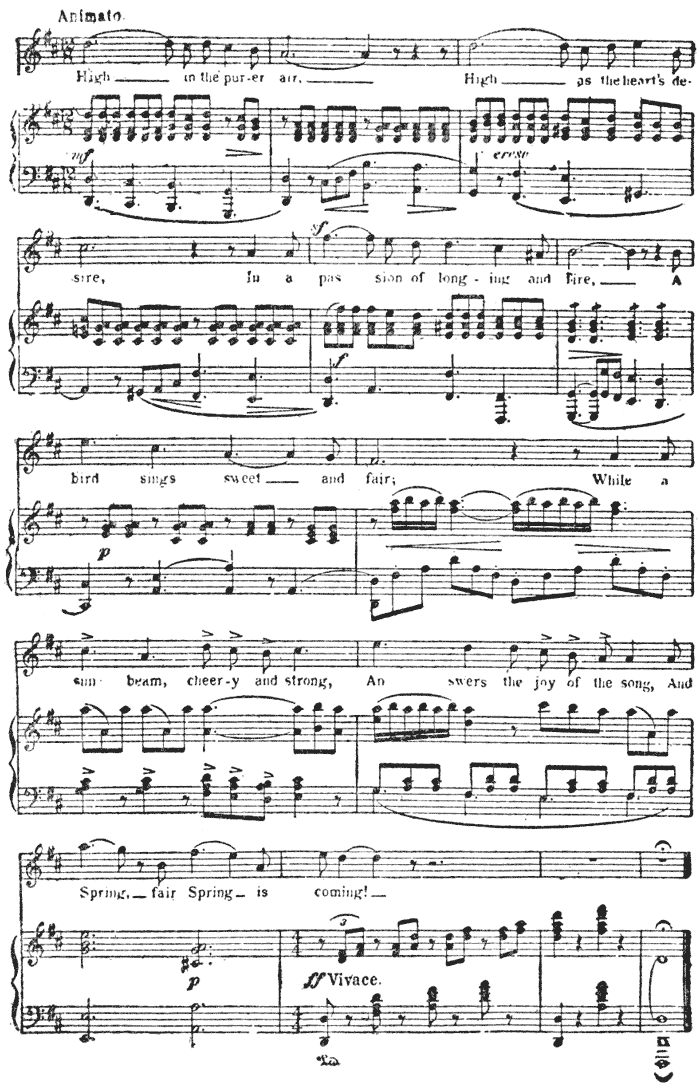
Copyright, 1893, by G. Schirmer.
High in the purer air,
High as the heart's desire,
In a passion of longing and fire,
A bird sings sweet and fair;
While a sunbeam, cheery and strong,
Answers the joy of the song,
And Spring, fair Spring is coming!
FRAGMENT FROM "SPRING'S AWAKENING," BY MR. BUCK.
Here, as in his symphonic overture to
Scott's "Marmion," Buck has adopted the
Wagnerian idea of the leit-motif as a vivid
means of distinguishing musically the various
characters and their varying emotions. His
music is not markedly Wagnerian, however,173
in other ways, but seems to show, back of
his individuality, an assimilation of the good
old school of canon and fugue, with an Italian
tendency to the declamatory and well-rounded
melodic period.
It might be wished that in his occasional
secular songs Buck had followed less in the
steps of the Italian aria and the English ballad
and adopted more of the newer, nobler
spirit of the Lied as Schumann and Franz
represent it, and as many of our younger
Americans have done with thorough success
and not a little of exaltation. Note for
instance the inadequacy of the old-style
balladry to both its own opportunity and
the otherwise-smothered fire of such a poem
as Sidney Lanier's "Sunset," which is positively
Shakespearean in its passionate perfection.
In religious music, however, Mr. Buck has
made a niche of its own for his music, which
it occupies with grace and dignity.174
Horatio W. Parker.
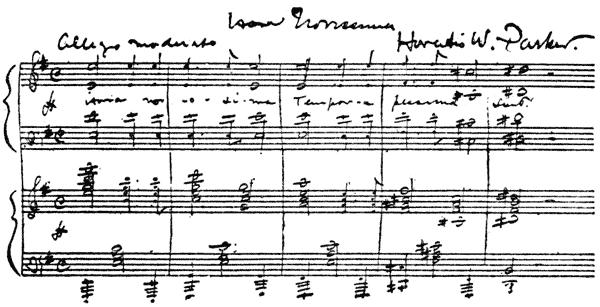
When one considers the enormous space
occupied by the hymn-tune in New England
musical activity, it is small wonder that most
of its composers should display hymnal proclivities.
Both Buck and Parker are natives
of New England.

HORATIO W. PARKER.
Parker was born, September 15, 1863, at
Auburndale, Mass. His mother was his
first teacher of music. She was an organist,
and gave him a thorough technical schooling
which won the highest commendation later
from Rheinberger, who entrusted to him the
first performance of a new organ concerto.
175
After some study in Boston under Stephen
A. Emery, John Orth, and G.W. Chadwick,
Parker went to Munich at the age of eighteen,
where he came under the special favor of
Rheinberger, and where various compositions
were performed by the Royal Music School
orchestra. After three years of Europe, he
returned to America and assumed the direction
of the music at St. Paul's school. He
has held various posts since, and has been,
since 1894, the Battell Professor of Music at
Yale.
His rather imposing list of works includes
a symphony (1885), an operetta, a concert
overture (1884), an overture, "Regulus"
(1885), performed in Munich and in London,
and an overture, "Count Robert of Paris"
(1890), performed in New York, a ballad for
chorus and orchestra, "King Trojan," presented
in Munich in 1885, the Twenty-third
Psalm for female chorus and orchestra (1884),
an "Idylle" (1891); "The Normans," "The 176
Kobolds," and "Harold Harfager," all for chorus and orchestra, and
all dated 1891; an oratorio, three or more cantatas, and various bits of
chamber-music. His opus number has already reached forty-three, and it
is eked out to a very small degree by such imponderous works as organ
and piano solos, hymns, and songs. In 1893, Parker won the National
Conservatory prize for a cantata, and in 1898 the McCagg prize for an a
cappella chorus.
Parker's piano compositions and secular songs are not numerous. They
seem rather the incidental byplays and recreations of a fanry chiefly
turned to sacred music of the larger forms.
Opus 19 consists of "Four Sketches," of which the "Étude Melodieuse" is
as good as is necessary in that overworked style, wherein a thin melody
is set about with a thinner ripple of arpeggios. The "Romanza" is lyric
and delightful, while the "Scherzino"177
is delicious and crisp as celery; it is worthy of Schumann, whom it suggests, and many of whose cool tones
and mannerisms it borrows.
The "5 Morceaux Charactéristiques" are on the whole better. The
"Scherzo" is shimmering with playfulness, and, in the Beethoven fashion,
has a tender intermezzo amoroso. This seriousness is enforced with an
ending of a most plaintive nature. The "Caprice" is brilliant and
whimsical, with some odd effects in accent. The "Gavotte" makes unusual
employment of triplets, but lacks the precious yeast of enthusiasm
necessary to a prime gavotte.
This enthusiasm is not lacking however from his "Impromptu," and it
makes his "Elégie" a masterly work, possibly his best in the smaller
lines. This piece is altogether elegiac in spirit, intense in its
sombrest depths, impatient with wild outcries,—like Chopin's "Funeral
March,"—and working 178
up to an immense passion at the end. This
subsides in ravishingly liquid arpeggios,—"melodious
tears"?—which obtain the kindred
effect of Chopin's tinkling "Berceuse"
in a slightly different way. This notable
work is marred by an interlude in which the
left hand mumbles harshness in the bass,
while the right hand is busy with airy fioriture.
It is too close a copy of the finish of
the first movement of Beethoven's "Moonlight"
sonata. The lengthening skips of the
left hand are also Beethovenesque trademarks.
Parker is rather old-fashioned in his forms
of musical speech. That is, he has what you
might call the narrative style. He follows
his theme as an absorbing plot, engaging
enough in itself, without gorgeous digressions
and pendent pictures. His work has something
of the Italian method. A melody or a
theme, he seems to think, is only marred by
abstruse harmony, and is endangered by 179
diversions. One might almost say that a
uniform lack of attention to color-possibilities
and a monotonous fidelity to a cool, gray
tone characterize him. His fondness for the
plain, cold octave is notable. It is emphasized
by the ill-success of his "Six Lyrics for
Piano, without octaves." They are all of
thin value, and the "Novelette" is dangerously
Schumannesque.
The "Three Love Songs" are happy,
"Love's Chase" keeping up the arch raillery
and whim of Beddoe's verse. "Orsame's
Song" is smooth and graceful, ending with a
well-blurted, abrupt "The devil take her!"
The "Night-piece to Julia" is notable. We
have no poet whose lyrics are harder to set
to music than good Robin Herrick's. They
have a lilt of their own that is incompatible
with ordinary music. Parker has, however,
been completely successful in this instance.
A mysterious, night-like carillon accompaniment,
delicate as harebells, gives sudden way
181
to a superb support of a powerful outburst at
the end of the song.
[Listen]

Copyright, 1886, by Arthur P. Schmidt & Co.
The stars of the night
Will lend thee their light,
Like tapers without number.
Then, Julia let me woo thee,
Thus to come unto me;
And when I shall meet
Thy silvery feet
My soul I'll pour into thee,
My soul I'll pour into thee, into thee.
FRAGMENT OF MR. PARKER'S SONG, "NIGHT-PIECE TO JULIA."
The "Six Songs" show not a little of that
modernity and opulent color I have denied
to the most of Mr. Parker's work. "Oh,
Ask Me Not" is nothing less than inspiration,
rapturously beautiful, with a rich use
of unexpected intervals. The "Egyptian
Serenade" is both novel and beautiful. The
other songs are good; even the comic-operatic
flavor of the "Cavalry Song" is redeemed
by its catchy sweep.
Among a large number of works for the
pipe-organ, few are so marked by that purposeless
rambling organists are so prone to,
as the "Fantaisie." The "Melody and Intermezzo"
of opus 20 makes a sprightly humoresque.
The "Andante Religioso" of opus 17
has really an allegretto effect, and is much
better as a gay pastorale than as a devotional
exercise. It is much more shepherdly than
the avowed "Pastorale" (opus 20), and almost 182
as much so as the "Eclogue," delicious with
the organ's possibilities for reed and pipe
effects. The "Romanza" is a gem of the
first water. A charming quaint effect is got
by the accompaniment of the air, played legato
on the swell, with an echo, staccato, of its
own chords on the great. The interlude is
a tender melody, beautifully managed. The
two "Concert Pieces" are marked by a large
simplicity in treatment, and have this rare
merit, that they are less gymnastic exercises
than expressions of feeling. A fiery "Triumphal
March," a delightful "Canzonetta," and
a noble "Larghetto," of sombre, yet rich and
well-modulated, colors, complete the list of
his works for the organ. None of these are
registered with over-elaboration.
To sacred music Parker has made important
contributions. Besides a dignified, yet impassioned,
complete "Morning and Evening
Service for the Holy Communion," he has
written several single songs and anthems.
183
It is the masterwork, "Hora Novissima,"
however, which lifts him above golden mediocrity.
From the three thousand lines of
Bernard of Cluny's poem, "De Contemptu
Mundi," famous since the twelfth century,
and made music with the mellowness of its
own Latin rhyme, Mrs. Isabella G. Parker,
the composer's mother, has translated 210
lines. The English is hardly more than a
loose paraphrase, as this random parallel
proves:
| Pars mea, Rex meus, | Most Mighty, most Holy, |
| In proprio Deus, | How great is the glory, |
| Ipse decore. | Thy throne enfolding. |
Or this skilful evasion:
| Tunc Jacob, Israel, | All the long history, |
| Et Lia, tunc Rachel | All the deep mystery |
| Efficietur. | Through ages hidden. |
But it is perhaps better for avoiding the
Charybdis of literalness.
Those who accuse Rossini's "Stabat 184
Mater" of a fervor more theatric than religious,
will find the same faults in Parker's
work, along with much that is purely ecclesiastical.
Though his sorrow is apt to become
petulance, there is much that is as big in
spirit as in handling. The work is frequently
Mendelssohnian in treatment. An archaism
that might have been spared, since so little
of the poem was retained, is the sad old
Händelian style of repeating the same words
indefinitely, to all neglect of emptiness of
meaning and triteness. Thus the words
"Pars mea, Rex meus" are repeated by the
alto exactly thirteen times! which, any one
will admit, is an unlucky number, especially
since the other voices keep tossing the same
unlucky words in a musical battledore.
The especially good numbers of the work
(which was composed in 1892, and first produced,
with almost sensational success, in
1893) are: the magnificent opening chorus;
the solo for the soprano; the large and fiery 185
finale to Part I.; the superb tenor solo,
"Golden Jerusalem," which is possibly the
most original and thrilling of all the numbers,
is, in every way, well varied, elaborated, and
intensified, and prepares well for the massive
and effective double chorus, "Stant Syon
Atria," an imposing structure whose ambition
found skill sufficing; an alto solo of original
qualities; and a finale, tremendous, though
somewhat long drawn out. Of this work, so
careful a critic as W.J. Henderson was
moved to write:
"His melodic ideas are not only plentiful, but
they are beautiful, ... graceful and sometimes
splendidly vigorous.... There is an a cappella
chorus which is one of the finest specimens of
pure church polyphony that has been produced in
recent years.... It might have been written by
Hobrecht, Brumel, or even Josquin des Pres. It is
impossible to write higher praise than this.... The
orchestration is extraordinarily ... rich. As
a whole ... the composition ... may be set
down as one of the finest achievements of the
present day."
186And Philip Hale, a most discriminant
musical enthusiast, described the chorus "Pars Mea" as:
"A masterpiece, true music of the church," to
which "any acknowledged master of composition in
Europe would gladly sign his name.... For the
a cappella chorus there is nothing but unbounded
praise.... Weighing words as counters, I do not
hesitate to say that I know of no one in the country
or in England who could by nature and by student's
sweat have written those eleven pages.... I have
spoken of Mr. Parker's quasi-operatic tendency.
Now he is a modern. He has shown in this very
work his appreciation and his mastery of antique
religious musical art. But as a modern he is compelled
to feel the force of the dramatic in religious
music.... But his most far-reaching, his most
exalted and rapt conception of the bliss beyond
compare is expressed in the language of Palestrina
and Bach."
In September, 1899, the work was produced
with decisive success in London,
Parker conducting.
Besides this, there are several secular 187
cantatas, particularly "King Trojan," which
contains a singable tune for Trojan with
many delicate nuances in the accompaniment,
and a harp-accompanied page's song that is
simply ambrosial. Then there is Arlo Bates'
poem, "The Kobolds," which Parker has
blessed with music as delicate as the laces of
gossamer-spiders.
His latest work is devoted to the legend
of St. Christopher, and displays the same
abilities for massive and complex scoring
whenever the opportunity offers. On the
other hand, the work discloses Parker's weaknesses
as well, for the libretto drags in certain
love episodes evidently thought desirable for
the sake of contrast and yet manifestly unnecessary
to the story. The character of
the queen, for instance, is quite useless, and,
in fact, disconcerting. The love scene between
the king and queen reminds one
uncomfortably of Tristan and Isolde, while
a descending scale constantly used throughout 188
the work in the accompaniment incessantly
suggests the "Samson and Delilah" of
Saint-Saëns.
In spite of flaws, however,—flaws are
to be had everywhere for the looking,—Parker's
work has its fine points. The
struggle between the demons and the singers
of the sacred Latin Hymn has made excellent
use of the Tannhäuser effect. The Cathedral
scene shows Parker's resources in the massive
use of choruses to be very large. The barcarolling
billows of the river are ravishingly
written, and the voice of the child crying out
is effectively introduced. The song the giant
Christopher sings through the storm is particularly
superb.
Frank van der Stucken.
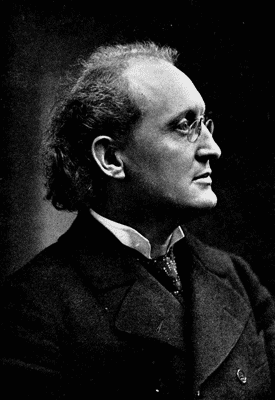
FRANK VAN DER STUCKEN.
On the bead-roll of those who have had
both the ability and the courage to take a
stand for our music, the name of Frank van 189
der Stucken must stand high. His Americanism
is very frail, so far as birth and breeding
count, but he has won his naturalization
by his ardor for native music.
Van der Stucken's life has been full of
labors and honors. He was born at Fredericksburg,
Texas, in 1858, of a Belgian
father and a German mother. After the
Civil War, in which the father served in
the Confederate army as a captain of the
Texan cavalry, the family returned to Belgium,
where, at Antwerp, Van der Stucken
studied under Benoit. Here some of his
music was played in the churches, and a
ballet at the Royal Theatre.
In 1878 he began studies in Leipzig, making
important acquaintances, such as Reinecke,
Grieg, and Sinding. His first male
chorus was sung there, with great success.
Of his fifth opus, consisting of nine songs,
Edvard Grieg wrote an enthusiastic criticism.
After travelling for some time, Van 190
der Stucken was appointed kapellmeister at
the Breslau Stadt-Theatre. This was his
début as conductor. Here he composed his
well-known suite on Shakespeare's "Tempest,"
which has been performed abroad and
here. Here, also, he wrote a "Festzug," an
important work in Wagnerian style, and his
passionate "Pagina d'Amore," which, with
the published portions of his lyric drama,
"Vlasda," has been performed by many
great orchestras.
In 1883, Van der Stucken met Liszt, at
Weimar, and under his auspices gave a concert
of his own compositions, winning the
congratulations of Grieg, Lassen, Liszt, and
many other celebrated musicians. A prominent
German critic headed his review of the
performance: "A new star on the musical
firmament."
Van der Stucken was now called to the
directorship of the famous Arion Male Chorus
in New York, a position which he held for 191
eleven years with remarkable results. In
1892 he took his chorus on a tour in Europe
and won superlative praises everywhere.
In 1885 and successive years Van der
Stucken conducted orchestral "Novelty Concerts,"
which have an historical importance
as giving the first hearing to symphonic
works by American composers. In Berlin
and in Paris he also gave our musicians the
privilege of public performance. From 1891
to 1894 he devoted himself to reforming
the Northeastern Säengerbund, achieving the
enormous task of making five thousand male
voices sing difficult music artistically. Since
1895 Van der Stucken has been conductor
of the newly formed Cincinnati Symphony
Orchestra, as well as dean of the faculty of
the College of Music in that city. The influence
of this man, who is certainly one of
the most important musicians of his time, is
bringing Cincinnati back to its old musical
prestige.192
As a composer, Van der Stucken shows
the same originality and power that characterize
him as an organizer. His prelude to
the opera "Vlasda" (op. 9) is one long
rapture of passionate sweetness, superbly
instrumented. An arrangement of it has
been made for the piano for four hands by
Horatio W. Parker.
Van der Stucken's music to "The Tempest"
(op. 8) is published in three forms.
Besides the orchestral score, there is an
arrangement for piano solo, by A. Siloti,
of the "Dance of the Gnomes," "Dance of
the Nymphs," and "Dance of the Reapers,"
the first and third being especially well
transcribed. For four hands, Hans Sitt
has arranged these three dances, as well as
a short but rich "Exorcism," some splendid
melodramatic music, and the rattling grotesque,
"The Hound-chase after Caliban."
All these pieces are finely imagined and
artistically handled.193
For piano solo, there is a group of three
Miniatures (op. 7). The first is an Albumblatt
of curious dun colors; the second is a
Capriccietto, a strange whim; the third is a
beautiful bit called "May Blossom."
Of Van der Stucken's songs I have seen
two groups, the first a setting of five love
lyrics by Rückert. None of these are over
two pages long, except the last. They are
written in the best modern Lied style, and
are quite unhackneyed. It is always the unexpected
that happens, though this unexpected
thing almost always proves to be a
right thing. Without any sense of strain or
bombast he reaches superb climaxes; without
eccentricity he is individual; and his
songs are truly interpreters of the words
they express. Of these five, "Wann die
Rosen aufgeblüht" is a wonderfully fine
and fiery work; "Die Stunde sei gesegnet"
has one of the most beautiful endings imaginable;
"Mir ist, nun ich die habe" has a deep
195
significance in much simplicity, and its ending,
by breaking the rule against consecutive
octaves, attains, as rule-breakings have an
unpleasant habit of doing, an excellent effect.
"Liebste, nur dich seh'n" is a passionate
lyric; and "Wenn die Vöglein sich gepaart"
is florid and trilly, but legitimately so; it
should find much concert use. These songs,
indeed, are all more than melodies; they are
expressions.
[Listen]
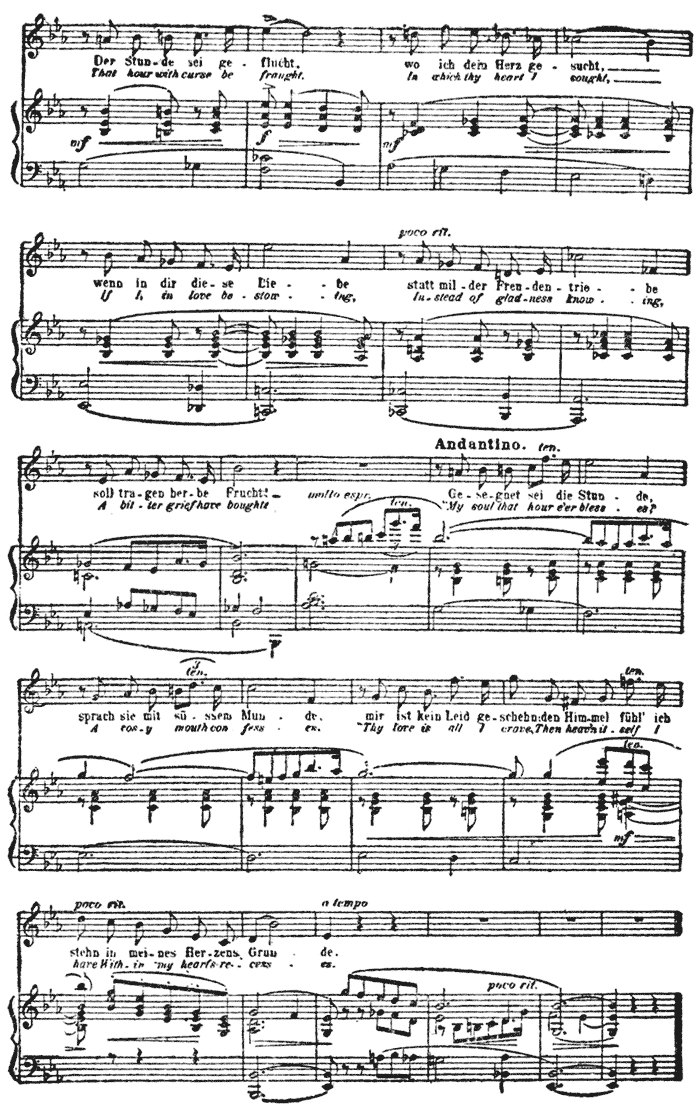
Copyright, 1892, by Friedrich Luckhardt, Berlin.
By permission of Luckhardt & Belder, New York.
Der Stunde sei geflucht,
wo ich dein Herz gesucht,
wenn in dir diese Liebe
statt milder Freudentriebe
soll tragen herbe Frucht!
Gesegnet ist die Stunde,
sprach sie mit süssem Munde,
mir ist kein Leid geschehn
den Himmel fühl' ich stehn
in meines Herzens Grunde.
|
That hour with curse be fraught,
In which thy heart I sought,
If I, in love bestowing,
Instead of gladness knowing,
A bitter grief have bought:
"My soul that hour e'er blesses,"
A rosy mouth confesses,
"Thy love is all I crave,
Then heav'n itself I have
Within my heart's recesses."
|
FRAGMENT OF MR. VAN DER STUCKEN'S "DIE STUNDE SEI GESEGNET."
Of the second group of eight songs for
low voice, "O Jugendlust" is athrill with
young ecstasy; "Einsame Thräne" has
superb coloring, all sombre, and a tremendous
climax; "Seeligkeit" is big with
emotion and ravishing in harmony, "Ein
Schäferlied" is exquisite, "Von schön Sicilien
war mein Traum" begins in the style
of Lassen, but ends with a strength and
vigor far beyond that tender melodist. Besides
these groups, there is a rich lyric
"Moonlight;" and there are many part songs.
196
A work of considerable importance written
many years before and presented by Franz
Liszt at Weimar had its first American production
in 1899, at Cincinnati and New York.
It is a symphonic prologue to Heine's tragedy,
"William Ratcliff." The different psychological
phases of the tragedy are presented
by characteristic motives which war among
themselves. The Scottish locale is indicated
vividly, and the despair of the lovers presented
in one place by the distortion and
rending of all the principal motives. A dirge
with bells and a final musing upon, and resignation
before, implacable Fate give a dignified
close to a work in which passion is
exploited with erudition and modernity.
W.W. Gilchrist.
The prize competition has its evils, unquestionably;
and, in a place of settled
status, perhaps, they outnumber its benefits. 197
But in American music it has been of material
encouragement to the production of large
works. In the first place, those who do not
win have been stimulated to action, and have
at least their effort for their pains. In the
second place, those who manage to win are
several hundred dollars the richer, and may
offer the wolf at the door a more effective
bribe than empty-stomached song.
In the city of Philadelphia lives a composer
of unusual luck in prize-winning. That
large and ancient town is not noteworthy for
its activity in the manufacture of original
music. In fact, some one has spoken of it
as "a town where the greatest reproach to
a musician is residence there." The city's
one prominent music-writer is William Wallace
Gilchrist; but he stands among the first
of our composers. He is especially interesting
as a purely native product, having never
studied abroad, and yet having won among
our composers a foremost place in the larger 198
forms of composition. He was born in Jersey
City, January 8, 1846; his father was a
Canadian, his mother a native of this country;
both were skilled in music, and his
home life was full of it, especially of the old
church music. After a youth of the usual
school life he tried various pursuits,—photography,
law, business; but music kept
calling him. A good barytone voice led him
to join vocal societies, and at length he made
music his profession, after studying voice,
organ, and composition with Dr. H.A.
Clarke, of Philadelphia. He was a successful
soloist in oratorio for some years, but
gradually devoted himself to church work
and conducting, and to composition, though
none of his music was published till he was
thirty-two, when he took two prizes offered
by the Abt Male Singing Society of Philadelphia.
Shortly after taking the Abt Society prize,
he won three offered by the Mendelssohn 199
Glee Club of New York, and in 1884 he took
the $1,000 prize offered by the Cincinnati
Festival Association.
This last was gained by his setting of the
Forty-sixth Psalm for soprano solo, chorus,
and orchestra. The overture opens with a
noble andante contemplatif, which deserves its
epithet, but falls after a time into rather uninteresting
moods, whence it breaks only at
the last period. The opening chorus, "God
Is Our Refuge and Strength," seems to me
to be built on a rather trite and empty subject,
which it plays battledore and shuttlecock
with in the brave old pompous and
canonic style, which stands for little beyond
science and labor. It is only fair to say,
however, that A.J. Goodrich, in his "Musical
Analysis," praises "the strength and
dignity" of this chorus; and gives a minute
analysis of the whole work with liberal thematic
quotation. The psalm, as a whole,
though built on old lines, is built well on 200
those lines, and the solo "God Is in the
Midst of Her" is taken up with especially
fine effect by the chorus. "The Heathen
Raged" is a most ingeniously complicated
chorus also.
The cantata, "Prayer and Praise," is similarly
conventional, and suffers from the sin of
repetition, but contains much that is strong.
Of the three prize male choruses written
for the Mendelssohn Glee Club, the "Ode
to the Sun" is the least successful. It is
written to the bombast of Mrs. Hemans, and
is fittingly hysterical; occasionally it fairly
shrieks itself out. "In Autumn" is quieter;
a sombre work with a fine outburst at the
end. "The Journey of Life" is an andante
misterioso that catches the gloom of Bryant's
verse, and offers a good play for that art of
interweaving voices in which Gilchrist is an
adept.
"The Uplifted Gates" is a chorus for
mixed voices with solos for sopranos and 201
altos; it is elaborate, warm, and brilliant. In
lighter tone are the "Spring Song," a trio
with cheap words, but bright music and a
rich ending, and "The Sea Fairies," a chorus
of delightful delicacy for women's voices. It
has a piano accompaniment for four hands.
In this same difficult medium of women's
voices is "The Fountain," a surpassingly
beautiful work, graceful and silvery as a cascade.
It reminds one, not by its manner at
all, but by its success, of that supreme
achievement, Wagner's song of the "Rhine-maidens."
The piano accompaniment to
Gilchrist's chorus aids the general picture.
A thoroughly charming work is the setting
of Lowell's poem, "The Rose," for solos and
chorus. The dreariness of the lonely poet
and the lonely maid contrasts strongly with
the rapture of their meeting. As the first
half of the poem is morose yet melodious, the
latter is bright with ecstasy; the ending is
of the deepest tenderness.202
By all odds the best of these choruses, however,
is "The Legend of the Bended Bow,"
a fine war-chant by Mrs. Hemans. Tradition
tells that in ancient Britain the people
were summoned to war by messengers who
carried a bended bow; the poem tells of the
various patriots approached. The reaper is
bidden to leave his standing corn, the hunts-man
to turn from the chase; the chieftain, the
prince, mothers, sisters, sweethearts, and the
bards are all approached and counselled to
bravery. After each episode follow the words
"And the bow passed on," but the music
has been so well managed that the danger of
such a repetition is turned into grim force.
The only prelude is five great blasts of the
horns. A brawny vigor is got by a frequent
use of imitation and unison in the voices.
The choric work is marked throughout with
the most intense and epic power, almost
savagery; a magnificent martial zest. The
climax is big. It is certainly one of 203
the best things of its kind ever done over
here.
Another work of fine quality throughout
is "A Christmas Idyl," for solos, chorus, and
orchestra. A terrible sombreness is achieved
in its former half by a notable simplicity.
The latter part is in brighter tone; the solo,
"And Thou, Bethlehem," is especially exultant.
In manuscript is "An Easter Idyl," of
large proportions, for solos, chorus, and orchestra,
or organ.
In the single songs the influence of Gilchrist's
early training in hymns is patent. In
only a few instances do they follow the latter-day
methods of Schumann and Franz. "A
Song of Doubt and a Song of Faith" is possibly
his best vocal solo. It begins with a
plaint, that is full of cynic despair; thence
it breaks suddenly into a cheerful andante.
"The Two Villages" is a strong piece of
work on the conventional lines of what might
be called the Sunday ballad. "A Dirge for 204
Summer" has a marked originality, and is of
that deep brooding which is particularly congenial
to Gilchrist's muse. The Scotch songs
are charming: "My Heart is Sair" is full of
fine feeling, and must be classed among the
very best of the many settings of this lyric
of Burns'.
Most modern in feeling of all Gilchrist's
vocal solos is the group of "Eight Songs."
They interpret the text faithfully and the
accompaniment is in accord with the song,
but yet possessed of its own individuality.
"A Love Song" is tender and has a well-woven
accompaniment; "The Voice of the
Sea" is effective, but hardly attains the large
simplicity of Aldrich' poem; "Autumn"
is exquisitely cheery; "Goldenrod" is ornately
graceful, while "The Dear Long
Ago" is quaint; "Lullaby" is of an exquisitely
novel rhythm in this overworked
form.
A LOVE SONG.
[Listen]
By Barry Cornwall.Music by W.W. Gilchrist.
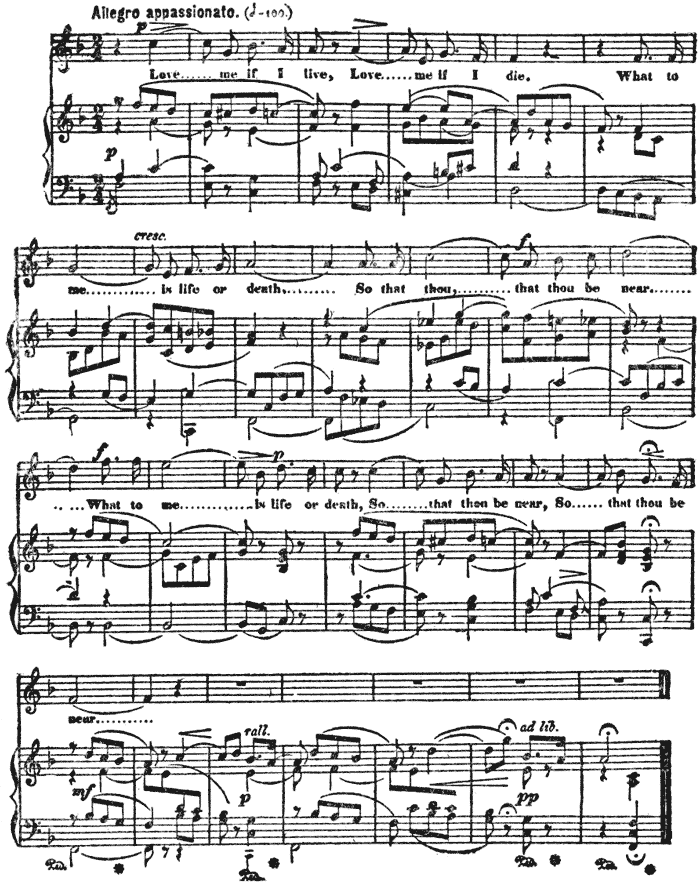
Copyright, 1885, by Arthur P. Schmidt & Co.
Love me if I live,
Love me if I die.
What to me is life or death,
So that thou, that thou be near.
What to me is life or death,
So that thou be near,
So that thou be near.
A FRAGMENT.
There is much contrast between the light206ness
of his book, "Songs for the Children,"
and his ponderous setting of Kipling's "Recessional."
The treatment of Paul Laurence
Dunbar's "Southern Lullaby" is unusual,
and the songs, "My Ladye" and "The Ideal,"
both in MS., are noteworthy.
Gilchrist has written a vast amount of
religious music, including several "Te
Deums," of which the one in C and that in
A flat are the best, to my thinking. He has
written little for the piano except a series of
duets, of which the charming "Mélodie" and
the fetching "Styrienne" are the best.
It is by his orchestral works, however, that
he gains the highest consideration. These
include a symphony for full orchestra, which
has been frequently performed with success;
a suite for orchestra; a suite for piano and
orchestra; as well as a nonet, a quintet, and
a trio, for strings and wind. None of these
have been published, but I have had the privilege
of examining some of the manuscripts.
207
The spirit and the treatment of these
works is strongly classical. While the
orchestration is scholarly and mellow, it
is not in the least Wagnerian, either in
manipulation or in lusciousness. The symphony
is not at all programmatic. The
Scherzo is of most exuberant gaiety. Its
accentuation is much like that in Beethoven's
piano sonata (op. 14, No. 2). Imitation is
liberally used in the scoring, with a delightfully
comic effect as of an altercation. The
symphony ends with a dashing finale that is
stormy with cheer. Gilchrist is at work upon
a second symphony of more modernity.
The "Nonet" is in G minor, and begins
with an Allegro in which a most original
and severe subject is developed with infinite
grace and an unusually rich color. The
Andante is religioso, and is fervent rather
than sombre. The ending is especially
beautiful. A sprightly Scherzo follows. It
is most ingeniously contrived, and the effects 208
are divided with unusual impartiality among
the instruments. A curious and elaborate
allegro molto furnishes the finale, and ends
the "Nonet" surprisingly with an abrupt
major chord.
The opening Allegro of the "Quintet"
begins with a 'cello solo of scherzesque
quality, but as the other voices join in, it
takes on a more passionate tone, whence it
works into rapturously beautiful moods and
ends magnificently. The piano part has a
strong value, and even where it merely ornaments
the theme carried by the strings, it is
fascinating. The Scherzo is again of the
Beethoven order in its contagious comicality.
The piano has the lion's share of it at first,
but toward the last the other instruments
leave off embroidery and take to cracking
jokes for themselves. The Andante is a
genuinely fine piece of work. It ranges from
melting tenderness to impassioned rage and
a purified nobility. The piano part is highly 209
elaborated, but the other instruments have
a scholarly, a vocal, individuality. I was
shocked to see a cadenza for the piano just
before the close, but its tender brilliance was
in thorough accord with the sincerity of the
movement. The "Quintet" ends with a
splendid Allegro.
In MS. are three interesting works for the
violin, a Rhapsody, a Perpetual Motion, and a
Fantasie.
This last has a piano accompaniment of
much ingenuity. The fantasial nature of the
work lies principally in its development,
which is remarkably lyrical, various melodies
being built up beautifully on fractions
of the main subjects. There is nothing
perfunctory, and the work is full of art and
appeal. Gilchrist is one of our most polished
composers contrapuntally, but has been here
in a very lyric mood.
He is the founder and conductor of the
Mendelssohn Club of Philadelphia, an un210usually
effective organization; one of the
founders of the local Manuscript Club;
the conductor of a choral society of two
hundred voices, at Harrisburg, and the
director of two church choirs.
G.W. Chadwick.
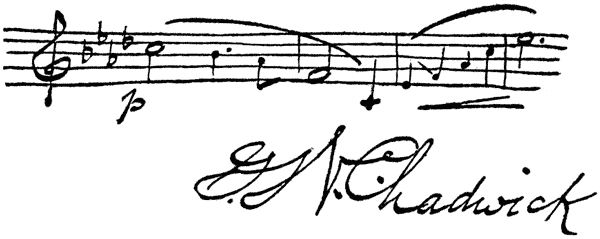
One of the most sophisticated, and, at the
same time, most eclectic of native music-makers,
is George W. Chadwick, to whom
the general consent of authorities would
grant a place among the very foremost of
the foremost American composers.
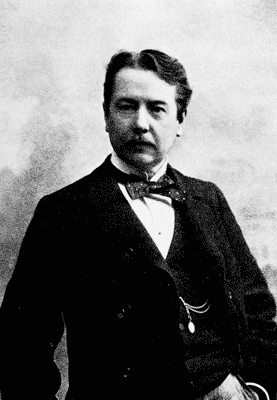
GEORGE WHITEFIELD CHADWICK.
His reputation rests chiefly on his two
symphonies, a number of concert overtures,
and many pieces of chamber-music, which211
are much praised. Chadwick was born at
Lowell, Mass., November 13, 1854. His
parents were American, and it was not till
1877, after studying with Eugene Thayer in
Boston, and teaching music in the college at
Olivet, Mich., that Chadwick studied for two
years at Leipzig, under Jadassohn and Reinecke,
and later at Munich for a year under
Rheinberger. In 1880 he returned to America
and settled in Boston, where he has since
lived, as organist, teacher, and conductor, an
important figure in the town's musical life.
Among his few works for the piano, are
"Six Characteristic Pieces" (op. 7). The
"Reminiscence of Chopin" is an interesting
and skilful chain of partial themes and
suggestions from Chopin. The "Étude" is a
monotonous study in a somewhat Schumannesque
manner, with a graceful finish. The
"Congratulation" is a cheerful bagatelle;
the "Irish Melody" is sturdy, simple, and
fetching; but the "Scherzino" is a hard 212
bit of humor with Beethoven mannerisms
lacking all the master's unction.
The opus ends with an unfortunate composition
inexcusably titled "Please Do!"
There are two bright "Caprices" and
three excellent waltzes, of which the third
is the best. It is a dreamy, tender work on
a theme by "B.J.L.," which refers, I presume,
to Mr. B.J. Lang.
Chadwick has done a vast amount of part-song
writing. His "Lovely Rosabelle" is
for chorus and orchestra, and is marked with
many original effects. His "Reiterlied" is
superbly joyful. A setting of Lewis Carroll's
immortal "Jabberwocky" shows much rich
humor of the college glee-club sort. There
is an irresistibly humorous episode where
the instrument of destruction goes "snicker
snack," and a fine hilarity at
"'O frabjous day
Callooh, callay,'
He chortled in his joy."
213
What would part-song writers do if the
Vikings had never been invented? Where
would they get their wild choruses for men,
with a prize to the singer that makes the
most noise? Chadwick falls into line with
"The Viking's Last Voyage" (1881), for
barytone solo, male chorus, and orchestra,
which gives him a very high place among
writers in this form. He has also a robustious
"Song of the Viking," and an excellent
Dedication Ode (1884), for solo, chorus, and
orchestra, to the pregnant words of Rev.
H.B. Carpenter, besides two cantatas for
mixed voices, "Phœnix Expirans" and "The
Pilgrims." In 1889 was published his
"Lovely Rosabelle," a ballad for chorus
and orchestra; it contains some interesting
dissonantial work in the storm-passages.
And his comic opera, "Tabasco,"
must be mentioned, as well as an enormous
mass of sacred music, which, I confess,
I had not the patience to study. 214
The flesh was willing, but the spirit was
weak.
Among Chadwick's songs is a volume of
Breton melodies harmonized with extreme
simplicity. Others are "Gay Little Dandelion,"
which is good enough of its everlasting
flower-song sort; "In Bygone Days" and
"Request," which, aside from one or two
flecks of art, are trashy; and two childish
namby-pambies, "Adelaide" and "The Mill."
"A Bonny Curl" catches the Scotch-ton
faithfully.
Chadwick usually succeeds, however, in
catching foreign flavors. His "Song from
the Persian" is one of his best works, and
possibly the very best is his "Sorais' Song,"
to Rider Haggard's splendid words. It has
an epic power and a wild despair. Up to
the flippancy of its last measures, it is quite
inspired, and one of the strongest of American
songs. The "Danza" is captivating
and full of novelty. "Green Grows the 215
Willow" is a burden of charming pathos
and quaintness, though principally a study
in theme-management. "Allah," however,
is rather Ethiopian than Mahommedan. His
"Bedouin Love Song" has little Oriental
color, but is full of rush and fire, with a
superb ending. It is the best of the countless
settings of this song. I wish I could
say the same of his "Thou Art so Like a
Flower," but he has missed the intense repression
of Heine.
The "Serenade" displays an interesting
rhythm; "The Miller's Daughter" is tender,
and "A Warning" is delightfully witty.
One regrets, however, that its best points
were previously used in Schumann's perfect
folk-song, "Wenn ich früh in den Garten
geh'." Chadwick has two folk-songs of his
own, however, which are superb. "He
Loves Me" is a tender, cradle-song-like bit
of delicious color. The "Lullaby" is a
genuinely interesting study in this over218worked
form. "The Lily" has the passionate
lyricism of Chaminade, and "Sweet Wind
that Blows" is a fine frenzy. The "Nocturne"
is dainty and has its one good climax.
"Before the Dawn" has some of Chadwick's
best work; it is especially marked by a daring
harmonic—you might say—impasto.
To Mrs. G.H. Stoddard.
TWO FOLK SONGS.
I
[Listen]
G.W. Chadwick
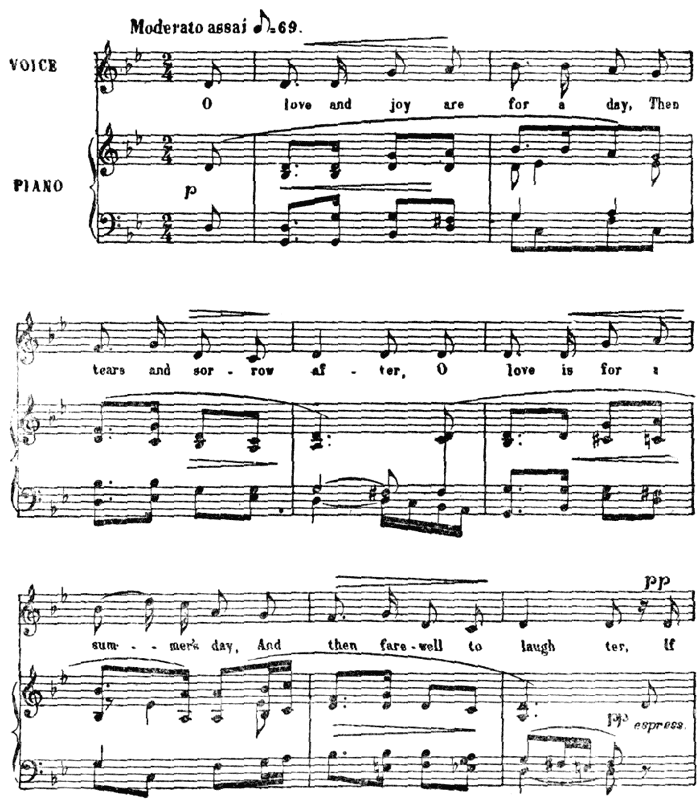
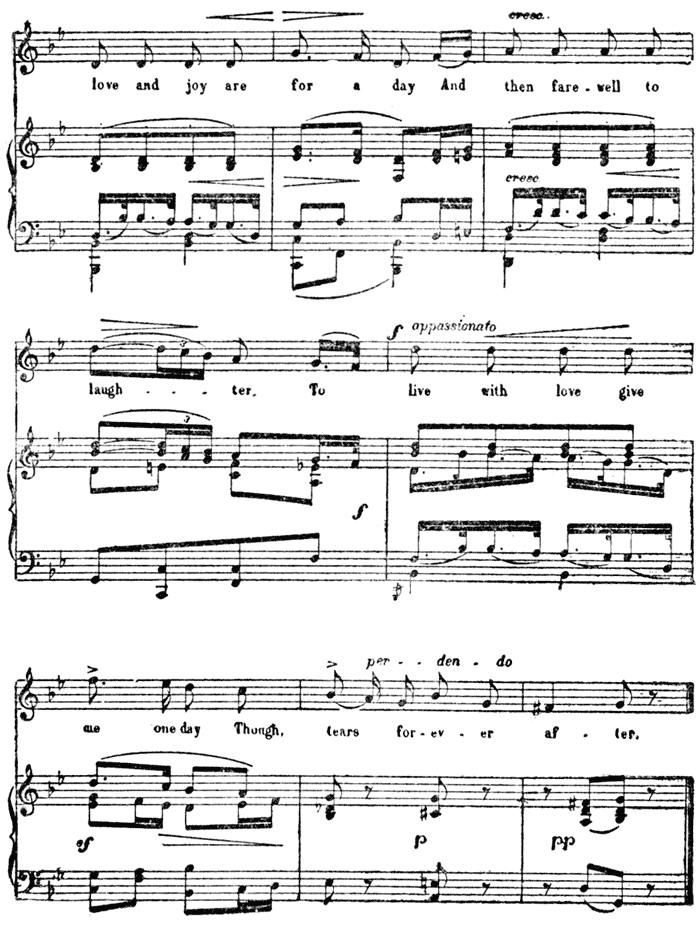
Copyright, 1892, by Arthur P. Schmidt.
O love and joy are for a day,
Then tears and sorrow after,
O love is for a summer's day,
And then farewell to laughter.
If love and joy are for a day
And then farewell to laughter,
To live with love give me one day
Though tears forever after.
His principal works, besides those mentioned,
may be catalogued (I am unable to
do more than catalogue most of them, having
seen only one of them, "The Lily
Nymph," performed, and having read the
score of only the "Melpomene" overture):
Concert overtures, "Rip Van Winkle" (written
in Leipzig, 1879, and played there the
same year), "Thalia" (1883), "Melpomene"
(1887), "The Miller's Daughter" (1887), and
"Adonais" (in memory of a friend, 1899);
Symphonies, in C (1882), in B (1885); an
Andante for string orchestra (1884), and
numerous pieces of chamber-music. In the
case of the cantata, "The Lily Nymph," 219
Chadwick's art was quite futilized by the
superb inanities of the book he used. The
"Melpomene" is a work of infinitely more
specific gravity. It is one of the most important
of American orchestral works.
As his "Thalia" was an "overture to an
imaginary comedy," so this, to an imaginary
tragedy. It has been played by the Boston
Symphony and many other orchestras. It
has that definiteness of mood with that indefiniteness
of circumstance in which music
wins its most dignified prosperity.
It opens with the solitary voice of the English
horn, which gives a notable pathos (read Berlioz on
this despairful elegist, and remember its haunting
wail in the last act of "Tristan und Isolde"). The
woeful plaint of this voice breathing above a low
sinister roll of the tympanum establishes at once
the atmosphere of melancholy. Other instruments
join the wail, which breaks out wildly from the
whole orchestra. Over a waving accompaniment
of clarinets, the other wood-winds strike up a more
lyric and hopeful strain, and a soliloquy from the
'cello ends the slow introduction, the materials of 220
which are taken from the two principal subjects of
the overture, which is built on the classic sonata
formula. The first subject is announced by the
first violins against the full orchestra; the subsidiary
theme is given to the flutes and oboes; after a
powerful climax, and a beautiful subsidence of the
storm in the lower strings, the second subject appears
in the relative major with honeyed lyricism.
The conclusion, which is made rather elaborate by
the latter-day symphonists, is reduced to a brief
modulation by Mr. Chadwick, and almost before
one knows it, he is in the midst of the elaboration.
It is hard to say whether the composer's emotion
or his counterpoint is given freer rein here, for the
work is remarkable both for the display of every
technical resource and for the irresistible tempest
of its passion. In the reprise there is a climax that
thrills one even as he tamely reads the score, and
must be overpowering in actual performance: the
cheerful consolation of the second subject provokes
a cyclonic outburst of grief; there is a furious climax
of thrilling flutes and violins over a mad blare of
brass, the while the cymbals shiver beneath the blows
of the kettledrum-sticks. An abrupt silence prepares
for a fierce thunderous clamor from the tympani
and the great drum (beaten with the sticks of
the side-drum). This subsides to a single thud of a 221
kettledrum; there is another eloquent silence; the
English horn returns to its first plaint; but grief has
died of very exercise, and the work ends in a coda
that establishes a major harmony and leaves the
hearer with a heart purged white and clean.
The "Melpomene" overture is a work of
such inspiration and such scholarship that it
must surely find a long youth in the chronicle
of our music.
Arthur Foote.
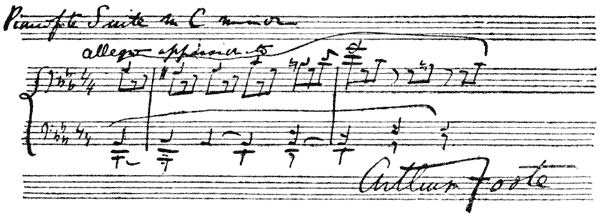
The nearest approach Americans make to
the enthusiastic German Männerchor is in the
college glee clubs. The dignity of their selections
is not always up to that of the Teutonic
chorus, but they develop a salutary fondness
for color and shading, exaggerating both a 222
little perhaps, yet aiming at the right warmth
and variety withal. Even those elaborate
paraphrases and circumlocutions of Mother
Goose rhymes, to which they are so prone,
show a striving after dramatic effect and richness
of harmony, as well as a keen sense of
wit and humor that are by no means incompatible
with real value in music.
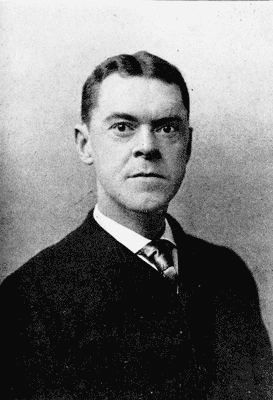
ARTHUR FOOTE.
Among their other good deeds must be
counted the fostering of the musical ambitions
of Arthur Foote, who was for two years the
leader of the Glee Club of Harvard University.
Though he has by no means been
content to delve no deeper into music than
glee-club depths, I think the training has been
of value, and its peculiar character is patent
in his works. He is especially fond of writing
for men's voices, and is remarkably at home
in their management, and he strives rather for
color-masses than for separate individualities
in the voices.
Among his larger works for men's voices 223
is an elaborate setting of Longfellow's poem,
"The Skeleton in Armor," which is full of
vigor and generally sturdy in treatment,
especially in its descriptions of Viking war
and seafaring. The storm-scenes, as in Mr.
Foote's "Wreck of the Hesperus," seem
faintly to suggest Wagnerian Donner und
Blitzen, but in general Mr. Foote has resisted
the universal tendency to copy the mannerisms
so many take to be the real essence of the
Bayreuthian. A pretty bit of fancy is the use
of a spinning-wheel accompaniment to the
love-song, although the spindle is nowhere
suggested by the poem. Indeed, the spinning
is treated as a characteristic motif for the
Norseman's bride, somewhat as it is Senta's
motif in "The Flying Dutchman."
The chief fault with the "Skeleton" chorus
is that it is always choric. There are no
solos, and the different registers are never
used separately for more than a bar or two,
before the whole mass chimes in. Even the 224
instrumental interludes are short, and the
general effect must be rather undiversified,
one of sympathy, too, for the unrested chorus.
"The Wreck of the Hesperus" is an
ambitious work, built on large lines, but hardly
represents Mr. Foote at his best. It is for
mixed voices, and is pitched in a most lugubrious
key, being always either vociferous with
panic or dismal with minor woe. A worse
trouble yet is the attempt to make a short
poem fit a long composition. The Procrustean
operation strains even Longfellow sadly.
This blemish is lacking in "The Farewell
of Hiawatha," which is written for men's
voices. Though it, too, is of a sad tone, its
sombre hues are rich and varied as a tapestry.
Its effects, though potent, seem more sincere
and less labored. It is altogether noble.
A larger body of sacred music for mixed
voices than many other Americans can boast,
also swells Foote's opus-score. Here he shows
the same facility with the quartette as in his 225
other works. In fact, I think the effect of
glee-club training on his young mind has
strongly influenced his whole life-work. And,
by the way, the most talented of all the great
Sebastian Bach's twenty-one children—every
one a musical opus, too—was diverted from
the philosopher's career for which he was
intended, and into professional musicianship,
by just such a glee-club training in the universities
at Leipzig and Frankfort.
Almost all of Foote's compositions are
written in the close harmony and limited
range of vocal music, and he very rarely
sweeps the keyboard in his piano compositions,
or hunts out startling novelties in
strictly pianistic effect. He is not fond of the
cloudy regions of the upper notes, and though
he may dart brilliantly skyward now and then
just to show that his wings are good for
lighter air, he is soon back again, drifting
along the middle ether.
He has won his high place by faithful ad226herence
to his own sober, serene ideals, and
by his genuine culture and seriousness. He
is thoroughly American by birth and training,
though his direct English descent accounts
for his decided leaning toward the better impulses
of the English school of music. He
was born at Salem, Mass., March 5, 1853,
and though he played the piano a good deal
as a boy, and made a beginning in the study
of composition with Emery, he did not study
seriously until he graduated from Harvard in
1874. He then took up the higher branches
of composition under the tuition of John
Knowles Paine, and obtained in 1875 the
degree of A.M. in the special department of
music. He also studied the organ and the
piano with B.J. Lang at Boston, and has
since made that city his home, teaching and
playing the organ.
His overture, "In the Mountains," has been
much played from the manuscript by orchestras,
among them the Boston Symphony. 227
Besides a considerable amount of highly
valuable contributions to American chamber-music,
and two fine piano suites, he has
written a great many piano pieces and songs
which deserve even greater popularity than
they have won, because, while not bristling
with technical difficulties, they are yet of permanent
worth.
I know of no modern composer who has
come nearer to relighting the fires that beam
in the old gavottes and fugues and preludes.
His two gavottes are to me among the best
since Bach. They are an example of what it
is to be academic without being only a-rattle
with dry bones. He has written a Nocturne
that gets farther from being a mere imitation
of Chopin than almost any night-piece written
since the Pole appropriated that form
bodily from John Field and made it his
own.
One of his most original pieces is the Capriccio
of his D minor Suite, which is also un228usually
brilliant in color at times; and he has
an Allegretto that is a scherzo of the good old
whole-souled humor. Foote, in fact, is never
sickly in sentiment.
Of his rather numerous songs, the older
English poets, like Marlowe, Sidney, Shakespeare,
Suckling, and Herrick, have given him
much inspiration. The song "It Was a Lover
and his Lass" is especially taking. His three
songs, "When You Become a Nun, Dear,"
"The Road to Kew," and "Ho, Pretty Page!"
written by modern poets in a half-archaic
way, display a most delicious fund of subtile
and ironic musical humor. "The Hawthorn
Wins the Damask Rose" shows how really
fine a well conducted English ballad can be.
Among his sadder songs, the "Irish Folksong,"
"I'm Wearing Awa'," and the weird
"In a Bower" are heavy with deepest pathos,
while "Sweet Is True Love" is as wildly intense
and as haunting in its woe as the fate
of the poor Elaine, whose despair it sings. 229
This I count one of the most appealing of
modern songs.
IT WAS A LOVER AND HIS LASS.
[Listen]
ARTHUR FOOTE, Op. 10, No. 1.
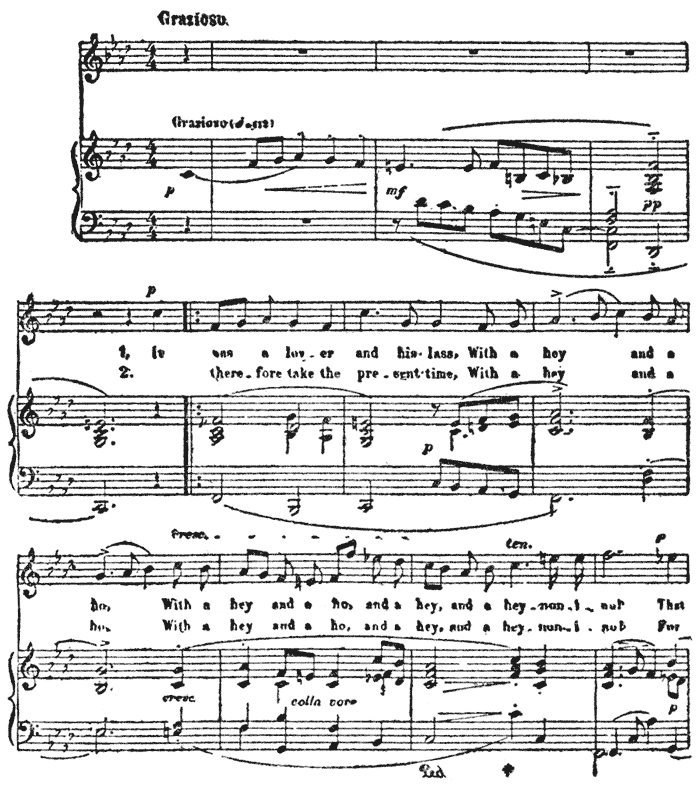
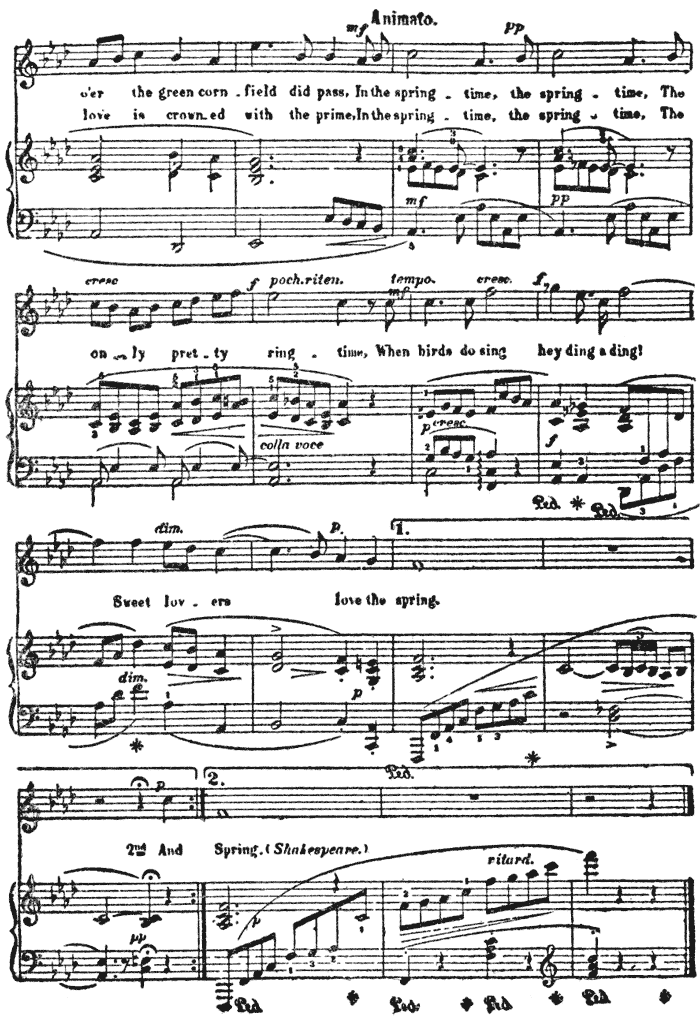
Copyright, 1886, by Arthur P. Schmidt & Co.
1. It was a lover and his lass,
With a hey and a ho,
With a hey and a ho, and a hey, and a hey non-i-no!
That o'er the green cornfield did pass,
In the springtime, the springtime,
The only pretty ring-time,
When birds do sing hey ding a ding!
Sweet lovers love the spring.
|
2. And therefore take the present time,
With a hey and a ho,
With a hey and a ho, and a hey, and a hey non-i-no!
For love is crowned with the prime,
In the springtime, the springtime,
The only pretty ring-time,
When birds do sing hey ding a ding!
Sweet lovers love the Spring. (Shakespeare.)
|
His greatest work is undoubtedly his symphonic
prologue to Dante's story of "Francesca
da Rimini," for full orchestra. Without
being informed upon the subject, I fancy a
certain programmism in the prologue that is
not indicated in the quotation at the beginning
of the work:
"Nessun maggior dolore,
Che ricordarsi del tempo felice
Nella miseria."
The prologue, however, seems to me to
contain more than the psychological content
of these lines from the fifth canto of the
"Inferno."
The slow introduction in C minor begins with a
long, deep sigh, followed by a downward passage in
the violas and 'cellos that seems to indicate the steps
that bring Dante and Vergil down to the edge of the
precipice past which the cyclone of the damned rolls
eternally. There is some shrieking and shuddering,232
and ominous thudding of the tympani (which are
tuned to unusual notes), then follows a short recitative
which might represent Dante's query to
Francesca how she came to yield to love. Suddenly
out of the swirling strings the first subject
is caught up; it is a frenzy passionately sung by
the first violins, reënforced by the flutes at the
crises. The second subject appears after a sudden
prelude by the brass; it is a very lyric waltz-tune in
the relative major, and doubtless depicts the joy
recalled in sorrow. The conclusion is quite lengthy;
it is also in waltz form, and is first announced by a
single flute over the violins and violas, the first violins
keeping to the gloomy G string. This air is now
given to a solo horn, and a fierce and irresistible
dance fervor is worked up. The elaboration begins
with the first subject in F sharp minor, caught up
fiercely from a downward rush. The reprise is not
long delayed, and the second subject appears, contrary
to custom, in the tonic major instead of the tonic
minor. The coda is deliciously tender and beautiful,
possibly because, being a prologue, the work must prepare
for a drama that begins cheerfully; possibly
because after all there is comfort in bliss remembered
in sorrow.
Tschaïkowski has written a symphonic
poem on the same subject, which has been 233
also the inspiration of numberless dramas,
and is one of the most pathetic pages in all
literature; even the stern old Dante says that
when he heard Francesca tell her story he
almost died of pity, and fell to the ground as
one dead.
A Serenade for string orchestra (op. 25)
contains a Prelude, a tender Air, a luscious
Intermezzo in the rich key of B major with
soli for violin and 'cello, a Romance with a
good climax, and a gallant Gavotte with
special attention to the too much slighted
violas.
Opus 36 is a suite for full orchestra. It has
been played by the Boston Symphony, and
consists of a brilliant Allegro; an Adagio of
deep sincerity and beautifully varied color, a
period wherein the brass choir, heavily scored,
chants alone, and the division of the theme
among the wood-wind over the rushing strings
is especially effective; a very whimsical Andante
with frequent changes of tempo, and 234
soli for the English horn in antiphony with
the first oboe; and a madcap Presto that
whisks itself out in the first violins.
Two other published works are a string
quartette (op. 4) and a quintette for piano and
strings (op. 36). This begins in A minor with
a well woven and well derived set of themes,
and ends in a scherzo in A major with spinning-song
characteristics. Between these two
movements comes an intermezzo of strongly
marked Scotch tone. This has been performed
by the Kneisel Quartette.
S.G. Pratt.
Almost every musician has heard of Christopher
Columbus, and holds him in a certain
esteem as a man without whose push the
invention of America would have been long
deferred; but few American musicians have
felt under a sufficient debt of gratitude to
make his troubles and triumphs the founda235tion
of an appropriate musical work. Silas
G. Pratt was bold enough to undertake the
monumental task; and he expended upon it
large resources of scholarship, research, and
enthusiasm. The work was performed at
New York during the Quadricentennial of
the discovery of America.
If Pratt had been born in old Egypt, he
would have found his chief diversion in the
building of pyramids, so undismayed is he by
the size of a task. His patriotism is a sharp
spur to him, and has enabled him to write
an orchestral composition devoted to Paul
Revere's Ride; a fantasy descriptive of a
battle between the Northern and Southern
armies; "The Battle of Manila;" "The Anniversary
Overture," in commemoration of the
centennial of American Independence, performed
in Berlin twice, and in London at the
Crystal Palace, during Grant's visit there;
and a march called by the curious name of
"Homage to Chicago." Besides these works 236
Pratt has written the "Magdalen's Lament,"
his first orchestral composition, suggested by
Murillo's picture; the lyric opera, "Antonio;"
a first symphony, of which the adagio was performed
in Berlin, the other movements being
produced in Boston and Chicago; a second
symphony, "The Prodigal Son;" a romantic
opera, "Zenobia," produced in Chicago; a
lyric opera, "Lucille," which ran for three
weeks in Chicago; a symphonic suite based
on the "Tempest;" a canon for a string
quartette; a serenade for string orchestra;
a grotesque suite, "The Brownies," produced
in New York and at Brighton Beach by
Anton Seidl. Besides these works of musical
composition, Pratt has delivered various
musical lectures, ingeniously contrived to
entertain the great public and at the same
time inform it. He has been active also in
the organization of various musical enterprises,
among them the Apollo Club of
Chicago.237
Pratt was born in Addison, Vermont,
August 4, 1846. At the age of twelve, he
was thrown on his own resources, and connected
himself with music publishing houses
in Chicago. After various public performances,
he went to Germany in 1868, to study
the piano under Bendel and Kullak, and
counterpoint under Kiel. In 1872 he returned
to Chicago and gave a concert of his
own works. But the phœnix city had not
entirely preened its wings after the great
fire of 1871, and Pratt found no support
for his ambitions. After teaching and giving
concerts, he returned to Germany in
1875, where he attended the rehearsals
of Wagner's Trilogy at Bayreuth, met Liszt
here, and gave a recital of his own compositions
at Weimar. His "Anniversary
Overture" was cordially received by the press
of both Berlin and London. A third visit to
Europe was made in 1885 for the production
of the "Prodigal Son" at the Crystal Palace, 238
on the occasion of which, Berthold Tours
wrote that both the symphony and the
"Anniversary Overture" were "grandly conceived
works, full of striking originality,
modern harmony, flowing melody, and beautiful,
as well as imposing effects."
Activity along such lines has left Pratt
little time for the smaller forms of composition;
a few have been published, among them
the song, "Dream Vision," in which Schumann's
"Träumerei" is used for violin obbligato;
and a few piano pieces, such as "Six
Soliloquies," with poetic text. In these each
chord shows careful effort at color, and the
work is chromatic enough to convince one
that he has studied his Bach thoroughly.
Among his massive compositions there
are two that seem likely to win, as they
surely deserve, a long life. These are the
symphonic suite, "The Tempest," and the
"Prodigal Son." To the latter splendid
achievement, A.J. Goodrich devotes several 239
pages of his "Musical Analysis," to which
I can do no better than to refer the reader.
The "Tempest" is based, of course, on Shakespeare's
play, and is described as follows by
the composer:
"It is intended, in the first movement, Adagio, to
typify the sorrow of Prospero, and his soul's protest
against the ingratitude and persecution of his enemies.
His willing attendant Ariel is briefly indicated
in the closing measures. The Pastoral furnishes an
atmosphere or stage setting for the lovers, Miranda
and Ferdinand, whose responsive love-song follows
the droning of a shepherd's pipe in the distance.
Prospero's interruption to their passionate assurances
of devotion, and the imposition of the unpleasant
task, are briefly touched upon, and the movement
closes with a repeat of the pastoral, and alternate
reiteration of the lover's song. The Finale, after a
short introduction, in most sombre vein, indicates
the flitting about of Ariel and his companion sprites
as they gather for revelry. The presence of the
master is soon made apparent by the recurrence, in a
subdued manner, of Prospero's first theme from the
Adagio, the fantastic tripping of the elves continuing,
as though the controlling spirit were conjuring up the
fête for the amusement of the lovers and himself.
240
"'Ye elves of hills, brooks, standing lakes and groves;
And ye that on the sand, with printless foot
Do chase the ebbing Neptune, and do fly him
When he comes back.'
"The dance then begins, and continues in a fantastic,
at times grotesque and furious manner, the
theme of the lovers being interwoven at times, in an
unobtrusive way. At length, Caliban is heard approaching,
singing his drunken song.
"''Ban, 'Ban, Ca-caliban
Has a new master: get a new man.'
"Ariel and his companions flit about, ridiculing,
mocking, and laughing at him; eventually prodding
and pinching him until, shivering, with aching joints,
he staggers away. The revelry then continues, the
song of the lovers becoming more and more prominent
until, somewhat broadened out, it asserts itself
triumphantly above all, Ariel and his companions
flitting about, Prospero happy, and Caliban subjugated,
all the chief themes being united to form the
climax and close of the work."
Although Pratt intentionally omitted the
English horn and the bass clarinet, the scoring
is remarkable for its color and faery. 241
The work is highly lyrical in effect, and the
woodsiness is beautifully established. The
solemnity of Prospero, the adroitness of the
lovers and the contrasting natures of the volatile
Ariel and the sprawling Caliban, make up
a cast of characters in the development of
which music is peculiarly competent. The
stertorous monologue of Caliban and his
hobbling dance, and the taunting and pinching
torment he is submitted to, make excellent
humor.
Henry K. Hadley.
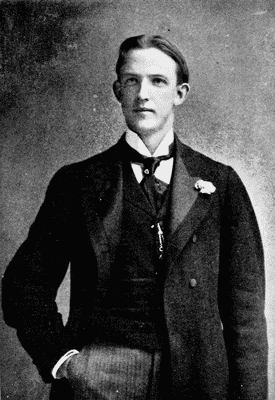
HENRY K. HADLEY.
The word symphony has a terrifying sound,
particularly when it is applied to a modern
work; for latter-day music is essentially
romantic in nature, and it is only a very rare
composer that has the inclination or the
ability to force the classic form to meet his
new ideas. The result is that such a work
usually lacks spontaneity, conviction. The 242
modern writer does much better with the
symphonic poem.
The number of American symphonies
worth listening to, could be counted on the
fingers with several digits to spare. A new
finger has been preëmpted by Henry K.
Hadley's symphony called "Youth and
Life." The title is doubly happy. Psychologically
it is a study of the intense emotional
life of youth, written by an American youth,—a
young man who, by the way, strangely
reminds one, in his appearance, of Macmonnies'
American type, as represented by
his ideal statue of Nathan Hale.
And musically the work is imbued with
both youth and life. It has blood and heart
in it. The first movement is a conflict between
good and evil motives struggling like
the mediæval angels for the soul of the hero.
The better power wins triumphantly. The
second movement, however, shows doubt
and despair, remorse and deep spiritual de243pression.
The climax of this feeling is a
death-knell, which, smitten softly, gives an
indescribably dismal effect, and thrills without
starting. Angelus bells in pedal-point
continue through a period of hope and prayer;
but remorse again takes sway. The ability
to obtain this fine solemnity, and follow it
with a scherzo of extraordinary gaiety, proves
that a genius is at large among us. The
Scherzo displays a thigh-slapping, song-singing
abandon that typifies youthful frivolity
fascinatingly. A fugue is used incidentally
with a burlesque effect that reminds one of
Berlioz' "Amen" parody in the "Damnation
of Faust." The Finale exploits motives
of ambition and heroism, with a moment of
love. The climax is vigorous. Without
being at all ariose, the symphony is full of
melody. Its melodies are not counterpoint,
but expression; and each instrument or choir
of instruments is an individuality.
Hadley is galvanic with energy and opti244mism,
dextrous to a remarkable degree in the
mechanism of composition. His scoring is
mature, fervent, and certain. His symphony
is legitimately programmatic and alive with
brains, biceps, and blood,—all three,—the
three great B's of composition.
Hadley was born at Somerville, Mass., in
1871. His father was a teacher of music
and gave him immediate advantages. He
studied harmony with Stephen A. Emery,
counterpoint with G.W. Chadwick, and the
violin with Henry Heindl and Charles N.
Allen of Boston. Before attaining his majority,
he had completed a dramatic overture,
a string quartette, a trio, and many songs
and choruses. In 1894 he went to Vienna
and studied composition with Mandyczewski.
Here he composed his third suite for the
orchestra. In 1896 he returned to America
and took charge of the music department of
St. Paul's school at Garden City, L.I. He
has had some experience as a conductor 245
and has been very prolific in composition.
His first symphony was produced under the
direction of Anton Seidl, in December, 1897;
and at a concert of his own compositions,
again, in January, 1900, Hadley conducted
this symphony, and also two movements from
his second symphony, "The Seasons." These
two movements show a mellower technic,
perhaps, but are less vital. He has written
three ballet suites with pronounced success,
the work being musical and yet full of the
ecstasy of the dance. His third ballet suite,
which is the best, was produced at a concert
of the American Symphony Orchestra, under
Sam Franko.
The existence of a festival march, a concert
overture, "Hector and Andromache,"
two comic operas, and six songs for chorus
and orchestra, besides a number of part songs
and piano pieces, and over one hundred songs,
forty of which are published, gives proof of
the restless energy of the man. The high 246
average of scholarship is a proof of his right
to serious acceptance.
A cantata for orchestra, "Lelewala," a
legend of Niagara, is published for piano
accompaniment. Now, Niagara is a dangerous
subject for the frail skiffs of rhyme, prose, or
music to launch out upon. Barrel staves may
carry one through the whirlpool, but music
staves cannot stand the stress. Of all the
comments upon the Falls of Niagara that I
have ever read, or heard of, there has been
only one that seemed anything but ridiculously
inappropriate; that one was the tribute
of a young boy who, on standing face to face
with the falls, simply exclaimed, in an awe-smothered
whisper, "Well, by gosh!" But it
must be admitted that these words would baffle
the music-making propensities even of the
composer of Händel's "Hallelujah Chorus."
That learned composer, George F. Bristow,
now dead, made the mistake of attempting to
compass Niagara in a work for chorus and 247
orchestra. Hadley is not exactly guilty of the
same fatal attempt in his "Lelewala," for the
poem is chiefly a story of love and sacrifice; but
Niagara comes in as a programmatic incident,
and the author of the text has fallen lamentably
short of his subject in certain instances.
In other moments, he has written with genuine
charm, and the music has much that is
worth while.
Among his published songs are to be
noted the unusually good setting of Heine's
"Wenn ich in deine Augen seh'" and of his
less often heard "Sapphire sind die Augen
dein," and "Der Schmetterling ist in die
Rose verliebt." A deservedly popular work
is "I Plucked a Quill from Cupid's Wing."
Among so many morose or school-bound
composers, Hadley is especially important for
the fact that he is thrilled with a sane and
jubilant music.
248
Adolph M. Foerster.
It has been fortunate for American song
that it forsook the narrow, roystering school
of English ballad and took for its national
model the Lied of the later German school.
It is true that the earlier English had its
poetry-respecting music in the work of
such a man as Henry Lawes, or Purcell, just
as it had its composers who far preceded
Bach in the key-roving idea of the "Well-tempered
Clavier;" but that spirit died out
of England, and found its latest avatar in
such men as Robert Franz, who confessed
that he had his first and fullest recognition
from this country.
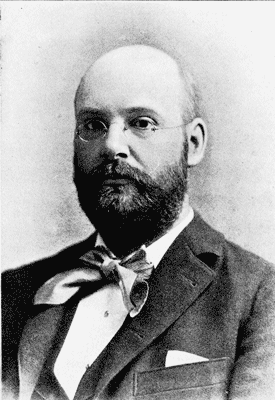
ADOLPH M. FOERSTER.
A correspondence with Franz was carried
on for eighteen years by one of the solidest
of American composers, Adolph M. Foerster,
who gives distinction to the musical life of
Pittsburg. He knew Franz personally, and has
written an important appreciation of him for 249
the magazine Music. Foerster was born at
Pittsburg in 1854. After three years of
commercial life, he took up music seriously,
and spent the years from 1872 to 1875 at
Leipzig,—studying the piano under Coccius
and Wenzel, singing under Grill and Schimon,
and theory under E.F. Richter and Papperitz.
Returning to America, he connected himself
with the Fort Wayne (Ind.) Conservatory of
Music, then under the direction of the beneficent
inventor of the Virgil Clavier. A year
later he returned to Pittsburg, where he has
since remained. For awhile he was conductor
of a symphonic society and a choral
union, which are no longer extant. Since, he
has devoted himself to teaching and composition.
Of Foerster's piano compositions opus 11
is a "Valse Brillante," warm and melodious.
Opus 13 is a "Sonnet," based, after the plan
of Liszt, upon a lyric of Petrarch's, a beautiful
translation from his "Gli occhi di ch'io
250
parlai si caldamente." It is full of passion,
and shows a fine variety in the handling of
persistent repetition. Opus 18 couples two
sonatinas. The second has the more merit,
but both, like most sonatinas, are too trivial
of psychology and too formal even to
be recommended for children's exercises.
"Eros" is a fluent melody, with a scherzesque
second part.
Opus 37 contains two concert études, both
superb works. The first, "Exaltation," is
very original, though neither the beginning
nor the ending is particularly striking. The
music between, however, has a fervor that
justifies the title. This étude is, like those
of Chopin, at the same time a technical study
and a mood. The second, a "Lamentation,"
begins with a most sonorous downward harmony,
with rushes up from the bass like
the lessening onsets of a retreating tide.
Throughout, the harmonies and emotions are
remarkably profound and the climaxes wild. 251
I should call it one of the best modern piano
compositions.
Twelve "Fantasy Pieces" are included in
opus 38. They are short tone-poems. The
second, "Sylvan Spirits," is fascinating, and
"Pretty Marie" has an irresistibly gay melody.
He has dedicated the six songs of opus 6 to
Robert Franz. These are written in a close
unarpeggiated style chiefly, but they are very
interesting in their pregnant simplicity. In
two cases they are even impressive: the well-known
lyric, "Im Rhein, im heiligen Strome,"
and "Meeresstille." Opus 12 is a notable
group of three songs: "Mists" is superbly
harmonious. Opus 25 includes "Ask Thou
Not the Heather Gray," a rhapsody of the
utmost ingenuity in melody and accompaniment.
It has a catching blissfulness and a
verve that make it one of the best American
songs. Opus 28 is a book called "Among
Flowers." The music is in every case good,
and especially satisfactory in its emancipation
252
from the Teutonism of Foerster's earlier
songs. The song "Among the Roses" has a
beautiful poem, which deserves the superb
music. It ends hauntingly with an unresolved
major ninth chord on the dominant of
the dominant. So the frenzy of "In Blossom
Time" is emotion of a human, rather than a
botanical sort. "The Cradle Song" adapts
the Siegfried Idyl, and the "Old Proverb" is
rollicking. The two songs of opus 34 are
fitted with words by Byron. The three songs
of opus 44 also make use of this poet, now so
little in vogue with composers. There are
three songs in opus 42: a pathetic "Little
Wild Rose," and "By the Seaside," which
is full of solemnity. "The Shepherd's
Lament" is one of his best lyrics, with a
strange accompaniment containing an inverted
pedal-point in octaves. There are also several
part songs.
In larger forms, Mr. Foerster is even more
successful. Opus 10 is a Character-piece for 253
full orchestra, based on Karl Schäfer's poem,
"Thusnelda." It is short but vigorous, and
well unified. Opus 15 is a Fantasie for
violin and piano, the piano having really the
better of it. The treatment is very original,
and the strong idea well preserved. Opus 21
is a Quartette for violin, viola, 'cello, and piano.
The first movement begins solemnly, but
breaks into an appassionato. All four instruments
have an equal voice in the parley, and
all the outbursts are emotional rather than
contrapuntal. A climax of tremendous
power is attained. The second movement
omits the piano for a beautiful adagio. The
third is an hilarious allegro, and the finale is
an even gayer presto, with movements of
sudden sobriety, suddenly swept away.
Foerster calls this Quartette "far inferior" to
a second one, opus 40. This, however, I
have not seen; but I do not hesitate to call
opus 21 a masterly work.
Opus 24 is an "Albumblatt" for 'cello and 254
piano. It is a wonderwork of feeling and
deep richness of harmony, of absolute sincerity
and inspiration. Opus 29 is a Trio for
violin, 'cello, and piano. The three begin in
unison, andante, whence the 'cello breaks
away, followed soon by the others, into the
joviality of a drinking bout. There is a military
moment, a lyric of more seriousness, and
a finish agitato. The second movement is a
larghetto highly embroidered. The third
movement is a vivace with the spirit of a
Beethoven presto.
Opus 36 is a suite for violin and piano,
beginning with a most engaging and most
skilful Novelette.
In MS. are: an elaborate ballad, "Hero
and Leander," which, in spite of an unworthy
postlude and certain "Tristan und Isolde"
memories, is ardent and vivid with passion;
"Verzweifelung," which is bitter and wild
with despair; a suite for piano (op. 46) containing
a waltz as ingenious as it is capti255vating;
and a finale called "Homage to
Brahms." This is a remarkably clever piece
of writing, which, while it lacks the Brahmsian
trade-mark of thirds in the bass, has
much of that composer's best manner, less
in his tricks of speech than in his tireless
development and his substitution of monumental
thematicism for lyric emotion. In
MS. is also a prelude to Goethe's "Faust"
for full orchestra. It has very definite leading
motives, which include "Faust's Meditations,"
"Visions of Margarethe," "Evil"
and "Love" (almost inversions of each other),
"Mephistopheles," and the like. The strife
of these elements is managed with great
cleverness, ending beatifically with the motive
of Gretchen dying away in the wood-wind.
An orchestral score that has been published
is the Dedication March for Carnegie
Hall in Pittsburg. It begins with a long
fanfare of horns heard behind the scenes.
Suddenly enters a jubilant theme beginning 256
with Andrew Carnegie's initials, a worthy
tribute to one to whom American music owes
much.
Charles Crozat Converse.
Musicians are not, as a class, prone to
a various erudition (a compliment fully returned
by the learned in other directions,
who are almost always profoundly ignorant
of the actual art of music). One of the rule-proving
exceptions is Charles Crozat Converse,
who has delved into many philosophies.
An example of his versatility of interest is
his coining of the word "thon" (a useful
substitute for the ubiquitous awkwardness of
"he or she" and "his or her"), which has
been adopted by the Standard Dictionary.
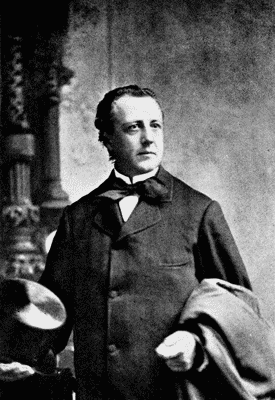
CHARLES CROZAT CONVERSE.
Converse' ancestry is American as far
back as 1630. Converse was born at Warren,
Mass., October 7, 1832. After being
well grounded in English and the classics,
he went, in 1855, to Germany. Here he
257
studied law and philosophy, and music at
the Conservatorium in Leipzig. He enjoyed
the instruction of Richter, Hauptmann,
Plaidy, and Haupt, and made the acquaintance
of Liszt and Spohr. Spohr was especially
interested in, and influential in, his
work, and confident of its success.
Returning to America, he graduated from
the Law Department of Albany University
in 1860, with the degree of LL.B. The B
has since been dignified into a D, as a tribute
to his unusual accomplishments. Converse
declined the honor of a Doctorship of
Music from the University of Cambridge,
offered him by its professor, the well-known
English composer, Sterndale Bennett, in recognition
of his mastery of lore as evinced in
a five-voiced double fugue that ends his
Psalm-Cantata on the 126th Psalm.
This scholarly work was performed under
the direction of Theodore Thomas in 1888,
at Chicago.
258
A widely known contribution to religious
music is Converse' hymn, "What a Friend
We Have in Jesus," which has been printed,
so they say, in all the tongues of Christendom,
and sold to the extent of fifty millions
of copies. This tune occupied a warm place
in my Sunday-schoolboy heart, along with
other singable airs of the Moody and Sankey
type, but as I hum it over in memory now,
it tastes sweetish and thin. Its popularity is
appalling, musically at least. Converse has
written many other hymn-tunes, which have
taken their place among ecclesiastical soporifics.
Besides, he has recently compiled a
collection of the world's best hymns into the
"Standard Hymnal." In this field Converse,
though conventional,—and conventionality
may be considered inevitable here,—is
mellow of harmony and sincere in sentiment.
Numberless attempts are made to supply
our uncomfortable lack of a distinctly na259tional
air, but few of them have that first
requisite, a fiery catchiness, and most of
them have been so bombastic as to pall even
upon palates that can endure Fourth of July
glorification. Recognizing that the trouble
with "America" was not at all due to the
noble words written by the man whom "fate
tried to conceal by naming him Smith," Converse
has written a new air to this poem.
Unfortunately, however, his method of varying
the much-borrowed original tune is too
transparent. He has not discarded the idea
at all, or changed the rhythm or the spirit.
He has only taken his tune upward where
"God Save the Queen" moves down, and
bent his melody down where the British
soars up. This, I fancy, is the chief reason
why his national hymn has gone over to the
great majority, and has been conspicuously
absent from such public occasions as torchlight
parades and ratifications.
Except the work issued under the alias
260
"Karl Redan," or the anagrams, "C.O.
Nevers" and "C.E. Revons," his only secular
musics that have been put into print are
his American Overture, published in Paris,
and a book of six songs, published in Germany.
Music is called the universal language, but
it has strongly marked dialects, and sometimes
a national flavor untranslatable to
foreign peoples. So with these six songs, not
the words alone are German. They are
based on a Teutonic, and they modulate only
from Berlin to Braunschweig and around
to Leipzig. While the songs repay study,
they are rather marked by a pianistic meditation
than a strictly lyric emotion. "Aufmunterung
zur Freude" is a tame allegretto;
"Wehmuth" is better; "Täuschung" is a
short elegy of passion and depth; "Ruhe in
der Geliebten" is best in its middle strain
where it is full of rich feeling and harmony.
The ending is cheap. "Der gefangene Sän261ger"
is only a slight variant at first on the
"Adieu" credited to Schubert; it is thereafter
excellent.
Converse has a large body of music in
manuscript, none of which I had the pleasure
of examining save a tender sacred lullaby.
There are two symphonies, ten suites, and
concert overture, three symphonic poems, an
oratorio, "The Captivity," six string quartettes,
and a mass of psalmodic and other
vocal writing.
Of these works three have been produced
with marked success: the "Christmas Overture,"
at one of the public concerts of the
Manuscript Society, under the direction of
Walter Damrosch; the overture "Im Frühling,"
at concerts in Brooklyn and New York,
under the baton of Theodore Thomas; and
the American overture, "Hail Columbia!"
at the Boston Peace Jubilee under Patrick
Gilmore, at the Columbian Exposition under
Thomas, and in New York under Anton Seidl.
262
This last overture received the distinction
of publication at Paris, by Schott et Cie. It
is built on the rousing air of "Hail, Columbia!"
This is suggested in the slow minor
introduction; the air itself is indicated
thematically as one of the subjects later
appearing in full swing in a coda. The instrumentation
is brilliant and the climax
overwhelming.
Altogether the work is more than adroit
musical composition. It is a prairie-fire of
patriotism.
L.A. Coerne.
A grand opera by an American on an
American subject is an achievement to look
forward to. Though I have not seen this
opera, called "A Woman of Marblehead," it
is safe to predict, from a study of its composer's
other works, that it is a thing of
merit.
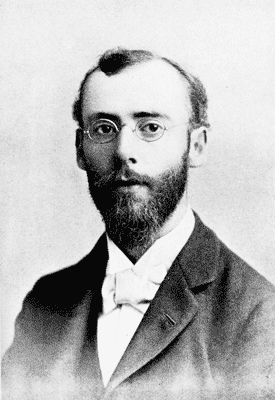
LOUIS ADOLPHE COERNE.
Louis Adolphe Coerne, who wrote the
263
music for this opera, was born in Newark,
N.J., in 1870, and spent the years from six
to ten in music study abroad, at Stuttgart
and Paris. Returning to America, he entered
Harvard College and studied harmony and
composition under John Knowles Paine. He
studied the violin under Kneisel. In 1890
he went to Munich, where he studied the
organ and composition at the Royal Academy
of Music, under Rheinberger, and the violin
under Hieber. He now decided to give up
the career of a violinist for that of composer,
conductor, and organist. In 1893 he returned
to Boston and acted as organist. A year
later he went to Buffalo, where for three
years he directed the Liedertafel.
While in Harvard, Coerne had composed
and produced a concerto for violin and 'cello
with string orchestra accompaniment, a fantasy
for full orchestra, and a number of
anthems which were performed at the university
chapel. While in Munich and Stutt264gart
he wrote and produced a string suite, an
organ concerto with accompaniment of strings,
horns, and harps, three choral works, and a
ballet, "Evadne," on a subject of his own.
His symphonic poem on Longfellow's "Hiawatha"
was also produced there with much
success under his personal direction, and later
by the Boston Symphony Orchestra. He was
invited then by Theodore Thomas to attend
the World's Fair at Chicago, to give recitals
on the great organ in Festival Hall.
It has been my misfortune not to have
heard or seen hardly any of his writings except
the published "Character Pieces" from
the ballet "Evadne" (op. 155). A "Clown's
Dance" in bolero rhythm is delightful. The
"Introduction to Act II." contains many
varied ideas and one passage of peculiar
harmonic beauty. A "Valse de Salon" has
its good bits, but is rather overwrought. A
"Devil's Dance" introduces some excellent
harmonic effects, but the "Waltz with Chorus
265
and Finale" is the best number of the opus.
It begins in the orchestra with a most irresistible
waltz movement that is just what a
waltz should be. A chorus is then superimposed
on this rhapsody, and a climax of superb
richness attained.
For the organ Coerne has written much
and well. There is an adaptation of three
pieces from the string quartette (op. 19); a
graceful Minuet, a quaint Aria, and a Fugue.
Then there are three Marches, which, like
most marches written by contemplative musicians,
are rather thematic than spirited, and
marked by a restless and elaborate preparation
for some great chant that is longed for,
but never comes. Besides these, there are a
very pleasant Pastoral, a good Elevation, and
a Nocturne.
Coerne's symphonic poem, "Hiawatha," has
been arranged for the piano for four hands,
and there is also an arrangement for violin or
violoncello and piano, but I have not seen
266
these. The thing we are all waiting for is
that American grand opera, "A Woman of
Marblehead." It is to be predicted that she
will not receive the marble heart.
267
CHAPTER IV.
THE COLONISTS.
Art does not prosper as hermit. Of
course, every great creator has a certain
aloofness of soul, and an inner isolation; but
he must at times submit his work to the comparison
of his fellow artists; he must profit
by their discoveries as well as their errors;
he must grow overheated in those passionate
musical arguments that never convince any
one out of his former belief, and serve salutarily
to raise the temper, cultivate caloric,
and deepen convictions previously held;
he must exchange criticisms and discuss
standards with others, else he will be eternally
making discoveries that are stale and unprofitable
to the rest of the world; he will
268
seek to reach men's souls through channels
long dammed up, and his achievements will
be marred by naïve triteness and primitive
crudeness.
So, while the artistic tendency may be a
universal nervous system, artists are inclined
to ganglionate. The nerve-knots vary in size
and importance, and one chief ganglion may
serve as a feeding brain, but it cannot monopolize
the activity. In America, particularly,
these ganglia, or colonies, are an interesting
and vital phase of our development. For a
country in which the different federated states
are, many of them, as large as old-world kingdoms,
it is manifestly impossible for any one
capital to dominate. Furthermore, the national
spirit is too insubordinate to accept any
centre as an oracle.
New York, which has certainly drawn to
itself a preponderance of respectable composers,
has yet been unable to gather in
many of the most important, and like the
269
French Academy, must always suffer in
prestige because of its conspicuous absentees.
In the second place, New York is the least
serious and most fickle city in the country,
and is regarded with mingled envy and patronage
by other cities.
Boston is even more unpopular with the
rest of the country. And New York and
other cities have enticed away so many of
the leading spirits of her musical colony, that
she cannot claim her once overwhelming
superiority. And yet, Boston has been, and
is, the highest American representative of
that much abused term, culture. Of all the
arts, music doubtless gets her highest favor.
The aid Boston has been to American
music is vital, and far outweighs that of any
other city. That so magnificent an organization
as its Symphony Orchestra could be so
popular, shows the solidity of its general art
appreciations. The orchestra has been remarkably
willing, too, to give the American
270
composer a chance to be heard. Boston has
been not only the promulgator, but in a
great measure the tutor, of American music.
In Boston-town, folk take things seriously
and studiously. In New York they take
them fiercely, whimsically. Like most generalizations,
this one has possibly more exceptions
than inclusions. But it is convenient.
It is convenient, too, to group together such
of the residents of these two towns, as I have
not discussed elsewhere. The Chicago coterie
makes another busy community; and St.
Louis and Cleveland have their activities of
more than intramural worth; Cincinnati,
which was once as musically thriving as its
strongly German qualities necessitated, but
which had a swift and strange decline, seems
to be plucking up heart again. For this, the
energy of Frank van der Stucken is largely
to credit. Aside from the foreign-born composers
there, one should mention the work of
Richard Kieserling, Jr., and Emil Wiegand.
271
The former went to Europe in 1891 and
studied at the Leipzig Conservatory, under
Reinecke, Homeyer, Rust, Schreck and Jadassohn.
He also studied conducting under
Sitt. At his graduation, he conducted a performance
of his own composition, "Jeanne
d'Arc." He returned to his native city, Cincinnati,
in 1895, where he has since remained,
teaching and conducting. Among his works,
besides piano pieces and songs, are: "A May
Song," for women's chorus and piano; six
pieces for violin and piano; "Harold," a ballad
for male chorus, barytone solo, and orchestra;
"Were It Not For Love," composed for
male chorus; several sets of male choruses;
a motet for mixed chorus a cappella; a berceuse
for string orchestra, an introduction
and rondo for violin and orchestra; and a
"Marche Nuptiale," for grand orchestra.
Emil Wiegand was also born in Cincinnati,
and had his first tuition on the violin
from his father. His theoretical studies have
272
been received entirely in Cincinnati. He is
a member of the local Symphonic Orchestra,
and has composed an overture for grand
orchestra, a string quartette, and various
pieces for the violin, piano, and voice.
In San Francisco there is less important
musical composition than there was in the
days when Kelley and Page were active there.
The work of H.B. Pasmore is highly commended
by cognoscenti, as are also the works
of Frederick Zeck, Jr., who was born in San
Francisco, studied in Germany, and has
composed symphonies, a symphonic poem,
"Lamia," a romantic opera, and other works;
Samuel Fleischmann, born in California and
educated abroad, a concert pianist, who has
written, among other things, an overture,
"Hero and Leander," which was performed
in New York; and P.C. Allen, who studied
in Europe, and has written well.
But the larger cities do not by any means
contain all the worthy composition. In
273
many smaller cities, and in a few villages
even, can be found men of high culture and
earnest endeavor.
In Yonkers, New York, is Frederick R.
Burton, who has written a dramatic cantata
on Longfellow's "Hiawatha," which has been
frequently performed. In this work use is
made of an actual Indian theme, which was
jotted down by H.E. Krehbiel, and is worked
up delightfully in the cantata, an incessant
thudding of a drum in an incommensurate
rhythm giving it a decidedly barbaric tone.
The cantata contains also a quaint and touching
contralto aria, and a pathetic setting of
the death-song of Minnehaha. Burton is a
graduate of Harvard, and a writer as well
as a composer. He organized, in 1896, the
Yonkers Choral Society, of which he is
conductor.
At Hartford, Conn., is Nathan H. Allen,
who was born in Marion, Mass., in 1848. In
1867 he went to Berlin, where he was a pupil
274
of Haupt for three years. In this country
he has been active as an organist and
teacher. Many of his compositions of sacred
music have been published, including a cantata,
"The Apotheosis of St. Dorothy."
At Providence, R.I., a prominent figure
is Jules Jordan, who was born at Willimantic,
Conn., November 10, 1850, of colonial
ancestry. Though chiefly interested in oratorio
singing, in which he has been prominent,
he has written a number of songs, some
of which have been very popular. The best
of these are a rapturous "Love's Philosophy,"
a delicious "Dutch Lullaby," "An Old
Song," and "Stay By and Sing." He has
written some religious songs, part songs, and
three works for soli, chorus, and orchestra,
"Windswept Wheat," "A Night Service,"
and "Barbara Frietchie;" also "Joel," a dramatic
scene for soprano and orchestra, sung
at the Worcester Musical Festival by Mme.
Nordica. This I have not seen, nor his
275
romantic opera, "Rip Van Winkle." In June,
1895, Brown University conferred on him
the degree of Doctor of Music. Two albums
of his songs are published.
A writer of many religious solos and part
songs is E.W. Hanscom, who lives in
Auburn, Me. He was born at Durham,
in the same State, December 28, 1848. He
has made two extended visits to London,
Berlin and Vienna, for special work under
eminent teachers, but has chiefly studied
in Maine. Besides his sacred songs Hanscom
has published a group of six songs, all
written intelligently, and an especially good
lyric, "Go, Rose, and in Her Golden Hair,"
a very richly harmonized "Lullaby," and two
"Christmas Songs," with violin obbligato.
In Delaware, Ohio, at the Ohio Wesleyan
University, is a composer, Willard J. Baltzell,
who has found inspiration for many worthy
compositions, but publishers for only two,
both of these part songs, "Dreamland" and
276
"Life is a Flower," of which the latter is
very excellent writing.
Baltzell was for some years a victim of the
musical lassitude of Philadelphia. He had
his musical training there. He has written
in the large forms a suite founded on Rossetti's
"Love's Nocturne," an overture,
"Three Guardsmen," a "Novelette" for orchestra,
a cantata, "The Mystery of Life,"
and an unfinished setting of Psalm xvii. with
barytone solo. These are all scored for
orchestra, and the manuscript that I have
seen shows notable psychological power.
Other works are: a string quartette, a trio,
"Lilith," based on Rossetti's poem, "Eden
Bower," a nonet, and a violin sonata. He
has also written for the piano and organ
fugues and other works. These I have not
seen; but I have read many of his songs in
manuscript, and they reveal a remarkable
strenuousness, and a fine understanding of
the poetry. His song, "Desire," is full of
277
high-colored flecks of harmony that dance
like the golden motes in a sunbeam. His
"Madrigal" has much style and humor.
He has set to music a deal of the verse of
Langdon E. Mitchell, besides a song cycle,
"The Journey," which is an interesting failure,—a
failure because it cannot interest
any public singer, and interesting because of
its artistic musical landscape suggestion; and
there are the songs, "Fallen Leaf," which is
deeply morose, and "Loss," which has some
remarkable details and a strange, but effective,
ambiguous ending. Other songs are a
superbly rapturous setting of E.C. Stedman's
"Thou Art Mine," and a series of
songs to the words of Richard Watson Gilder,
a poet who is singularly interesting to composers:
"Thistledown" is irresistibly volatile;
"Because the Rose Must Fade" has
a nobility of mood; "The Winter Heart"
is a powerful short song, and "Woman's
Thought," aside from one or two dangerous
278
moments, is stirring and intense. Baltzell
writes elaborate accompaniments, for which
his skill is sufficient, and he is not afraid
of his effects.
In the far Xanadu of Colorado lives Rubin
Goldmark, a nephew of the famous Carl
Goldmark. He was born in New York in
1872. He attended the public schools and
the College of the City of New York. At
the age of seven he began the study of the
piano with Alfred M. Livonius, with whom
he went to Vienna at the age of seventeen.
There he studied the piano with Anton Door,
and composition with Fuchs, completing in
two years a three years' course in harmony
and counterpoint. Returning to New York,
he studied with Rafael Joseffy and with
Doctor Dvôrák for one year. In 1892 he
went to Colorado Springs for his health.
Having established a successful College of
Music there, he has remained as its director
and as a lecturer on musical topics.
279
At the age of nineteen he wrote his
"Theme and Variations" for orchestra.
They were performed under Mr. Seidl's
leadership in 1895 with much success. Their
harmonies are singularly clear and sweet, of
the good old school. At the age of twenty
Goldmark wrote a trio for piano, violin, and
'cello. After the first performance of this
work at one of the conservatory concerts,
Doctor Dvôrák exclaimed, "There are now
two Goldmarks." The work has also had
performance at the concerts of the Kaltenborn
Quartette, and has been published. It
begins with a tentative questioning, from
which a serious allegro is led forth. It is
lyrical and sane, though not particularly
modern, and certainly not revolutionary in
spirit. The second movement, a romanza,
shows more contrapuntal resource, and is full
of a deep yearning and appeal,—an extremely
beautiful movement. The scherzo evinces a
taking jocosity with a serious interval. The
280
piano part is especially humorous. The finale
begins with a touch of Ethiopianism that is
perhaps unconscious. The whole movement
is very original and quaint.
Goldmark's music shows a steady development
from a conservative simplicity to a
modern elaborateness, a development thoroughly
to be commended if it does not lead
into obscurity. This danger seems to threaten
Goldmark's career, judging from his cantata
for chorus and orchestra, the "Pilgrimage to
Kevlaar," which, while highly interesting in
places, and distinctly resourceful, is too abstruse
and gloomy to stand much chance of
public understanding.
Many of the works that I have had the
privilege of examining in MS. have since
been published; there is much originality,
much attainment, and more promise in a
number of his songs. His setting of Marlowe's
"Come Live with Me," in spite of a
few eccentricities, shows, on the whole, a
281
great fluency of melody over an elaborately
beautiful accompaniment. His solemn and
mysterious "Forest Song" could deserve
the advertisement of being "drawn from the
wood." "Die erste Liebe" shows a contemplative
originality in harmony, and ends with
a curious dissonance and resolution. "O'er
the Woods' Brow" is very strange and interesting,
though somewhat abstruse. Less so
is a song, "An den Abendsstern;" it has a
comparison-forcing name, but is a delightful
song. "Es muss ein Wunderbares sein" is
notable for novel effects in harmonies of
crystal with light dissonances to edge the
facets. A sonata for piano and violin and
a romanza for 'cello have been published,
and his "Hiawatha" overture has been played
by the Boston Symphony Orchestra. On
this occasion the always quoteworthy mezzotintist,
James Huneker, wrote:
"The nephew of a very remarkable composer,—for
Carl Goldmark outranks to-day all the Griegs,
282
Massenets, Mascagnis, Saint-Saëns, and Dvôráks you
can gather,—he needs must fear the presence in his
scores of the avuncular apparition. His 'Hiawatha'
overture was played by Mr. Gericke and the Boston
Symphony Orchestra Wednesday of last week. At
the first cantilena on the strings I nearly jumped out
of my seat. It was bewilderingly luscious and Goldmarkian,—a
young Goldmark come to judgment.
The family gifts are color and rhythm. This youth
has them, and he also has brains. Original invention
is yet to come, but I have hopes. The overture,
which is not Indian, is full of good things, withal too
lengthy in the free fantasia. There is life, and while
there's life there's rhythm, and a nice variety there
is. The allegro has one stout tune, and the rush and
dynamic glow lasts. He lasts, does Rubin Goldmark,
and I could have heard the piece through
twice. The young American composer has not been
idle lately."
The New York Colony.
In every period where art is alive there
must be violent faction, and wherever there
is violent faction there is sure to be a tertium
quid that endeavors to bridge the quarrel.
283
The Daniel Websters call forth the Robert
Haynes, and the two together evoke the
compromisers, the Henry Clays.
In the struggle between modernity and
classicism that always rages when music is in
vitality, one always finds certain ardent spirits
who endeavor to reconcile the conflicting
theories of the different schools, and to
materialize the reconciliation in their own
work. An interesting example of this is to
be found in the anatomical construction of
one of the best American piano compositions,
the fantasy for piano and orchestra by
Arthur Whiting.
The composer has aimed to pay his respects
to the classic sonata formula, and at the same
time to warp it to more romantic and modern
usages. The result of his experiment is a
form that should interest every composer.
As Whiting phrases it, he has "telescoped"
the sonata form. The slow introduction
prepares for the first and second subjects,
284
which appear, as usual, except that they are
somewhat developed as they appear. Now,
in place of the regular development, the
pastoral movement is brought forward. This
is followed by the reprise of the first and
second subjects. Then the finale appears.
All of these movements are performed without
pause, and the result is so successful that
Whiting is using the same plan for a quintette.
Handwriting experts are fond of referring
to the "picture effect" of a page of writing.
It is sometimes startling to see the resemblance
in "picture effect" between the music
pages of different composers. The handsomely
abused Perosi, for instance, writes
many a page, which, if held at arm's length,
you would swear was one of Palestrina's.
Some of Mr. Whiting's music has a decidedly
Brahmsic picture effect. This feeling is
emphasized when one remembers the enthusiasm
shown for Brahms in Whiting's concerts,
285
where the works of the Ursus Minor of
Vienna hold the place of honor. The resemblance
is only skin deep, however, and
Whiting's music has a mind of its own.
The fantasy in question (op. 11) is full of
individuality and brilliance. The first subject
is announced appassionato by the strings,
the piano joining with arabesquery that follows
the general outlines. After this is
somewhat developed, the second subject
comes in whimsically in the relative major.
This is written with great chromatic lusciousness,
and is quite liberally developed. It
suddenly disappears into what is ordinarily
called the second movement, a pastoral, in
which the piano is answered by the oboe,
flute, clarinet, and finally the horn. This is
gradually appassionated until it is merged
into the reprise of the first movement proper.
During this reprise little glints of reminiscence
of the pastoral are seen. A coda of
great bravery leads to the last movement,
286
which is marked "scherzando," but is rather
martial in tone. The decidedly noble composition
ends with great brilliancy and strength.
It is published for orchestral score and for
two pianos.
Whiting was born in Cambridge, Mass.,
June 20, 1861. He studied the piano with
William H. Sherwood, and has made a successful
career in concert playing with the
Boston Symphony Orchestra and the Kneisel
Quartette, both of which organizations have
performed works of his. In 1883 he went
to Munich for two years, where he studied
counterpoint and composition with Rheinberger.
He is now living in New York as a
concert pianist and teacher.
Four works of his for the piano are: "Six
Bagatelles," of which the "Caprice" has a
charming infectious coda, while the "Humoreske"
is less simple, and also less amusing.
The "Album Leaf" is a pleasing whimsy,
and the "Idylle" is as delicate as fleece. Of288
the three "Characteristic Waltzes," the
"Valse Sentimentale" is by far the most interesting.
It manages to develop a sort of
harmonic haze that is very romantic.
Idylle.
[Listen]
ARTHUR WHITING.
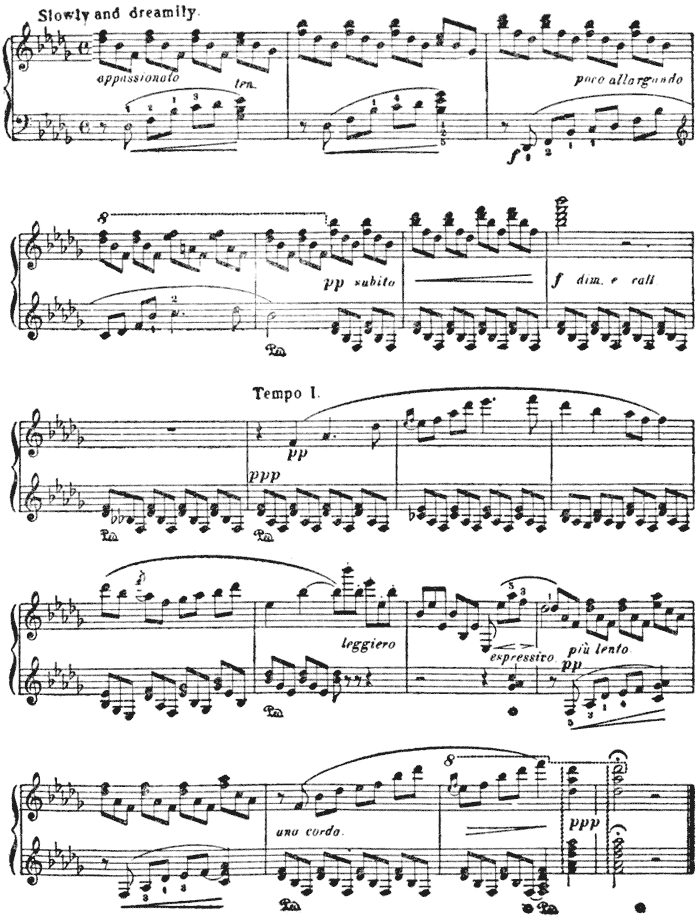
Copyright, 1895, by G. Schirmer.
A FRAGMENT.
For the voice, Whiting has written little.
Church music interests him greatly, and he
has written various anthems, a morning and
evening service, which keeps largely to the
traditional colors of the Episcopal ecclesiastical
manner, yet manages to be fervent without
being theatrical. A trio, a violin sonata,
and a piano quintette, a suite for strings,
and a concert overture for orchestra complete
the list of his writings.
On the occasion of a performance of Whiting's
"Fantasy," Philip Hale thus picturesquely
summed him up:
"In times past I have been inclined to the opinion
that when Mr. Whiting first pondered the question of
a calling he must have hesitated between chess and
music. His music seemed to me full of openings
and gambits and queer things contrived as in a game.
289
He was the player, and the audience was his antagonist.
Mr. Whiting was generally the easy conqueror.
The audience gave up the contest and admired the
skill of the musician.
"You respected the music of Mr. Whiting, but you
did not feel for it any personal affection. The music
lacked humanity. Mr. Whiting had, and no doubt
has, high ideals. Sensuousness in music seemed to
him as something intolerable, something against public
morals, something that should be suppressed by
the selectmen. Perhaps he never went so far as to
petition for an injunction against sex in music; but
rigorous intellectuality was his one aim. He might
have written A Serious Call to Devout and Holy
Composition, or A Practical Treatise upon Musical
Perfection, to which is now added, by the same
author, The Absolute Unlawfulness of the Stage
Entertainment Fully Demonstrated.
"There was almost intolerance in Mr. Whiting's
musical attitude. He himself is a man of wit rather
than humor, a man with a very pretty knack at
sarcasm. He is industrious, fastidious, a severe judge
of his own works. As a musician he was even in his
dryest days worthy of sincere respect.
"Now this fantasia is the outward and sure expression
of a change in Mr. Whiting's way of musical
thinking, and the change is decidedly for the better.
290
There is still a display of pure intellectuality; there
is still a solving of self-imposed problems; but Mr.
Whiting's musical enjoyment is no longer strictly
selfish. Here is a fantasia in the true sense of the
term; form is here subservient to fancy. The first
movement, if you wish to observe traditional terminology,
is conspicuous chiefly for the skill, yes, fancy,
with which thematic material of no marked apparent
inherent value is treated. The pastorale is fresh and
suggestive. The ordinary pastorale is a bore. There
is the familiar recipe: take an oboe the size of an
egg, stir it with a flute, add a little piano, throw in a
handful of muted strings, and let the whole gently
simmer in a 9-8 stew-pan. But Mr. Whiting has
treated his landscape and animal kingdom with rare
discretion. The music gave pleasure; it soothed by
its quiet untortured beauty, its simplicity, its discretion.
And in like manner, without receiving or
desiring to receive any definite, precise impression,
the finale interested because it was not a hackneyed
form of brilliant talk. The finale is something more
than clever, to use a hideous term that I heard applied
to it. It is individual, and this praise may be awarded
the whole work. Remember, too, that although this
is a fantasia, there is not merely a succession of unregulated,
uncontrolled, incoherent sleep-chasings.
"In this work there is a warmer spirit than that
291
which animated or kept alive Mr. Whiting's former
creations. There is no deep emotion, there is no
sensuousness, there is no glowing color, no 'color
of deciduous days.' These might be incongruous
in the present scheme. But there is a more pronounced
vitality, there is a more decided sympathy
with the world and men and women; there is more
humanity.
"The piano is here an orchestral instrument, and as
such it was played admirably by Mr. Whiting. His
style of playing is his own, even his tone seems peculiarly
his own, with a crispness that is not metallic,
with a quality that deceives at first in its carrying
power. His performance was singularly clean and
elastic, its personality was refreshing. He played
the thoughts of Mr. Whiting in Mr. Whiting's way.
And thus by piece and performance did he win a
legitimate success."

HENRY HOLDEN HUSS.
Many American composers have had their
first tuition from their mothers; few from
their fathers. Mr. Huss is one of the latter
few. The solidity of his musical foundation
bespeaks a very correct beginning. He was
born in Newark, N.J., June 21, 1862. His
first teacher in the theory of music was
292 Otis B. Boise,
who has been for the last twenty years a
teacher of theory in Berlin, though he was born in this country. Huss
went to Munich in 1883 and remained three years. He studied counterpoint
under Rheinberger, and won public mention for proficiency. At his second
examination his idyl for small orchestra, "In the Forest," was produced;
and at his graduation he performed his "Rhapsody" in C major for piano
and orchestra. A year after his return to America this work was given by
the Boston Symphony Orchestra. A year later Van der Stucken gave it at
the first of his concerts of American compositions. The next year Huss'
"Ave Maria," for women's voices, string orchestra, harp, and organ, was
given a public hearing. The next year he gave a concert of his own
works, and the same year, 1889, Van der Stucken produced his violin
romance and polonaise for violin and orchestra at the Paris Exposition.
293His piano concerto for piano and orchestra
he played first with the
Boston Symphony Orchestra in 1894, and has given it on numerous
occasions since.
Other works, most of which have also been published, are: "The
Fountain," for women's voices a cappella; a festival "Sanctus," for
chorus and orchestra; an "Easter Theme," for chorus, organ, and
orchestra; "The Winds," for chorus and orchestra, with soprano and alto
solos; a "Festival March," for organ and orchestra; a concerto for
violin, and orchestra; a trio for piano, violin, and 'cello; a "Prélude
Appassionata," for the piano, dedicated to and played by Miss Adèle aus
der Ohe, to whom the concerto is also dedicated.
This concerto, which is in D major, is a good example of the
completeness of Huss' armory of resources. The first movement has the
martial pomp and hauteur and the Sardanapalian opulence and color that mark
294
a barbaric triumph. Chopin has been the
evident model, and the result is always pianistic
even at its most riotous point. Huss
has ransacked the piano and pillaged almost
every imaginable fabric of high color. The
great technical difficulties of the work are entirely
incidental to the desire for splendor.
The result is gorgeous and purple. The andante
is hardly less elaborate than the first
movement, but in the finale there is some
laying off of the impedimenta of the pageant,
as if the paraders had put aside the magnificence
for a period of more informal festivity.
The spirit is that of the scherzo, and the
main theme is the catchiest imaginable, the
rhythm curious and irresistible, and the entire
mood saturnalian. In the coda there
is a reminder of the first movement, and the
whole thing ends in a blaze of fireworks.
On the occasion of its first performance
in Cincinnati, in 1889, Robert I. Carter
wrote:
295
"It is preëminently a symphonic work, in which
the piano is used as a voice in the orchestra, and
used with consummate skill. The charm of the work
lies in its simplicity. The pianist will tell you at
once that it is essentially pianistic, a term that is
much abused and means little. The traditional cadenza
is there, but it is not allowed to step out of the
frame, and so perfect is the relation to what precedes
and follows, that the average listener might claim
that it does not exist. Without wishing to venture
upon any odious grounds of comparison, I want to
state frankly that it is, to me, emphatically the best
American concerto."
Huss is essentially a dramatic and lyric
composer, though he seems to be determined
to show himself also a thematic composer of
the old school. In his trio, which I heard
played by the Kaltenborn Quartette, both
phases of his activity were seen. There was
much odor of the lamp about the greater
part of the trio, which seemed generally
lacking that necessary capillarity of energy
which sometimes saturates with life-sap the
most formal and elaborate counterpoint of the
296
pre-romantic strata. The andante of the trio,
however, displayed Huss' singularly appealing
gift of song. It abounded in emotion,
and was—to use the impossible word Keats
coined—"yearnful." Huss should write
more of this sort of music. We need its rare
spontaneity and truth, as we do not need the
all too frequent mathematics of those who
compose, as Tybalt fought, "by the book."
For the piano there are "Three Bagatelles":
an "Étude Melodique," which is
rather harmonic than melodic; an "Albumblatt,"
a graceful movement woven like a
Schumann arabesque; and a "Pastoral," in
which the gracefulness of the music given to
the right hand is annulled by the inexplicable
harshness of that given to the left.
For the voice, there is, of course, a setting
of "Du bist wie eine Blume," which, save for
the fact that it looks as if the accompaniment
were written first, is a very pure piece of
writing. The "Song of the Syrens" is a
297
strong composition with a big climax, the
"Jessamine Bud" is extremely delicate, and
"They that Sow in Tears" has much dignity.
There are two songs from Tennyson, "There
is Sweet Music Here" and "Home They
Brought Her Warrior Dead," with orchestral
accompaniment.
By all odds the most important, and a
genuinely improved composition is the aria
for soprano and orchestra, "The Death of
Cleopatra." The words are taken from
Shakespeare's play and make use of the
great lines given to the dying Egypt,
"Give me my robe, put on my crown, I
have immortal longings in me," and the rest.
The music not only pays all due reverence
to the sacred text, but is inspired by it, and
reaches great heights of fervor and tragedy.
From Shakespeare, Huss drew the afflation
for another aria of great interest, a setting
for barytone voice of the "Seven Ages of
Man." The problems attending the putting
298
to music of Shakespeare's text are severe;
but the plays are gold mines of treasure for
the properly equipped musician.
A vivid example of the difficulties in the
way of American composers' securing an
orchestral hearing is seen in the experience
of Howard Brockway, who had a symphony
performed in 1895 by the Berlin Philharmonic
Orchestra, and has been unable to
get a hearing or get the work performed in
America during the five years following, in
spite of the brilliancy of the composition.
The scoring of the work is so mature that
one can see its skill by a mere glance at the
page from a distance. When the work was
performed in Germany, it was received with
pronounced favor by the Berlin critics, who
found in it a conspicuous absence of all those
qualities which the youth of the composer
would have made natural.
Brockway was born in Brooklyn, November
22, 1870, and studied piano with H.O.C.
299
Kortheuer from 1887 to 1889. He went
to Berlin at the age of twenty and studied
the piano with Barth, and composition with
O.B. Boise, the transplanted American.
Boise gave Brockway so thorough a training
that he may be counted one of the most
fluent and completely equipped American
composers. At the age of twenty-four he
had finished his symphony (op. 12), a ballade
for orchestra (op. 11), and a violin and
piano sonata (op. 9), as well as a cavatina
for violin and orchestra. These, with certain
piano solos, were given at a concert of Brockway's
own works in February, 1895, at the
Sing-Akademie. His works were accepted
as singularly mature, and promising as well.
A few months later, Brockway returned to
New York, where he has since lived as a
teacher and performer.
His symphony, which is in D major, is so
ebullient with life that its dashing first subject
cannot brook more than a few measures
300
of slow introduction. The second subject is
simpler, but no less joyous. The thematic
work is scholarly and enthusiastic at the
same time. The different movements of
the symphony are, however, not thematically
related, save that the coda of the last
movement is a reminiscence of the auxiliary
theme of the first movement. The andante,
in which the 'cellos are very lyrical, is a
tender and musing mood. The presto is
flashing with life and has a trio of rollicking,
even whooping, jubilation. The finale
begins gloomily and martially, and it is succeeded
by a period of beauty and grace.
This movement, in fact, is a remarkable
combination of the exquisitest beauty and
most unrestrained prowess.
Another orchestral work of great importance
in American music is the "Sylvan
Suite" (op. 19), which is also arranged for
the piano. In this work the composer has
shown a fine discretion and conservation in
301
the use of the instruments, making liberal
employment of small choirs for long periods.
The work is programmatic in psychology
only. It begins with a "Midsummer Idyl,"
which embodies the drowsy petulance of hot
noon. The second number is "Will o' the
Wisps." In this a three-voiced fugue for the
strings, wood, and one horn has been used
with legitimate effect and most teasing, fleeting
whimsicality. The third movement is a
slow waltz, called "The Dance of the Sylphs,"
a very catchy air, swaying delicately in the bassoons
and 'cello; a short "Evening Song" is
followed by "Midnight." This is a parade
that reminds one strongly of Gottschalk's
"Marche de Nuit." The march movement
is followed by an interlude depicting the
mystery of night, as Virgil says, "tremulo
sub lumine." The composer has endeavored
to indicate the chill gray of dawn by the ending
of this movement: a chord taken by two
flutes and the strings shivering sul ponticello.
302
The last movement is "At Daybreak." Out
of the gloom of the bassoons grows a broad
and general luminous song followed by an
interlude of the busy hum of life; this is
succeeded by the return of the sunrise
theme with a tremendously vivacious accompaniment.
Other works of Brockway's are: a cantata,
a set of variations, a ballade, a nocturne, a
Characterstück, a Fantasiestück, a set of four
piano pieces (op. 21), and two piano pieces
(op. 25). All of these, except the cantata,
have been published. Two part songs and
two songs with piano accompaniment have
also been published; a violin sonata, a Moment
Musicale, and a romanza for violin and
orchestra have been published in Berlin.
These works all show a decided tendency
to write brilliant and difficult music, but the
difficulties are legitimate to the effect and
the occasion. The Ballade works up a very
powerful climax; the Scherzino swishes fas304cinatingly;
and the Romanza for piano is a
notably mature and serious work.
[Listen]
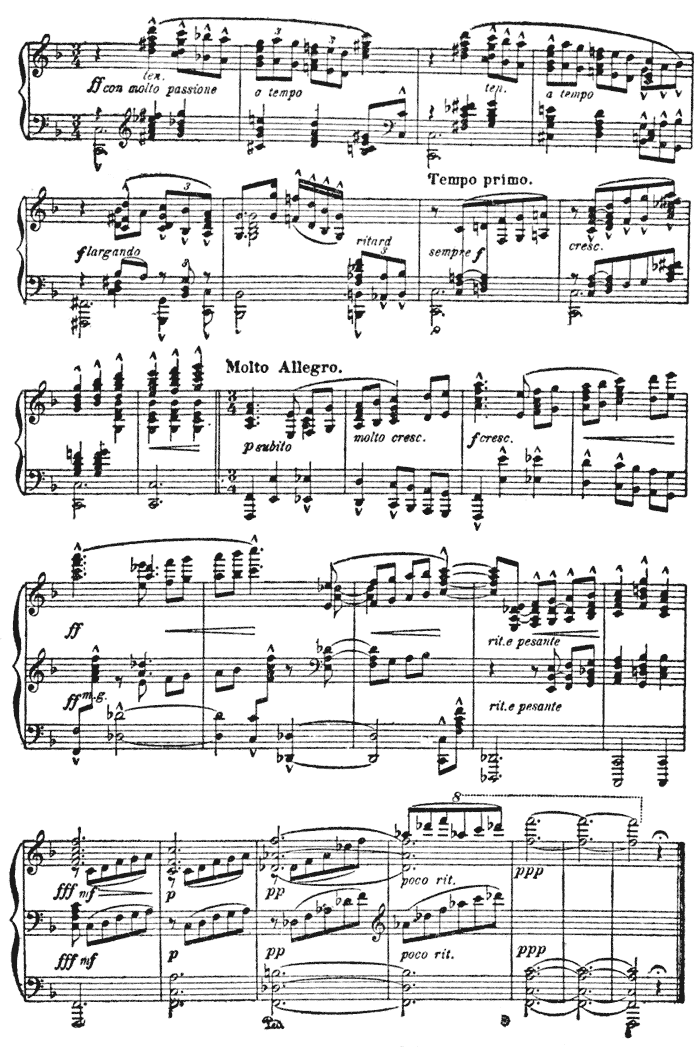
Copyright, 1894, by Schlesinger'sche Buch und Musikhandlung
(Rob. Lienau), Berlin.
FRAGMENT OF A "BALLADE" BY HOWARD BROCKWAY.
Two ballads have made the so romantic
name of Harry Rowe Shelley a household
word in America. They are the setting of
Tom Moore's fiery "Minstrel Boy," and a
strange jargon of words called "Love's
Sorrow." In both cases the music is intense
and full of fervor, and quick popularity
rarely goes out to more worthy songs.
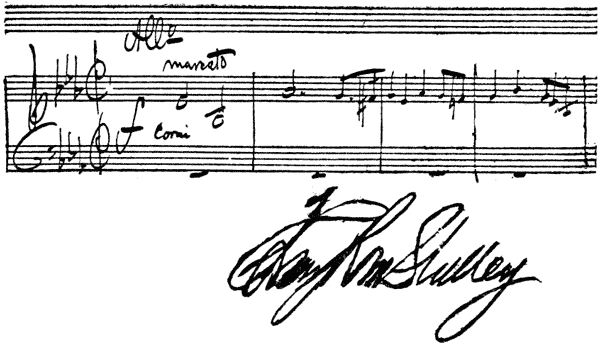
But Shelley would doubtless prefer to be
judged by work to which he has given more
of his art and his interest than to the many 305
songs that he has tossed off in the light
name of popularity.
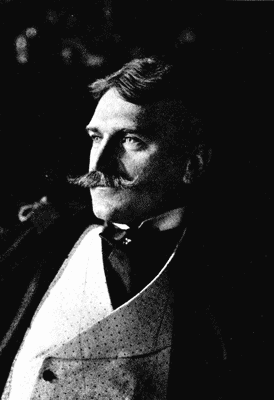
HARRY ROWE SHELLEY.
Shelley's life has been largely devoted to
church work. Born in New Haven, Conn.,
June 8, 1858, and taught music by Gustav
J. Stoeckel, he came under the tuition of
Dudley Buck for seven years. His twentieth
year found him an organist at New
Haven. Three years later he went to
Brooklyn in the same capacity. He was
the organist at Plymouth Church for some
time before Henry Ward Beecher's death.
Since 1887 he has been at the Church of the
Pilgrims. He visited Europe in 1887 and
studied under Dvôrák when the Bohemian
master was here.
Shelley's largest works have been an
opera, "Leila," still in manuscript, a symphonic
poem, "The Crusaders," a dramatic
overture, "Francesca da Rimini," a sacred
oratorio, "The Inheritance Divine," a suite
for orchestra, a fantasy for piano and orches306tra
(written for Rafael Joseffy), a one-act
musical extravaganza, a three-act lyric
drama, and a virile symphony. The suite
is called "Souvenir de Baden-Baden." It is
a series of highly elaborated trifles of much
gaiety, and includes a lively "Morning
Promenade," a dreamy "Siesta," a "Conversationshaus
Ball," and a quaint "Serenade
Orientale" that shows the influence
of Mozart's and Beethoven's marches alla
turca. The orchestration of this work I
have never heard nor seen. Its arrangement
for four hands, however, is excellently
done, with commendable attention to the
interests of the secondo player.
The cantata is called "The Inheritance
Divine," and it is much the best thing
Shelley has done. It begins with a long,
slow crescendo on the word "Jerusalem,"
which is very forceful. Shelley responds
to an imaginary encore, however, and the
word becomes little more than an expletive.
307
Page 7—to refer more conveniently than
technically—is marked by sonorous harmonies
of especial nobility. Now begins a
new idea worked up with increased richness
and growing fervor to a sudden magnificence
of climax in the second measure on page 11.
The final phrase, strengthened by an organ-point
on two notes, is fairly thrilling. A
tenor solo follows, its introductory recitative
containing many fine things, its aria being
smoothly melodious. A chorus, of warm
harmonies and a remarkably beautiful and
unexpected ending, is next; after which is
a sombre, but impressive alto solo. The
two successive choruses, the quartette, and
the soprano solo catch the composer nodding.
The bass solo is better; the final
chorus brings us back to the high plane.
Page 62 is particularly big of spirit, and
from here on the chorus climbs fiery heights.
In spite of Berlioz' famous parody on the
"Amen" fugues, in the "Damnation of
308
Faust," Shelley has used the word over a
score of times in succession to finish his
work. But altogether the work is one of
maturity of feeling and expression, and it is
a notable contribution to American sacred
music.
In 1898 "Death and Life" was published.
It opens with a dramatic chorus sung by the
mob before the cross, and it ends daringly
with a unisonal descent of the voices that
carries even the sopranos down to A natural.
In the duet between Christ and Mary, seeking
where they have laid her Son, the librettist
has given Christ a versified paraphrase
which is questionable both as to taste and
grammar. The final chorus, however, has
a stir of spring fire that makes the work
especially appropriate for Easter services.
The cantata "Vexilla Regis" is notable
for its martial opening chorus, the bass solo,
"Where deep for us the spear was dyed,"
and its scholarly and effective ending.
309
A lapidary's skill and delight for working
in small forms belongs to Gerrit Smith. His
"Aquarelles" are a good example of his art
in bijouterie. This collection includes eight
songs and eight piano sketches. The first,
"A Lullaby," begins with the unusual skip
of a ninth for the voice. A subdued accentuation
is got by the syncopation of the bass,
and the yearning tenderness of the ending
finishes an exquisite song. "Dream-wings"
is a graceful fantasy that fittingly presents
the delicate sentiment of Coleridge' lyrics.
The setting of Heine's "Fir-tree" is entirely
worthy to stand high among the numerous
settings of this lyric. Smith gets the air of
desolation of the bleak home of the fir-tree
by a cold scale of harmony, and a bold simplicity
of accompaniment. The home of the
equally lonely palm-tree is strongly contrasted
by a tropical luxuriance of interlude
and accompaniment.
The sixth song is a delightful bit of bril310liant
music, but it is quite out of keeping
with the poem. Thus on the words, "Margery's
only three," there is a fierce climax
fitting an Oriental declaration of despair.
The last of these songs, "Put by the Lute,"
is possibly Smith's best work. It is superb
from beginning to end. It opens with a
most unhackneyed series of preludizing
arpeggios, whence it breaks into a swinging
lyric, strengthened into passion by a vigorous
contramelody in the bass. Throughout, the
harmonies are most original, effective, and
surprising.
Of the eight instrumental pieces in this
book, the exquisite and fluent "Impromptu"
is the best after the "Cradle Song," which is
drowsy with luscious harmony and contains a
passage come organo of such noble sonority
as to put it a whit out of keeping with a
child's lullaby.
Smith was born December 11, 1859, at
Hagerstown, Md. His first instruction was
311
gained in Geneva, N.Y., from a pupil of
Moscheles. He began composition early,
and works of his written at the age of fourteen
were performed at his boarding-school.
He graduated at Hobart College in 1876,
whence he went to Stuttgart to study music
and architecture. A year later he was in
New York studying the organ with Samuel
P. Warren. He was appointed organist at
St. Paul's, Buffalo, and studied during the
summer with Eugene Thayer, and William
H. Sherwood. In 1880 he went again to
Germany, and studied organ under Haupt,
and theory under Rohde, at Berlin. On his
return to America he took the organ at St.
Peter's, in Albany. Later he came to New
York, where he has since remained continuously,
except for concert tours and journeys
abroad. He has played the organ in the
most important English and Continental
towns, and must be considered one of our
most prominent concert organists. He is
312
both a Master of Arts and a Doctor of
Music. As one of the founders, and for
many years the president, of the Manuscript
Society, he was active in obtaining
a hearing for much native music otherwise
mute.
In addition to a goodly number of Easter
carols, Christmas anthems, Te Deums, and
such smaller forms of religious music, Smith
has written a sacred cantata, "King David."
Aside from this work, which in orchestration
and in general treatment shows undoubted
skill for large effort, Doctor Smith's composition
has been altogether along the smaller
lines.
The five-song'd opus 14 shows well matured
lyric power, and an increase in fervor
of emotion. Bourdillon's "The Night Has a
Thousand Eyes," which can never be too
much set to music, receives here a truly
superb treatment. The interlude, which also
serves for finale, is especially ravishing.
313
"Heart Longings" is one of Mr. Smith's
very best successes. It shows a free passion
and a dramatic fire unusual for his rather
quiet muse. The setting of Bourdillon's fine
lyric is indeed so stirring that it deserves a
high place among modern songs. "Melody"
is a lyric not without feeling, but yet inclusive
of most of Smith's faults. Thus the
prelude, which is a tritely flowing allegro,
serves also for interlude as well as postlude,
and the air and accompaniment of both
stanzas are unvaried, save at the cadence of
the latter stanza. The intense poesy of
Anna Reeve Aldrich, a poetess cut short at
the very budding of unlimited promise, deserved
better care than this from a musician.
Two of Smith's works were published in
Millet's "Half-hours with the Best Composers,"—one
of the first substantial recognitions
of the American music-writer. A
"Romance," however, is the best and most
elaborate of his piano pieces, and is altogether315
an exquisite fancy. His latest work, a cycle
of ten pieces for the piano, "A Colorado
Summer," is most interesting. The pieces
are all lyrical and simple, but they are full of
grace and new colors.
Spring.
Words by Alfred Tennyson.
[Listen]
GERRIT SMITH, OP. 13, NO. 4.

Copyright, 1894, by Arthur P. Schmidt.
Bird's love and bird's song,
Flying here and there,
Bird's song and bird's love,
And you with gold for hair.
Bird's song and bird's love,
Passing with the weather,
Men's song and men's love,
To love once and forever.
A FRAGMENT.
But Smith's most individual work is his set
of songs for children, which are much compared,
and favorably, with Reinecke's work
along the same lines. These are veritable
masterpieces of their sort, and they are mainly
grouped into opus 12, called "Twenty-five
Song Vignettes."
So well are they written that they are a
safe guide, and worthy that supreme trust,
the first formation of a child's taste. Even
dissonances are used, sparingly but bravely
enough to give an idea of the different elements
that make music something more than
a sweetish impotence. They are vastly different
from the horrible trash children are
usually brought up on, especially in our
American schools, to the almost incurable
316
perversion of their musical tastes. They are
also so full of refinement, and of that humor
without which children cannot long be held,
that they are of complete interest also to
"grown-ups," to whom alone the real artistic
value of these songs can entirely transpire.
Worthy of especial mention are the delicious
"Stars and Angels;" the delightful "A
Carriage to Ride In;" "Good King Arthur,"
a captivating melody, well built on an accompaniment
of "God Save the King;" "Birdie's
Burial," an elegy of the most sincere pathos,
quite worthy of a larger cause,—if, indeed,
any grief is greater than the first sorrows of
childhood; the surprisingly droll "Barley
Romance;" "The Broom and the Rod," with
its programmatic glissandos to give things a
clean sweep; and other delights like the
"Rain Song," "The Tomtit Gray," "Mamma's
Birthday," and "Christmas at the
Door." To have given these works their
present value and perfection, is to have
317
accomplished a far greater thing than the
writing of a dozen tawdry symphonies.
One of the most outrageously popular
piano pieces ever published in America was
Homer N. Bartlett's "Grande Polka de Concert."
It was his opus 1, written years ago,
and he tells me that he recently refused a
lucrative commission to write fantasies
on "Nearer My God to Thee" and "The
Old Oaken Bucket"! So now that he
has reformed, grown wise and signed the
musical pledge, one must forgive him those
wild oats from which he reaped royalties,
and look to the genuine and sincere
work he has latterly done. Let us begin,
say, with opus 38, a "Polonaise" that out-Herods
Chopin in bravura, but is full of
vigor and well held together. A "Dance
of the Gnomes," for piano, is also arranged
for a sextet, the arrangement being a development,
not a bare transcription. There are
two mazurkas (op. 71), the first very original
318
and happy. "Æolian Murmurings" is a
superb study in high color. A "Caprice Español"
is a bravura realization of Spanish
frenzy. It has also been brilliantly orchestrated.
Two songs without words make up
opus 96: while "Meditation" shows too evident
meditation on Wagner, "A Love Song"
gets quite away from musical bourgeoisery.
It is free, spirited, even daring. It is patently
less devoted to theme-development than to
the expression of an emotion. This "Love
Song" is one of the very best of American
morceaux, and is altogether commendable.
Opus 107 includes three "characteristic
pieces." "The Zephyr" is dangerously like
Chopin's fifteenth Prelude, with a throbbing
organ-point on the same A flat. On this
alien foundation, however, Bartlett has built
with rich harmony. The "Harlequin" is
graceful and cheery. It ends with Rubinstein's
sign and seal, an arpeggio in sixths,
which is as trite a musical finis as fiction's
319
"They lived happily ever afterward, surrounded
by a large circle of admiring friends."
Three mazurkas constitute opus 125. They
are closely modelled on Chopin, and naturally
lack the first-handedness of these works, in
which, almost alone, the Pole was witty.
But Bartlett has made as original an imitation
as possible. The second is particularly
charming.
In manuscript is a Prélude developed
interestingly on well-understood lines. There
is a superb "Reverie Poétique." It is that
climax of success, a scholarly inspiration.
To the meagre body of American scherzos,
Bartlett's scherzo will be very welcome. It
is very festive and very original. Its richly
harmonized interlude shows a complete emancipation
from the overpowering influence of
Chopin, and a great gain in strength as well
as individuality.
In his songs Bartlett attains a quality uniformly
higher than that of his piano pieces.
320
"Moonbeams" has many delicacies of harmony.
"Laughing Eyes" is a fitting setting
of Mr. "Nym Crinkle" Wheeler's exquisite
lyric. "Come to Me, Dearest," while cheap in
general design, has fine details.
It makes me great dole to have to praise a
song about a brooklet; but the truth is, that
Bartlett's "I Hear the Brooklet's Murmur" is
superbly beautiful, wild with regret,—a noble
song. It represents the late German type of
Lied, as the earlier heavy style is exemplified
in "Good Night, Dear One." Very Teutonic
also is the airiness and grace of "Rosebud."
To that delightful collection of children's
songs, "The St. Nicholas Song Book,"
Bartlett contributed largely. All of his lyrics
are delicious, and "I Had a Little Pony"
should become a nursery classic.
In his "Lord God, Hear My Prayer,"
Bartlett throws down the gauntlet to the
Bach-Gounod "Ave Maria," with results
rather disastrous. He chooses a Cramer
321
étude, and adds to it parts for voice, violin,
and organ. While Gounod seems passionate
and unrestrained, Bartlett shows his caution
and his cage at every step. A Cramer étude
is among the most melancholy things of earth
anyway. "Jehovah Nissi" is an excellent
sacred march chorus that won a prize, and
there is a cantata, "The Last Chieftain."
Bartlett's cantata is without efforts at Indian
color, but is a solid work with much dignity,
barbaric severity, and fire.
Bartlett was born at Olive, N.Y., December
28, 1846. His ancestry runs far back
into New England, his mother being a
descendant of John Rogers, the martyr.
Bartlett is said to have "lisped in numbers,"
singing correctly before he could articulate
words. The violin was his first love, and at
the age of eight he was playing in public.
He took up the piano and organ also, and in
his fourteenth year was a church organist.
He studied the piano with S.B. Mills, Emil
322
Guyon (a pupil of Thalberg), and Alfred Pease.
The organ and composition he studied with
O.F. Jacobsen and Max Braun. With the
exception of a musical pilgrimage in 1887,
Bartlett has not come nearer the advantages
of Europe than study here under men who
studied there. He has resided for many
years in New York as organist and teacher.
As a composer he has been one of our most
prolific music-makers. His work shows a
steady development in value, and the best is
doubtless yet to come.
He finds a congenial field in the orchestra.
Seidl played his instrumentation of Chopin's
"Military Polonaise" several times. As the
work seemed to need a finale in its larger
form, Bartlett took a liberty whose success was
its justification, and added a finish made up
of the three principal themes interwoven. A
recent work is his "Concertstück," for violin
and orchestra. It is not pianistic in instrumentation,
and will appeal to violinists.
323
While not marked with récherchés violin tricks,
or violent attempts at bravura, it has both
brilliance and solidity, and is delightfully
colored in orchestration. There are no
pauses between the movements, but they
are well varied in their unity.
There is an unfinished oratorio, "Samuel,"
an incomplete opera, "Hinotito," and a cantata
of which only the tenor solo, "Khamsin," is
done. This is by far the best work Bartlett
has written, and displays unexpected dramatic
powers. The variation of the episodes of the
various phases of the awful drought to the
climax in "The Plague," make up a piece of
most impressive strength. The orchestration
is remarkably fine with effect, color, and
variety. If the cantata is finished on this
scale, its production will be a national event.
The New England farmer is usually taken
as a type of sturdy Philistinism in artistic
matters. It was a most exceptional good
fortune that gave C.B. Hawley a father who
324
added to the dignity of being a tiller of the
soil the refinements of great musical taste
and skill. His house at Brookfield, Conn.,
contained not only a grand piano, but a pipe
organ as well; and Hawley's mother was
blessed with a beautiful and cultivated voice.
At the age of thirteen (he was born St.
Valentine's Day, 1858) Hawley was a church
organist and the conductor of musical affairs
in the Cheshire Military Academy, from
which he graduated. He went to New York
at the age of seventeen, studying the voice
with George James Webb, Rivarde, Foederlein,
and others, and composition with Dudley
Buck, Joseph Mosenthal, and Rutenber.
His voice brought him the position of soloist
at the Calvary Episcopal Church, at the
age of eighteen. Later he became assistant
organist at St. Thomas' Episcopal Church,
under George William Warren. For the last
fourteen years he has had charge of the summer
music at St. James Chapel, in Elberon,
325
the chapel attended by Presidents Grant and
Garfield. For seventeen years he has been
one of the leading spirits of the Mendelssohn
Glee Club, and for ten years a member of the
Mendelssohn Quartet Club. Most of his
part songs were written for the club and first
sung at its concerts. He is also a successful
teacher of the voice, and has been too busy
to write a very large volume of compositions.
But those published show the authentic fire.
Notable features of Hawley's compositions
are the taking quality of the melody, its
warm sincerity, and the unobtrusive opulence
in color of the accompaniment. This is
less like an answering, independent voice
than like a many-hued, velvety tapestry, back-grounding
a beautiful statue. It is only on
second thought and closer study that one
sees how well concealed is the careful and
laborious polish ad unguem of every chord.
This is the true art of song, where the lyrics
should seem to gush spontaneously forth
326
from a full heart and yet repay the closer
dissection that shows the intellect perfecting
the voice of emotion.
Take, for example, his "Lady Mine," a
brilliant rhapsody, full of the spring, and enriched
with a wealth of color in the accompaniment
till the melody is half hidden in a
shower of roses. It required courage to
make a setting of "Ah, 'Tis a Dream!" so
famous through Lassen's melody; but Hawley
has said it in his own way in an air
thrilled with longing and an accompaniment
as full of shifting colors as one of the native
sunsets. I can't forbear one obiter dictum
on this poem. It has never been so translated
as to reproduce its neatest bit of fancy.
In the original the poet speaks of meeting
in dreams a fair-eyed maiden who greeted
him "auf Deutsch" and kissed him "auf
Deutsch," but the translations all evade the
kiss in German.
"The Ring," bounding with the glad
327
frenzy of a betrothed lover, has a soaring
finale, and is better endowed with a well
polished accompaniment than the song, "Because
I Love You, Dear," which is not without
its good points in spite of its manifest
appeal to a more popular taste. "My Little
Love," "An Echo," "Spring's Awakening,"
and "Where Love Doth Build His Nest," are
conceived in Hawley's own vein.
The song, "Oh, Haste Thee, Sweet," has
some moments of banality, but more of
novelty; the harmonic work being unusual at
times, especially in the rich garb of the
words, "It groweth late." In "I Only
Can Love Thee," Hawley has succeeded in
conquering the incommensurateness of Mrs.
Browning's sonnet by alternating 6-8 and 9-8
rhythms. His "Were I a Star," is quite a
perfect lyric.
Of his part songs, all are good, some are
masterly. Here he colors with the same
lavish but softly blending touch as in his
328
solos. "My Luve's Like a Red, Red Rose"
is altogether delightful, containing as it does
a suggestion of the old formalities and
courtly graces of the music of Lawes, whose
songs Milton sonneted. I had always thought
that no musician could do other than paint
the lily in attempting to add music to the
music of Tennyson's "Bugle Song," but
Hawley has come dangerously near satisfaction
in the elfland faintness and dying
clearness of his voices.
He has written two comic glees, one of
which, "They Kissed! I Saw Them Do It,"
has put thousands of people into the keenest
mirth. It is a vocal scherzo for men's voices.
It begins with a criminally lugubrious and
thin colloquy, in which the bass dolefully
informs the others: "Beneath a shady tree
they sat," to which the rest agree; "He held
her hand, she held his hat," which meets
with general consent. Now we are told in
stealthy gasps, "I held my breath and lay
329
right flat." Suddenly out of this thinness
bursts a peal of richest harmony: "They
kissed! I saw them do it." It is repeated
more lusciously still, and then the basses and
barytones mouth the gossip disapprovingly,
and the poem continues with delicious raillery
till it ends abruptly and archly: "And
they thought no one knew it!"
Besides these scherzos, Hawley has written
a few religious part songs of a high order,
particularly the noble "Trisagion and Sanctus,"
with its "Holy, Holy!" now hushed in
reverential awe and now pealing in exultant
worship. But of all his songs, I like best his
"When Love is Gone," fraught with calm
intensity, and closing in beauty as ineffable
as a last glimmer of dying day.
When Love is gone.
(Soprano, or Tenor.)
[Listen]
C.B. HAWLEY.
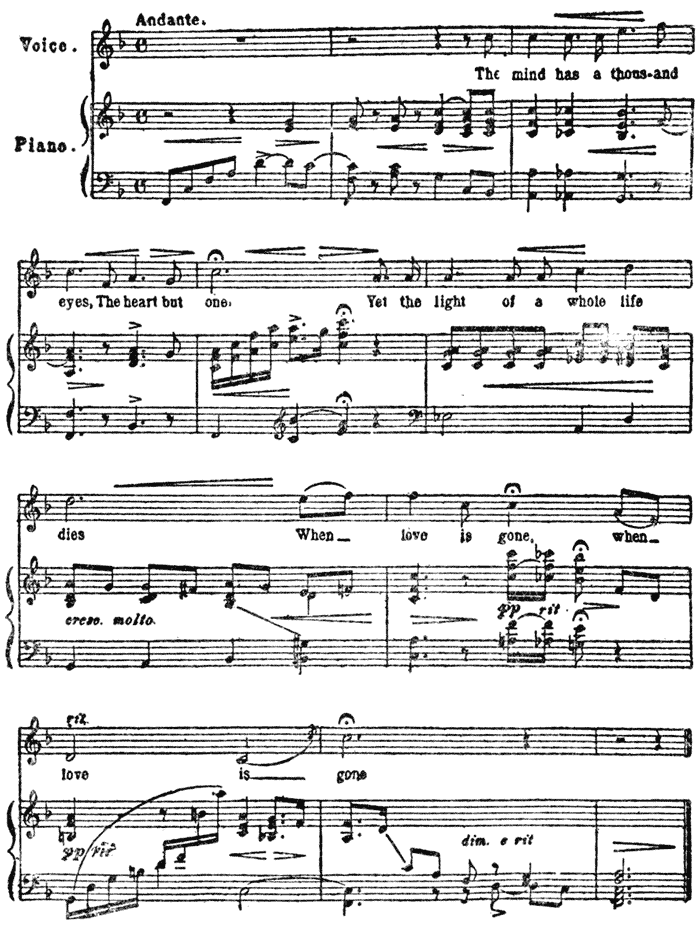
Copyright, 1894, by G. Schirmer.
The mind has a thousand eyes,
The heart but one;
Yet the light of a whole life dies
When love is gone, when love is gone.
To the stencil-plate chivalry of the lyrics
of the ubiquitous F.E. Weatherby and John
Oxenford, the song-status of England can
blame a deal of its stagnation. It is not often
that these word-wringers have enticed
331American
composers. One of the few victims is
John Hyatt Brewer, who was born in Brooklyn,
in 1856, and has lived there ever since.
Brewer made his début as a six-year-old
singer, and sang till his fourteenth year.
A year later he was an organist in Brooklyn,
where he has held various positions in the
same capacity ever since, additionally busying
himself as a teacher of voice, piano, organ,
and harmony. His studies in piano and harmony
were pursued under Rafael Navarro.
Counterpoint, fugue, and composition he
studied under Dudley Buck.
In 1878 Brewer became the second tenor
and accompanist of the Apollo Club, of which
Mr. Buck is the director. He has conducted
numerous vocal societies and an amateur
orchestra.
Of his cantatas, "Hesperus" is a work of
the greatest promise and large performance.
For male voices Brewer has written a cantata
called "The Birth of Love." Its fiery
332
ending is uncharacteristic, but the beautiful
tenor solo and an excellent bass song prove
his forte to lie in the realm of tenderness.
Brewer's music has little fondness for climaxes,
but in a tender pathos that is not
tragedy, but a sort of lotos-eater's dreaminess
and regret, he is congenially placed.
Smoothness is one of his best qualities.
Out of a number of part songs for men,
one should mark a vigorous "Fisher's Song,"
a "May Song," which has an effective "barber's
chord," and "The Katydid," a witty
realization of Oliver Wendell Holmes' captivating
poem. His "Sensible Serenade" has
also an excellent flow of wit. Both these
songs should please glee clubs and their
audiences.
For women's voices Brewer has written
not a little. The best of these are "Sea
Shine," which is particularly mellow, and
"Treachery," a love-scherzo.
For the violin there are two pieces: one,
333
in the key of D, is a duet between the violin
and the soprano voice of the piano. It is
full of characteristic tenderness, full even of
tears. It should find a good place among
those violin ballads of which Raff's Cavatina
is the best-known example. Another violin
solo in A is more florid, but is well managed.
The two show a natural aptitude for composition
for this favorite of all instruments.
For full orchestra there is a suite, "The
Lady of the Lake," also arranged, for piano
and organ. It is smooth and well-tinted. A
sextet for strings and flute has been played
with favor.
Brewer's chief success lies along lines of
least resistance, one might say. His Album
of Songs (op. 27) is a case in point. Of the
subtle and inevitable "Du bist wie eine
Blume," he makes nothing, and "The Violet"
forces an unfortunate contrast with
Mozart's idyl to the same words. But
"Meadow Sweet" is simply iridescent with
334
cheer, a most unusually sweet song, and
"The Heart's Rest" is of equal perfection.
The best-abused composer in America is
doubtless Reginald de Koven. His great
popularity has attracted the search-light of
minute criticism to him, and his accomplishments
are such as do not well endure the
fierce white light that beats upon the throne.
The sin of over-vivid reminiscence is the
one most persistently imputed to him, and
not without cause. While I see no reason to
accuse him of deliberate imitation, I think he
is a little too loth to excise from his music
those things of his that prove on consideration
to have been said or sung before him.
Instead of crying, "Pereant qui ante nos
nostra cantaverunt," he believes in a live-and-let-live
policy. But ah, if De Koven
were the only composer whose eraser does
not evict all that his memory installs!
De Koven was born at Middletown, Conn.,
in 1859, and enjoyed unusual advantages for
335
musical study abroad. At the age of eleven,
he was taken to Europe, where he lived for
twelve years. At Oxford he earned a degree
with honors. His musical instructors include
Speidel, Lebert, and Pruckner, at Stuttgart,
Huff the contrapuntist at Frankfort, and
Vannucini, who taught him singing, at Florence.
He made also a special study of light
opera under Genée and Von Suppé. He
made Chicago his home in 1882, afterward
moving to New York, where he served as
a musical critic on one of the daily papers for
many years.
De Koven has been chief purveyor of
comic opera to his generation, and for so
ideal a work as "Robin Hood," and such
pleasing constructions as parts of his other
operas ("Don Quixote," "The Fencing Master,"
"The Highwayman," for instance), one
ought to be grateful, especially as his music
has always a certain elegance and freedom
from vulgarity.
336
Of his ballads, "Oh, Promise Me" has a
few opening notes that remind one of
"Musica Proibita," but it was a taking
lyric that stuck in the public heart. His
setting of Eugene Field's "Little Boy Blue"
is a work of purest pathos and directness.
His version of "My Love is Like a Red,
Red Rose" is among the best of its countless
settings, and "The Fool of Pamperlune,"
the "Indian Love Song," "In June,"
and a few others, are excellent ballad-writing.
Victor Harris is one of the few that selected
New York for a birthplace. He was
born here April 27, 1869, and attended the College
of the City of New York, class of 1888.
For several of his early years he was well
known as a boy-soprano, whence he graduated
into what he calls the "usual career"
of organist, pianist, and teacher of the voice.
In 1895 and 1896 he acted as the assistant
conductor to Anton Seidl in the Brighton
337
Beach summer concerts. He learned harmony
of Frederick Schilling.
Harris is most widely known as an accompanist,
and is one of the best in the country.
But while the accompaniments he writes to
his own songs are carefully polished and well
colored, they lack the show of independence
that one might expect from so unusual a
master of their execution.
Except for an unpublished one-act operetta,
"Mlle. Maie et M. de Sembre," and a few
piano pieces, Harris has confined himself
to the writing of short songs. In his twenty-first
year two of unequal merits were published,
"The Fountains Mingle with the
River" being a taking melody, but without
distinction or originality, while "Sweetheart"
has much more freedom from conventionality
and inevitableness.
A later song, "My Guest," shows an increase
in elaboration, but follows the florid
school of Harrison Millard's once so popu338lar
rhapsody, "Waiting." Five songs are
grouped into opus 12, and they reach a much
higher finish and a better tendency to make
excursions into other keys. They also show
two of Harris' mannerisms, a constant repetition
of verbal phrases and a fondness for
writing close, unbroken chords, in triplets or
quartoles. "A Melody" is beautiful; "Butterflies
and Buttercups" is the perfection of
grace; "I Know not if Moonlight or Starlight"
is a fine rapture, and "A Disappointment"
is a dire tragedy, all about some
young toadstools that thought they were
going to be mushrooms. For postlude two
measures from the cantabile of Chopin's
"Funeral March" are used with droll effect.
"Love, Hallo!" is a headlong springtime
passion. Two of his latest songs are "Forever
and a Day," with many original touches,
and a "Song from Omar Khayyám," which is
made of some of the most cynical of the tent-maker's
quatrains. Harris has given them340all
their power and bitterness till the last
line, "The flower that once has blown forever
dies," which is written with rare beauty.
"A Night-song" is possibly his best work;
it is full of colors, originalities, and lyric
qualities. Opus 13 contains six songs:
"Music when Soft Voices Die" has many
uncommon and effective intervals; "The
Flower of Oblivion" is more dramatic than
usual, employs discords boldly, and gives the
accompaniment more individuality than before;
"A Song of Four Seasons" is a
delicious morsel of gaiety, and "Love within
the Lover's Breast" is a superb song. Harris
has written some choric works for men
and women also. They show commendable
attention to all the voice parts.
To N.N.H.
Song from Omar Khayyám.
[Listen]
VICTOR HARRIS, Op. 16, No. 3.
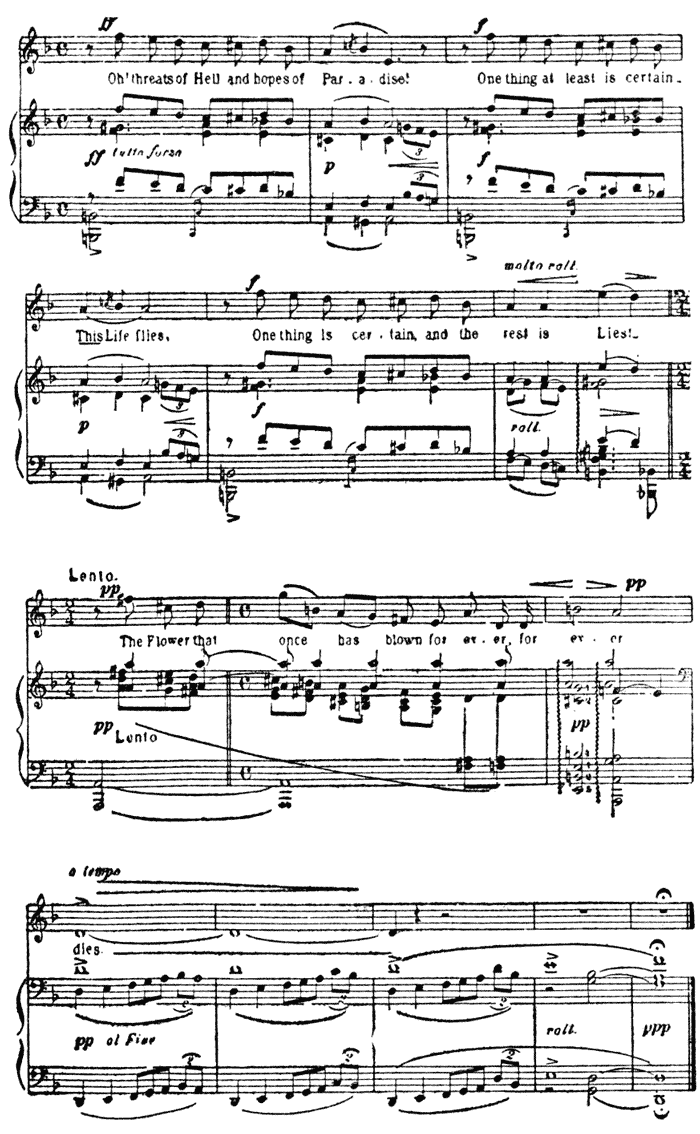
Copyright, 1898, by Edward Schuberth & Co.
Oh! threats of Hell and hopes of Paradise!
One thing at least is certain—
This Life flies,
One thing is certain, and the rest is Lies!
The Flower that once has blown for ever, for ever dies.
One of the most prominent figures in
American musical history has been Dr. William
Mason. He was born in Boston, January
24, 1829, and was the son of Lowell
Mason, that pioneer in American composition.
341
Dr. William Mason studied in Boston, and in
Germany under Moscheles, Hauptmann,
Richter, and Liszt. His success in concerts
abroad and here gave prestige to his philosophy
of technic, and his books on method
have taken the very highest rank.
His pedagogical attainments have overshadowed
his composition, but he has written
some excellent music. As he has been an
educational force in classical music, so his
compositions show the severe pursuit of classic
forms and ideas. His work is, therefore,
rather ingenious than inspired, and intellectual
rather than emotional. Yale made him
Doctor of Music in 1872.
Another composer whose studies in technic
have left him only a little inclination for creation
is Albert Ross Parsons, who was born at
Sandusky, O., September 16, 1847. He
studied in Buffalo, and in New York under
Ritter. Then he went to Germany, where
he had a remarkably thorough schooling
342
under Moscheles, Reinecke, Richter, Paul,
Taussig, Kullak, and others. Returning to
this country, he has busied himself as organist,
teacher, and an editor of musical works.
What little music he has composed shows the
fruit of his erudition in its correctness.
Such men as Doctor Mason and Mr. Parsons,
though they add little to the volume of
composition,—a thing for which any one
should be thanked on some considerations,—yet
add great dignity to their profession in
this country.
Arthur, a younger brother of Ethelbert
Nevin, shows many of the Nevinian traits of
lyric energy and harmonic color in his songs.
He was born at Sewickley, Pa., in 1871. Until
he was eighteen he had neither interest nor
knowledge in music. In 1891 he began a
four years' course in Boston, going thence to
Berlin, where his masters were Klindworth
and Boise. A book of four graceful "May
Sketches" has been published, "Pierrot's
343
Guitar" being especially ingenious. There
are two published songs, "Were I a Tone"
and "In Dreams," both emotionally rich. In
manuscript are a fine song, "Free as the
Tossing Sea," and a well-devised trio.
A successful writer of songs is C. Whitney
Coombs. He was born in Maine, in 1864,
and went abroad at the age of fourteen.
He studied the piano with Speidel, and composition
with Seiffritz, in Stuttgart, for five
years, and pursued his studies later in Dresden
under Draessecke, Janssen, and John.
In 1887 he became organist at the American
Church in that city, returning to America
in 1891, since which time he has been an
organist in New York.
In 1891 his publication begins with "My
Love," an excellent lilt on lines from the
Arabian. Among his many songs a few
should be noted: the "Song of a Summer
Night" is brilliant and poetic, and "Alone"
is marked by some beautiful contramelodic
344
effects; his "Indian Serenade" is a gracious
work.
J. Remington Fairlamb has been a prolific
composer. He was born at Philadelphia, and
at fourteen was a church organist. He
studied at the Paris Conservatoire and in
Italy; was appointed consul at Zurich by
President Lincoln, and while in Stuttgart
was decorated by the King of Wurtemburg
with the "Great Gold Medal of Art and
Science" for a Te Deum for double chorus
and orchestra. Of Fairlamb's compositions,
some two hundred have been published,
including much sacred music and parts of
two operas. A grand opera, "Leonello," in
five acts, and a mass are in manuscript.
Frank Seymour Hastings has found in
music a pleasant avocation from finance, and
written various graceful songs. He has been
active, too, in the effort to secure a proper
production of grand opera in English.
Dr. John M. Loretz, of Brooklyn, is a
345
veteran composer, and has passed his opus
200. He has written much sacred music
and several comic operas.
A prominent figure in New York music,
though only an occasional composer, is Louis
Raphael Dressler, one of the six charter
members of the Manuscript Society, and long
its treasurer. His father was William Dressler,
one of the leading musicians of the
earlier New York, where Mr. Dressler was
born, in 1861. Dressier studied with his
father, and inherited his ability as a professional
accompanist and conductor. He was
the first to produce amateur performances of
opera in New York. His songs are marked
with sincerity and spontaneity.
Richard Henry Warren has been the organist
at St. Bartholomew's since 1886, and
the composer of much religious music in
which both skill and feeling are present.
Among his more important works are two
complete services, a scene for barytone
346
solo, male chorus, and orchestra, called "Ticonderoga,"
and a powerful Christmas anthem.
Warren has written also various operettas, in
which he shows a particular grasp of instrumentation,
and an ability to give new turns
of expression to his songs, while keeping
them smooth and singable. An unpublished
short song of his, "When the Birds Go North,"
is a remarkably beautiful work, showing an
aptitude that should be more cultivated.
Warren was born at Albany, September
17, 1859. He is a son and pupil of George
W. Warren, the distinguished organist. He
went to Europe in 1880, and again in 1886,
for study and observation. He was the organizer
and conductor of the Church Choral
Society, which gave various important religious
works their first production in New
York, and, in some cases, their first hearing
in America, notably, Dvôrák's Requiem Mass,
Gounod's "Mors et Vita," Liszt's Thirteenth
Psalm, Saint-Saëns' "The Heavens Declare,"
347
Villiers Stanford's "God is Our Hope and
Strength," and Mackenzie's "Veni, Creator
Spiritus." Horatio Parker's "Hora Novissima"
was composed for this society, and
Chadwick's "Phœnix Expirans" given its
first New York performance.
A prominent organist and teacher is Smith
N. Penfield, who has also found time for the
composition of numerous scholarly works,
notably, an overture for full orchestra, an
orchestral setting of the eighteenth psalm, a
string quartette, and many pieces for the
organ, voice, and piano. His tuition has been
remarkably thorough. Born in Oberlin,
Ohio, April 4, 1837, he studied the piano
in Germany with Moscheles, Papperitz, and
Reinecke, the organ with Richter, composition,
counterpoint, and fugue with Reinecke
and Hauptmann. He had also a period of
study in Paris.
Another organist of distinction is Frank
Taft, who is also a conductor and a composer.
348
His most important work is a "Marche Symphonique,"
which was performed by the Boston
Symphony Orchestra. He was born in
East Bloomfield, New York, and had his
education entirely in this country, studying
the organ with Clarence Eddy, and theory
with Frederic Grant Gleason.
A young composer of many graceful songs
is Charles Fonteyn Manney, who was born
in Brooklyn in 1872, and studied theory with
William Arms Fisher in New York, and later
with J. Wallace Goodrich at Boston. His
most original song is "Orpheus with His
Lute," which reproduces the quaint and fascinating
gaucheries of the text with singular
charm. He has also set various songs of
Heine's to music, and a short cantata for
Easter, "The Resurrection."
An ability that is strongly individual is
that of Arthur Farwell, whose first teacher
in theory was Homer A. Norris, and who
later studied under Humperdinck in Ger349many.
Among his works are an elaborate
ballade for piano and violin, a setting of
Shelley's "Indian Serenade," and four folk-songs
to words by Johanna Ambrosius, the
peasant genius of Germany. Among others
of his published songs is "Strow Poppy
Buds," a strikingly original composition.
A writer of numerous elegant trifles and
of a serious symphony is Harry Patterson
Hopkins, who was born in Baltimore, and
graduated at the Peabody Institute in 1896,
receiving the diploma for distinguished musicianship.
The same year he went to
Bohemia, and studied with Dvôrák. He
returned to America to assist in the production
of one of his compositions by Anton
Seidl.
Very thorough was the foreign training of
Carl V. Lachmund, whose "Japanese Overture"
has been produced under the direction
of Thomas and Seidl, in the former case at a
concert of that society at which many impor350tant
native works have had their only hearing,
the Music Teachers' National Association.
Lachmund was born at Booneville, Mo., in
1854. At the age of thirteen he began his
tuition at Cologne, under Heller, Jensen, and
Seiss; later he went to Berlin to study
with the Scharwenkas, Kiel, and Moskowski.
He had also four years of Liszt's training at
Weimar. A trio for harp, violin, and 'cello
was played by the Berlin Philharmonic Orchestra,
and a concert prelude for the piano
was much played in concerts in Germany.
Before returning to America, Lachmund was
for a time connected with the opera at
Cologne.
The Boston Colony.
To the composer potentially a writer of
grand operas, but barred out by the absolute
lack of opening here, the dramatic ballad
should offer an attractive form. Such works
as Schubert's "Erl-King" show what can be
351
done. Henry Holden Huss has made some
interesting experiments, and Fred. Field
Bullard has tried the field.
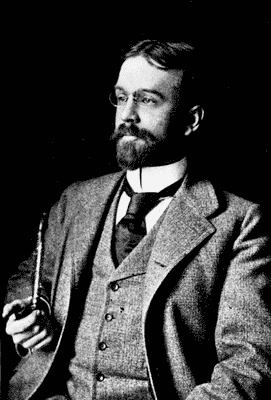
FREDERICK FIELD BULLARD.
Bullard's setting of Tennyson's almost lurid
melodrama in six stanzas, "The Sisters," has
caught the bitter mixture of love and hate,
and avoided claptrap climaxes most impressively.
"In the Greenwood" (op. 14) is graceful,
and "A June Lullaby" has a charming accompaniment
of humming rain. Bullard has
set some of Shelley's lyrics for voice and
harp or piano, in opus 17. "From Dreams of
Thee" gets a delicious quaintness of accompaniment,
while the "Hymn of Pan" shows
a tremendous savagery and uncouthness, with
strange and stubborn harmonies. Full of the
same roborific virility are his settings to the
songs of Richard Hovey's writing, "Here's a
Health to Thee, Roberts," "Barney McGee,"
and the "Stein Song." These songs have
an exuberance of the roistering spirit, along354
with a competence of musicianship that lifts
them above any comparison with the average
balladry. Similarly "The Sword of Ferrara,"
with its hidalgic pride, and "The Indifferent
Mariner," and the drinking-song, "The
Best of All Good Company," are all what
Horace Greeley would have called "mighty
interesting." Not long ago I would have
wagered my head against a hand-saw, that no
writer of this time could write a canon with
spontaneity. But then I had not seen Bullard's
three duets in canon form. He has
chosen his words so happily and expressed
them so easily, and with such arch raillery,
that the duets are delicious. Of equal gaiety
is "The Lass of Norwich Town," which,
with its violin obbligato, won a prize in the
Musical Record competition of 1899.
HYMN OF PAN.
[Listen]
Words by
PERCY BYSSHE SHELLEY.
|
|
Music by
FRED. FIELD BULLARD,
Op. 17, No. 4.
|
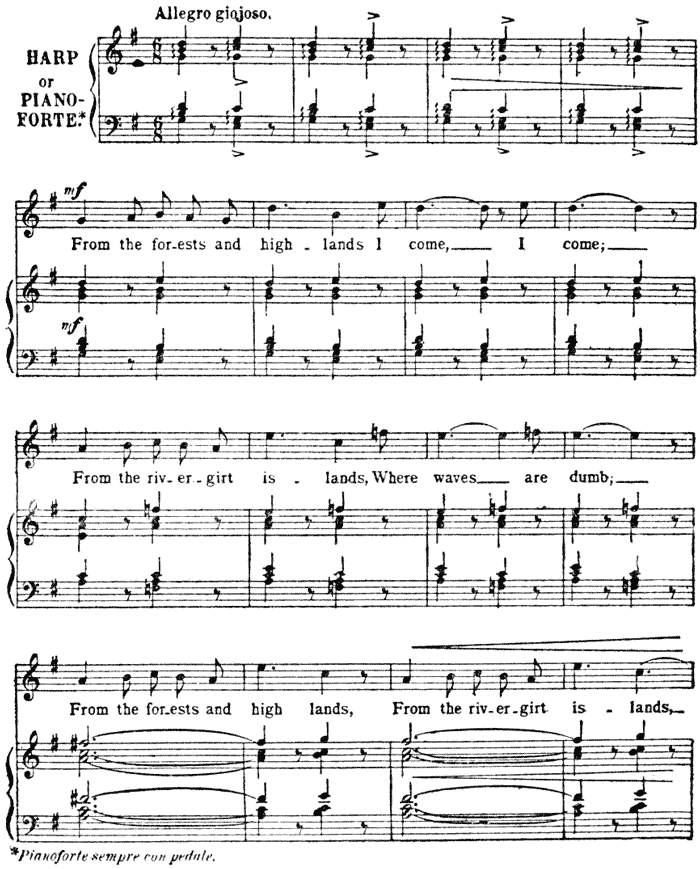
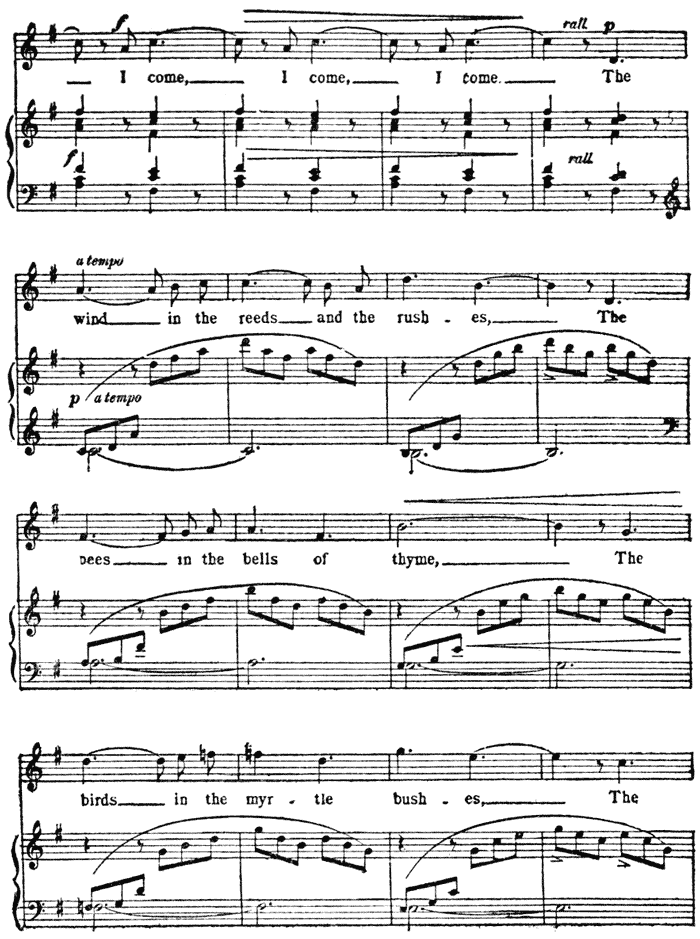
Copyright, 1894, by Miles & Thompson.
From the forests and highlands I come, I come;
From the river-girt islands,
Where waves are dumb;
From the forests and highlands,
From the river-girt islands,
I come, I come, I come.
The wind in the reeds and the rushes,
The bees in the bells of thyme,
The birds in the myrtle bushes,
The....
A FRAGMENT.
Bullard was born at Boston, in 1864. He
studied chemistry at first, but the claims
of music on his interest were too great, and
in 1888 he went to Munich, where he studied
355
with Josef Rheinberger. After four years of
European life he returned to Boston, where
he has taught harmony and counterpoint
along rather original lines. He is a writer
with ideas and resources that give promise
of a large future. His scholarship has not
led him away from individuality. He is
especially likely to give unexpected turns
of expression, little bits of programmism
rather incompatible with the ballad form
most of his songs take. The chief fault with
his work is the prevailing dun-ness of his
harmonies. They have not felt the impressionistic
revolt from the old bituminous school.
But in partial compensation for this bleakness
is a fine ruggedness.
Of his other published songs, "At Daybreak"
shows a beautiful fervor of repression.
"On the Way" is redeemed by a
particularly stirring finish. In opus 8, "A
Prayer" is begun in D minor and ended
in D major, with a strong effect of sudden
356
exaltation from gloom. "The Singer" begins
also in sombre style with unusual
and abrupt modulations, and ends in a bright
major. "The Hermit" is likewise grim,
but is broad and deep. It uses a hint of
"Old Hundred" in the accompaniment.
Opus 11 couples two dramatic ballads.
In this form of condensed drama is a too-little
occupied field of composition, and Bullard
has written some part songs, of which "In
the Merry Month of May," "Her Scuttle
Hat," and "The Water Song" are worth
mentioning. "O Stern Old Land" is a rather
bathetic candidate for the national hymnship.
But his "War Song of Gamelbar," for male
voices, is really a masterwork. Harmonists
insist on so much closer compliance with
rules for smoothness in vocal compositions
than in instrumental work, that the usual
composer gives himself very little liberty
here. Bullard, however, has found the right
occasion for wild dissonances, and has dared
357
to use them. The effect is one of terrific
power. This, his "Song of Pan" and "The
Sisters" give him a place apart from the rest
of native song-writers.
With all reverence for German music, it
has been too much inclined of late to domineer
the rest of the world, especially America.
A useful counter-influence is that of
Homer A. Norris, who has stepped out of
the crowd flying to Munich and neighboring
places, and profited by Parisian harmonic
methods.
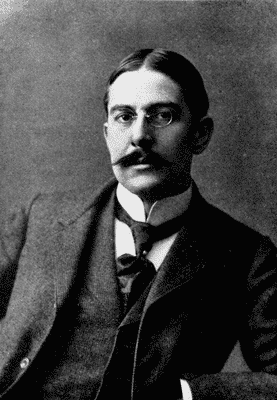
HOMER A. NORRIS.
His book, "Practical Harmony," imparts a,
to us, novel method of disarming the bugaboo
of altered chords of many of its notorious
terrors. He also attacks the pedantry of
music "so constructed that it appeals to the
eye rather than the ear,—paper-work," a
most praiseworthy assault on what is possibly
the heaviest incubus on inspiration. In a
later work on "Counterpoint" he used for
chapter headings Greek vases and other
358
decorative designs, to stimulate the ideal of
counterpoint as a unified complexity of graceful
contours.
Norris was born in Wayne, Me., and became
an organist at an early age. His chief
interest has been, however, in the theory of
music, and he studied with G.W. Marston,
F.W. Hale, and G.W. Chadwick, as well as
Emery. In deciding upon foreign study he
was inspired to choose France instead of Germany.
This has given him a distinct place.
After studying in Paris for four years
under Dubois, Godard, Guilmant, and Gigout,
he made his home in Boston, where he has
since confined himself to the teaching of
composition.
As yet Mr. Norris has composed little,
and that little is done on simple lines, but
the simplicity is deep, and the harmonies,
without being bizarre, are wonderfully mellow.
His first song, "Rock-a-bye, Baby," he sold
for twelve printed copies, and it is said to
359
have had a larger sale than any cradle-song
ever published in this country. His song,
"Protestations," is tender, and has a violin
obbligato that is really more important than
the voice part. The song, "Parting," is wild
with passion, and bases a superb melody on
a fitting harmonic structure. I consider
"Twilight" one of the best American songs.
It gets some unusual effects with intervals
of tenths and ninths, and shows a remarkable
depth of emotion.
In the larger forms he has done a concert
overture, "Zoroaster" (which, judging from
an outline, promises many striking effects),
and a cantata, "Nain," which has the sin of
over-repetition of words, but is otherwise
marked with telling pathos and occasional
outbursts of intensely dramatic feeling.
Perhaps his most original work is seen in
his book of "Four Songs for Mezzo-Voice."
The first is Kipling's "O Mother Mine," with
harshnesses followed by tenderest musings;
360
the second is a noble song, "Peace," with an
accompaniment consisting entirely of the
slowly descending scale of C major; a high-colored
lilt, "The World and a Day," is followed
by a Maeterlinckian recitative of the
most melting pathos. This book is another
substantiation of my belief that America is
writing the best of the songs of to-day.
Peace.
[Listen]
Edward Rowland Sill.Homer A. Norris.
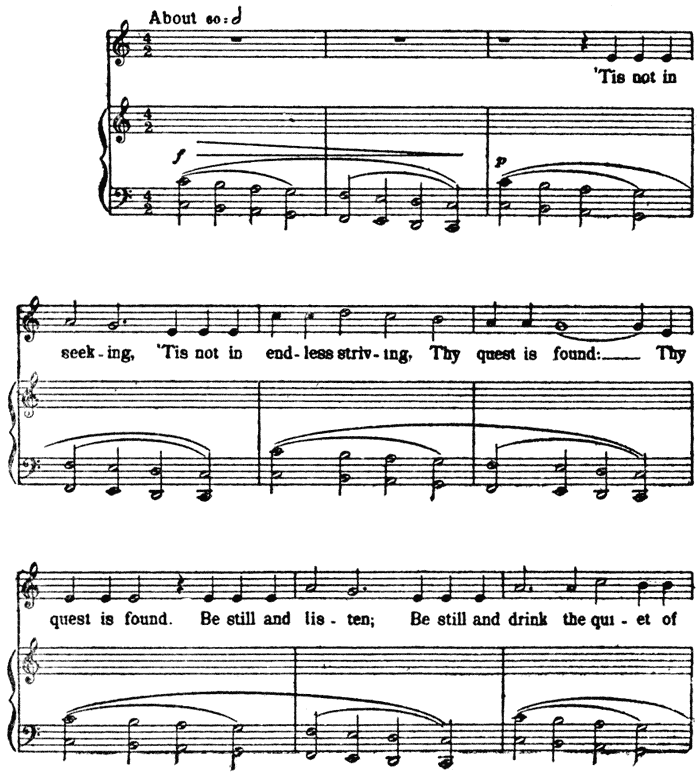
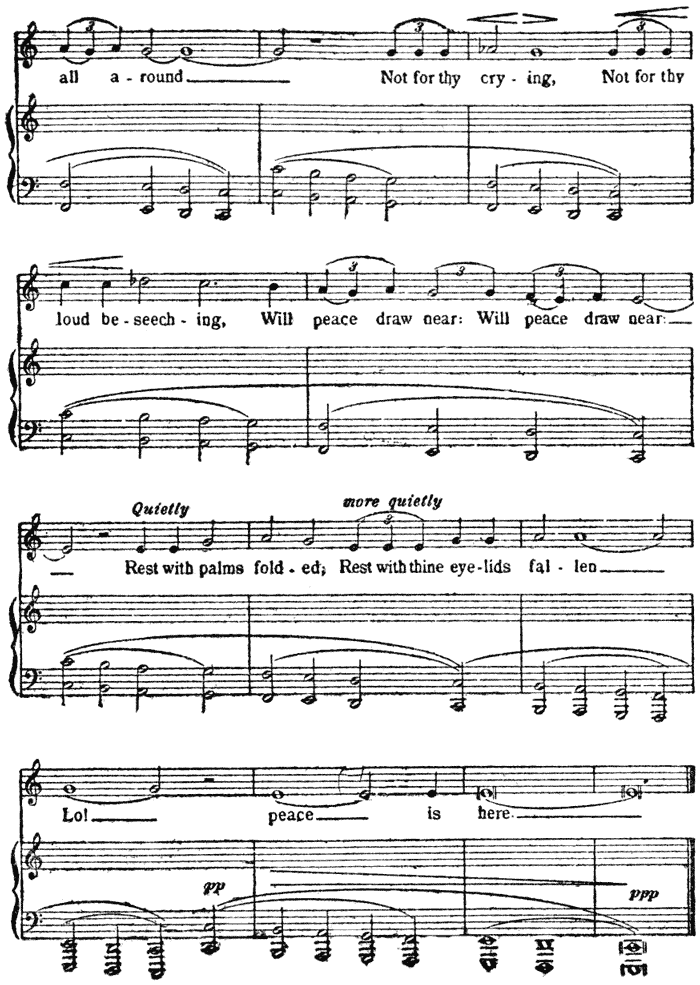
Copyright, 1900, by H.B. Stevens Co. International copyright secured.
Used by permission of H.B. Stevens Co., Boston, owners of the copyright.
'Tis not in seeking,
'Tis not in endless striving,
Thy quest is found:
Thy quest is found.
Be still and listen;
Be still and drink the quiet of all around
Not for thy crying,
Not for thy loud beseeching,
Will peace draw near:
Will peace draw near:
Rest with palms folded,
Rest with thine eyelids fallen
Lo! peace is here.
One of the best-esteemed musicians in
Boston, G.E. Whiting has devoted more of his
interest to his career as virtuoso on the
organ than to composition. Not many of
such works as he has found time to write
have been printed. These include an organ
sonata, a number of organ pieces, a book of
studies for the organ, six songs, and three
cantatas for solos, chorus, and orchestra, "A
Tale of the Viking," "Dream Pictures," and
"A Midnight Cantata."
Whiting was born at Holliston, Mass.,
September 14, 1842. At the age of five, he
began the study of music with his brother.
361
At the age of fifteen, he moved to Hartford,
Conn., where he succeeded Dudley Buck as
organist of one of the churches. Here he
founded the Beethoven Society. At the age
of twenty he went to Boston, and after
studying with Morgan, went to Liverpool,
and studied the organ under William Thomas
Best. Later he made a second pilgrimage
to Europe, and studied under Radeck.
For many years he has lived in Boston as
a teacher of music and performer upon the
organ. In manuscript are a number of works
which I have not had the privilege of seeing:
two masses for chorus, orchestra, and organ,
a concert overture, a concerto, a sonata, a
fantasy and fugue, a fantasy and three études,
a suite for 'cello and piano, and a setting of
Longfellow's "Golden Legend," which won
two votes out of five in the thousand dollar
musical festival of 1897, the prize being
awarded to Dudley Buck.
Of his compositions H.E. Krehbiel in364
1892 recorded the opinion that they "entitled
him to a position among the foremost musicians
in this country." He is an uncle of
Arthur Whiting.
G.W. Marston's setting of the omnipresent
"Du bist wie eine Blume" is really one of the
very best Heine's poem has ever had. Possibly
it is the best of all the American settings.
His "There Was an Aged Monarch" is seriously
deserving of the frankest comparison
with Grieg's treatment of the same Lied. It
is interesting to note the radical difference of
their attitudes toward it. Grieg writes in a
folk-tone that is severe to the point of grimness.
He is right because it is ein altes Liedchen,
and Heine's handling of it is also kept
outwardly cold. But Marston has rendered
the song into music of the richest harmony
and fullest pathos. He is right, also, because
he has interpreted the undercurrent of the
story.
Bodenstedt's ubiquitous lyric, "Wenn der
365
Frühling auf die Berge steigt," which rivals
"Du bist wie eine Blume" in the favor of
composers, has gathered Marston also into
its net. He gives it a climax that fairly
sweeps one off his feet, though one might
wish that the following and final phrase had
not forsaken the rich harmonies of the climax
so completely.
This song is the first of a "Song Album"
for sopranos, published in 1890. In this
group the accompaniments all receive an
attention that gives them meaning without
obtrusiveness. "The Duet" is a delicious
marriage of the song of a girl and the accompanying
rapture of a bird.
A captivating little florid figure in the
accompaniment of a setting of "Im wunder-schönen
Monat Mai" gives the song worth.
"On the Water" is profound with sombreness
and big simplicity. "The Boat of My
Lover" is quaintly delightful.
Marston was born in Massachusetts, at the
366
little town of Sandwich, in 1840. He studied
there, and later at Portland, Me., with John
W. Tufts, and has made two pilgrimages to
Europe for instruction. He played the organ
in his native town at the age of fifteen, and
since finishing his studies has lived at Portland,
teaching the piano, organ, and harmony.
From the start his songs caught popularity,
and were much sung in concert.
Marston has written a sacred dramatic
cantata, "David," and a large amount of
church music that is very widely used.
He has written also a set of quartettes and
trios for women's voices, and quartettes for
men's voices.
Possibly his best-known song has been his
"Could Ye Come Back to Me, Douglas,"
which Mrs. Craik called the best of all her
poem's many settings.
Only Marston's later piano pieces are really
klaviermässig. So fine a work as his "Gavotte
in B Minor" has no need to consider the 367
resources of the modern instrument. It has
a color scheme of much originality, though
it is marred by over-repetition. "A Night
in Spain" is a dashing reminiscence, not
without Spanish spirit, and an "Album
Leaf" is a divertissement of contagious enthusiasm.
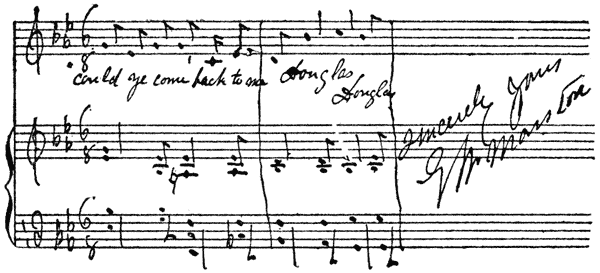
Ariel's songs, from "The Tempest," are
given a piano interpretation that reaches a
high plane. There is a storm prologue which
suggests, in excellent harmonies, the distant
mutter of the storm rather than a piano-gutting
tornado. "Full Fathoms Five Thy
Father Lies" is a reverie of wonderful depth
and originality, with a delicious variation on
368
the good old-fashioned cadence. Thence it
works up into an immensely powerful close.
A dance, "Foot it Featly," follows. It is
sprightly, and contains a fetching cadenza.
One of the most prolific writers of American
song is Clayton Johns. He is almost
always pleasing and polished. While
he is not at all revolutionary, he has a certain
individuality of ease, and lyric quality
without storm or stress of passion. Thus
his settings of seven "Wanderlieder" by
Uhland have all the spirit of the road except
ruggedness.
His setting of "Du bist wie eine Blume"
is extremely tender and sweet.
Two of Johns' best successes have been
settings of Egyptian subjects: "Were I a
Prince Egyptian" and Arlo Bates' fine lyric,
"No Lotus Flower on Ganges Borne." The
latter is a superb song of unusual fire, with
a strong effect at the end, the voice ceasing
at a deceptive cadence, while the accompani369ment
sweeps on to its destiny in the original
key. He has also found a congenial subject
in Austin Dobson's "The Rose and the Gardener."
He gets for a moment far from its
florid grace in "I Looked within My Soul,"
which has an unwonted bigness, and is a
genuine Lied.
In later years Johns' songs have been
brought out in little albums, very artistically
got up, especially for music (which has been
heinously printed, as a rule, in this country).
These albums include three skilfully written
"English Songs," and three "French
Songs," "Soupir" taking the form of melodic
recitative. Opus 19 is a group of "Wonder
Songs," which interpret Oliver Herford's
quaint conceits capitally.
Opus 26 collects nine songs, of which
"Princess Pretty Eyes" is fascinatingly archaic.
It is good to see him setting two
such remotely kindred spirits as Herrick and
Emily Dickinson. The latter has hardly been
370
discovered by composers, and the former is
too much neglected.
Johns has also written a few part songs
and some instrumental works, which maintain
his characteristics. A delightful "Canzone,"
a happy "Promenade," and "Mazurka" are
to be mentioned, and a number of pieces
for violin and piano, among them a finely
built intermezzo, a berceuse, a romanza that
should be highly effective, and a witty scherzino.
He has written for strings a berceuse
and a scherzino, which have been played by
the Boston Symphony Orchestra, and certain
part songs, as well as a chorus for female
voices and string orchestra, have been sung
in London.
Johns was born at New Castle, Del., November
24, 1857, of American parents.
Though at first a student of architecture, he
gave this up for music, and studied at Boston
under Wm. F. Apthorp, J.K. Paine, and
W.H. Sherwood, after which he went to Ber371lin, where he studied under Kiel, Grabau,
Raif, and Franz Rummel. In 1884 he made
Boston his home.
If San Francisco had found some way of
retaining the composers she has produced,
she would have a very respectable colony.
Among the others who have come east to
grow up with music is William Arms Fisher,
who was born in San Francisco, April 27,
1861. The two composers from whom he
derives his name, Joshua Fisher and William
Arms, settled in Massachusetts colony in the
seventeenth century. He studied harmony,
organ, and piano with John P. Morgan. After
devoting some years to business, he committed
his life to music, and in 1890 came to New York,
where he studied singing. Later he
went to London to continue his vocal studies.
Returning to New York, he took up counterpoint
and fugue with Horatio W. Parker, and
composition and instrumentation with Dvôrák.
After teaching harmony for several years, he
372
went to Boston, where he now lives. His
work has been almost altogether the composition
of songs. A notable feature of his
numerous publications is their agreeable diversion
from the usual practice of composers,
which is to write lyrics of wide range and
high pitch. Nearly all his songs are written
for the average voice.
His first opus contains a setting of "Nur
wer die Sehnsucht kennt," which I like better
than the banal version Tschaïkowski made of
the same words. The third opus contains three
songs to Shelley's words. They show something
of the intellectual emotion of the poet.
The first work, "A Widow Bird Sate Mourning,"
is hardly lyrical; "My Coursers Are Fed
with the Lightning" is a stout piece of writing,
but the inspired highfalutin of the words
would be trying upon one who arose to sing
the song before an audience. This, by the
way, is a point rarely considered by the
unsuccessful composers, and the words which
373
the singer is expected to declare to an ordinary
audience are sometimes astounding. The
third Shelley setting, "The World's Wanderer,"
is more congenial to song.
Opus 5 is entitled "Songs without Tears."
These are for a bass voice, and by all odds the
best of his songs. An appropriate setting
is Edmund Clarence Stedman's "Falstaff's
Song," a noteworthy lyric of toss-pot moralization
on death. His song of "Joy" is exuberant
with spring gaiety, and some of his best
manner is seen in his "Elégie," for violin and
piano. He has also written a deal of church
song.
A venerable and distinguished teacher and
composer is James C.D. Parker, who was
born at Boston, in 1828, and graduated from
Harvard in 1848. He at first studied law,
but was soon turned to music, and studied
for three years in Europe under Richter,
Plaidy, Hauptmann, Moscheles, Rietz, and
Becker. He graduated from the conserva374tory
at Leipzig, and returned to Boston in
1845.
His "Redemption Hymn" is one of his
most important works, and was produced in
Boston by the Handel and Haydn Society
in 1877. He also composed other works for
orchestra and chorus, and many brilliant piano
compositions.
An interesting method of writing duets is
that employed in the "Children's Festival,"
by Charles Dennée. The pupil plays in some
places the primo, and in others the secondo,
his part being written very simply, while the
part to be played by the teacher is written
with considerable elaboration, so that the
general effect is not so narcotic as usual with
duets for children. Dennée has written,
among many works of little specific gravity, a
"Suite Moderne" of much skill, a suite for
string orchestra, an overture and sonatas
for the piano and for the violin and piano,
as well as various comic operas. He was
375
born in Oswego, N.Y., September 1, 1863,
and studied composition with Stephen A.
Emery.
A composer of a genial gaiety, one who
has written a good minuet and an "Evening
Song" that is not morose, is Benjamin Lincoln
Whelpley, who was born at Eastport, Me.,
October 23, 1863, and studied the piano at
Boston with B.J. Lang, and composition with
Sidney Homer and others. He also studied
in Paris for a time in 1890. He has written
a "Dance of the Gnomes," that is characteristic
and brilliantly droll, and a piano
piece, called "Under Bright Skies," which
has the panoply and progress of a sunlit
cavalcade.
Ernest Osgood Hiler has written some
good music for the violin, a book of songs for
children, "Cloud, Field, and Flower," and
some sacred music. He studied in Germany
for two years.
376
The Chicago Colony.
Most prominent among Chicago's composers
is doubtless Frederic Grant Gleason,
who has written in the large forms with distinguished
success. The Thomas Orchestra
has performed a number of his works, which
is an excellent praise, because Thomas, who
has done so much for American audiences,
has worried himself little about the American
composer. At the World's Fair, which
was, in some ways, the artistic birthday of
Chicago, and possibly the most important
artistic event in our national history, some of
Gleason's works were performed by Thomas'
organization, among them the Vorspiel to
an opera, "Otho Visconti" (op. 7), for which
Gleason wrote both words and music.
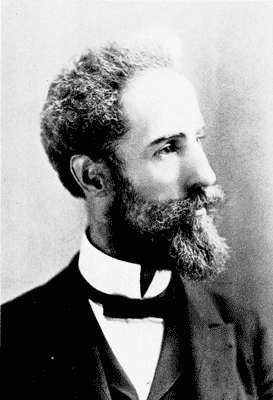
FREDERIC GRANT GLEASON.
This Vorspiel, like that to "Lohengrin," is
short and delicate. It begins ravishingly
with flutes and clarinets and four violins,
pianissimo, followed by a blare of brass.
After this introductory period the work runs
377
through tenderly contemplative musing to
the end, in which, again, the only strings are
the four violins, though here they are accompanied
by the brass and wood-winds and tympani,
the cymbals being gently tapped with
drumsticks. The introduction to the third
act of the opera is more lyrical, but not so
fine. Another opera is "Montezuma" (op.
16). Gleason is again his own librettist. Of
this opera I have been privileged to see
the complete piano score, and much of the
orchestral.
Montezuma, Act III, Introduction
[Listen]
Frederic Grant Gleason
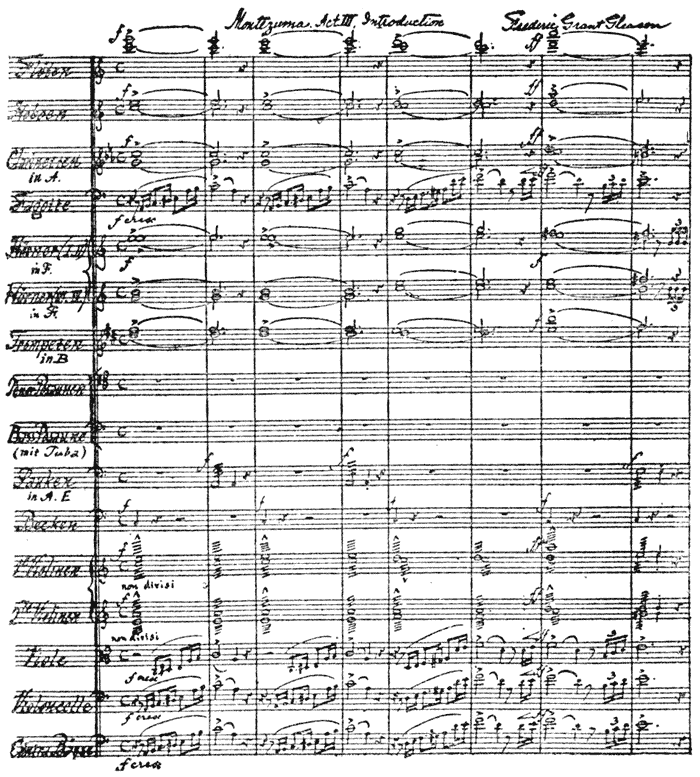
EXCERPT FROM AN ORCHESTRAL SCORE BY MR. GLEASON.
[Enlarge]
In the first act Guatemozin, who has
been exiled by Montezuma, appears disguised
as an ancient minstrel and sings prophetically
of the coming of a god of peace
and love to supplant the terrible idol that
demands human sacrifice. This superbly
written aria provokes from the terrified idolaters
a chorus of fear and reproach that is
strongly effective. The next act begins
with an elaborate aria followed by a love duet379
of much beauty. A heavily scored priests'
march is one of the chief numbers, and like
most marches written by the unco' learned,
it is a grain of martial melody in a bushel of
trumpet figures and preparation. The Wagnerian
leit-motif idea is adopted in this and
other works of his, and the chief objection to
his writing is its too great fidelity to the
Wagnerian manner,—notably in the use of
suspensions and passing-notes,—otherwise he
is a very powerful harmonist and an instrumenter
of rare sophistication. A soprano
aria with orchestral accompaniment has been
taken from the opera and sung in concert
with strong effect.
Another work played at the World's Fair
by Thomas, is a "Processional of the Holy
Grail." It is scored elaborately, but is rather
brilliant than large. It complimentarily introduces
a hint or two of Wagner's Grail
motif.
The symphonic poem, "Edris," was also
380
performed by the Thomas Orchestra. It is
based upon Marie Corelli's novel, "Ardath,"
which gives opportunity for much programmism,
but of a mystical highly colored
sort for which music is especially competent.
It makes use of a number of remarkably beautiful
motives. One effect much commented
upon was a succession of fifths in the bass,
used legitimately enough to express a dreariness
of earth.
This provoked from that conservative
of conservatives, the music copyist, a patronizing
annotation, "Quinten!" to which Gleason
added "Gewiss!" A series of augmented
triads, smoothly manipulated, was another
curiosity of the score.
Possibly Gleason's happiest work is his
exquisite music for that most exquisite of
American poems, "The Culprit Fay." It is
described in detail in Upton's "Standard
Cantatas," and liberally quoted from in Goodrich'
"Musical Analysis." While I have
381
seen both the piano and orchestral scores of
this work (op. 15), and have seen much
beauty in them, my space compels me to
refer the curious reader to either of these
most recommendable books.
Gleason has had an unusual schooling.
He was born in Middletown, Conn., in 1848.
His parents were musical, and when at sixteen
he wrote a small matter of two oratorios
without previous instruction, they put him to
study under Dudley Buck. From his tuition
he graduated to Germany, and to such teachers
as Moscheles, Richter, Plaidy, Lobe, Raif,
Taussig, and Weitzmann. He studied in
England after that, and returned again to
Germany. When he reappeared in America
he remained a while at Hartford, Conn.,
whence he went to Chicago in 1876. He has
lived there since, working at teaching and
composition, and acting as musical critic of
the Chicago Tribune. An unusually gifted
body of critics, dramatic, musical, and literary,382
has worked upon the Chicago newspapers,
and Gleason has been prominent among
them.
Among other important compositions of
his are a symphonic cantata, "The Auditorium
Festival Ode," sung at the dedication of
the Chicago Auditorium by a chorus of five
hundred; sketches for orchestra, a piano concerto,
organ music, and songs.
As is shown by the two or three vocal
works of his that I have seen, Gleason is less
successful as a melodist than as a harmonist.
But in this latter capacity he is gifted indeed,
and is peculiarly fitted to furnish forth with
music Ebling's "Lobgesang auf die Harmonie."
In his setting of this poem he has used a
soprano and a barytone solo with male chorus
and orchestra. The harmonic structure
throughout is superb in all the various virtues
ascribed to harmony. The ending is
magnificent.
A work completed December, 1899, for383
production by the Thomas Orchestra, is a
symphonic poem called "The Song of Life,"
with this motto from Swinburne:
"They have the night, who had, like us, the day;
We whom the day binds shall have night as they;
We, from the fetters of the light unbound,
Healed of our wound of living, shall sleep sound."
The first prominent musician to give a
certain portion of his program regularly to
the American composer, was William H.
Sherwood. This recognition from so distinguished
a performer could not but interest
many who had previously turned a deaf ear
to all the musical efforts of the Eagle. In
addition to playing their piano works, he
has transcribed numerous of their orchestral
works to the piano, and played them. In
short, he has been so indefatigable a laborer
for the cause of other American composers,
that he has found little time to write his own
ideas.384
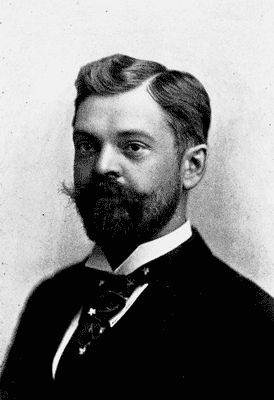
WILLIAM H. SHERWOOD.
Sherwood will be chiefly remembered as a
pianist, but he has written a certain amount
of music of an excellent quality. Opera 1-4
were published abroad. Opus 5 is a suite,
the second number of which is an "Idylle"
that deserves its name. It is as blissfully
clear and ringing as anything could well be,
and drips with a Theokritan honey. The
third number of the suite is called "Greetings."
It has only one or two unusual
touches. Number 4 bears the suggestive
title, "Regrets for the Pianoforte." It was
possibly written after some of his less
promising pupils had finished a lesson.
The last number of the suite is a quaint
Novelette.
IDYLLE.
[Listen]
WM. H. SHERWOOD, OP. 5, NO. 2.
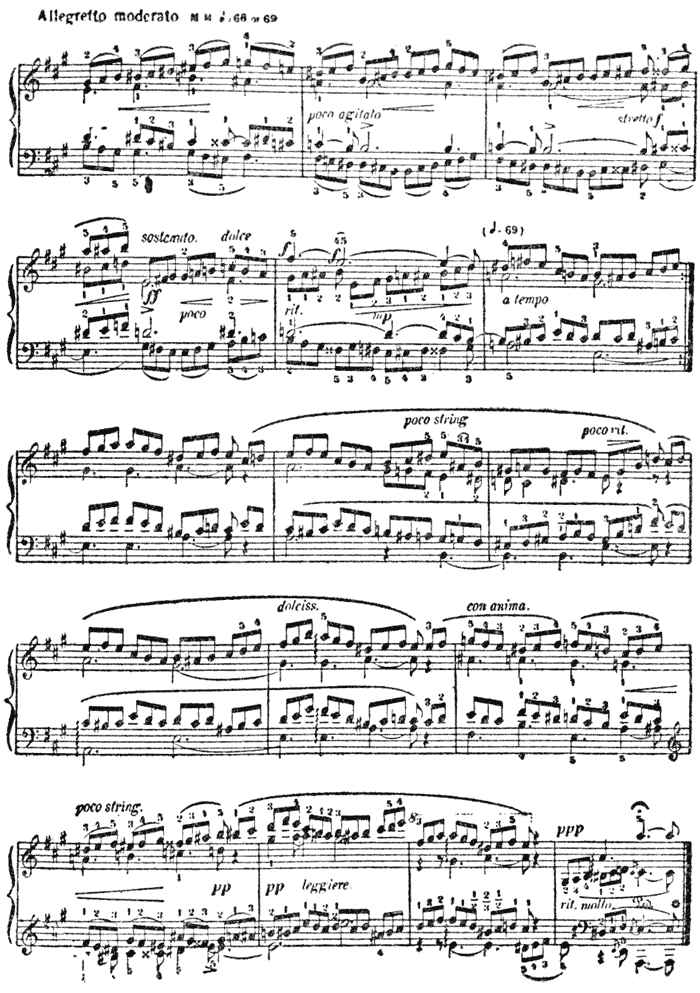
Copyright, 1883, by G. Schirmer.
A FRAGMENT.
Sherwood's sixth opus is made up of a
brace of mazurkas. The former, in C minor,
contains some of his best work. It is original
and moody, and ends strongly. The
second, in A major, is still better. It not
only keeps up a high standard throughout,386
but shows occasional touches of the most
fascinating art.
A scherzo (op. 7) cracks a few good
jokes, but is mostly elaboration. Opus 8 is
a fiery romanza appassionata. Opus 9 is a
Scherzo-Caprice. This is probably his best
work. It is dedicated to Liszt, and though
extremely brilliant, is full of meaning. It
has an interlude of tender romance. "Coy
Maiden" is a graceful thing, but hardly deserves
the punishment of so horrible a name.
"A Gypsy Dance" is too long, but it is of
good material. It has an interesting metre,
three-quarter time with the first note dotted.
There is a good effect gained by sustaining certain
notes over several measures, though few
pianists get a real sostenuto. An "Allegro
Patetico" (op. 12), "Medea" (op. 13), and a
set of small pieces (one of them a burlesque
called "A Caudle Lecture," with a garrulous
"said she" and a somnolent "said he") make
up his rather short list of compositions.
387
Sherwood was born at Lyons, New York,
of good American stock. His father was his
teacher until the age of seventeen, when he
studied with Heimberger, Pychowski, and
Dr. William Mason. He studied in Europe
with Kullak and Deppe, Scotson Clark,
Weitzmann, Doppler, Wuerst, and Richter.
He was for a time organist in Stuttgart and
later in Berlin. He was one of those favorite
pupils of Liszt, and played in concerts abroad
with remarkable success, winning at the age of
eighteen high critical enthusiasm. He has
been more cordially recognized abroad than
here, but is assuredly one of the greatest
living pianists. It is fortunate that his
patriotism keeps him at home, where he is
needed in the constant battle against the
indecencies of apathy and Philistinism.
The Yankee spirit of constructive irreverence
extends to music, and in recent years a
number of unusually modern-minded theorists
have worked at the very foundations: Dr.
388
Percy Goetschius (born here, and for long a
teacher at Stuttgart); O.B. Boise (born here,
and teaching now in Berlin); Edwin Bruce,
the author of a very radical work; Homer
A. Norris; and last, and first, A.J. Goodrich,
who has made himself one of the most advanced
of living writers on the theory of
music, and has made so large a contribution
to the solidity of our attainments, that he is
recognized among scholars abroad as one of
the leading spirits of his time. His success
is the more pleasing since he was not only
born but educated in this country.
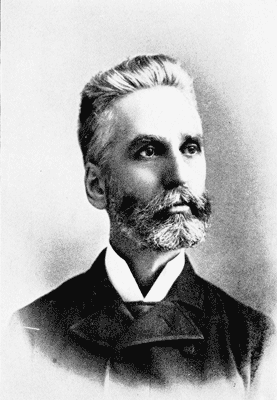
A.J. GOODRICH.
The town of Chilo, Ohio, was Goodrich'
birthplace. He was born there in 1847, of
American parentage. His father taught him
the rudiments of music and the piano for one
year, after which he became his own teacher.
He has had both a thorough and an independent
instructor. The fact that he has
been enabled to follow his own conscience
without danger of being convinced into error
389
by the prestige of some influential master, is
doubtless to be credited with much of the
novelty and courage of his work.
His most important book is undoubtedly
his "Analytical Harmony," though his "Musical
Analysis" and other works are serious
and important. This is not the place to
discuss his technicalities, but one must mention
the real bravery it took to discard the
old practice of a figured bass, and to attack
many of the theoretical fetiches without
hesitation. Almost all of the old theorists
have confessed, usually in a footnote to the
preface or in modest disclaimer lost somewhere
in the book, that the great masters
would occasionally be found violating certain
of their rules. But this did not lead them
to deducing their rules from the great masters.
Goodrich, however, has, in this matter,
begun where Marx ended, and has gone
further even than Prout. He has gone to
melody as the groundwork of his harmonic
390
system, and to the practice of great masters,
old and new, for the tests of all his theories.
The result is a book which can be unreservedly
commended for self-instruction to
the ignorant and to the too learned. It is
to be followed by a book on "Synthetic
Counterpoint," of which Goodrich says, "It
is almost totally at variance with the standard
books in counterpoint."
In his "Musical Analysis" he quoted freely
from American composers, and analyzed many
important native works. He has carried out
this plan also in his book on "Interpretation,"
a work aiming to bring more definiteness into
the fields of performance and terminology.
Goodrich' composition is "a thing of the
past," he says. In his youth he wrote a
score or more of fugues, two string quartettes,
a trio that was played in New York
and Chicago, a sonata, two concert overtures,
a hymn for soprano (in English), invisible
chorus (in Latin), and orchestra, a volume
391
of songs, and numerous piano pieces. He
writes: "In truth, I believed at one time
that I was a real composer, but after listening
to Tschaïkowski's Fifth Symphony that
illusion was dispelled. Had not Mrs. Goodrich
rescued from the flames a few MSS. I
would have destroyed every note."
Only a piano suite is left, and this leads
one to regret that Tschaïkowski should have
served as a deterrent instead of an inspiration.
The suite has an inelaborate prelude,
which begins strongly and ends gracefully,
showing unusual handling throughout. A
minuet, taken scherzando, is also most original
and happy. There is a quaint sarabande, and
a gavotte written on simple lines, but superbly.
Its musette is simply captivating. All these
little pieces indeed show sterling originality
and unusual resources in a small compass.
W.H. Neidlinger's first three songs
were kept in his desk for a year and
then kept by a publisher for a year longer,392
and finally brought out in 1889. To
his great surprise, the "Serenade," which
he calls "just a little bit of commonplace
melody," had an immense sale and created a
demand for more of his work. The absolute
simplicity of this exquisite gem is misleading.
It is not cheap in its lack of ornament, but it
eminently deserves that high-praising epithet
(so pitilessly abused), "chaste." It has the
daintiness and minute completeness of a
Tanagra figurine.
Mr. Neidlinger was born in Brooklyn,
N.Y., in 1863, and was compelled to earn
the money for his own education and for his
musical studies. From Dudley Buck and,
later, C.C. Muller, of New York, he has had
his only musical instruction. He lived abroad
for some time, teaching the voice in Paris,
then returned to live in Chicago. He has
written two operas, one of them having been
produced by the Bostonians.
Mr. Neidlinger builds his songs upon one393
guiding principle, that is, faithfulness to elocutionary
accent and intonation. As he neatly
phrases it, his songs are "colored sketches
on a poet's engravings."
The usual simplicity of Mr. Neidlinger's
songs does not forbid a dramatic outburst at
the proper time, as in the fine mood, "A
Leaf;" or the sombre depth of "Night,"
"Nocturne," and "Solitude;" or yet the
sustainedly poignant anguish of "The Pine-tree."
Occasionally the accompaniment is
developed with elaborateness, as in the bird-flutings
of "The Robin," and "Memories,"
an extremely rich work, with its mellow
brook-music and a hint of nightingale complaint
in the minor. "Evening Song," a bit
of inspired tenderness, is one of Mr. Neidlinger's
best works. Almost better is "Sunshine,"
a streak of brilliant fire quenched
with a sudden cloud at the end. Other
valuable works are "Messages," the happy
little Scotch song, "Laddie," and "Dream394ing,"
which is now sombre, now fierce with
outbursts of agony, but always a melody,
always ariose.
Mr. Neidlinger has made a special study
of music for children, his book, "Small Songs
for Small Children," being much used in
kindergarten work. A book of his, devoted
to a synthetic philosophy of song, is completed
for publication; he calls it "Spenser,
Darwin, Tyndall, etc., in sugar-coated pills;
geography, electricity, and hundreds of other
things in song."
The Cleveland Colony.
The city of Cleveland contains a musical
colony which is certainly more important
than that of any town of its size. About the
tenth of our cities in population, it is at least
fourth, and possibly third, in productiveness
in valuable composition.

WILSON G. SMITH.
The most widely known of Cleveland com395posers
is Wilson G. Smith. He has been
especially fortunate in hitting the golden
mean between forbidding abstruseness and
trivial popularity, and consequently enjoys
the esteem of those learned in music as well
as of those merely happy in it.
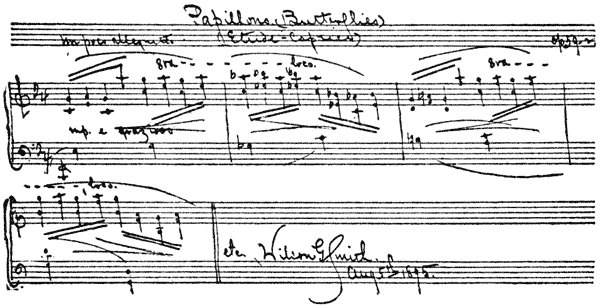
His erudition has persuaded him to a large
simplicity; his nature turns him to a musical
optimism that gives many of his works a
Mozartian cheer. Graciousness is his key.
He was born in Elyria, O., and educated
in the public schools of Cleveland, where he
graduated. Prevented by delicate health
from a college education, he has nevertheless,
396
by wide reading, broadened himself into culture,
and is an essayist of much skill. His
musical education began in 1876, at Cincinnati,
where his teacher, Otto Singer, encouraged
him to make music his profession. In
1880 he was in Berlin, where he studied for
several years under Kiel, Scharwenka, Moskowski,
and Oscar Raif. He then returned
to Cleveland, where he took up the teaching
of organ, piano, voice, and composition.
The most important of Smith's earlier
works was a series of five pieces called
"Hommage à Edvard Grieg," which brought
warmest commendation from the Scandinavian
master. One of the most striking characteristics
of Smith's genius is his ability to
catch the exact spirit of other composers.
He has paid "homage" to Schumann, Chopin,
Schubert, and Grieg, and in all he has
achieved remarkable success, for he has done
more than copy their little tricks of expression,
oddities of manner, and pet weaknesses.
397
He has caught the individuality and the
spirit of each man.
In his compositions in Grieg-ton Smith
has seized the fascinating looseness of the
Griegorian tonality and its whimsicality. The
"Humoresque" is a bit of titanic merriment;
the "Mazurka" is most deftly built and is
full of dance-fire; the "Arietta" is highly
original, and the "Capricietto" shows such
ingenious management of triplets, and has
altogether such a crisp, brisk flavor, that it
reminds one of Lamb's rhapsody on roast
pig, where he exclaims, "I tasted crackling!"
The "Romance," superb in gloom and largeness
of treatment, is worthy of the composer
of "The Death of Asra." A later work,
"Caprice Norwegienne," is also a strong
brew of Scandinavian essence.
A "Schumannesque" is written closely on
the lines of Schumann's "Arabesque." A
later "Hommage à Schumann" is equally
faithful to another style of the master, and
398
dashes forth with characteristic and un-naïve
gaiety and challenging thinness of harmony,
occasionally bursting out into great rare
chords, just to show what can be done when
one tries.
The man that could write both this work
and the highly faithful "Hommage à Schubert,"
and then whirl forth the rich-colored,
sensuous fall and purr of the "Hommage à
Chopin," must be granted at least an unusual
command over pianistic materials, and a most
unusual acuteness of observation.
He can write à la Smith, too, and has a
vein quite his own, even though he prefers
to build his work on well-established lines,
and fit his palette with colors well tempered
and toned by the masters.
In this line is opus 21, a group of four
pieces called "Echoes of Ye Olden Time."
The "Pastorale" is rather Smithian than
olden, with its mellow harmony, but the
"Minuetto" is the perfection of chivalric fop399pery
and pompous gaiety. The "Gavotte"
suggests the contagious good humor of Bach,
and the "Minuetto Grazioso," the best of
the series, has a touch of the goodly old
intervals, tenths and sixths, that taste like
a draught of spring water in the midst of
our modern liqueurs.
The musical world in convention assembled
has covenanted that certain harmonies
shall be set apart for pasturage. Just why
these arbitrary pastorales should suggest
meads and syrinxes, and dancing shepherds,
it would be hard to tell. But this effect they
certainly have, and a good pastorale is a
better antidote for the blues and other civic
ills than anything I know, except the actual
green and blue of fields and skies. Among
the best of the best pastoral music, I should
place Smith's "Gavotte Pastorale." It is one
of the five pieces in his book of "Romantic
Studies" (op. 57).
This same volume contains a "Scherzo
400
alla Tarantella," which is full of reckless wit.
But the abandon is so happy as to seem misplaced
in a tarantella, that dance whose
traditional origin is the maniacal frenzy produced
by the bite of the tarantula. An earlier
Tarantella (op. 34) is far truer to the meaning
of the dance, and fairly raves with shrieking
fury and shuddering horror. This is
better, to me, than Heller's familiar piece.
The "Second Gavotte" is a noble work,
the naïve gaiety of classicism being enriched
with many of the great, pealing chords the
modern piano is so fertile in. I count it as
one of the most spontaneous gavottes of
modern times, one that is buoyant with the
afflation of the olden days. It carries a musette
of which old Father Bach need not have
felt ashamed,—one of the most ingenious
examples of a drone-bass ever written.
The "Menuet Moderne" is musical champagne.
A very neat series of little variations
is sheafed together, and called
401
"Mosaics." Mr. Smith has written two
pieces well styled "Mazurka Poétique;" the
later (opus 48) is the more original, but the
sweet geniality and rapturously beautiful
ending of opus 38 is purer music. "Les
Papillons" is marked with a strange touch of
negro color; it is, as it were, an Ethiopiano
piece. Its best point is its cadenza. Smith
has a great fondness for these brilliant precipitations.
They not only give further evidence
of his fondness for older schools, but
they also partially explain the fondness of
concert performers for his works. His fervid
"Love Sonnet," his "Polonaise de Concert,"
full of virility as well as virtuosity, and his
delicious "Mill-wheel Song," and a late
composition, a brilliant "Papillon," rich as a
butterfly's wing, are notable among his
numerous works. Possibly his largest achievement
is the three concert-transcriptions for
two pianos. He has taken pieces by Grieg,
Raff, and Bachmann, and enlarged, enforced,
402
decorated, and in every way ennobled them.
But to me his most fascinatingly original
work is his "Arabesque," an entirely unhackneyed
and memorable composition.
Smith's experience in teaching has crystallized
into several pedagogic works. His
"Scale Playing with particular reference to
the development of the third, fourth, and
fifth fingers of each hand;" his "Eight
Measure," "Octave," and "Five Minute"
studies, have brought the most unreserved
commendation from the most important of
our teachers. A late and most happy scheme
has been the use of a set of variations
for technical and interpretative instruction.
For this purpose he wrote his "Thèmes
Arabesques," of which numbers one and
eighteen not only have emotional and artistic
interest, but lie in the fingers in a strangely
tickling way.
To Mr. Constantin Sternberg.
Arabesque.
[Listen]
Wilson G. Smith, Op. 39.
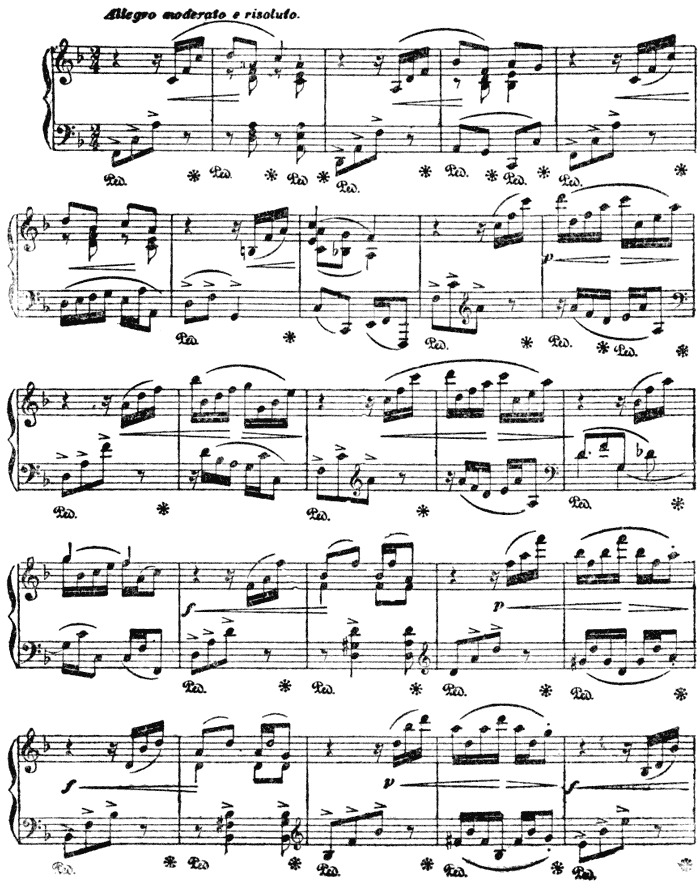
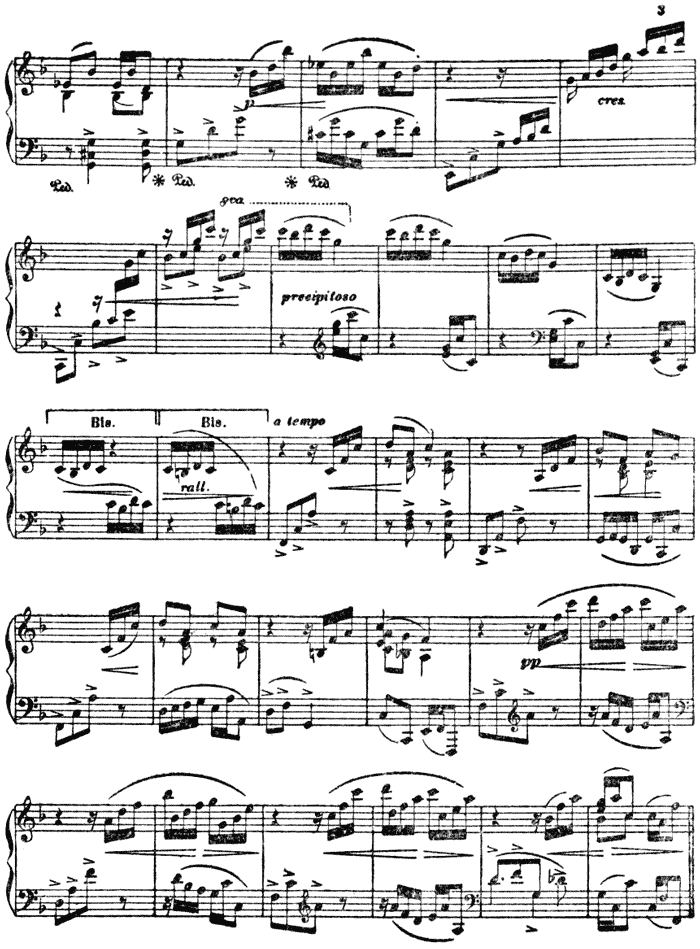
Copyright, 1889, by O. Ditson & Co.
What might be called a professorial simplicity
is seen in many of Smith's songs.
403
The almost unadorned, strictly essential
beauty of his melodies and accompaniments
is neither neglect nor cheapness; it is restraint
to the point of classicism, and romanticism
all the intenser for repression. Take,
for example, that perfect song, "If I but
Knew," which would be one of a score of the
world's best short songs, to my thinking.
Note the open fifths, horrifying if you thump
them academically, but very brave and
straightforward, fitly touched.
There is something of Haydn at his best
in this and in the fluty "Shadow Song," in
"The Kiss in the Rain," and "A Sailor's
Lassie," for they are as crystalline and direct
as "Papa's" own immortal "Schäferlied."
Smith has gone over to the great majority,—the
composers who have set "Du bist
wie eine Blume;" but he has joined those at
the top. Two of Smith's songs have a quality
of their own, an appeal that is bewitching:
"Entreaty," a perfect melody, and "The406
Dimple in Her Cheek," which is fairly peachy
in color and flavor.
A strange place in the world of music is
that held by Johann H. Beck, whom some
have not feared to call the greatest of American
composers. Yet none of his music has
ever been printed. In this he resembles B.
J. Lang, of Boston, who keeps his work persistently
in the dark, even the sacred oratorio
he has written.
All of Beck's works, except eight songs,
are built on very large lines, and though
they have enjoyed a not infrequent public
performance, their dimensions would add
panic to the usual timidity of publishers.
Believing in the grand orchestra, with its
complex possibilities, as the logical climax of
music, Beck has devoted himself chiefly to it.
He feels that the activity of the modern
artist should lie in the line of "amplifying,
illustrating, dissecting, and filling in the outlines
left by the great creators of music and
407
the drama." He foresees that the most complicated
scores of to-day will be Haydnesque
in simplicity to the beginning of the next
century, and he is willing to elaborate his
best and deepest learning as far as in him
lies, and wait till the popular audience grows
up to him, rather than write down to the
level of the present appreciation.
The resolve and the patient isolation of
such a devotee is nothing short of heroic;
but I doubt that the truest mission of the
artist is to consider the future too closely.
Even the dictionaries and encyclopædias of
one decade, are of small use to the next.
The tiny lyrics of Herrick, though, have no
quarrel with time, nor has time any grudge
against the intimate figurines of Tanagra.
The burdened trellises of Richard Strauss
may feel the frost long before the slender ivy
of Boccherini's minuet.
Science falls speedily out of date, and
philosophy is soon out of fashion. Art that410
uses both, is neither. When it makes crutches
of them and leans its whole weight on them,
it will fall with them in the period of their
inevitable decay.
Of course, there is evolution here as well
as in science. The artist must hunt out new
forms of expressing his world-old emotions,
or he will not impress his hearers, and there
is no gainsaying Beck's thesis that the Chinese
puzzle of to-day will be the antique simplicity
of a later epoch. But it must never be forgotten,
that art should be complex only to
avoid the greater evils of inadequacy and
triteness. A high simplicity of plan and an
ultimate popularity of appeal are essentials to
immortal art.
It is my great misfortune never to have
heard one of Beck's works performed, but,
judging from a fragment of a deliciously
dreamy moonlight scene from his unfinished
music drama, "Salammbô," which he kindly
sent me, and from the enthusiasm of the
411
severest critics, he must be granted a most
unusual poetic gift, solidity and whimsicality,
and a hardly excelled erudition. His orchestration
shows a hand lavish with color and
cunning in novel effects. Several of his
works have been performed with great applause
in Germany, where Beck spent many
years in study. He was born at Cleveland,
in 1856, and is a graduate of the Leipzig
Conservatorium.
In art, quality is everything; quantity is
only a secondary consideration. It is on
account of the quality of his work that James
H. Rogers must be placed among the very
best of modern song-writers, though his published
works are not many. When one considers
his tuition, it is small wonder that his
music should show the finish of long mastery.
Born in 1857, at Fair Haven, Conn., he took
up the study of the piano at the age of twelve,
and at eighteen was in Berlin, studying there
for more than two years with Löschorn,
412
Rohde, Haupt, and Ehrlich, and then in Paris
for two years under Guilmant, Fissot, and
Widor. Since then he has been in Cleveland
as organist, concert pianist, and teacher.
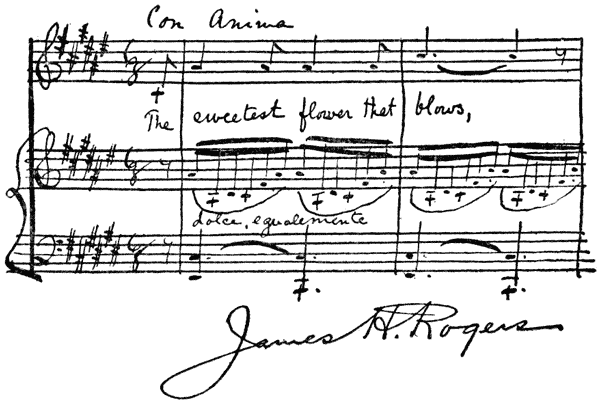
His songs are written usually in a characteristic
form of dramatic, yet lyric recitative.
His "Album of Five Songs" contains notable
examples of this style, particularly the "Good-Night,"
"Come to Me in My Dreams," and
the supremely tragic climax of "Jealousy."
The song, "Evening," with its bell-like accompaniment,
is more purely lyric, like the
413
enchanting "At Parting," which was too
delicately and fragrantly perfect to escape
the wide popularity it has had. His "Declaration"
is ravishingly exquisite, and offers a
strange contrast to the "Requiescat," which
is a dirge of the utmost largeness and grandeur.
His graceful "Fly, White Butterflies,"
and "In Harbor," and the dramatic setting
of "The Loreley," the jovial "Gather Ye
Rosebuds" of jaunty Rob Herrick, the foppish
tragedy of "La Vie est Vaine" (in
which the composer's French prosody is a
whit askew), that gallant, sweet song, "My
True Love Hath My Heart," and a gracious
setting of Heine's flower-song, are all noteworthy
lyrics. He has set some of Tolstoï's
words to music, the sinister love of "Doubt
Not, O Friend," and the hurry and glow of
"The First Spring Days," making unusually
powerful songs. In the "Look Off, Dear
Love," he did not catch up with Lanier's
great lyric, but he handled his material most
414
effectively in Aldrich' "Song from the Persian,"
with its Oriental wail followed by a
martial joy. The high verve that marks his
work lifts his "Sing, O Heavens," out of the
rut of Christmas anthems.
Of instrumental work, there is only one
small book, "Scènes du Bal," a series of nine
pieces with lyric characterization in the spirit,
but not the manner of Schumann's "Carnéval."
The most striking numbers are "Les
Bavardes," "Blonde et Brune," and a fire-eating
polonaise.
These close the lamentably small number
of manifestations of a most decisive ability.
Another Cleveland composer well spoken
of is Charles Sommer.
A young woman of genuine ability, who
has been too busy with teaching and concert
pianism to find as much leisure as she
deserves for composition, is Patty Stair, a
prominent musical figure in Cleveland. Her
theoretical studies were received entirely at
415
Cleveland, under F. Bassett. Her published
works include a book of "Six Songs," all of
them interesting and artistic, and the "Madrigal"
particularly ingenious; and a comic glee
of the most irresistible humor, called "An
Interrupted Serenade;" in manuscript are a
most original song, "Flirtation," a jovial
part song for male voices, "Jenny Kissed
Me," a berceuse for violin and piano, a
graceful song, "Were I a Brook," a setting
of Thomas Campion's "Petition," and
another deeply stirring religious song for
contralto, "O Lamb of God."
The St. Louis Colony.
The most original and important contribution
to American music that St. Louis has
made, is, to my mind, the book of songs
written by William Schuyler. The words
were chosen from Stephen Crane's book of
poems, "The Black Riders." The genius
of Crane, concomitant with eccentricity as418
it was, is one of the most distinctive among
American writers. The book called "The
Black Riders" contains a number of moods
that are unique in their suggestiveness and
originality. Being without rime or meter,
the lines oppose almost as many difficulties
to a musician as the works of Walt Whitman;
and yet, as Alfred Bruneau has set
Zola's prose to music, so some brave American
composer will find inspiration abundant
in the works of Walt Whitman and Emily
Dickinson.
III.
[Listen]
WILLIAM SCHUYLER.
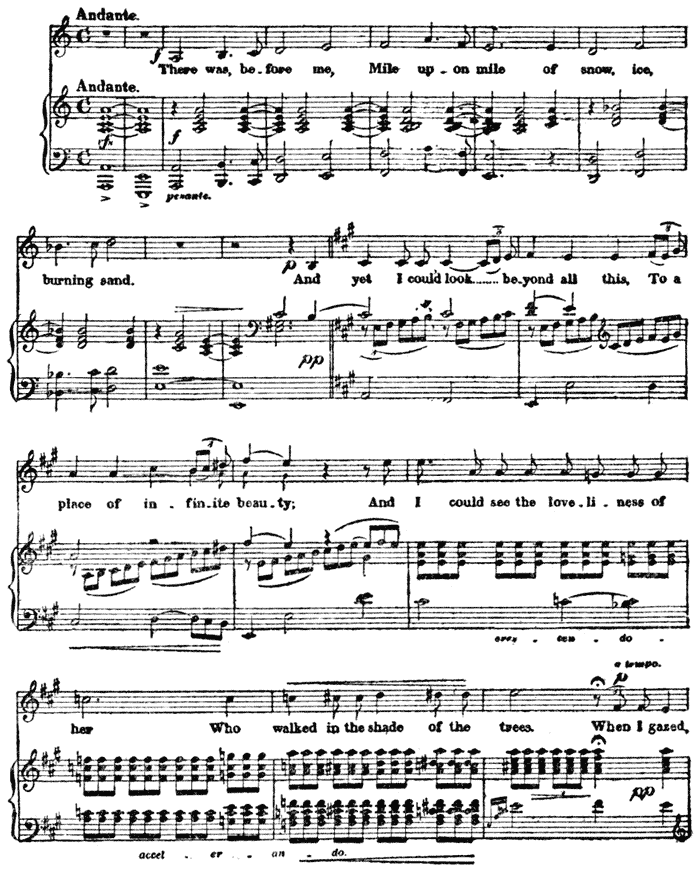
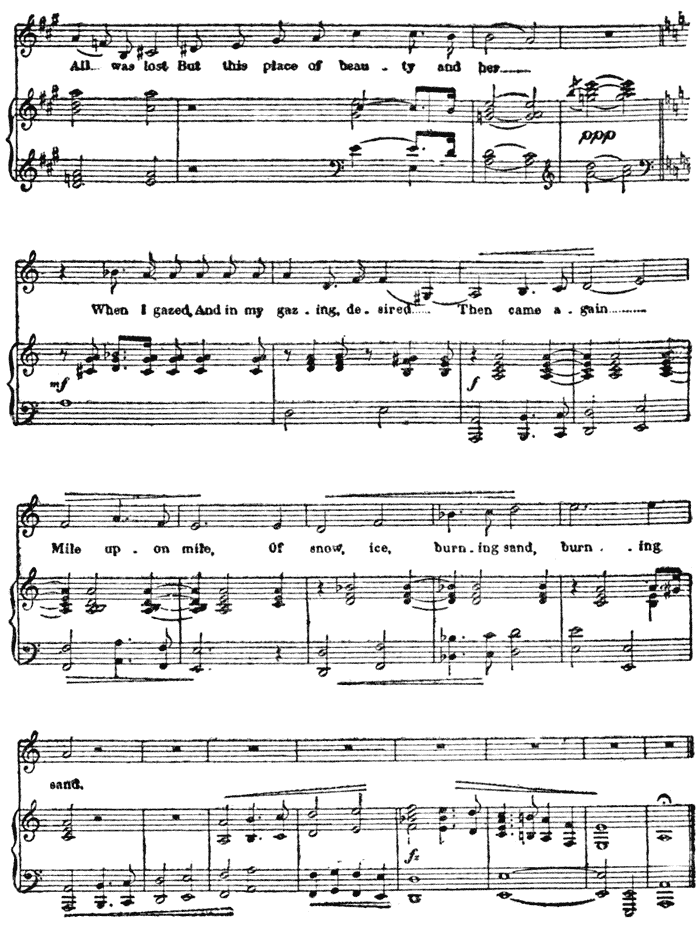
Words used by permission of Copeland and Day.
Copyright, 1897, by Wm. Schuyler.
There was, before me,
Mile upon mile of snow, ice, burning sand.
And yet I could look beyond all this,
To a place of infinite beauty;
And I could see the loveliness of her
Who walked in the shade of the trees.
When I gazed,
All was lost
But this place of beauty and her
When I gazed,
And in my gazing, desired
Then came again
Mile upon mile,
Of snow, ice, burning sand, burning sand.
FROM WM. SCHUYLER'S "BLACK RIDERS."
Schuyler was born in St. Louis, May 4,
1855, and music has been his livelihood.
He is largely self-taught, and has composed
some fifty pieces for the piano, a hundred and
fifty songs, a few works for violin, viola, and
'cello, and two short trios.
In his setting of these lines of Crane's,
Schuyler has attacked a difficult problem in
an ideal manner. To three of the short
poems he has given a sense of epic vasti419tude,
and to two of them he has given a
tantalizing mysticism. The songs, which have
been published privately, should be reproduced
for the wide circulation they deserve.
Another writer of small songs displaying
unusual individuality is George Clifford Vieh,
who was born in St. Louis and studied there
under Victor Ehling. In 1889, he went to
Vienna for three years, studying under
Bruckner, Robert Fuchs, and Dachs. He
graduated with the silver medal there, and
returned to St. Louis, where he has since
lived as a teacher and pianist.
Alfred George Robyn is the most popular
composer St. Louis has developed. He was
born in 1860, his father being William
Robyn, who organized the first symphonic
orchestra west of Pittsburg. Robyn was a
youthful prodigy as a pianist; and, at the
age of ten, he succeeded his father as organist
at St. John's Church, then equipped with
the best choir in the city. It was necessary
420
for the pedals of the organ to be raised to his
feet. At the age of sixteen he became solo
pianist with Emma Abbott's company. As
a composer Robyn has written some three
hundred compositions, some of them reaching
a tremendous sale. A few of them have been
serious and worth while, notably a piano concerto,
a quintette, four string quartettes, a
mass, and several orchestral suites.
There are not many American composers
that have had a fugue published, or have
written fugues that deserve publication. It
is the distinction of Ernest Richard Kroeger
that he has written one that deserved, and
secured, publication. This was his 41st
opus. It is preceded by a prelude which,
curiously enough, is thoroughly Cuban in
spirit and is a downright Habanera, though
not so announced. This fiery composition is
followed by a four-voiced "real" fugue. The
subject is genuinely interesting, though the
counter-subject is as perfunctory as most
421
counter-subjects. The middle-section, the
stretto-work, and the powerful ending, give
the fugue the right to exist.
Among other publications are a suite for
piano (op. 33), in which a scherzo has life,
and a sonata for violin and piano, in which,
curiously enough, the violin has not one instance
of double-stopping, and the elaborating
begins, not with the first subject taken vigorously,
but with the second subject sung out
softly. The last movement is the best, a
quaint and lively rondo. A set of twelve
concert études show the influence of Chopin
upon a composer who writes with a strong
German accent. The étude called "Castor
and Pollux" is a vigorous number with the
chords of the left hand exactly doubled in
the right; another étude, "A Romanze," is
noteworthy for the practice it gives in a point
which is too much ignored even by the best
pianists; that is, the distinction between the
importance of the tones of the same chord422
struck by the same hand. A work of broad
scholarship, which shows the combined influence
of Beethoven and Chopin, who have
chiefly affected Kroeger, is his sonata (op.
40). A dominant pedal-point of fifty-eight
measures, in the last movement, is worth
mentioning. In a "Danse Négre" and a
"Caprice Négre," he has evidently gone, for
his Ethiopian color, not to the actual negro
music, but to the similar compositions of
Gottschalk. Kroeger was born in St. Louis,
August 10, 1862. At the age of five he
took up the study of the piano and violin.
His theoretical tuition was all had in this
country. He has written many songs, a
piano concerto, sonatas for piano and viola,
and piano and 'cello, two trios, a quintette,
and three string quartettes, as well as a
symphony, a suite, and overtures based on
"Endymion," "Thanatopsis," "Sardanapalus"
(produced by Anton Seidl, in New York),
"Hiawatha," and "Atala."
423
CHAPTER V.
THE WOMEN COMPOSERS.
This is not the place to take up cudgels
for a contest on the problem of woman's
right to respect in the creative arts. There
are some, it is true, who deny fervently that
the feminine half of mankind ever has or
can or ever will do original and important
work there. If you press them too hard
they will take refuge up this tree, that all
women who ever have had success have been
actually mannish of mind,—a dodge in
question-begging that is one of the most
ingenious ever devised; a piece of masculine
logic that puts to shame all historic examples
of womanly fallacy and sophistry. It seems
424
to me that the question is easily settled on
this wise: it is impossible for a rational mind
to deny that the best work done in the arts
by women is of better quality than the
average work done by men. This lets the
cat's head out of the bag, and her whole body
follows pell-mell.
In a few instances it seems to me that the
best things done by women equal the best
things done by men in those lines. The
best verses of Sappho, the best sonnets of
Mrs. Browning, the best chapters of George
Eliot, the best animal paintings of Rosa
Bonheur, do not seem to me surpassed by
their rivals in masculine work. If anything
in verse of its sort is nobler than Mrs. Howe's
"Battle Hymn of the Republic," it is still in
manuscript. If there is any poet of more
complete individuality than Emily Dickinson,
I have not run across his books. In music
I place two or three of Miss Lang's small
songs among the chief of their manner.
425
All over the world the woman-mind is
taking up music. The ban that led Fanny
Mendelssohn to publish her music under her
brother's name, has gone where the puritanic
theory of the disgracefulness of the musical
profession now twineth its choking coils. A
publisher informs me that where compositions
by women were only one-tenth of his manuscripts
a few years ago, they now form more
than two-thirds. From such activity, much
that is worth while is bound to spring. Art
knows no sex, and even what the women
write in man-tone is often surprisingly strong,
though it is wrongly aimed. But this effort
is like the bombast of a young people or a
juvenile literature; the directness and repose
of fidelity to nature come later. The American
woman is in the habit of getting what
she sets her heart on. She has determined
to write music.
With an ardor that was ominous of success,
Miss Amy Marcy Cheney, after a short426
preliminary course in harmony, resolved to
finish her tuition independently. As an
example of the thoroughness that has given
her such unimpeachable knowledge of her
subject, may be mentioned the fact that she
made her own translation of Berlioz and
Gavaërt. She was born in New Hampshire,
of descent American back to colonial times.
At the age of four she wrote her opus 1.
She is a concert pianist as well as a frequent
composer in the largest forms. She is now
Mrs. H.H.A. Beach.

MRS. H.H.A. BEACH.
Not many living men can point to a composition
of more maturity and more dignity
than Mrs. Beach' "Jubilate," for the dedication
of the Woman's Building at the Columbian
Exposition. The work is as big as its
name; it is the best possible answer to skeptics
of woman's musical ability. It may be too
sustainedly loud, and the infrequent and short
passages piano are rather breathing-spells
than contrasting awe, but frequently this work
427
shows a very magnificence of power and
exaltation. And the ending is simply superb,
though I could wish that some of the terrific
dissonances in the accompaniment had been
put into the unisonal voices to widen the
effect and strengthen the final grandeur. But
as it is, it rings like a clarion of triumph,—the
cry of a Balboa discovering a new sea of
opportunity and emotion.
Another work of force and daring is the
mass in E flat (op. 5), for organ and small
orchestra. It is conventionally ecclesiastic
as a rule, and suffers from Mrs. Beach' besetting
sin of over-elaboration, but it proclaims
a great ripeness of technic. The "Qui
Tollis" is especially perfect in its sombre
depth and richness. The "Credo" works
up the cry of "crucifixus" with a thrilling
rage of grief and a dramatic feeling rare in
Mrs. Beach' work. This work was begun at
the age of nineteen and finished three years
later. It was given with notable effect in
428
1892 by the Handel and Haydn Society of
Boston.
Mrs. Beach' "Valse Caprice" has just
one motive,—to reach the maximum of technical
trickiness and difficulty. There is such
a thing as hiding one's light under a bushel,
and there is such a thing as emptying a bushel
of chaff upon it.
"Fireflies" is a shimmering and flitting
caprice of much ingenuity, but it keeps in the
field of dissonance almost interminably, and
clear harmony is not so much the homing-place
of its dissonance, as an infrequent glint
through an inadvertent chink. This neat
composition is one of four "Sketches for
the Piano," of which "Phantoms" is delightful
with ghostliness. "In Autumn" is a most
excellent tone-poem, and "Dreaming" is a
well-varied lyric. As a colorist Mrs. Beach
is most original and studious. Her tireless
hunt for new tints often diverts her indeed
from the direct forthright of her meaning,430
but the "Danse des Fleurs" is rich in its
gorgeousness. The flowing grace of the
"Menuet Italien" makes it an uncharacteristic
but charming work.
PHANTOMS.
"Toute fragiles fleurs, sitôt mortes que nées."
Victor Hugo.
[Listen]
Mrs. H.H.A. Beach.
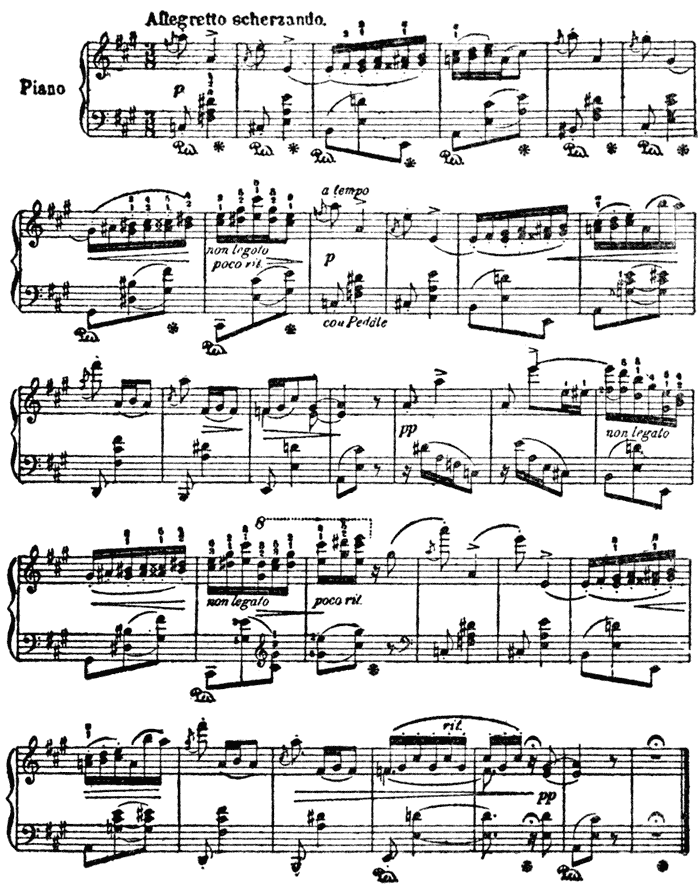
Copyright, 1892, by Arthur P. Schmidt.
A FRAGMENT.
Horace, you know, promises to write so
that any one will think him easy to equal,
though much sweat will be shed in the effort.
It is the transparency of her studiousness,
and the conspicuous labor in polishing off
effects and mining opportunity to the core,
that chiefly mars the work of Mrs. Beach, in
my opinion. One or two of the little pieces
that make up the half-dozen of the "Children's
Carnival" are among her best work,
for the very cheery ease of their look. "Pantalon,"
"Harlequin," "Columbine," and "Secrets"
are infinitely better art than a dozen
valse-caprices.
Both the defects and effects of her qualities
haunt Mrs. Beach' songs. When she is
sparing in her erudition she is delightful.
Fourteen of her songs are gathered into a
431
"Cyclus." The first is an "Ariette," with
an accompaniment imitating the guitar. It
is both tender and graceful. Probably her
best song is the setting of W.E. Henley's
fine poem, "Dark is the Night." It is of
the "Erl-King" style, but highly original
and tremendously fierce and eerie. The same
poet's "Western Wind" is given a setting
contrastingly dainty and serene. "The Blackbird"
is delicious and quite unhackneyed.
"A Secret" is bizarre, and "Empress of the
Night" is brilliant. With the exception of a
certain excess of dissonance for a love-song,
"Wilt Thou Be My Dearie?" is perfect with
amorous tenderness. "Just for This!" is a
delightful vocal scherzo of complete originality
and entire success. "A Song of Love" is
passionate and yet lyric, ornamented but not
fettered. "Across the World" has been one
of Mrs. Beach' most popular songs; it is
intense and singable. "My Star" is tender,
and the accompaniment is richly worked out
432
on simple lines. Three Vocal Duets are well-handled,
but the long "Eilende Wolken" has
a jerky recitative of Händelian naïveté, to
which the aria is a welcome relief. Her
sonata for piano and violin has been played
here by Mr. Kneisel, and in Berlin by Mme.
Carreño and Carl Halir.
Besides these, Mrs. Beach has done not a
little for the orchestra. Her "Gaelic Symphony"
is her largest work, and it has been
often played by the Boston Symphony, the
Thomas, and other orchestras. It is characterized
by all her exuberant scholarship
and unwearying energy.

MARGARET RUTHVEN LANG.
Margaret Ruthven Lang, the daughter of
B.J. Lang, is American by birth and training.
She was born in Boston, November 27,
1867. She has written large works, such as
three concert overtures, two of which have
been performed by the Thomas and the Boston
Symphony Orchestras, though none of
them are published. Other unpublished 433
works are a cantata, two arias with orchestral
accompaniment, and a rhapsody for the
piano. One rhapsody has been published, that
in E minor; in spite of its good details, it is
curiously unsatisfying,—it seems all prelude,
interlude, and postlude, with the actual rhapsody
accidentally overlooked. A "Meditation"
is bleak, with a strong, free use of dissonance.
"The Jumblies" is a setting of Edward
Lear's elusive nonsense, as full of the flavor
of subtile humor as its original. It is for
male chorus, with an accompaniment for two
pianos, well individualized and erudite. It
is in her solo songs, however, that her best
success is reaped.
When I say that Mrs. Beach' work is
markedly virile, I do not mean it as compliment
unalloyed; when I find Miss Lang's
work supremely womanly, I would not deny it
great strength, any more than I would deny
that quality to the sex of which Joan of Arc
and Jael were not uncharacteristic members.
434
Such a work as the "Maiden and the
Butterfly" is as fragile and rich as a butterfly's
wing. "My Lady Jacqueminot" is
exquisitely, delicately passionate. "Eros"
is frail, rare, ecstatic. "Ghosts" is elfin and
dainty as snowflakes. The "Spinning Song"
is inexpressibly sad, and such music as
women best understand, and therefore ought
to make best. But womanliness equally marks
"The Grief of Love," which is in every sense
big in quality; marks the bitterness of "Oh,
What Comes over the Sea," the wailing Gaelic
sweetness of the "Irish Love Song," and the
fiery passion of "Betrayed," highly dramatic
until its rather trite ending. "Nameless
Pain" is superb. Her "Lament" I consider
one of the greatest of songs, and proof
positive of woman's high capabilities for composition.
Miss Lang has a harmonic individuality,
too, and finds out new effects that are
strange without strain.
"My Turtle Dove," among the "Five
435
Norman Songs," in fearlessness and harmonic
exploration shows two of the strongest
of Miss Lang's traits. Her récherchés
harmonies are no pale lunar reflection of
masculine work. Better yet, they have the
appearance of spontaneous ease, and the
elaborateness never obtrudes itself upon
the coherence of the work, except in a few
such rare cases as "My Native Land,"
"Christmas Lullaby," and "Before My
Lady's Window." They are singable to a
degree unusual in scholarly compositions.
To perfect the result Miss Lang chooses her
poems with taste all too rare among musicians,
who seem usually to rate gush as
feeling and gilt as gold. Her "Oriental
Serenade" is an example of weird and original
intervals, and "A Spring Song," by
Charlotte Pendleton, a proof of her taste in
choosing words.
GHOSTS.
Words by Munkittrick.
[Listen]
MARGARET RUTHVEN LANG.
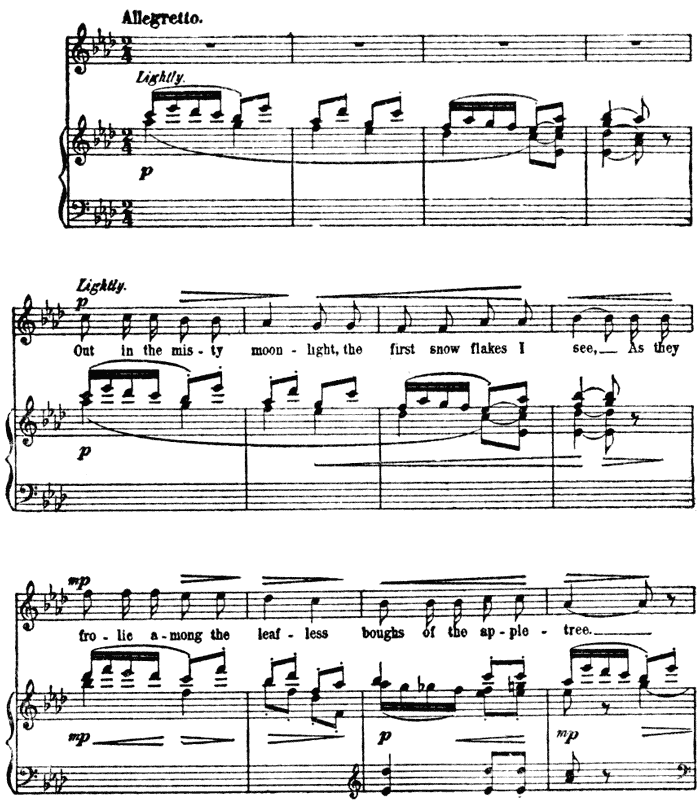
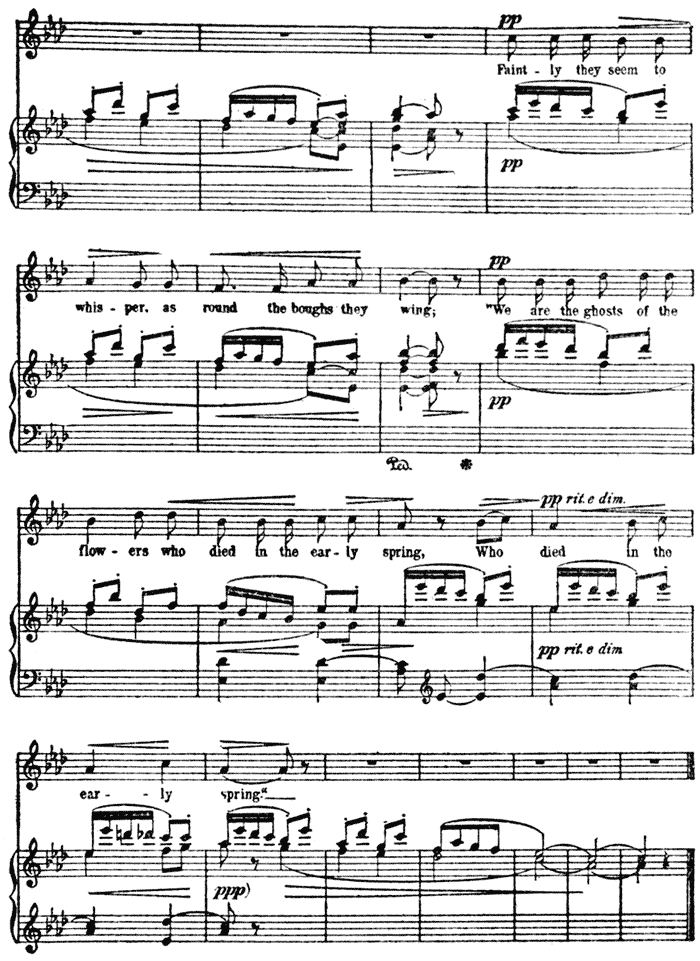
Copyright, 1889, by Arthur P. Schmidt & Co.
Out in the misty moonlight, the first snow flakes I see,
As they frolic among the leafless boughs of the apple tree.
Faintly they seem to whisper, as round the boughs they wing;
"We are the ghosts of the flowers who died in the early spring,
Who died in the early spring."
Her opus 32 is made up of two songs, both
full of fire and originality. Opus 33 is a438
captivating "Spring Idyl" for the piano, for
which she has also written a "Revery," of
which the exquisiteness of sleep is the theme.
The music is delicious, and the ending is a
rare proof of the beautiful possibilities of
dissonance.
Personally, I see in Miss Lang's compositions
such a depth of psychology that I place
the general quality of her work above that of
any other woman composer. It is devoid
of meretriciousness and of any suspicion of
seeking after virility; it is so sincere, so true
to the underlying thought, that it seems to
me to have an unusual chance of interesting
attention and stirring emotions increasingly
with the years.
An interesting and genuine individuality
will transpire through the most limited
amount of creative art. This has been the
case with the few published works of a
writer, whose compositions, though unpretentious
in size and sentiment, yet reveal a
439
graceful fancy, and a marked contemplation
upon the details of the moods.
Irene Baumgras was born at Syracuse,
New York, and studied the piano at the Cincinnati
Conservatory of Music, where she
took the Springer gold medal in 1881. She
studied in Berlin with Moszkowski and Oscar
Raif. She was married in Berlin, in 1884,
to Philip Hale, the distinguished Boston
musical critic.
Her devotion to her art was so great that
her health broke down from overwork, and
she was compelled to give up piano playing.
Some of her compositions have been published
under the name of "Victor René."
Her 15th opus is made up of three "Morceaux
de Genre," of which the "Pantomime" is a
most volatile harlequinade, with moods as
changeful as the key; a remarkably interesting
composition. Four "Pensées Poétiques"
make up opus 16. They include a blithe
"Chansonette" and a "Valse Impromptu,"
440
which, unlike the usual impromptu, has the
ex tempore spirit. Of her songs, "Mystery"
is a charming lyric; "Maisie" is faithful to
the ghoulish merriment of the words; and
"An Opal Heart" is striking for interesting
dissonances that do not mar the fluency of
the lyric.
Of much refinement are the fluent lyrics
of Mrs. Mary Knight Wood. They show a
breadth in little, and a fondness for unexpected
harmonies that do not disturb the
coherence of her songs. They possess also
a marked spontaneity. An unexpected effect
is gained by the brave E flat in her
"Serenade." Her popular "Ashes of Roses"
also has a rich harmonic structure. Among
other songs, one with an effective obbligato
for the violoncello deserves special praise.
She has written also for the violin and piano,
and trios for 'cello, violin, and piano.
Other women who have written certain
works of serious intention and worthy art, are
441
Mrs. Clara A. Korn, Laura Sedgwick Collins,
the composer of an ingenious male quartette,
"Love is a Sickness," and many excellent
songs, among them, "Be Like That Bird,"
which is ideally graceful; Fanny M. Spencer,
who has written a collection of thirty-two
original hymn tunes, a good anthem, and a
Magnificat and Nunc Dimittis of real strength;
Julie Rivé-King, the author of many concert
pieces; Patty Stair, of Cleveland; Harriet P.
Sawyer, Mrs. Jessie L. Gaynor, Constance
Maud, Jenny Prince Black, Charlotte M.
Crane, and Helen Hood.
442
CHAPTER VI.
THE FOREIGN COMPOSERS.
Ours is so young, and so cosmopolite, a
country, that our art shows the same brevity
of lineage as our society. Immigration has
played a large part in the musical life of the
United States, as it has in the make-up of
the population; and yet for all the multiplexity
of his ancestry, the American citizen
has been assimilated into a distinctive individuality
that has all the traits of his different
forbears, and is yet not closely like any of
them. So, American music, taking its scale
and most of its forms from the old country,
is yet developing an integrity that the future
will make much of. As with the federation
443
of the States, so will one great music ascend
polyphonically,—e pluribus unum.
In compiling this directory of American
composers, it has been necessary to discuss
the works only of the composers who were
born in this country. It is interesting to see
how few of these names are un-American,
how few of them are Germanic (though so
many of them have studied in Germany).
Comment has often been made upon the
Teutonic nature of the make-up of our
orchestras. It is pleasant to find that a
very respectable list of composers can be
made up without a preponderance of German
names.
The music life of our country, however,
has been so strongly influenced and enlivened
and corrected by the presence of
men who were born abroad that some recognition
of their importance should somewhere
be found. Many of them have become
naturalized and have brought with them so
444much enthusiasm for our institutions that
they are actually more American than many
of the Americans; than those, particularly,
who, having had a little study abroad, have
gone quite mad upon the superstition of "atmosphere,"
and have brought home nothing
but foreign mannerisms and discontent.
Among the foreign born who have made
their home in America, I must mention with
respect, and without attempting to suggest
order of precedence, the following
names:
C.M. Loeffler, Bruno Oscar Klein, Leopold
Godowski, Victor Herbert, Walter Damrosch,
Julius Eichberg, Dr. Hugh A. Clarke,
Louis V. Saar, Asgar Hamerik, Otto Singer,
August Hyllested, Xavier Scharwenka, Rafael
Joseffy, Constantin von Sternberg,
Adolph Koelling, August Spanuth, Aimé
Lachaume, Max Vogrich, W.C. Seeboeck,
Julian Edwards, Robert Coverley, William
Furst, Gustave Kerker, Henry Waller,
445
P.A. Schnecker, Clement R. Gale, Edmund
Severn, Platon Brounoff, Richard Burmeister,
Augusto Rotoli, Emil Liebling, Carl Busch,
John Orth, Ernst Perabo, Ferdinand Dunkley,
Mrs. Clara Kathleen Rogers, Miss Adele
Lewing, Mrs. Elisa Mazzucato Young.
It is perhaps quibbling to rule out some of
these names from Americanism, and include
certain of those whom I have counted American
because they were born here, in spite of
the fact that their whole tuition and tendency
is alien. But the line must be drawn somewhere.
The problem is still more trying in the
case of certain composers who, having been
born here, have expatriated themselves, and
joined that small colony of notables whom
America has given to Europe as a first instalment
in payment of the numerous loans we
have borrowed from the old country.
For the sake of formally acknowledging this
debt, I will not endeavor to discuss here the
careers of George Templeton Strong, Arthur
446
Bird, or O.B. Boise, all three of whom were
born in this country, but have elected to live
in Berlin. Their distinction in that city at
least palely reflects some credit upon the
country that gave them birth.
447
POSTLUDE.
In the ninth century Iceland was the musical
center of the world; students went there
from all Europe as to an artistic Mecca. Iceland
has long lost her musical crown. And
Welsh music in its turn has ceased to be the
chief on earth. Russia is sending up a strong
and growing harmony marred with much discord.
Some visionaries look to her for the
new song. But I do not hesitate to match
against the serfs of the steppes the high-hearted,
electric-minded free people of our
prairies; and to prophesy that in the coming
century the musical supremacy and inspiration
of the world will rest here overseas, in
America.
THE END.
449
INDEX.
Transcriber's Note: Misspellings in the original Index have been
corrected, and the entries have been placed in the proper order.
Abt Society, 198.
Academy of Dramatic Arts, 79.
Æschylean Chorus, 53.
Agramonte, Emilio, 41.
Aldrich, Anna Reeve, 313.
Aldrich, T.B., 89, 108, 204.
Allen, C.N., 244.
Allen, N.H., 273.
Allen, P.C., 272.
Allison, XIII.
Ambrosius, Johanna, 349.
Americanism in Music, 12, 33, 58.
Apollo Club, 168, 236, 331.
Apthorp, W.F., 370.
Arion Society, 190.
Arnold, Maurice, 135, 139.
Arnold, Sir Edwin, 171.
Aus der Ohe, Adèle, 293.
Bach, J.S., 15, 225, 227, 248, 399, 400.
Baltzell, Willard J., 275.
Bartlett, H.N., 317, 327.
Bassett, F., 415.
Bates, Arlo, 187, 368.
Baumgras, Irene, 439.
Beach, Mrs. H.H.A., 426, 432, 433.
Beck, Johann H., 406, 411.
Beethoven, 12, 52, 56, 100, 116, 148, 163, 178, 208, 306.
Bendel, 237.
"Ben Hur," 72.
Benkert, G.F., 119.
Bennett, Sterndale, 257.
Berlioz, 144, 219, 243, 307, 426.
Bernard of Cluny's, 183.
Best, W.T., 361.
Bird, Arthur, 446.
Black, Jennie Prince, 441.
"Blind Tom," 59.
Boccherini, 407.
Bodenstedt, 364.
Boise, O.B., 292, 299, 388, 446.
Boston Colony, 269, 350, 371.
Boston Symphony Orchestra, 18, 219, 233, 269, 281, 282, 286, 292, 432.
450
Bourdillon's, 109, 312.
Brahms, 56, 97, 114, 255, 284.
Breton, XIII.
Brewer, J.H., 331, 334.
Bristow, George F., 246.
Brockway, Howard, 298, 304.
Brounoff, Platon, 445.
Browning, E.B., 424.
Browning, Robt., 89, 99.
Bruce, Edwin, 388.
Bruch, Max, 136.
Bruckner, 419.
Bruneau, Alfred, 418.
Buck, Dudley, 165, 173, 174, 305, 324, 331, 361, 381, 392.
Bullard, F.F., 351, 357.
Burmeister, Richard, 445.
Burns, 204.
Burton, F.R., 273.
Busch, Carl, 445.
Byrd, XIII.
Byron, 252.
Canova, 12.
Carew, XIII.
Carnegie, A., 256.
Carpenter, H.B., 213.
Carreño, 36.
Carroll, Lewis, 212.
Carter, R.I., 294.
Chadwick, Geo. W., 18, 175, 210, 220, 244, 347, 358.
Chaminade, 218.
Champion, T., XIII., 415.
Cheney, J.V., 89, 90.
Chicago Colony, 18.
Chicago Orchestra, 18.
Chinese Music, 64, 86, 140, 143.
Chopin, 52, 56, 90, 98, 100, 110, 116, 138, 163, 177, 178, 211, 250, 294, 317, 319, 338, 396, 421.
Cincinnati Colony, 191, 270, 272.
Clarke, H.A., 198, 444.
Clementi, 113.
Cleveland Colony, 394, 415.
Coccius, 132, 249.
Coerne, L.A., 262, 265.
Coleridge, 62, 309.
College Music, 20, 38.
Collins, Laura S., 441.
Columbus, 234.
Converse, C.C., 256, 261.
Coombs, C.W., 343.
Corelli, 15.
Couperin, 16.
Coverley, Robert, 444.
Cramer, 321.
Crane, Charlotte M., 441.
Crane, Stephen, 415, 418.
Dachs, 419.
Damrosch, Walter, 261, 444.
Dante, 229.
de Koven, R., 334.
De Musset, A., 109.
Dennée, Charles, 374.
Dickinson, Emily, 369, 418, 424.
Diemer, 134.
Donne, Jno., XIII.
Dowland, XIII.
Draessecke, 343.
Drake, Rodman, 131, 168.
Drayton, XIII.
Dreams and Music, 62.
Dressler, L.R., 345.
451Drummond, XIII., 153.
Dubois, 134, 358.
Dudley, Governor, 166.
Dunbar, P.L., 206.
Dunkley, Ferdinand, 445.
Dvôrák, A., 22, 77, 128, 129, 131, 132, 136, 278, 279, 305, 349, 371.
Eddy, Clarence, 59, 348.
Edison, 16.
Edwards, Julian, 444.
Egyptian Music, 72.
Ehlert, 37.
Ehling, Victor, 419.
Ehrlich, 412.
Eichberg, Julius, 444.
Elson, L.C., 16.
Emerson, 14.
Emery, Stephen A., 17, 95, 175, 244, 358, 375.
English Music, 12, 248, 329.
Esputa, John, 119.
Fairlamb, J.R., 344.
Farwell, A., 348.
Féval, 79.
Field, John, 227.
Finck, Henry T., 54.
Fisher, W.A., 348, 371.
Fissot, 412.
Fletcher, XII., 150.
Florio, 31.
Foerster, A.M., 248, 256.
Folk-music, 22.
Foote, Arthur, 18, 224, 234.
Ford, XIII.
Franz, Robt., 101, 104, 106, 173, 203, 248.
French influence, 29, 36, 357.
Fuchs, Robt., 419.
Furst, Wm., 444.
Gale, Clement R., 445.
Gale, Norman, 88.
Gavaërt, 426.
Gaynor, Mrs. Jessie L., 441.
Genée, 335.
German Influence, etc., 17, 40, 49, 59, 119, 132, 260.
Gerok, 106.
Gilchrist, W.W., 196, 209.
Gilder, R.W., 277.
Gilmore, P.S., 124, 261.
Gleason, F.G., 348, 376, 382.
Godard, 358.
Godowski, L., 444.
Goethe, 43, 95, 255.
Goetschius, Percy, 388.
Goldmark, Carl, 279, 281.
Goldmark, Rubin, 278, 282.
Goodrich, A.J., 28, 130, 171, 199, 380, 388, 391.
Goodrich, J. Wallace, 348.
Gottschalk, Louis Moreau, 17, 301, 422.
Gounod, 321.
Grabau, 371.
Grand Operas, 152, 262.
Gray, XII.
Greek Music, 72, 73, 155.
Greene, XII.
Grieg, 39, 54, 134, 190, 281, 396.
Grill, 132, 249.
Guilbert, Yvette, 129.
Guilmant, 358, 412.
Guyon, 322.
452Hadley, H.K., 241, 247.
Haggard, Rider, 214.
Hale, F.W., 358.
Hale, Mrs. Philip, 439.
Hale, Philip, 186, 288, 439.
Halir, Carl, 432.
Hall, Bishop, XIII.
Hamerik, A., 444.
Hammond, Dr. Wm. A., 62.
Handel, 15, 152, 162, 184, 246, 432.
Händel and Haydn Society, 374, 428.
Hanscom, E.W., 275.
Hanslick, 129.
Harris, Victor, 336.
Harvard University, 154, 222.
Hastings, F.S., 344.
Haupt, 151, 257, 311, 412.
Hauptmann, 167, 257, 347.
Hawley, C.B., 32.
Haydn, 403, 407.
Heindl, H., 244.
Heine, 44, 88, 104, 105, 196, 215, 247, 309, 364, 413.
Heller, 164, 350.
Hemans, 202.
Henderson, W.J., 185.
Henley, W.E., 431.
Henselt, 104.
Herbert, XIII.
Herbert, Victor, 444.
Herford, Oliver, 369.
Herrick, XIII., 87, 179, 228, 369, 407, 413.
Heyman, 37.
Hieber, 263.
Hiler, E.O., 375.
Hood, Helen, 441.
Homer, Sidney, 375.
Hopkins, H.P., 349.
Hopper, 126.
Horace, 430.
Hovey, Richard, 110, 351.
Howe, Mrs. J.W., 424.
Humorous Music, 25, 64, 212, 433.
Humperdinck, 348.
Huneker, James, 39, 52, 54, 281.
Huss, H.H., 291, 297, 351.
Hyllested, August, 444.
Iceland, 447.
Indian Music, 22, 48, 49.
Irving, 170.
Jacobsen, O.F., 322.
Jadassohn, 211, 271.
Japanese Music, 139, 142.
Jensen, G., 136, 350.
Joachim, 97.
John, 343.
Johns, Clayton, 368, 370.
Jonson, XII., 57, 88.
Jordan, Jules, 274.
Joseffy, 71, 278, 444.
Kaltenborn, Franz, 19, 279, 295.
Keats, 152, 296.
Kelley, Edgar S., 27, 57, 76, 140, 272.
Kerker, Gustave, 444.
Kiel, 237, 371, 396.
Kieserling, R., Jr., 270.
Kipling, 50, 206, 359.
Klein, B.O., 444.
Klindworth, Karl, 95, 96, 97, 111.
453
Kneisel, Franz, 263, 286, 432.
Koelling, Adolph, 444.
Korn, Mrs. Clara A., 441.
Kortheuer, H.O.C., 299.
Kotzschmar, 150.
Krehbiel, H.E., 273, 361.
Kroeger, E.R., 420, 422.
Kruger, 59.
Kullak, 342, 387.
Lachaume, Amié, 444.
Lachmund, C.V., 349.
Lang, B.J., 95, 212, 226, 375, 432.
Lang, M.R., 424, 432, 438.
Lanier, S., 169, 171, 173.
Lassen, Edward, 132, 190.
Lassus, 15.
Lawes, Harry, 153, 248, 328.
Leading Motives, 80.
Ledochowski, 59.
Lewing, Adele, 445.
Liebling, Emil, 445.
Liszt, 37, 59, 97, 190, 196, 237, 341, 387.
Lodge, XIII.
Loeffler, C.M., 444.
Longfellow, 81, 223, 224.
Loomis, C.B., 84.
Loomis, H.W., 27, 77, 91.
Loretz, J.M., 344.
Löschorn, 411.
Lowell, 201.
Lulli, 16.
Lyly, XIII.
MacDowell, E.A., 18, 23, 34, 57.
Macmonnies, 242.
Mandyczewski, 244.
Manney, C.F., 348.
Manuscript Societies, 20.
March-tunes, 112.
Marlowe, XII.
Marmontel, 37.
Marston, G.W., 358, 364, 368.
Marteau, Henri, 134.
Martin, E.S., 30.
Marx, A.B., 389.
Mason, Dr. Wm., 340, 341, 387.
Mason, Lowell, 17, 157, 340.
Maud, Constance, 441.
McCagg Prize, 176.
McCaull, 126.
McLellan, C.M.S., 63.
Mendelssohn, 59, 155, 157, 184.
Mendelssohn Club, 209.
Mendelssohn, Fanny, 425.
Mendelssohn Glee Club, 199, 200, 325.
Meyerbeer, 126.
Miles, General, 116.
Millard, H., 337.
Miller, C.C., 392.
Millet, 313.
Mills, S.B., 321.
Milton, 152, 328.
Montaigne, 31.
Monteverde, 16.
Moody and Sankey, 157.
Morgan, John P., 371.
Morgan, Matt., 120.
Moscheles, 167, 311, 347, 381.
Mosenthal, J., 324.
Moskowski, 396, 439.
Mozart, 116, 306, 395.
454
Namby-pamby, 25.
National Airs, 259.
Negro Music, 22, 23, 48, 122, 128, 131, 137.
Neidlinger, W.H., 391, 394.
Neitzel, 136.
Nevin, Arthur, 342.
Nevin, Ethelbert, 92, 111.
Nevin, R.P., 94.
New York Colony, 269, 282, 350.
Nicodé, 129.
Nobles, M., 120.
Norris, Homer A., 29, 348, 357, 358, 388.
Northeastern Säengerbund, 191.
Offenbach, 120.
Omar, 338.
Orientalism, 45.
Orth, John, 175, 445.
Oxenford, John, 329.
Page, N.C., 139, 143, 272.
Paine, John Knowles, 18, 162, 226, 263, 370.
Palestrina, 16, 284.
Pantomime Music, 79, 110.
Papperitz, 132, 249.
Parker, H.W., 174, 188, 192, 371, 347.
Parker, J.C.D., 373.
Parker, Mrs. E.G., 183.
Parrot, John, 60.
Pasmore, H.B., 272.
Pendleton, C, 345.
Penfield, S.M., 347.
Perabo, Ernst, 445.
Peri, 15.
Perosi, 284.
Perugino, 12.
Philadelphia, 197.
Pierné, 134.
Plaidy, 167, 257, 381.
Poe, 14, 76.
Porpora, 15.
Pratt, S.G., 234, 240, 347.
Proctor, A.A., 81.
Program Music, 41, 44.
Prout, E., 389.
Pugno, 134.
Purcell, 14, 248.
Puritan Influence, 14, 15.
Radeck, 361.
Raff, 37, 41, 97, 147.
Raif, O., 381, 396, 439.
Ralegh, XIII.
Rameau, 16.
Rankin, McKee, 60.
Raphael, 12.
Reinecke, 132, 211, 271, 347.
"René Victor," 439.
Rheinberger, J., 211, 292, 355.
Richter, E.F., 167, 249, 257, 342, 381, 387.
Rietz, 167.
Rivé-King, Julie, 441.
Robyn, A.G., 419.
Robyn, Wm., 419.
Rogers, J.H., 411, 414.
Rogers, Mrs. C.K., 445.
Rohde, 311, 412.
Rossini, 183.
Rotoli, Augusto, 445.
Rubinstein, 77, 129.
Rückert, 193.
Rummel, Franz, 371.
Runciman, John F., 14.
Russell, L.A., 144.
455
Russian music, 57, 447.
Rutenber, 324.
Saar, L.V., 444.
Saint-Saëns, 108.
San Francisco, 59, 272, 371.
Sappho, 424.
Savard, 37.
Sawyer, H.P., 441.
Scarlattis, 15.
Scharwenka, X., 396, 444.
Schiller, 95.
Schimon, 249.
Schnecker, P.A., 445.
Schoenefeld, 128, 135.
Schubert, 103, 261, 350.
Schumann, VII., 56, 88, 91, 98, 101, 104, 106, 163, 173, 177, 215, 397.
Schuyler, Wm., 415, 419.
Scott, 12, 171.
Scotch influence, 38, 39, 61, 196.
Seeboeck, W.C., 444.
Seidl, A., 236, 245, 261, 279, 322, 349, 422.
Seiffritz, 59, 343.
Seiss, 350.
Severn, E., 445.
Shakespeare, XII., 31, 57, 60, 87, 95, 150, 152, 173, 228, 239, 297.
Sharp, Wm., 81.
Shelley, 351.
Shelley, H.R., 304, 308.
Sherwood, Wm. H., 19, 60, 286, 311, 370, 383, 387.
Shirley, XIII.
Sidney, XIII., 228.
Siloti, A., 192.
Singer, Otto, 396, 444.
Sitt, H., 192.
Smith, G., 309, 319.
Smith, Wilson G., 395, 406.
Sommer, Charles, 414.
Sonatas, 51, 56, 84.
Sophokles, 154, 161.
Sousa, John P., 112, 128.
Spanish influence, 119.
Spanuth, A., 444.
Speidel, 59, 343.
Spencer, Fanny M., 441.
Spenser, XIII.
Spohr, 257.
Stair, Patty, 414, 441.
Stedman, E.C., 171, 277, 373.
Sternberg, Constantin von, 444.
Stevenson, R.L., 12, 105.
St. Louis Colony, 270, 415, 422.
Stoeckel, G.J., 305.
Strauss, J., 114.
Strauss, R., 407.
Strong, G.T., 445.
Suckling, 228.
Swinburne, 383.
Symphonies, 64, 147, 218, 298.
Taft, F., 347.
Tartini, 15, 62.
Taussig, 342, 381.
Tennyson, 42, 55, 328.
Theokritos, 384.
Theorists, 28, 388.
Thomas, Theodore, 18, 151, 153, 168, 169, 257, 261, 264, 349, 376, 380, 432.
456
Tschaïkowski, 232, 372, 391.
Tufts, John W., 366.
Upton, Geo. P., 152, 380.
Urban, 135.
Van der Stucken, Frank, 19, 188, 196, 292.
Vergil, 229.
Verlaine, 81.
Vieh, G.C., 419.
Vierling, 135.
Vogrich, Max, 444.
Von Böhme, 94.
Von Bülow, H., 96.
Wagner, 50, 56, 99, 111, 114, 125, 157, 162, 201, 207, 223, 237.
Wagner, Frau Cosima, 97.
Waller, Henry, 444.
Warren, G.W., 324, 346.
Warren, R.H., 345, 347.
Warren, S.P., 311.
Weatherby, F.E., 329.
Weitzmann, 381, 387.
Welsh Music, 447.
Wheeler, A.C., 320.
Whelpley, B.L., 375.
Whiting, 283, 291.
Whiting, G.E., 360.
Whitman, Walt, 14, 418.
Whittier, 153.
Widor, 412.
Wiegand, Emil, 270.
Wieprecht, 151.
Willaert, 15.
Wither, XIII.
Women as Composers, 423, 441.
Wood, Mrs. M.K., 440.
Woodberry, G.E., 161.
Wotton, XIII.
Wuellner, 136.
Yale University, 175.
Young, Mrs. E.M., 445.
Zeck, F., Jr., 272.
Zeno, 12.
Zola, 418.
End of Project Gutenberg's Contemporary American Composers, by Rupert Hughes
*** END OF THIS PROJECT GUTENBERG EBOOK CONTEMPORARY AMERICAN COMPOSERS ***
***** This file should be named 23800-h.htm or 23800-h.zip *****
This and all associated files of various formats will be found in:
http://www.gutenberg.org/2/3/8/0/23800/
Produced by David Newman, Jeffrey Johnson, Suzanne Lybarger,
Linda Cantoni, and the Online Distributed Proofreading
Team at http://www.pgdp.net
Updated editions will replace the previous one--the old editions
will be renamed.
Creating the works from public domain print editions means that no
one owns a United States copyright in these works, so the Foundation
(and you!) can copy and distribute it in the United States without
permission and without paying copyright royalties. Special rules,
set forth in the General Terms of Use part of this license, apply to
copying and distributing Project Gutenberg-tm electronic works to
protect the PROJECT GUTENBERG-tm concept and trademark. Project
Gutenberg is a registered trademark, and may not be used if you
charge for the eBooks, unless you receive specific permission. If you
do not charge anything for copies of this eBook, complying with the
rules is very easy. You may use this eBook for nearly any purpose
such as creation of derivative works, reports, performances and
research. They may be modified and printed and given away--you may do
practically ANYTHING with public domain eBooks. Redistribution is
subject to the trademark license, especially commercial
redistribution.
*** START: FULL LICENSE ***
THE FULL PROJECT GUTENBERG LICENSE
PLEASE READ THIS BEFORE YOU DISTRIBUTE OR USE THIS WORK
To protect the Project Gutenberg-tm mission of promoting the free
distribution of electronic works, by using or distributing this work
(or any other work associated in any way with the phrase "Project
Gutenberg"), you agree to comply with all the terms of the Full Project
Gutenberg-tm License (available with this file or online at
http://gutenberg.org/license).
Section 1. General Terms of Use and Redistributing Project Gutenberg-tm
electronic works
1.A. By reading or using any part of this Project Gutenberg-tm
electronic work, you indicate that you have read, understand, agree to
and accept all the terms of this license and intellectual property
(trademark/copyright) agreement. If you do not agree to abide by all
the terms of this agreement, you must cease using and return or destroy
all copies of Project Gutenberg-tm electronic works in your possession.
If you paid a fee for obtaining a copy of or access to a Project
Gutenberg-tm electronic work and you do not agree to be bound by the
terms of this agreement, you may obtain a refund from the person or
entity to whom you paid the fee as set forth in paragraph 1.E.8.
1.B. "Project Gutenberg" is a registered trademark. It may only be
used on or associated in any way with an electronic work by people who
agree to be bound by the terms of this agreement. There are a few
things that you can do with most Project Gutenberg-tm electronic works
even without complying with the full terms of this agreement. See
paragraph 1.C below. There are a lot of things you can do with Project
Gutenberg-tm electronic works if you follow the terms of this agreement
and help preserve free future access to Project Gutenberg-tm electronic
works. See paragraph 1.E below.
1.C. The Project Gutenberg Literary Archive Foundation ("the Foundation"
or PGLAF), owns a compilation copyright in the collection of Project
Gutenberg-tm electronic works. Nearly all the individual works in the
collection are in the public domain in the United States. If an
individual work is in the public domain in the United States and you are
located in the United States, we do not claim a right to prevent you from
copying, distributing, performing, displaying or creating derivative
works based on the work as long as all references to Project Gutenberg
are removed. Of course, we hope that you will support the Project
Gutenberg-tm mission of promoting free access to electronic works by
freely sharing Project Gutenberg-tm works in compliance with the terms of
this agreement for keeping the Project Gutenberg-tm name associated with
the work. You can easily comply with the terms of this agreement by
keeping this work in the same format with its attached full Project
Gutenberg-tm License when you share it without charge with others.
1.D. The copyright laws of the place where you are located also govern
what you can do with this work. Copyright laws in most countries are in
a constant state of change. If you are outside the United States, check
the laws of your country in addition to the terms of this agreement
before downloading, copying, displaying, performing, distributing or
creating derivative works based on this work or any other Project
Gutenberg-tm work. The Foundation makes no representations concerning
the copyright status of any work in any country outside the United
States.
1.E. Unless you have removed all references to Project Gutenberg:
1.E.1. The following sentence, with active links to, or other immediate
access to, the full Project Gutenberg-tm License must appear prominently
whenever any copy of a Project Gutenberg-tm work (any work on which the
phrase "Project Gutenberg" appears, or with which the phrase "Project
Gutenberg" is associated) is accessed, displayed, performed, viewed,
copied or distributed:
This eBook is for the use of anyone anywhere at no cost and with
almost no restrictions whatsoever. You may copy it, give it away or
re-use it under the terms of the Project Gutenberg License included
with this eBook or online at www.gutenberg.org
1.E.2. If an individual Project Gutenberg-tm electronic work is derived
from the public domain (does not contain a notice indicating that it is
posted with permission of the copyright holder), the work can be copied
and distributed to anyone in the United States without paying any fees
or charges. If you are redistributing or providing access to a work
with the phrase "Project Gutenberg" associated with or appearing on the
work, you must comply either with the requirements of paragraphs 1.E.1
through 1.E.7 or obtain permission for the use of the work and the
Project Gutenberg-tm trademark as set forth in paragraphs 1.E.8 or
1.E.9.
1.E.3. If an individual Project Gutenberg-tm electronic work is posted
with the permission of the copyright holder, your use and distribution
must comply with both paragraphs 1.E.1 through 1.E.7 and any additional
terms imposed by the copyright holder. Additional terms will be linked
to the Project Gutenberg-tm License for all works posted with the
permission of the copyright holder found at the beginning of this work.
1.E.4. Do not unlink or detach or remove the full Project Gutenberg-tm
License terms from this work, or any files containing a part of this
work or any other work associated with Project Gutenberg-tm.
1.E.5. Do not copy, display, perform, distribute or redistribute this
electronic work, or any part of this electronic work, without
prominently displaying the sentence set forth in paragraph 1.E.1 with
active links or immediate access to the full terms of the Project
Gutenberg-tm License.
1.E.6. You may convert to and distribute this work in any binary,
compressed, marked up, nonproprietary or proprietary form, including any
word processing or hypertext form. However, if you provide access to or
distribute copies of a Project Gutenberg-tm work in a format other than
"Plain Vanilla ASCII" or other format used in the official version
posted on the official Project Gutenberg-tm web site (www.gutenberg.org),
you must, at no additional cost, fee or expense to the user, provide a
copy, a means of exporting a copy, or a means of obtaining a copy upon
request, of the work in its original "Plain Vanilla ASCII" or other
form. Any alternate format must include the full Project Gutenberg-tm
License as specified in paragraph 1.E.1.
1.E.7. Do not charge a fee for access to, viewing, displaying,
performing, copying or distributing any Project Gutenberg-tm works
unless you comply with paragraph 1.E.8 or 1.E.9.
1.E.8. You may charge a reasonable fee for copies of or providing
access to or distributing Project Gutenberg-tm electronic works provided
that
- You pay a royalty fee of 20% of the gross profits you derive from
the use of Project Gutenberg-tm works calculated using the method
you already use to calculate your applicable taxes. The fee is
owed to the owner of the Project Gutenberg-tm trademark, but he
has agreed to donate royalties under this paragraph to the
Project Gutenberg Literary Archive Foundation. Royalty payments
must be paid within 60 days following each date on which you
prepare (or are legally required to prepare) your periodic tax
returns. Royalty payments should be clearly marked as such and
sent to the Project Gutenberg Literary Archive Foundation at the
address specified in Section 4, "Information about donations to
the Project Gutenberg Literary Archive Foundation."
- You provide a full refund of any money paid by a user who notifies
you in writing (or by e-mail) within 30 days of receipt that s/he
does not agree to the terms of the full Project Gutenberg-tm
License. You must require such a user to return or
destroy all copies of the works possessed in a physical medium
and discontinue all use of and all access to other copies of
Project Gutenberg-tm works.
- You provide, in accordance with paragraph 1.F.3, a full refund of any
money paid for a work or a replacement copy, if a defect in the
electronic work is discovered and reported to you within 90 days
of receipt of the work.
- You comply with all other terms of this agreement for free
distribution of Project Gutenberg-tm works.
1.E.9. If you wish to charge a fee or distribute a Project Gutenberg-tm
electronic work or group of works on different terms than are set
forth in this agreement, you must obtain permission in writing from
both the Project Gutenberg Literary Archive Foundation and Michael
Hart, the owner of the Project Gutenberg-tm trademark. Contact the
Foundation as set forth in Section 3 below.
1.F.
1.F.1. Project Gutenberg volunteers and employees expend considerable
effort to identify, do copyright research on, transcribe and proofread
public domain works in creating the Project Gutenberg-tm
collection. Despite these efforts, Project Gutenberg-tm electronic
works, and the medium on which they may be stored, may contain
"Defects," such as, but not limited to, incomplete, inaccurate or
corrupt data, transcription errors, a copyright or other intellectual
property infringement, a defective or damaged disk or other medium, a
computer virus, or computer codes that damage or cannot be read by
your equipment.
1.F.2. LIMITED WARRANTY, DISCLAIMER OF DAMAGES - Except for the "Right
of Replacement or Refund" described in paragraph 1.F.3, the Project
Gutenberg Literary Archive Foundation, the owner of the Project
Gutenberg-tm trademark, and any other party distributing a Project
Gutenberg-tm electronic work under this agreement, disclaim all
liability to you for damages, costs and expenses, including legal
fees. YOU AGREE THAT YOU HAVE NO REMEDIES FOR NEGLIGENCE, STRICT
LIABILITY, BREACH OF WARRANTY OR BREACH OF CONTRACT EXCEPT THOSE
PROVIDED IN PARAGRAPH F3. YOU AGREE THAT THE FOUNDATION, THE
TRADEMARK OWNER, AND ANY DISTRIBUTOR UNDER THIS AGREEMENT WILL NOT BE
LIABLE TO YOU FOR ACTUAL, DIRECT, INDIRECT, CONSEQUENTIAL, PUNITIVE OR
INCIDENTAL DAMAGES EVEN IF YOU GIVE NOTICE OF THE POSSIBILITY OF SUCH
DAMAGE.
1.F.3. LIMITED RIGHT OF REPLACEMENT OR REFUND - If you discover a
defect in this electronic work within 90 days of receiving it, you can
receive a refund of the money (if any) you paid for it by sending a
written explanation to the person you received the work from. If you
received the work on a physical medium, you must return the medium with
your written explanation. The person or entity that provided you with
the defective work may elect to provide a replacement copy in lieu of a
refund. If you received the work electronically, the person or entity
providing it to you may choose to give you a second opportunity to
receive the work electronically in lieu of a refund. If the second copy
is also defective, you may demand a refund in writing without further
opportunities to fix the problem.
1.F.4. Except for the limited right of replacement or refund set forth
in paragraph 1.F.3, this work is provided to you 'AS-IS' WITH NO OTHER
WARRANTIES OF ANY KIND, EXPRESS OR IMPLIED, INCLUDING BUT NOT LIMITED TO
WARRANTIES OF MERCHANTIBILITY OR FITNESS FOR ANY PURPOSE.
1.F.5. Some states do not allow disclaimers of certain implied
warranties or the exclusion or limitation of certain types of damages.
If any disclaimer or limitation set forth in this agreement violates the
law of the state applicable to this agreement, the agreement shall be
interpreted to make the maximum disclaimer or limitation permitted by
the applicable state law. The invalidity or unenforceability of any
provision of this agreement shall not void the remaining provisions.
1.F.6. INDEMNITY - You agree to indemnify and hold the Foundation, the
trademark owner, any agent or employee of the Foundation, anyone
providing copies of Project Gutenberg-tm electronic works in accordance
with this agreement, and any volunteers associated with the production,
promotion and distribution of Project Gutenberg-tm electronic works,
harmless from all liability, costs and expenses, including legal fees,
that arise directly or indirectly from any of the following which you do
or cause to occur: (a) distribution of this or any Project Gutenberg-tm
work, (b) alteration, modification, or additions or deletions to any
Project Gutenberg-tm work, and (c) any Defect you cause.
Section 2. Information about the Mission of Project Gutenberg-tm
Project Gutenberg-tm is synonymous with the free distribution of
electronic works in formats readable by the widest variety of computers
including obsolete, old, middle-aged and new computers. It exists
because of the efforts of hundreds of volunteers and donations from
people in all walks of life.
Volunteers and financial support to provide volunteers with the
assistance they need, is critical to reaching Project Gutenberg-tm's
goals and ensuring that the Project Gutenberg-tm collection will
remain freely available for generations to come. In 2001, the Project
Gutenberg Literary Archive Foundation was created to provide a secure
and permanent future for Project Gutenberg-tm and future generations.
To learn more about the Project Gutenberg Literary Archive Foundation
and how your efforts and donations can help, see Sections 3 and 4
and the Foundation web page at http://www.pglaf.org.
Section 3. Information about the Project Gutenberg Literary Archive
Foundation
The Project Gutenberg Literary Archive Foundation is a non profit
501(c)(3) educational corporation organized under the laws of the
state of Mississippi and granted tax exempt status by the Internal
Revenue Service. The Foundation's EIN or federal tax identification
number is 64-6221541. Its 501(c)(3) letter is posted at
http://pglaf.org/fundraising. Contributions to the Project Gutenberg
Literary Archive Foundation are tax deductible to the full extent
permitted by U.S. federal laws and your state's laws.
The Foundation's principal office is located at 4557 Melan Dr. S.
Fairbanks, AK, 99712., but its volunteers and employees are scattered
throughout numerous locations. Its business office is located at
809 North 1500 West, Salt Lake City, UT 84116, (801) 596-1887, email
business@pglaf.org. Email contact links and up to date contact
information can be found at the Foundation's web site and official
page at http://pglaf.org
For additional contact information:
Dr. Gregory B. Newby
Chief Executive and Director
gbnewby@pglaf.org
Section 4. Information about Donations to the Project Gutenberg
Literary Archive Foundation
Project Gutenberg-tm depends upon and cannot survive without wide
spread public support and donations to carry out its mission of
increasing the number of public domain and licensed works that can be
freely distributed in machine readable form accessible by the widest
array of equipment including outdated equipment. Many small donations
($1 to $5,000) are particularly important to maintaining tax exempt
status with the IRS.
The Foundation is committed to complying with the laws regulating
charities and charitable donations in all 50 states of the United
States. Compliance requirements are not uniform and it takes a
considerable effort, much paperwork and many fees to meet and keep up
with these requirements. We do not solicit donations in locations
where we have not received written confirmation of compliance. To
SEND DONATIONS or determine the status of compliance for any
particular state visit http://pglaf.org
While we cannot and do not solicit contributions from states where we
have not met the solicitation requirements, we know of no prohibition
against accepting unsolicited donations from donors in such states who
approach us with offers to donate.
International donations are gratefully accepted, but we cannot make
any statements concerning tax treatment of donations received from
outside the United States. U.S. laws alone swamp our small staff.
Please check the Project Gutenberg Web pages for current donation
methods and addresses. Donations are accepted in a number of other
ways including checks, online payments and credit card donations.
To donate, please visit: http://pglaf.org/donate
Section 5. General Information About Project Gutenberg-tm electronic
works.
Professor Michael S. Hart is the originator of the Project Gutenberg-tm
concept of a library of electronic works that could be freely shared
with anyone. For thirty years, he produced and distributed Project
Gutenberg-tm eBooks with only a loose network of volunteer support.
Project Gutenberg-tm eBooks are often created from several printed
editions, all of which are confirmed as Public Domain in the U.S.
unless a copyright notice is included. Thus, we do not necessarily
keep eBooks in compliance with any particular paper edition.
Most people start at our Web site which has the main PG search facility:
http://www.gutenberg.org
This Web site includes information about Project Gutenberg-tm,
including how to make donations to the Project Gutenberg Literary
Archive Foundation, how to help produce our new eBooks, and how to
subscribe to our email newsletter to hear about new eBooks.



































































